Abyssin
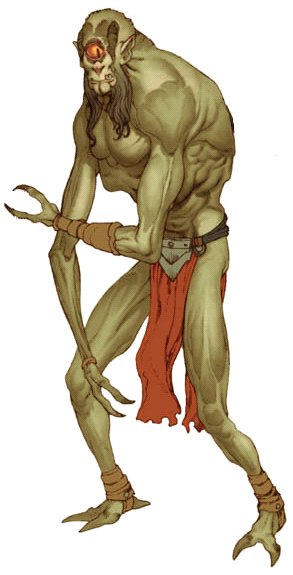 Abyssins are brutish humanoids who thrive on violence. They believe that change is impossible, a belief fostered by their ability to recover quickly from even the most grievous wounds. The Blooding, a ritual combat between two tribes over water rights, is also used to settle impassable disputes between hated enemies. A Blooding is usually a fight to the death between two Abyssins—one champion per tribe—with the winner gaining all of the loser's possessions.
Abyssins are brutish humanoids who thrive on violence. They believe that change is impossible, a belief fostered by their ability to recover quickly from even the most grievous wounds. The Blooding, a ritual combat between two tribes over water rights, is also used to settle impassable disputes between hated enemies. A Blooding is usually a fight to the death between two Abyssins—one champion per tribe—with the winner gaining all of the loser's possessions.
Abyssins are well suited to their natural desert habitat and have a very efficient biology. Often characterised by their single eye. Abyssins don't take kindly to beings who refer to them by derogatory names such as "monoc","one-eye" or "cyclops."
Personality: Abyssins are quick to anger, especially when taunted or otherwise insulted. They hardly ever need to show restraint and are well known for their quarrelsome nature. Abyssin society is primitive, and individuals show little interest in anything other than basic comforts. All Abyssins dislike space batiks and blaster fire.
Physical Description: Abyssins are slightly hunched, hulking humanoids with long limbs, lank but muscular bodies, weathered skin, and a single slit-pupiled eye. The average Abyssin adult stands about 2 meters tall.
Homeworld: The planet Byss, located in the Outer Rim Territories is a mostly arid sphere that orbits twin suns in a figure-eight pattern. The Burning – the leg of Byss's orbit that carries it between the twin suns – is a gruelling time when temperatures rise, weather is unpredictable, and sunlight scorches the entire planet.
Language: Abyssins have their own spoken and written language (Abyssin). The spoken language consists of primitive-sounding grunts and growls, and the written language is based on a simple set of hieroglyphs.
Example Names: Anami, Easym, Mador, Myo, Polcyc, Vomak.
Age In Years: Child 1-30; Young Adult 31-65; Adult 66-150; Middle Age 151-220; Old 221-300; Venerable 301+.
Adventurers: Abyssins rarely leave Byss, as they are quite satisfied with their lot in life. Those who do are usually taken as slaves by representatives of more technologically advanced cultures. A few Abyssins who venture offworld end up as labourers, thugs, or prize brawlers. Particularly resourceful Abyssins find work as bodyguards or with organised crime syndicates.
Abyssin Species Traits
- Ability Modifiers: +2 Strength, +2 Constitution, -4 Intelligence, -2 Charisma
- Size: As Medium creatures, they have no special modifiers due to their size.
- Speed: base speed of 10 meters
- Extraordinary Recuperation: Abyssin regain vitality and wound points at twice the normal rate (2 vitality points per character level per hour, 2 wound points per day of rest).
- Limb Regeneration: With three days of rest, an Abyssin can completely regrow a lost limb or organ.
- Poor Depth Perception: Because of their singular eye Abyssin have poor depth perception. Abyssin suffer a -1 penalty on all ranged attacks.
- Primitive: Abyssin with heroic or professional classes receive the bonus feats Weapon Group Proficiency (primitive weapons) and Weapon Group Proficiency (simple weapons) instead of the usual Weapon Group Proficiency bonus feats.
- Skill Bonus: Abyssin receive a +4 species bonus on Survival checks in arid environments.
- Free Language Skills: Read/Write and Speak Abyssin.
Adarian
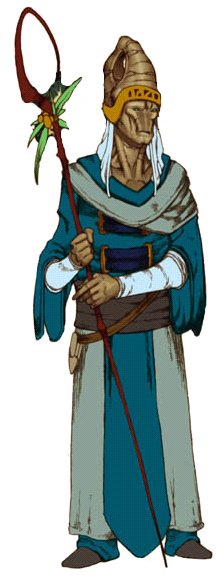 Adarians are best known for their mining and manufacturing operations, as well as a civilisation that's never been blemished by civil strife. Adari, their home-world, is run as though it was a corporation. Adarian society is divided into strict castes that determine what role each member will undertake, with the higher casks having absolute authority over the lower ones.
Adarians are best known for their mining and manufacturing operations, as well as a civilisation that's never been blemished by civil strife. Adari, their home-world, is run as though it was a corporation. Adarian society is divided into strict castes that determine what role each member will undertake, with the higher casks having absolute authority over the lower ones.
Personality: Adarians carefully weigh their options before reaching any decision, but once the decision is made, they are rarely moved to change their minds. Adarians implicitly trust the judgement of those of higher status, and only the most flippant and rebellious Adarian would disregard orders or advice from a member of a higher caste. Adarians have keen minds for business and a natural drive to succeed. They devote considerable time and energy to ensure the prosperity of their businesses.
Physical Description: Adarians are hairless humanoids with elongated heads that have a hole clear through from one side to the other. Adults stand about 1.7 meters tall and come in a variety of vibrant skin colours (commonly blue or yellow). Members of the same caste tend to have a similar coloration.
Homeworld: Archaeologists believe that Adarians did not originate on Adari (located in the Inner Rim), but rather migrated to the planet thousands of years before the Battle of Yavin. The planet is now the seat of the Adarian government, which operates like a corporation.
Language: Adarian speak Adarese, a language that uses largely tonal inflections. Their rigid mouths make languages such as Bask difficult to speak without a heavy accent.
Example Names: Ador Beldune, Denka Melru, Luur Tenefor, Yeeru Meekel.
Age In Years: Child 1-13; Young Adult 14-18; Adult 19-44; Middle Age 45-55; Old 56-64; Venerable 65+.
Adventurers: Adarian explorers are always searching for new resources to exploit and are given free reign by the ruling caste to indulge this pursuit. Occasionally, a member of a lower caste will leave Mari in search of a better life or success among the stars. Adarian heroes can belong to any class.
Adarian Species Traits
- Ability Modifiers: -2 Constitution, +4 Intelligence
- Size: As Medium creatures, they have no special modifiers due to their size.
- Speed: base speed of 10 meters
- Long Call: An Adarian can emit a subsonic call by inflating their throat pouch and vibrating the air-filled sac as a full-round action. This call can be heard up to 20 kilometres away by other Adarians. Members of other species within 4 meters take 2d4 points of sonic damage, or half damage with a successful Fortitude saw (DC = 10 + the Adarian's Constitution modifier). On a failed saw, a character is also stunned for 1 round. Other Adarians take no damage from a long call, but an Adarian can only use this ability 3 times per day without injuring themselves. Each time they uses long call beyond 3 times per day, the Adarian takes 2d4 points of sonic damage (no saving throw allowed), but is not stunned.
- Skill Bonus: Adarian receive a +2 species bonus on Listen, Search, and Spot checks.
- Free Language Skills: Read/Write and Speak Adarese.
Advozse
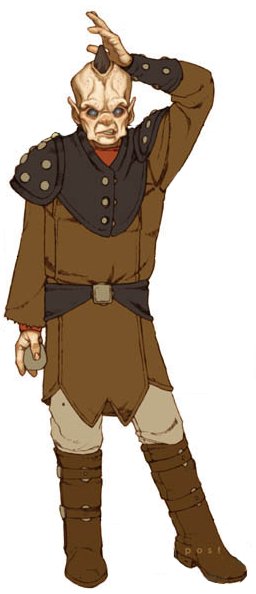 The Advozsec come from the tectonically tortured world of Riflor. Three suns exert tremendous gravitational stress on the planet, which has baffled planetologists as to why the planet hasn't been destroyed yet. The Advozsec evolved on Rifler to become both survivors and tremendous pessimists.
The Advozsec come from the tectonically tortured world of Riflor. Three suns exert tremendous gravitational stress on the planet, which has baffled planetologists as to why the planet hasn't been destroyed yet. The Advozsec evolved on Rifler to become both survivors and tremendous pessimists.
Although much of their fame comes from their reputation as bureaucrats, Advozsec engineers have also been responsible for many advances in building materials arid construction techniques.
Advozsec are strict vegetarians and become violently ill if they consume animal protein.
Personality: Advozsec do not trust easily, and they don't trust that anything—anything—is permanent. They prepare for the worst, yet for all their supposed pessimism, they do hope and strive for the best realistic possible outcome. Advozsec are notoriously indifferent to possessions save money. While objects, homes, and cities may be destroyed during the next calamity season, monetary power can rebuild a society and keep it from collapsing into barbarism. Their gloomy outlook on the universe means that they also seem irritable to other beings.
Physical Description: Advozsec are roughly humanoid and average about 1.5 meters tall. They are hairless, pug-faced beings with thick skin that ranges from muddy yellow to ruddy brown. An Advozse's ryes are large and black due to millennia of evolution in caves, with ears that come to a point to better resolve location underground. A prominent black horn protrudes gone the top of the Advozse's head.
Homeworld: The tectonically unstable planet of Bitten, located in the Mid Rim.
Language: Advozsec speak and read Advb.
Example Names: Bom Vindim, Gjeel Dhantra, Kol Nurn, Roda Lem, Vel Ramdro.
Age In Years: Child 1-9; Young Adult 10-14; Adult 15-33; Middle Age 34-42; Old 43-54; Venerable 55+.
Adventurers: Advozsec who take to a life of adventure are typically fringes or tech specialists. Advozsec have a slightly lower than average number of Force-users. Those who can move beyond their gloomy outlook on life can become Jedi, however.
Advozse Species Traits
- Ability Modifiers: -2 Dexterity, +2 Constitution, +2 Wisdom
- Size: As Medium creatures, they have no special modifiers due to their size.
- Speed: base speed of 10 meters
- Herbivorous: The Advozsec evolved from plant-eating reptile-analogs on Riflor. Advozse cannot digest animal protein, and any Advozse who consumes such matter (knowingly or not) immediately suffers 1d6 points of temporary Constitution damage.
- Low-Light Vision: The perpetually dim lighting conditions on Riflor allow the Advozsec to see particularly well in low light. Advozse can see twice as far as normal in dim light, and retain the ability to distinguish color and detail under these conditions.
- Natural Armor: Their proximity to geothermal hotsprings has given Advozsec thick skin. Advozse receive a +2 natural armor bonus to Defense.
- Pessimistic: Advozsec are antisocial beings who generally expect the worst. Advozse suffer a -4 species penalty on Diplomacy checks.
- Skill Bonus: Advozsec are perceptive. Advozse receive a +2 species bonus on Search and Spot checks.
- Free Language Skills: Read/Write and Speak Advb.
Amanin
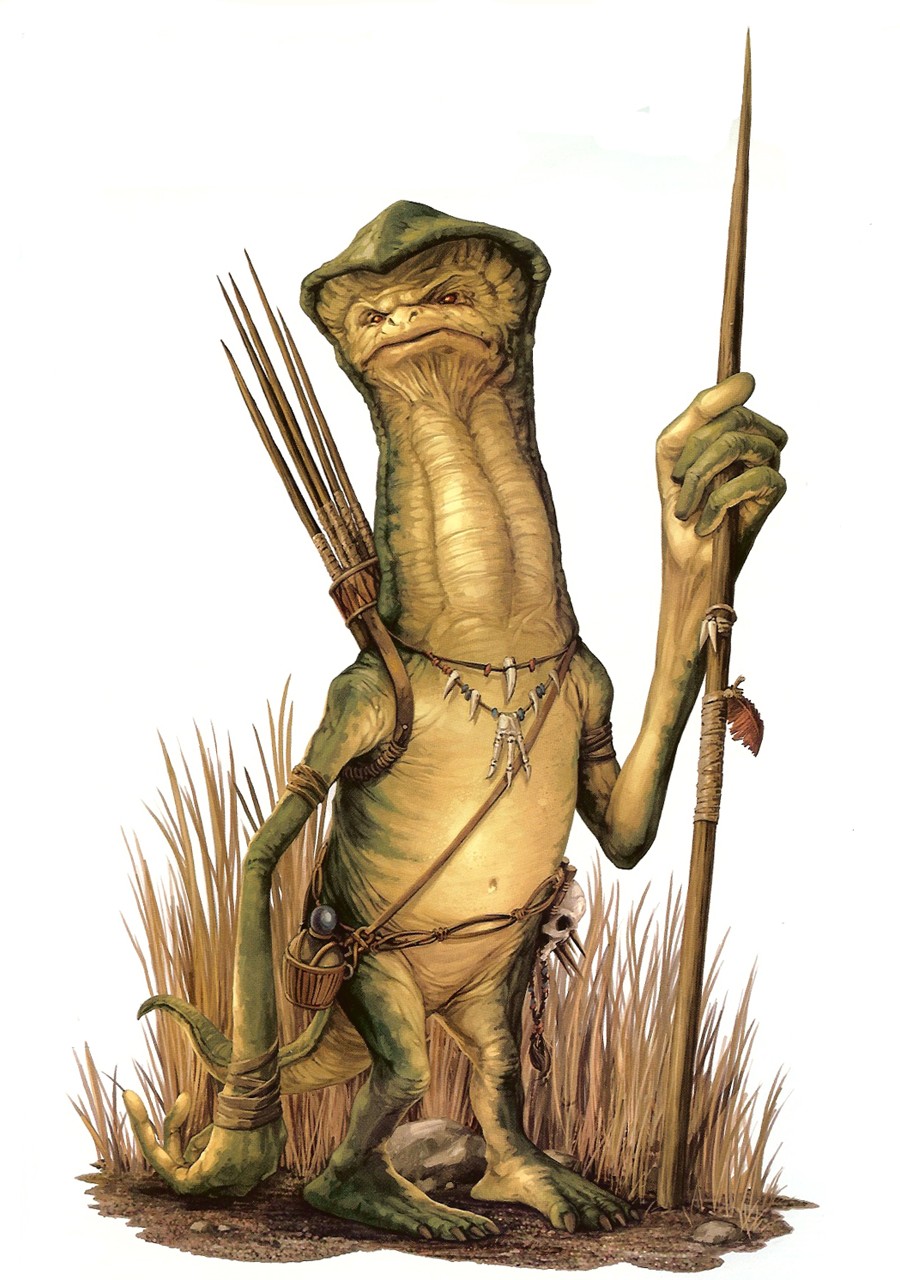 These arboreal humanoids live in small tribes that each lay claim to a one of the many sparse forests of Maridun, their homeworld. When a tribe grows too large, the younger adults set out to claim a new forest. The arrival of the Empire on Maridun went largely unnoticed, until one Amanin lorekeeper agreed to turn over prisoners from rival tribes as slaves. Not long after the Battle of Endor, operations on Maridun were taken over by the Hutts and various criminal syndicates, which constructed spaceports to support the growth of several small cities populated by crime lords, scoundrels, consortiums, mining companies, and Amanin slaves.
These arboreal humanoids live in small tribes that each lay claim to a one of the many sparse forests of Maridun, their homeworld. When a tribe grows too large, the younger adults set out to claim a new forest. The arrival of the Empire on Maridun went largely unnoticed, until one Amanin lorekeeper agreed to turn over prisoners from rival tribes as slaves. Not long after the Battle of Endor, operations on Maridun were taken over by the Hutts and various criminal syndicates, which constructed spaceports to support the growth of several small cities populated by crime lords, scoundrels, consortiums, mining companies, and Amanin slaves.
Personality: Traditionally, Amanin are fearless hunters due to their dominant station in Maridun's food chain and their natural resilience. Beyond their homeworld. Amanin tend to keep a low profile despite their towering height. As their society becomes more integrated with the rest of the galaxy, Amanin become more comfortable with space travel and technology, though they lack the scientific knowhow to build technology of their own. Amanin collect various trappings of their rich history, such as trinkets and trophies.
Physical Description: Hooded humanoids with long, spindly arms, big hands, and stocky legs, Amanin stand about 2.5 meters tall. They have yellow and green skin and often wear little or no clothing.
Homeworld: Maridun, located in the Outer Rim, is temperate world of long, flat plains dotted with small forests. During the Galactic Civil War, the Empire constructed several spaceports on Maridun to support their mining operations. These spaceports have been co-opted by smugglers, slavers, and pirates as bases of operation since the Empire's defeat.
Language: Antonin have no written language of their own, relying instead on a tradition of oral history carried on by each tribe's loremaster.
Example Names: Aja, Brenjandor, Jorodus, Jott, Ojat Wan, Tonjon, Trijit, Unjor.
Age In Years: Child 1-11; Young Adult 12-16; Adult 17-49; Middle Age 50-76; Old 77-89; Venerable 90+.
Adventurers: Amanin are relatively new to the civilized galaxy. After the dissolution of the Galactic Senate, many have begun living in the spaceports of Maridun and traveling oftworld. Each new generation of Amanin is more integrated into galactic society than the previous one. Amanin heroes are usually flingers or scouts, with the occasional Force adept.
Amanin Species Traits
- Ability Modifiers: +2 Strength, -2 Intelligence, -2 Charisma
- Size: As Medium creatures, they have no special modifiers due to their size.
- Speed: base speed of 0 meters
- Roll: Amanin can curl their bodies into a wheel-like shape and roll for long periods. Amanin double their normal speed while rolling but can only move in a straight line and suffer a -4 circumstance penalty on Listen and Spot checks. Amanin can also use this ability with overland movement, as described in Chapter Six of the Star Wars Roleplaying Game.
- Primitive: Amanin with heroic or professional classes receive the bonus feats Weapon Group Proficiency (primitive weapons) and Weapon Group Proficiency (simple weapons) instead of the usual Weapon Group Proficiency bonus feats.
- Resilient: Amanin have redundant internal organs. Amanin gain a +1 species bonus on Fortitude saves.
- Skill Bonus: Amanin are arboreal. Amanin receive a +4 species bonus on Climb checks.
- Free Language Skills: Speak Amanese.
Anomid
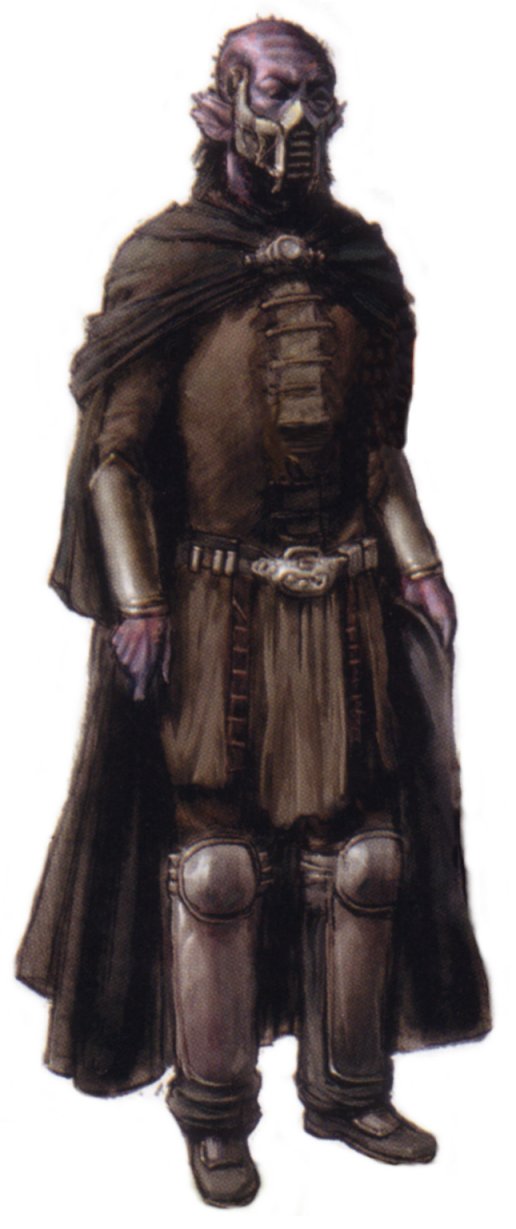 Most Anomids drape themselves in long flowing robes and wear vocalizer masks, covering all but their eyes and bald heads. They are by no means shy, however, and are quick to strike up a conversation with a stranger, especially a member of a rarely encountered species. They enjoy sharing wild spacers' tales and news from across the galaxy. Anomid travellers are usually wealthy and considered easy marks by dairies and con artists. The concealing garb of an Anomid also serves them well when they need a quick and easy disguise.
Most Anomids drape themselves in long flowing robes and wear vocalizer masks, covering all but their eyes and bald heads. They are by no means shy, however, and are quick to strike up a conversation with a stranger, especially a member of a rarely encountered species. They enjoy sharing wild spacers' tales and news from across the galaxy. Anomid travellers are usually wealthy and considered easy marks by dairies and con artists. The concealing garb of an Anomid also serves them well when they need a quick and easy disguise.
Anomids are encountered throughout the populated sections of the galaxy. The species joined the Old Republic and spent 15,000 years traveling the galaxy, colonizing worlds, and obtaining new technology. What they can't develop themselves, they buy (usually through legitimate means).
As Anomids lack vocal cords, they rely on vocalizer masks to synthesize speech. The masks translate their jaw and throat muscle movements into harsh, electronically synthesized words.
Personality: Anomids are peaceful intellectuals. They are intensely curious about cultures across the galaxy. They often seize the opportunity to meet beings of species they've never encountered before, taking care to learn their customs and etiquette. Anomids usually avoid physical confrontations.
Physical Description: A typical Anomid is Frail looking, with translucent skin, large opalescent eyes, a bald pate surrounded by dark wispy hair, six-fingered hands, and fanlike cars. Adult Anomids average 1.75 meters tall.
Homeworld: Yablari, located In the Outer Rim, is an agrarian world with some the best food processing technology in the galaxy. There's no evidence or record of any civil wars in the planet's history, not surprising given the agreeable nature of the species. A global drought forced the Anomids to employ centuries-old hyperdrive principles for the first time. The first suitable world they discovered already had a small Duros colony, eventually opening up Yablari to galactic trade.
Language: With the aid of their vocalizer masks, Anomids speak Basic. Anomids also employ an intricate silent language using body and hand gestures. With six fingers on each hand, many Anomid words are "unpronounceable" by species with fewer digits. The language is purely gestural and has no written element.
Example Names: Zadan Isp, Vap Killif, Magris Quill, Wif Sissk, Yin Vocta, Drezzim Zar.
Age In Years: Child 1-13; Young Adult 14-17; Adult 18-45; Middle Age 46-70; Old 71-94; Venerable 95+.
Adventurers: Anomids that leave their hot-new/arid are usually nonconformists who disagree with the laws and philosophies of their peers, wanderlusting youngsters, technology hunters, or corporate trawlers. Anomids can belong to any hero class but are most commonly nobles, scouts, and tech specialists. Anomid Force-users are also possible, while Anomid soldiers are extremely rare.
Anomid Species Traits
- Ability Modifiers: -2 Strength, +2 Intelligence, +2 Charisma
- Size: As Medium creatures, they have no special modifiers due to their size.
- Speed: base speed of 10 meters
- Technical Aptitude: When working with items of a technical nature (such as computers, droids, and repulsorlift engines), Anomid receive a +2 species bonus on Craft checks and Repair checks.
- Wealthy: Anomid roll an extra die when determining starting credits. For example, a 1st-level noble starts play with 2d4 x 1,000 credits instead of the standard 1d4 x 1,000.
- Skill Bonus: Anomids are Curious about all other species and use their broad knowledge of sentient alien behaviour to find peaceful solutions to conflicts. Anomid receive a +4 species, bonus on Knowledge (alien species) checks and a +2 species bonus on Diplomacy checks.
- Free Language Skills: Speak Anomid.
Anx
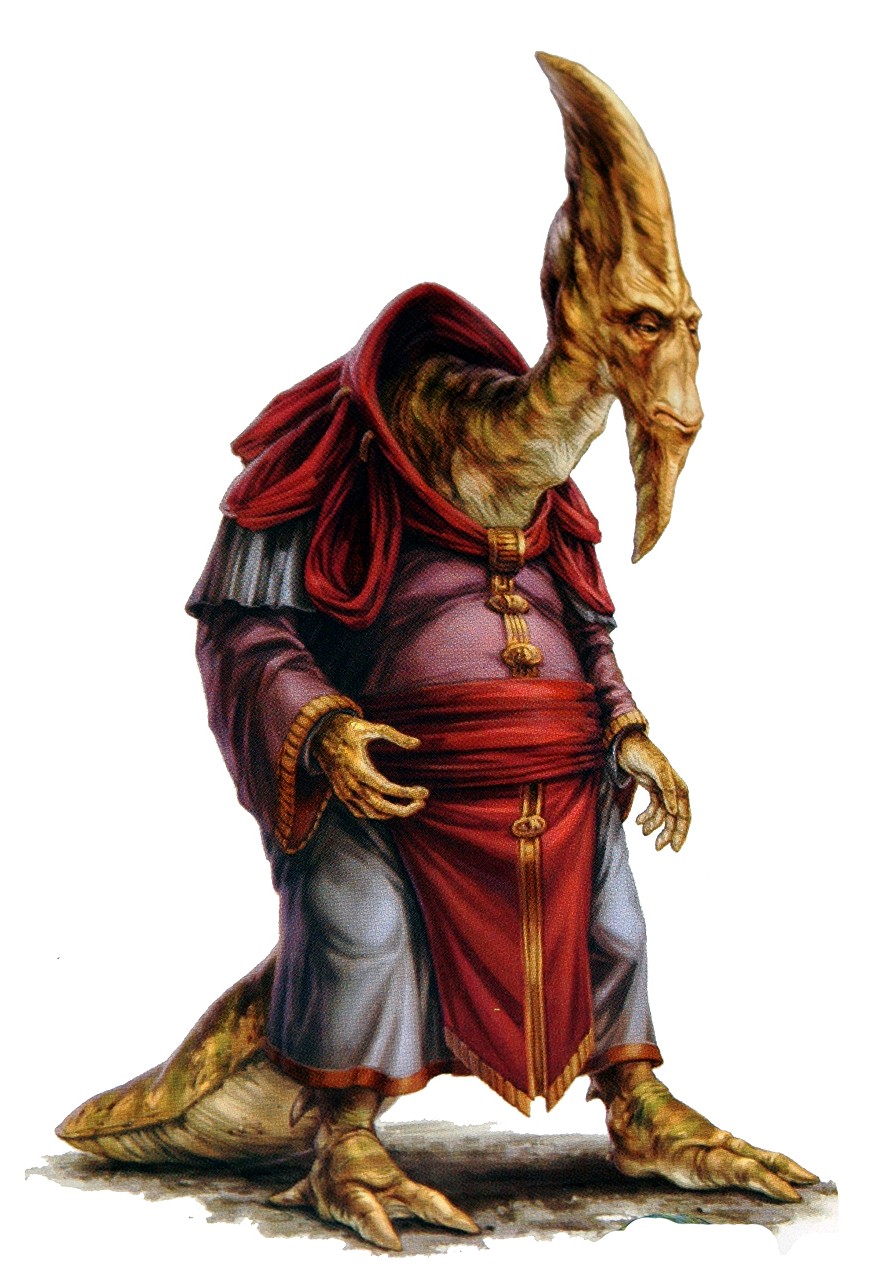 The Anx are serene giants who assume many roles in the Republic. They are placid, sociable creatures noted for an almost-fanatical devotion to any larger group of which they consider themselves a part.
The Anx are serene giants who assume many roles in the Republic. They are placid, sociable creatures noted for an almost-fanatical devotion to any larger group of which they consider themselves a part.
Thousands of years before the Republic encountered them, the Anx developed interstellar travel by hurling their ships into orbit with colossal cannons. Through this method, the Anx spread from Gravlex Mex (their homeworld) to neighbouring systems in their corner of space. Unfortunately for them, they quickly encountered the Shusugaunt, a squat species of spacefaring warriors. Although the Shusugaunt managed to take over the Anx homeworld for a short time, the planet's gravity proved their undoing, bringing the conquest to a halt. Since then, Mx have become more cautious in their exploration and dealings with oilier species.
Anx possess an uncanny knowledge of anatomy. specifically relating to nervous systems, muscles, and skeletal structures (even in creatures they have never encountered before). This knowledge makes the Anx devastating unarmed combatants, able to stop even a raging Wookie with a well-placed blow to the right nerve center.
Personality: Anx are serene beings, they are highly sociable, given to large families and complex clan structures. They fear isolation.
Physical Description: Anx average 4 meters tall and would seem taller if they didn't walk with their shoulders stooped and their long, crested heads held out in front of them. Their skins—and particularly the fins beneath their crests—change color to reflect their emotions. When traveling among aliens, Anx often wear cowled cloaks that hide their crests. Their slow, bunched way of walking, together with their small, close-set eyes, wrinkled faces, and pursed mouths can make them look like parodies of old men. An Anx's large, muscular tail serves as a counterbalance for running.
Homeworld: Gravlex Mex, a low-gravity world located in the Mid Rim.
Language: Anx speak and read Anx. Their head-crests contain enormous sinuses that generate booming, low-frequency tones that other Anx can hear from several kilometres away. Offworld Anx often speak Basic, and descendants of Anx who survived the Shusugaunt invasion also speak Shusugaunt.
Example Names: Graxol Kelvyyn, Horox Ryyder, Theen Fida, Drexil Ryyd.
Age In Years: Child 1-10; Young Adult 11-15; Adult 16-54; Middle Age 55-79; Old 80-109; Venerable 110+.
Adventurers: Anx adventurers can be any class, though they are rarely encountered as Jedi or scouts. Anx fringers and scouts are more common in a Rebellion era campaign.
Anx Species Traits
- Ability Modifiers: +2 Strength, -2 Wisdom
- Size: As Large creatures, they suffer a -1 size penalty on Defense, a -1 size penalty on attack rolls, and a -4 penalty on hide check, and a and a +4 penalty when grapplings. They have a Face/Reach of 2m by 2m/4m. Their lifting and carrying limits are doubled of Medium-sized characters.
- Speed: base speed of 12 meters
- Anatomical Awareness: An Anx who takes the Martial Arts feat deals 1d6 points of damage with an unarmed strike and threatens a critical hit on a natural roll of 18-20.
- Communicate at Distance: An Anx can communicate with other Anx within 5 kilometres. Adverse weather conditions (high winds, For example) can reduce this distance at the GM's discretion.
- Revealing Coloration: Aux have trouble hiding their emotions. An Anx not wearing a fin cloak suffers a -4 penalty on Bluff checks.
- Bonus Feat: Anx receive the bonus feat Run.
- Free Language Skills: Read/Write and Speak Anx.
Anzat
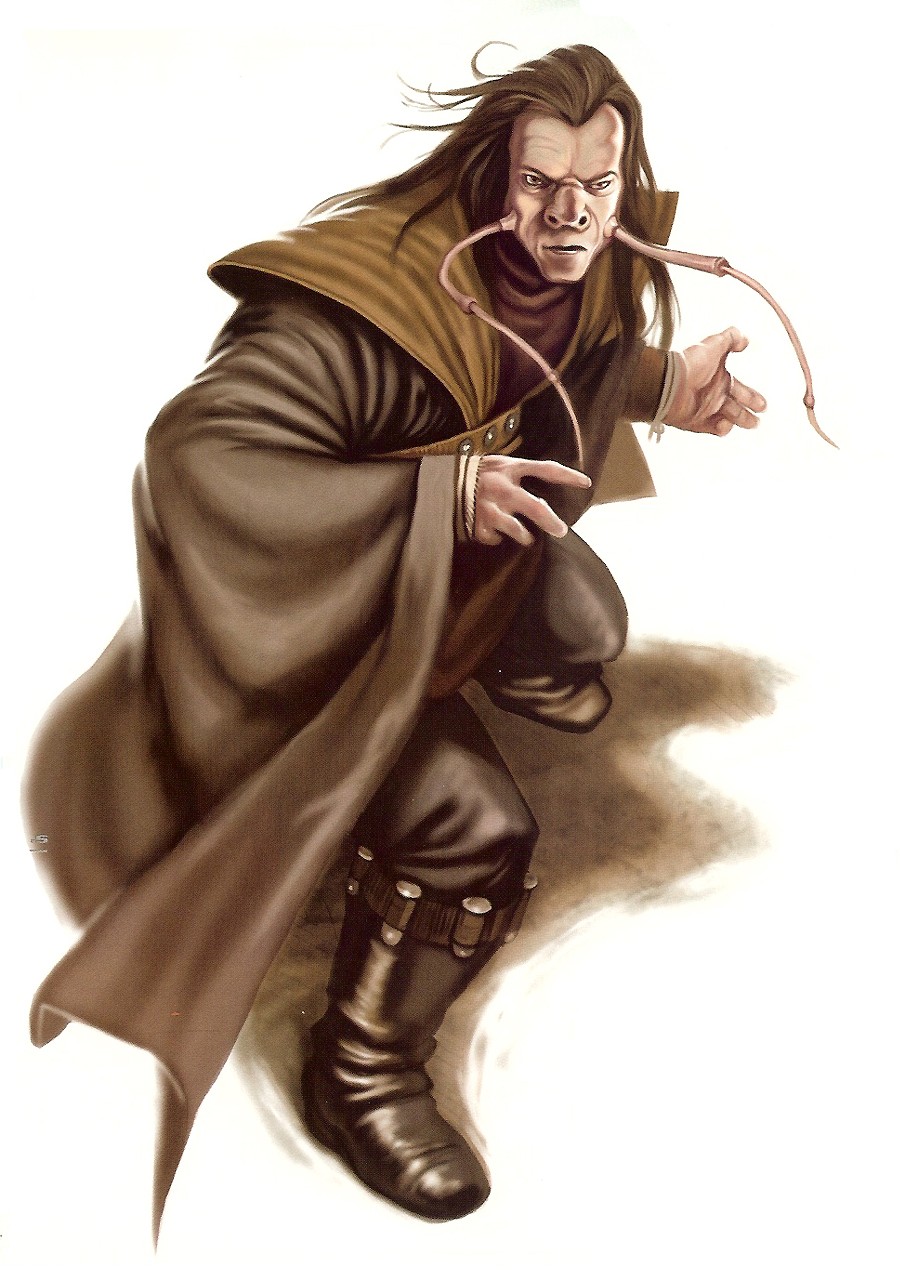 Some beings regard Anzati as mythical creatures, concocted to scare younglings and superstitious fools. They are, in fact, among the deadliest predators in the galaxy. Anzati have exceptionally long lives, reaching adulthood by age 100. Particularly crafty Anzati can live to be several centuries old.
Some beings regard Anzati as mythical creatures, concocted to scare younglings and superstitious fools. They are, in fact, among the deadliest predators in the galaxy. Anzati have exceptionally long lives, reaching adulthood by age 100. Particularly crafty Anzati can live to be several centuries old.
Thousands of worlds across the galaxy have legends of the Anzati, yet no culture's creation myths include facts about the species' origin. To some, this implies that the Anzati have been around longer than any other known species. Whether this is true remains a mystery.
With their long lives, Anzati have time to develop and pursue various interests. Many are devoted patrons of the arts. A few have even produced works of art of their own: books, music, paintings, sculpture, films, arid holos. Few have created more than one example in any given medium, however. For a being so long-lived as an Anzat, perfection at a craft is pointless, as reaching the pinnacle of an art is no real accomplishment if its only practitioners died off a thousand years ago.
The only an that most Anzati find worth mastering is the art of stealth. Anzati keep low profiles, disappearing as soon as anyone appear, to notice their activities, abilities, or longevity.
Anzati roam the galaxy for one reason: to devour the “soup" of other sentient beings. To an Anzat, "soup" embodies presence and life energy, which is stored in the gelid, mucoid brain fluids of sentient beings. Beings with strong connections to the Force are particularly appetizing, although most Anzati consider any hypothetical correlation between "soup" and the Force academic.
Personality: Anzati are stealthy, patient, hunters. They rarely keep the company of others and tend to travel alone, mingling with their own kind rarely, and usually only on the Anzati homeworld. Anonymity is an Anzat's only friend.
Physical Description: Humanoids with large, bulbous noses, Anzati stand about 1.7 meters tall. They have a pair of hidden pockets in their cheeks, each concealing a thin, tubelike proboscis. Anzati are easily mistaken for any of a multitude of Human and near-Human species, only revealing their true nature when their proboscises are unfurled.
Homeworld: The location of Anzat, the Anzati homeworld, is unknown. Anzati go there only to reproduce, then inexorably roam the galaxy in search of food or diversion.
Language: Anzati speak Anzat, an ancient language known only to them. The written form of Anzat Is equally archaic, and no known samples exist in any institution. Anzati speak Basic with ease.
Example Names: Allexit Jabbra, Tav Ezellan, Dannik Jerriko, Ketren Noor, Nikkos Tyris, Volfe Karkko.
Age In Years: Child 1-12; Young Adult 13-99; Adult 100-649; Middle Age 650-799; Old 800-950; Venerable 951+.
Adventurers: Anzati heroes are rare, given their predatory nature. The few who care to interact with other species on a social level are usually fringers, nobles, scoundrels, or (rarely) Force adepts.
Anzat Species Traits
- Ability Modifiers: +2 Strength, -4 Charisma
- Size: As Medium creatures, they have no special modifiers due to their size.
- Speed: base speed of 10 meters
- Anzati tracking: When using the Track feat, an Anzat may use the See Force skill, rather than the Survival skill, to locate and follow quarry (provided they have ranks in the See Force skill). Though an Anzat can track using Survival, the Anzat gains a bonus on their See Force check equal to the target's character level. The stronger the target's presence, the more the target stands out to the Anzat's senses.
- Hypnosis: An Anzat uses a crude form of telepathy to hypnotize prey. If a sentient being within 2 meters is flat-footed or unaware of the Anzat's presence (such as when denied its Dexterity bonus to Defense against the Anzat), the Anzat can attempt to hypnotize the target as a full-round action. The target is stunned on a failed Will save (DC = Anzat's character level + Anzat's Intelligence modifier). The subject remains stunned until the Anzat's next attack. If the Anzat is attacked, interrupted, or otherwise distracted before he can insert his proboscises into his victim, the hypnosis effect ends immediately and the victim can act normally.
- Proboscises: A successful unarmed melee attack against a grappled, stunned, or helpless creature allows the Anzat to insert his proboscises into the creature's brain (usually through its sinus cavities) and drain its “soup.” (The Anzat can furl and unfurl the proboscises as a free action.) A successful attack stuns the victim, and the stun effect remains until the Anzat withdraws its proboscises or dies. Only a victim who is not already stunned (such as by the Anzat's hypnosis ability) is entitled to a Fortitude save to negate the stun effect of the proboscises (DC = Anzat's character level + Anzat's Intelligence modifier).
Each round of feeding deals 1 point of temporary Constitution damage to the target creature. The target dies when reduced to 0 Constitution points. Once an Anzat begins feeding, he is compelled to consume all he can. Only the risk of death will cause him to leave a meal unfinished.
- Bonus Feat: Anzat receive the bonus feat Force-Sensitive, Infamy, and Stealthy.
- Free Language Skills: Read/Write and Speak Anzat and Basic.
Aqualish
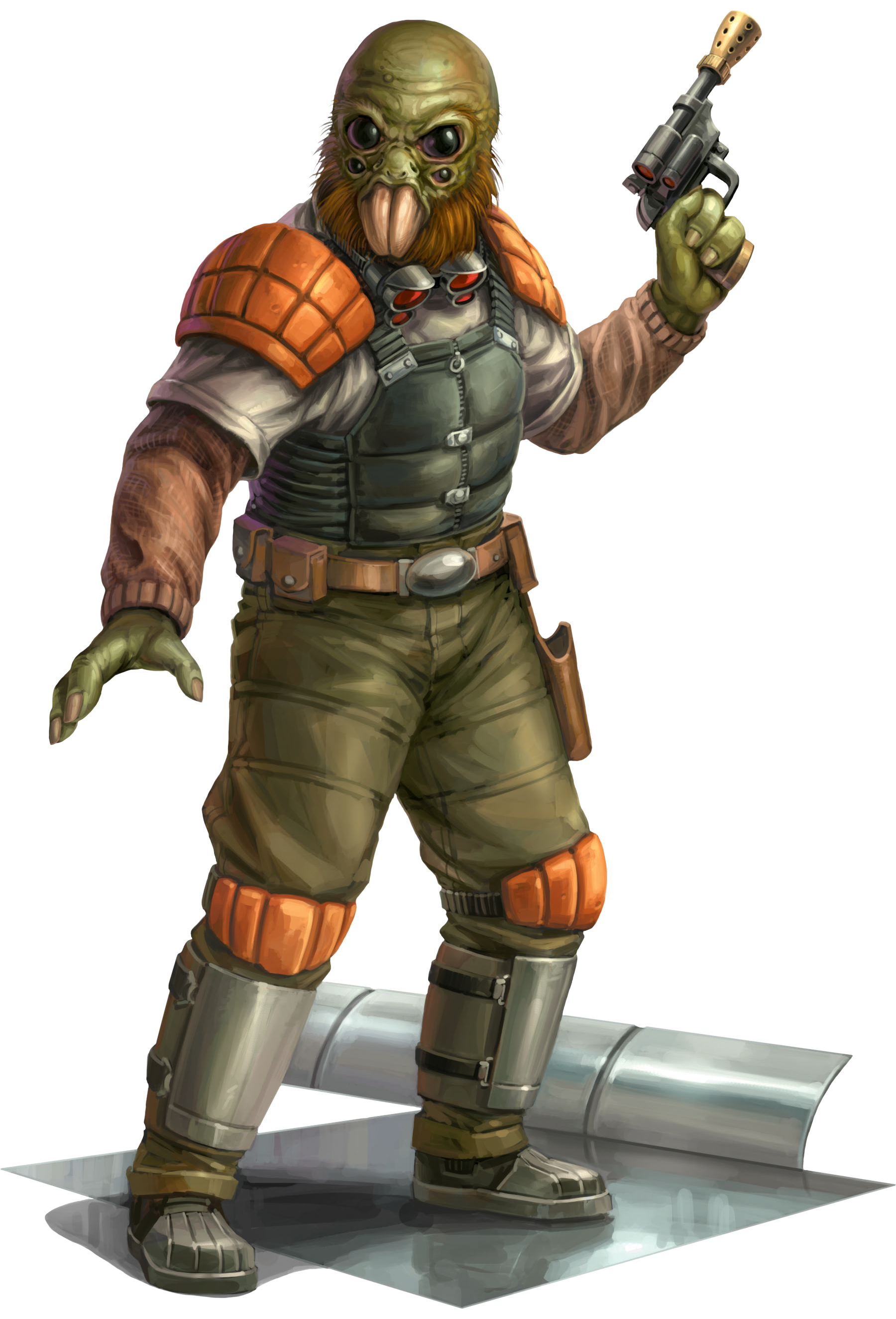 The Aqualish are amphibious humanoids native to the Mid Rim world of Ando. Three breeds of Aqualish exist—the Aquala (widely considered the "baseline Aqualish), the Quara, and the Ualaq. The three strains are generally similar in appearance and in their traits, but the Quara and Ualaq have clawlike hands with five digits where the Aquala have fins. The Ualaq are set apart by the fact that they have four eyes instead of two.
The Aqualish are amphibious humanoids native to the Mid Rim world of Ando. Three breeds of Aqualish exist—the Aquala (widely considered the "baseline Aqualish), the Quara, and the Ualaq. The three strains are generally similar in appearance and in their traits, but the Quara and Ualaq have clawlike hands with five digits where the Aquala have fins. The Ualaq are set apart by the fact that they have four eyes instead of two.
The Aqualish hold no beings in greater contempt than those who belong to a different subspecies than themselves—Aquala hate the Quara and the Ualaq, the Quara hate the Aquala and Ualaq. and so forth. Each strain views the others as Inferior and weak. Since Quara and Ualaq can more easily use equipment designed for the general galactic population, they are more frequently encountered away from Ando than the Aquala.
Personality: The Aqualish admire strength and are openly contemptuous and hostile toward the weak. It is customary and accepted social behavior for an Aqualish to be pushy and belligerent toward people they are Interacting with for the first time. If the other individual does not stand up to them, the Aqualish assumes the other being is weak and continues to bully him or her.
Physical Description: Aqualish are tusked, walrus-faced humanoids with skin ranging in color from dark green or blue to deep russet or black. Members of the Ualaq subspecies have four eyes instead of two. Adult Aqualish stand between 1.8 and 2 meters tall.
Homeworld: Ando, a Mid Rim water planet dotted with swampy islands and rocky outcroppings on which the Quara, Ualaq, and Aquala make their homes.
Language: Aqualish speak and read Aqualish. The Quara, Ualaq. and Aquala have slightly different dialects of Aqualish but have no trouble understand-ing one another.
Aqualish who have their homeworld often learn to speak Basic. Their vocal cords are such that when they speak Basic, it has a harsh, guttural sound. Even the rare well-mannered Aqualish comes across like a loud-mouthed brute when using the common galactic tongue.
Example Names: Calfta Bongi, Carn'ar, Gondara, Gunda Mabin, Koral-tae, Po Nudo, Ponda Bab, Undra Lagor, Yada Munda.
Age In Years: Child 1-11; Young Adult 12-16; Adult 17-50; Middle Age 51-69; Old 70-79; Venerable 80+.
Adventurers: Aqualish heroes are typically scoundrels or soldiers. Force-using Aqualish are rare.
Aqualish Species Traits
- Ability Modifiers: +2 Constitution, -2 Wisdom, -2 Charisma
- Size: As Medium creatures, they have no special modifiers due to their size.
- Speed: base speed of 10 meters
- Breathe Underwater: Aquala gain this bonus while Quara and Ualaq only receive a +2 bonus on Swim checks. As amphibious creatures, Aqualish can't drown in water. They gain a +4 species bonus on Swim checks.
- Fins: (Aquala only) They take a -4 penalty on skill checks that involve the use of equipment not specifically designed for use with their fins, such as most weapons, computers, and control panels.
- Free Language Skills: Read/Write and Speak Aqualish.
Arcona
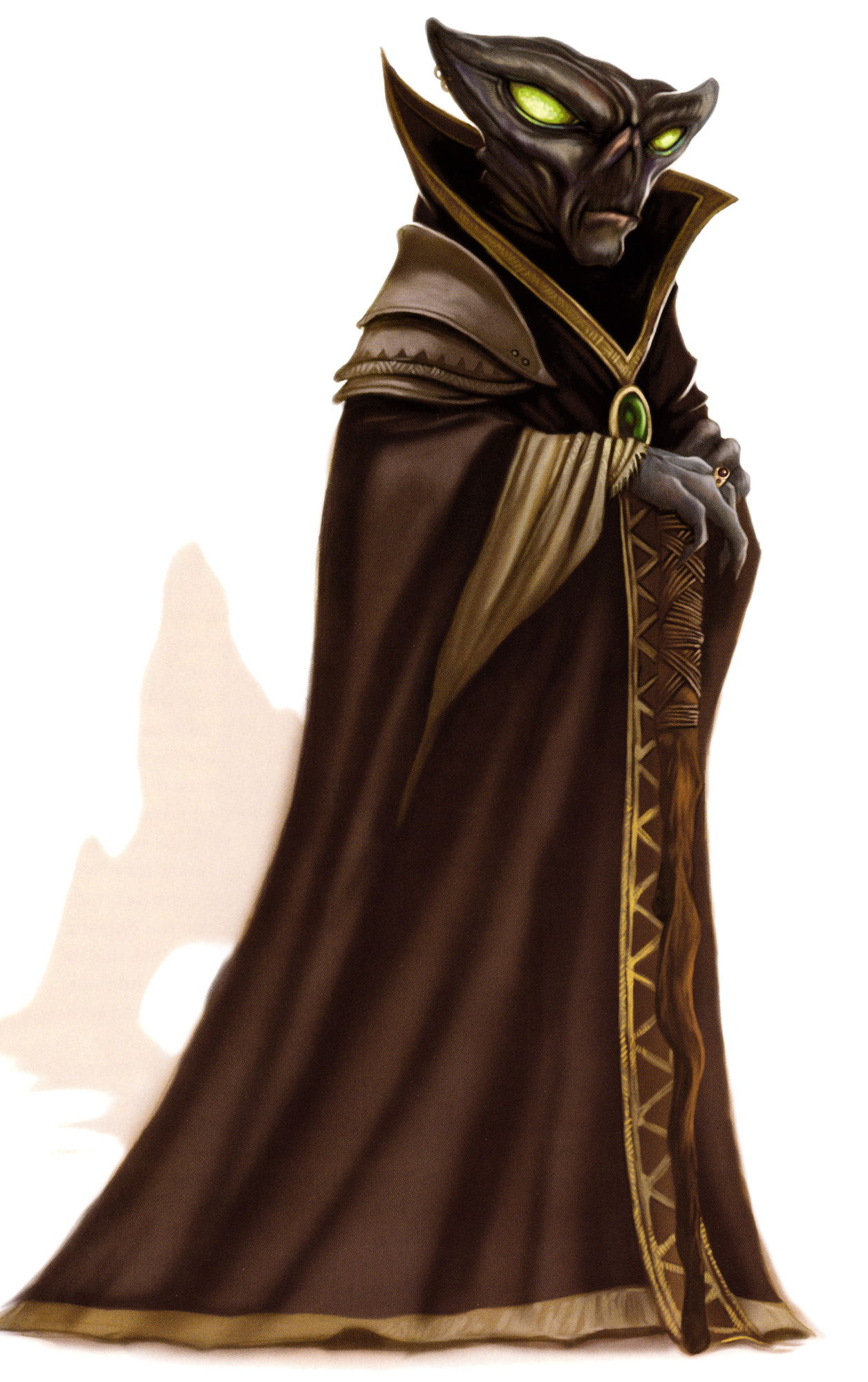 The Arcona are cold-blooded humanoids who hail from Cona, an arid world in the Teke Ro system.
The Arcona are cold-blooded humanoids who hail from Cona, an arid world in the Teke Ro system.
Arcona society is less technologically evolved than what is considered the galactic norm. The species did not develop space travel on their own, but shortly after Republic scouts made contact with the world many decades ago, entire villages sought employment with the Republic and interstellar corporations, fascinated by the possibility of exploring the galaxy. In all three major eras of play, most worlds located at trade-route junctures have at least one Arcona colony, and Arcona can be found at virtually every large spaceport—either as travellers or operators of businesses.
While most beings consider Arcona cities on Cona quaintly low-tech. the planet has several impressive starports, and many of the galaxy's largest mining companies operate on Cona. The system in general, and Cona in particular, boasts rich rare-mineral deposits. Water is the most precious substance on Cona, so the Arcona sold the mining rights to the firms for massive shipments of water. Although the Arcona derive many essential nutrients directly from their world's atmosphere, they also need to consume water and other liquids to keep secondary circulatory systems in their bodies healthy. (This has led some planetary geologists to hypothesize that Cona lost much of its water in some geologically recent catastrophe, though this remains unproven.)
When it was discovered the Arcona can easily and hopelessly become addicted to sodium chloride (salt) by Ingesting even a gram or two of the substance, unscrupulous merchants almost destroyed Arcona society by creating several generations or salt addicts. Salt induces vivid, colorful hallucinations in Arcona, but repeated use damages their body's ability to absorb life-giving ammonia. Only the intervention of the Republic saved the Arcona. The Senate passed draconian laws that punished the importation of salt to the Teke Ro system or to Arcona communities else-where in the galaxy, and the Anima themselves zealously police their communities. Arcona addicted to salt are easily identifiable: their multifaceted eyes turn from green to gold.
The center of Arcona society is the family, and communities consist of several loosely affiliated extended families. The entire family (extended and biological) is considered when making even the simplest decisions.
Personality: An individual Arcona almost always uses the plural pronoun "we" instead of "I." Male Arcona raise the young, since Arcona females are typically impulsive thrill-seekers. As such, females are particularly prone to risking salt addiction, while males go to great lengths to keep the substance out of their communities. In fact, male Arcona are renowned for their conservative outlooks and strong commitment to maintaining order at the cost of individual ambitions arid desires.
Physical Description: Arcona have thick skin that ranges in color from mahogany to ebony, and triangular heads with large multi-faceted eyes that seem to sparkle. Their hands feature three prehensile talons. They average 1.7 to 2 meters tall.
Homeworld: Cona, an arid Inner Rim world located within the Teke Ro system.
Language: Arcona have a native tongue (Arconesc) that is rarely spoken by those who have been raised in off-Cona colonies, but the species has little difficulty learning and speaking Basic.
Example Names: Kodu Terrafin, Vegath Tist, Dutan Kelliv, Dutana Leara, Hem Dazon, Illist Mandrep, Kal Nkai, Shlith-Dan.
Age In Years: Child 1-12; Young Adult 13-18; Adult 19-44; Middle Age 45-76; Old 77-99; Venerable 100+.
Adventurers: Arcona do not favor any particular class and are nearly as diverse in their pursuits as Humans. During the Rise of the Empire era, many Arcona follow the path of the Jedi.
Arcona Species Traits
- Ability Modifiers: None
- Size: As Medium creatures, they have no special modifiers due to their size.
- Speed: base speed of 10 meters
- Natural Armor: Arcona have thick skin. Arcona receive a +1 natural armor bonus to Defense.
- Salt Addiction: An Arcona who imbibes sodium chloride must succeed at a Fortitude save (DC 22) or suffer the effects of salt poisoning: 1d4 points of temporary Constitution damage and a -2 penalty on all attack rolls, ability checks, skill checks, and saving throws. After 24 hours of suffering the effects of salt poisoning, an afflicted Arcona gets a Will save (DC 20) to resist addiction. A failed save can be re-roiled every 24 hours. The effects of salt poisoning last for 1d3 days after the addiction is broken.
- Free Language Skills: Read/Write and Speak Arconese.
Arkanian
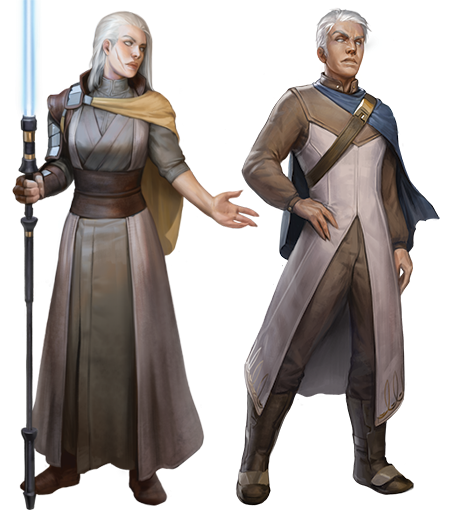 At one time, Arkanian was an important part of the Sith Empire. The world was one of the main repositories of that long-lost civilization's historical records. During the three main eras of play, Arkania is known for its elaborately constructed trade cities and rich gem mines. A number of highly sought after stones can only be found on this world. The Arkanians are known for zealous exploration of the galaxy, innovations in microcircuitry, and contributions to medical technology. Arkanian scientists have long been expert practitioners of genetic manipulation, displaying a particular fascination with the genetic make-up of species other than their own. Some of the results of their research have led to great advances in medical techniques, while others are considered among the greatest atrocities the galaxy has ever known.
At one time, Arkanian was an important part of the Sith Empire. The world was one of the main repositories of that long-lost civilization's historical records. During the three main eras of play, Arkania is known for its elaborately constructed trade cities and rich gem mines. A number of highly sought after stones can only be found on this world. The Arkanians are known for zealous exploration of the galaxy, innovations in microcircuitry, and contributions to medical technology. Arkanian scientists have long been expert practitioners of genetic manipulation, displaying a particular fascination with the genetic make-up of species other than their own. Some of the results of their research have led to great advances in medical techniques, while others are considered among the greatest atrocities the galaxy has ever known.
The combination of vast wealth generated by huge gem mines and near-boundless arrogance has led the Arkanian scientific community to launch research projects on a scale matched only by such Imperial endeavours as the Death Star and the Emperor's hidden stronghold in the Deep Core. The most elaborate Arkanian scientific projects take generations to unfold, often resulting in the total reshaping of entire planets and species.
While Arkanian interaction with the galaxy at large has been characterized by the actions of their scientists, many Arkanians are horrified and greatly embarrassed by the excesses individuals have perpetrated in the name of science. The most conscientious Arkanians are allies of the Jedi Order. In fact, one of the most famous Jedi academies in history stood on Arkania.
Personality: Arkanians exhibit a distinctive arrogance. They consider themselves the pinnacle of evolution, an attitude that has remained with them throughout millennia of interacting with the rest of the galaxy. Their representatives in the Galactic Senate were among the most vocal prior to the rise of the Empire, but after Emperor Palpatine's defeat, their beliefs kept them from joining the New Republic.
Physical Description: Arkanians are a robust near Human species with solid white eyes and clawed, four-fingered hands. Adults average 1.8 meters tall.
Homeworld: Arkania, a frigid, inhospitable world located in the Perave system in the Colonies region.
Language: Arkanians speak and read two languages: their native Arkanian and Basic.
Example Names: Dolvan Genarik, Jaro Salaban, Kalor Nelprin, Marael Korvata, Sulan Bek.
Age In Years: Child 1-11; Young Adult 12-16; Adult 17-52; Middle Age 53-84; Old 85-102; Venerable 103+.
Adventurers: Arkanian heroes are often nobles, scouts, or scoundrels. Adventuring Arkanians often devote their careers to erasing their people's image as the galaxy's “mad scientists,” a difficult task in any of the main eras. Whenever Arkanians venture beyond their home system and nearby colonies, they must overcome considerable resentment.
Arkanian Species Traits
- Ability Modifiers: -2 Dexterity, +2 Constitution, +2 Intelligence, -2 Charisma
- Size: As Medium creatures, they have no special modifiers due to their size.
- Speed: base speed of 10 meters
- Bonus Feat: Arkanian receive the bonus feat Infamy.
- Free Language Skills: Read/Write and Speak Arkanian.
Ayrou
 The Ayrou are willowy humanoids from the planet Maya Koval in the Moddell Sector. They evolved from a birdlike species yet are incapable of flight.
The Ayrou are willowy humanoids from the planet Maya Koval in the Moddell Sector. They evolved from a birdlike species yet are incapable of flight.
The Ayrou were one of the first sentient species in the Moddell Sector to master space flight. They have a baffling cultural paradigm that lets distinguished members of the species debate a cultural or religious topic for generations, then abruptly commit to a single sociological custom or path. The Ayrou also possess a hoarding instinct that compels them to gather up anything they can find on the off chance that it can be used in the future. The impulse to collect things is easily mistaken for greed, but Ayrou are not usually covetous and regard their gathering nature as simply "practical."
Personality: Ayrou are strong-willed individualists, wily negotiators, and tireless collectors for information about anything and everything. Despite their relentless drive, the Ayrou are a peaceful species. They regard haggling and dealing as an art form and think combat is the refuge of juveniles, the feeble-minded, and others who can't succeed using if rear wits.
Physical Description: A typical Ayrou is tall and thin, standing 2 meters tall but weighing only 65 kilograms. The Ayrou are an attractive species, with milky white skin and long, lean limbs.
Ayrou have flat facial features, with wide-spaced eyes that are typically ruby red, sapphire blue, or emerald green. Instead of hair, Ayrou have a beautiful plumage of feathers in a dazzling array of colours. An Ayrou's plumage reflects their health, social status, and attractiveness. Consequently, Ayrou are constantly preening and checking their appearance.
Ayrou have four tapered fingers on each hand and arc triple-jointed, allowing them to bend their limbs at incredible angles.
Homeworld: Maya Kovel, a windswept Outer Rim world with a thin, acrid atmosphere.
Language: Ayrou speak and read Ayrou. The trilling, shrieking Ayrou language is often compared to the sound of a songbird being strangled.
Example Names: Chee'ad, Tircee, Noreekee, Kuusa, Tessyn.
Age In Years: Child 1-7; Young Adult 8-12; Adult 13-44; Middle Age 45-55; Old 56-79; Venerable 80+.
Adventurers: Ayrou adventurers are frequently nobles, scouts, or scoundrels. Force-using Ayrou are rare but not unheard of.
Ayrou Species Traits
- Ability Modifiers: -2 Constitution, +2 Wisdom
- Size: As Medium creatures, they have no special modifiers due to their size.
- Speed: base speed of 10 meters
- Bonus Feat: Ayrou are crafty negotiators and expert gatherers of information. Ayrou receive the bonus feat Trustworthy.
- Free Language Skills: Read/Write and Speak Arno.
Balosar
 Balosars are humanoids with a shady reputation throughout the Core Worlds. They can easily pass for human (when their antennapalps are retracted) and tend to live among the lowest echelons of society, preying on the vices of the weak-willed or impoverished.
Balosars are humanoids with a shady reputation throughout the Core Worlds. They can easily pass for human (when their antennapalps are retracted) and tend to live among the lowest echelons of society, preying on the vices of the weak-willed or impoverished.
Relief agencies have been trying to end the vicious circle of poverty, pollution, and corruption on Balosar for years, but the planet's government offers little assistance. Offworld corporations regularly line Balosar bureaucrats' pockets with credits in exchange for state-owned real estate on which they build sweatshop factories. Balosar offers no shortage of manual labour.
Personality: Balosars are often weak-willed and self-absorbed. Many suffer from severe depression and feel like they're trapped; others grudgingly accept their lot in life with a sarcastic grin. A Balosar's moral and ethical outlook is often skewed by hard life experiences, and many have trouble distinguishing between right and wrong.
Physical Description: A Balosar has coarse hair, a frail-looking frame, and retractable antennapalps atop her head. The average Balosar stands about 1.6 meters tall, and most have sickly complexions from a lack of sunlight and clean air.
Homeworld: Balosar is an inhospitable Core World that has seen better days. The planet's high crime rate and corrupt government discourages tourists, and the air is barely breathable because of industrial pollution.
Language: Balosars speak their own language, which consists of deep vocalizations and throaty rasps. Written Balosar is crude looking, but is no less complex than written Basic.
Example Names: Vaya Bar'jaraka, Nina Dar'Eboros, Elan Sleazebaggano, Zirk Mer'darro.
Age In Years: Child 1-12; Young Adult 13-15; Adult 16-39; Middle Age 40-52; Old 53-64; Venerable 65+.
Adventurers: Although crime runs rampant on Balosar, the species' tendency toward criminal activities has more to do with the deplorable conditions of the planet than any biological imperative. Many Balosars leave their homeworld in search of a better life, only to find life on other plane's equally harsh. A Balosar hero can belong to any heroic class.
Balosar Species Traits
- Ability Modifiers: +2 Dexterity, -2 Constitution, -2 Intelligence, +2 Charisma
- Size: As Medium creatures, they have no special modifiers due to their size.
- Speed: base speed of 10 meters
- Antennapalps: A Balosar's Antennapalps are sensitive to sound and provide a +4 species bonus on listen checks while they are extended.
- Moral Ambiguity: Bluff and Diplomacy checks receive a +4 circumstance bonus when targeting a Balosar if the Balosar is promised profit or power.
- Poison Resistance: Growing up on a polluted homeworld has given Balosars resistance to toxic substances. Balosars gain a +4 species bonus on Fortitude saves to resist the effects of poisons.
- Free Language Skills: Read/Write and Speak Balosar and Basic.
Barabel
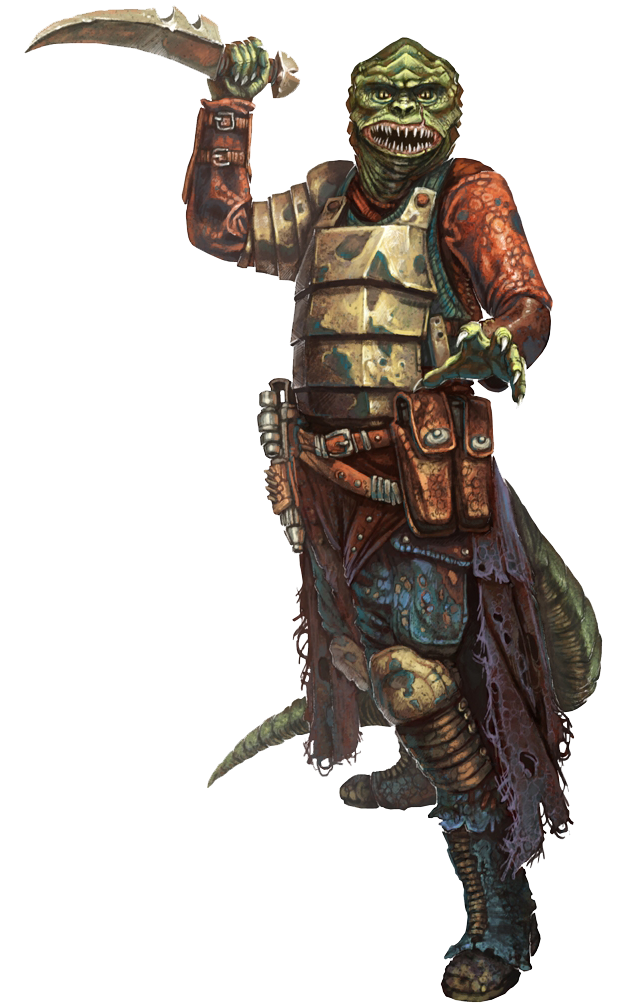 Barabel hail from the planet Barab I. The red dwarf star around which their homeworld orbits projects very little light, so most beings on the world, including the Barabel, have eyes attuned to wavelengths well outside the usual visible spectrum. Barabel can also see perfectly well in normal light.
Barabel hail from the planet Barab I. The red dwarf star around which their homeworld orbits projects very little light, so most beings on the world, including the Barabel, have eyes attuned to wavelengths well outside the usual visible spectrum. Barabel can also see perfectly well in normal light.
Barabel evolved from nocturnal predators. Their distant ancestors would lounge in the intense radiation of the world's dim sun during the “day" and then prowl the deep shadows of "night" in search of prey. A layer of fat retains heat, so unlike other cold-Wooded beings, Barabel do not find themselves feeling sluggish when the temperature drops.
Countless centuries ago, a Jedi explorer visiting Barab I helped settle a heated dispute between two Barabel clans. Although the Jedi's exact identity is unknown and he or she never logged the existence of Barabel society in the galactic registry, this initial contact with the rest of the galaxy left a lasting impression on the Barabel. They developed a rich mythology around the “great warriors from beyond the clouds." When Imperial scouts arrived on the world, the Barabel treated them with the respect they believed they were due. When sport hunters looking to make unique trophies out of the heads of Barabel warriors followed the scouts, respect turned into fear, distrust, and anger.
Barabel culture remains primitive by galactic standards and relies on a strong clan structure. Their small communities, numbering from a few dozen to no more than ten thousand, are located in warrens of underground caves and tunnels, close to water sources and prey.
Only one known spaceport and non-Barabel settlement exists in the Barth system: Alater-ka, a modest facility built to accommodate Imperial landing craft. Many of the galaxy's most successful shockboxing promoters, mercenary guilds, and even the Imperial Army have offices in Alater-ka. They offer adventurous Barabel warriors the opportunity to leave their homeworld as professional athletes, soldiers, or commandos. Despite their status as relative newcomers to the galactic community, the Barabel have gained a reputation as some of the galaxy's most ferocious warriors. Many have made in-roads into the bounty hunting profession and found work as guides on hunting expeditions to dangerous worlds.
Personality: As a species, Barabel are mean-spirited and short-tempered. They confront most other beings with a habitually aggressive stance. They treat siblings, parents, and mates with more compassion, though they are only genuinely affectionate toward their offspring.
Physical Description: Barabel are large reptilian humanoids with black keratin scales covering their bodies. Their bulging, silted eyes are set above huge mouths filled with needle like teeth that often reach five centimetres long. Adults stand between 1.9 and 2.2 meters tall.
Homeworld: The dark, humid world of Barab I in the Outer Rim.
Language: Barabel speak and read Barabel. Their native language consists of harsh-sounding hisses and barks. Few Barabel living on Barab 1 can be bothered with mastering Basic. However, those who travel the galaxy usually make the effort to learn Basic.
Example Names: Baraduk, Ragath, Saba, Skahtul, Shallamar, Skahtul, Tibor, Tull Raine, Vangar.
Age In Years: Child 1-8; Young Adult 9-15; Adult 16-40; Middle Age 41-59; Old 60-79; Venerable 80+.
Adventurers: Barabel adventurers are mostly fringers, but scouts or soldiers are also common.
Barabel Species Traits
- Ability Modifiers: +2 Strength, -2 Dexterity, -2 Wisdom
- Size: As Medium creatures, they have no special modifiers due to their size.
- Speed: base speed of 10 meters
- Darkvision: Barabel can see in the dark up to 20 meters. Darkvision is black and white only but otherwise functions as normal sight.
- Low-Light Vision: Barabel can see twice as far as normal in dim light, and retain the ability to distinguish color and detail under these conditions.
- Natural Armor: Barabel have thick scaly skin. Barabel receive a +2 natural armor bonus to Defense.
- Natural Weapons: A Barabel can choose to attack with a claw, a bile, or a tail slap instead of making a normal unarmed strike. Each of its natural weapons deals 1d6 points of damage plus the Barabel's Strength modifier, although the type of damage varies as follows: claw (slashing), bite (piercing), tail (bludgeoning). These attacks do not provoke attacks of opportunity.
- Primitive: Barabel with heroic or professional classes receive the bonus feats Weapon Group Proficiency (primitive weapons) and Weapon Group Proficiency (simple weapons) instead of the usual Weapon Group Proficiency bonus feats.
- Radiation Resistance: Barabel receive a +2 species bonus on Fortitude saves against radiation.
- Skill Bonus: Barabel receive a +4 species bonus on Intimidate checks.
- Free Language Skills: Read/Write and Speak Barabel.
Baragwin
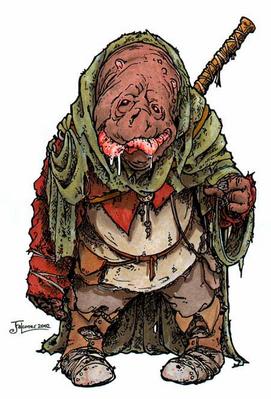 The Baragwin are among the galaxy's earliest space-faring races. When Humans reached for the stars, they found Baragwin arms merchants waiting for them. Many of the early interstellar wars among Human power groups were fuelled by Baragwin-created weaponry.
The Baragwin are among the galaxy's earliest space-faring races. When Humans reached for the stars, they found Baragwin arms merchants waiting for them. Many of the early interstellar wars among Human power groups were fuelled by Baragwin-created weaponry.
Like Humans and Duros, the origins of Baragwin space travel technology is lost to legend and speculation. In fact, the Baragwin had ancient colonies on so many worlds when other species reached them that no one knows their planet of origin, including the Baragwin themselves.
The one unifying factor among the far-flung Baragwin is their talent for weapons design and manufacture. Baragwin weapons manufacturers are particularly renowned for creating blasters and other high-tech weaponry tailored to the needs of alien species that lack the appendages for which most such weapons are designed. Most weapons design firms have counted Baragwin among their employees since their founding. However, Baragwin can be found in any type of occupation, virtually anywhere in the galaxy.
Despite their alien appearance, the Baragwin remained on good terms with the Empire through most of the Rebellion era. The Empire wanted to tap their extensive talent for designing weaponry, and the Baragwin appreciated the handsome sums of money they were paid by the Imperial military or by mega-corporations with Imperial backing. It wasn't until Intelligence Director Isard released the Krytos virus—a deadly, artificially created disease that targeted every species but baseline Humans—during the New Republic's liberation of Coruscant that most Baragwin put their support behind the freedom fighters. The disease hit Coruscant's Baragwin population particularly hard.
The Baragwin have a fine sense of smell and can often identify, a being's mood by its scent.
Personality: Baragwin personalities are as varied as Humans. If anything, Baragwin are underestimated due to their shuffling gait and ponderous way of carrying themselves. They are, in fact, highly Intelligent but rarely take steps to correct the misperceptions ignorant beings may have about them—it often lets them Identify potential foes.
As beings with a highly malleable society, Baragwin tend to be open-minded and accepting of others who visit their communities. However, they are also quick to defend themselves and usually do so with great skill.
Physical Description: The Baragwin are hunch-backed, humanoid saurians with massive heads nearly as wide as their shoulders and three digits on each massive hand. Their skin is tough, wrinkled, and ranges in color from drab green to dark olive. Their nostrils are broad and frequently seen to twitch.
Adult Baragwin stand between 1.5 and 2.2 meters tall, with no differences in build between males and females of the species.
Homeworld: Unknown. Baragwin assimilate easily into societies that are tolerant of aliens.
Language: Basic is the native language of the Baragwin. Just as the Baragwin claim no world of origin, they do not possess a native language.
Example Names: Hermi Odle, Dagel Igara, Idalli Kodrue, Digo Fadani.
Age In Years: Child 1-10; Young Adult 11-17; Adult 18-44; Middle Age 45-71; Old 72-89; Venerable 90+.
Adventurers: Baragwin adventurers tend to be scoundrels, soldiers, or tech specialists. They usually find a line of work connected to war or arms manufacturing.
Baragwin Species Traits
- Ability Modifiers: -4 Dexterity, +2 Constitution, +2 Intelligence
- Size: As Medium creatures, they have no special modifiers due to their size.
- Speed: base speed of 6 meters
- Mood Sense: A Baragwin can sense another sentient being's mood and general demeanour with a successful Sense Motive check (DC 15). This ability has a range of 10 meters.
- Natural Armor: Baragwin have thick skin. Baragwin receive a +2 natural armor bonus to Defense.
- Bonus Feat: Baragwin receive the bonus feat Skill Emphasis. They may apply the feat to any one of the following skills: Computer Use, Craft (any one), Disable Device, Repair.
- Free Language Skills: Read/Write and Speak Basic.
Bartokk
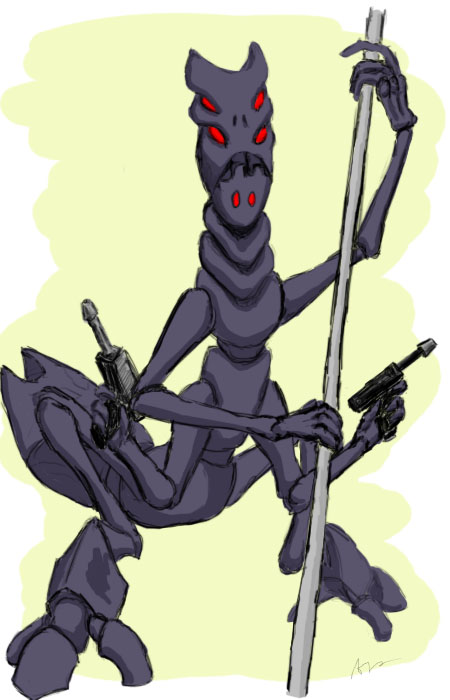 Bartokk are a mysterious insectoid species known for their deadly assassin guilds. They have a collective hive mind that allows them to act in concert and share knowledge. Their body parts, when severed, continue to function through this same link.
Bartokk are a mysterious insectoid species known for their deadly assassin guilds. They have a collective hive mind that allows them to act in concert and share knowledge. Their body parts, when severed, continue to function through this same link.
Bartokk possess exceptional regenerative abilities and can regrow lost body parts in just a few days. If a Bartokk's brain is split in two, each half grows into a full-sized brain and regenerates any missing body parts, creating twins.
Low-level radiation on the Bartokk homeworld sometimes causes minor mutations in the species. These mutations might seem trivial to non-Bartokk (a slightly deformed carapace or extra digits on one claw) but cause the malformed Bartokk to be severed from the hive mind and ostracized. These Bartokk outcasts either perish in the planet's harsh wilderness or leave the homeworld to find kinship elsewhere.
Although technologically primitive and unsophisticated, Bartokk enjoy acquiring and adapting technology and weaponry for their own use.
Personality: Individual Bartokk are barely sentient. When they form large groups, their intellect increases exponentially, making them formidable opponents in numbers.
Physical Description: A Bartokk resembles a bipedal insectoid with a thick carapace, a small head, large multifaceted eyes, and four arms tipped with razor-sharp claws. The average Bartokk adult stands about 1.9 meters tall.
Homeworld: An unnamed, rocky world located in the Outer Rim. Only members of the species know its location.
Language: Bartokk are capable of speech but have no spoken or written language of their own.
Example Names: Bartokk traditionally don't have names, for they see little need to recognize individuals or their achievements. Bartokk who are ostracized and forced to abandon their kin sometimes take simple names, such as Krekk, Lulkk, or simply “Bartokk.”
Age In Years: Child 1-3; Young Adult 4-5; Adult 6-45; Middle Age 46-69; Old 70-89; Venerable 90+.
Adventurers: Bartokk are rarely encountered alone. Groups of Bartokk often work as assassins in exchange for weapons and technology. Bartokk heroes are always segregated members of the species who lack the ability to join a hive mind (even with other Bartokk outcasts); lacking imagination, they typically become soldiers. No Bartokk force-users are known to exist.
Bartokk Species Traits
- Ability Modifiers: +2 Strength, +2 Constitution, -6 Intelligence, -4 Charisma
- Size: As Medium creatures, they have no special modifiers due to their size.
- Speed: base speed of 10 meters
- Compartmentalised Biology: Severed Bartokk body parts act as normal on the Bartokk's initiative count. They die 8 hours after dismemberment.
- Damage Reduction: Bartoks have thick carapace. A Bartokk receive DR 2. This ability stacks with DR values provided by manufactured armor.
- Extra Limbs (4): Bartokk have four arms. The extra limbs give them a +4 species bonus on Climb checks and grapple checks.
A Bartokk has one primary hand and three off hands. A Bartokk can wield up to four weapons, but the normal penalties for fighting with multiple weapons apply (see the Multiweapon Fighting feat description). - Hive Mind: A Bartokk is linked telepathically to every other Bartokk within 500 meters. A group of two or more Bartokk cannot be flanked, nor can they be denied their Dexterity bonuses to Defense unless all of them are caught flat-footed. When making Listen or Spot checks for a group of Bartokk, make only one check using the best skill bonus and the lowest DC.
Bartokk gain a temporary +1 bonus to Intelligence for each additional Bartokk within 500 meters (maximum +12). The increase in Intelligence does not grant a Bartokk additional skill points, but does improve the Bartokk's Intelligence-based skill checks. - Natural Armor: Bartokk receive a +1 natural armor bonus to Defense.
- Natural Weapons (Claws): Bartokk have sharp claws that allow them to make unarmed attacks without provoking attacks of opportunity. As an attack action, a Bartokk can make one claw attack (with no penalty) or combine its primary claw attack with off-hand claw attacks (suffering the normal penalties for multiweapon fighting). Each claw deals 1d6 points of slashing damage plus the Bartokk's Strength modifier.
- Regeneration: A Bartokk regenerates 1 point of wound damage each round, even when reduced to 0 or fewer wound points. (A Bartokk does not regenerate vitality damage, but regains vitality points at the normal rate.) A Bartokk can regrow lost body parts or grow a completely new body in 1d4 days. The only way to prevent a Bartokk from regenerating is to completely destroy or disintegrate its brain once it has been "slain."
- Free Language Skills: None.
Besalisk
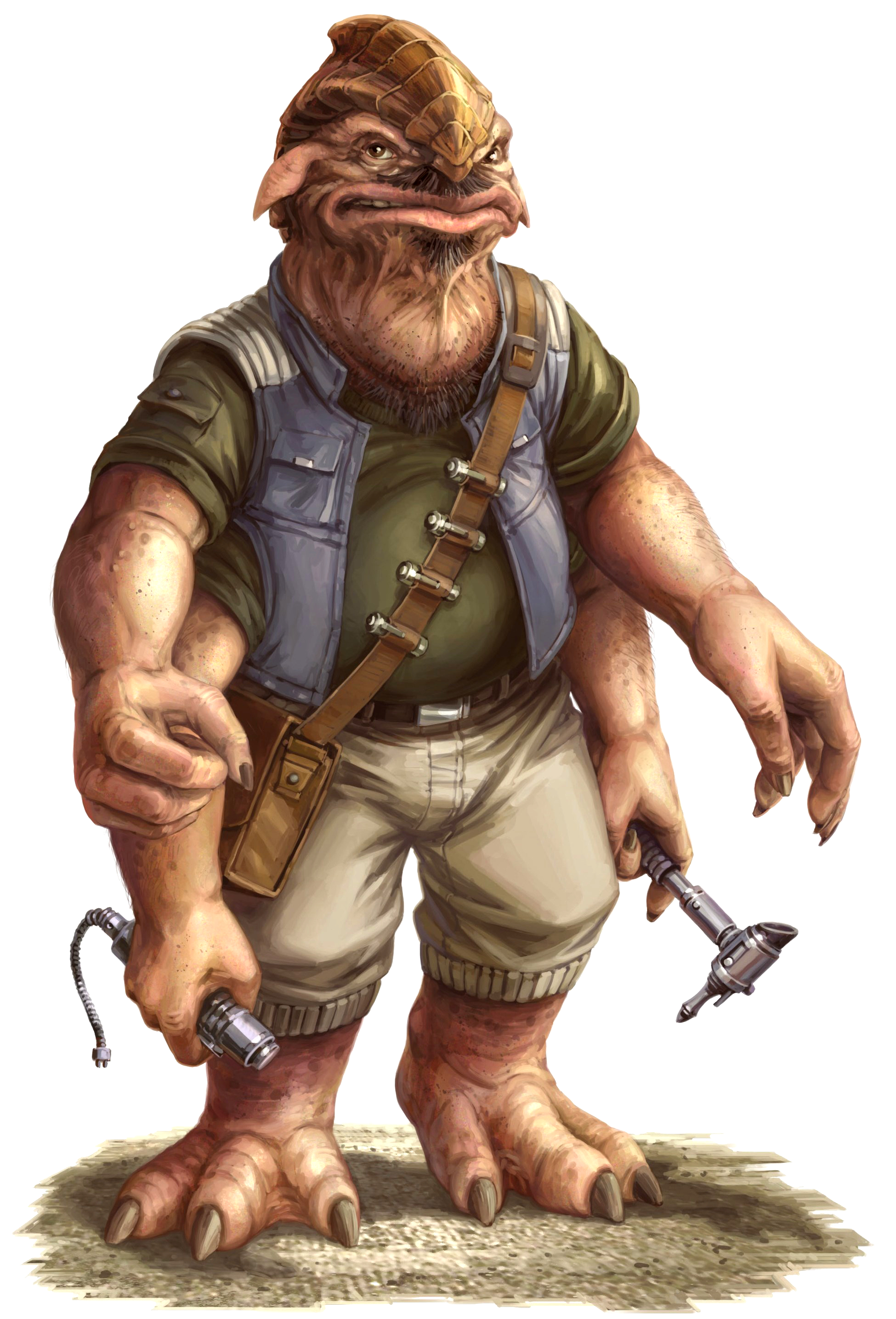 Besalisk evolved from large flightless avians, though they are often mistaken for a reptilian species. They are bulky, fleshy beings able to survive for long periods without food or water. During the reign of the Galactic Empire, Besalisks narrowly avoided enslavement by calling in favours with various influential underworld connections. Many are still working off their freedom, especially those Besalisk foolish or desperate enough to seek aid from the Huns.
Besalisk evolved from large flightless avians, though they are often mistaken for a reptilian species. They are bulky, fleshy beings able to survive for long periods without food or water. During the reign of the Galactic Empire, Besalisks narrowly avoided enslavement by calling in favours with various influential underworld connections. Many are still working off their freedom, especially those Besalisk foolish or desperate enough to seek aid from the Huns.
Besalisks have never sought official representation in the Republic Senate and generally seem content to go about their business and leave galactic affairs to politicians and bureaucrats of other species. Communities on their homeworld are sparsely populated, and few offworld colonies of Besalisks exist in any era.
Although Besalisks have contributed little to the galaxy in terms of resources and technology, they integrate easily into almost any civilized society and have no trouble using what other species have to offer.
Personality: Besalisks are seen as gluttonous, an unfair characterization considering their bodies store water for days and food for over a week. Another false assumption is that they are nervous or in poor shape because they sweat profusely. In truth, they're simply accustomed to much cooler temperatures than most other species. Besalisks are sociable, gregarious, and keen-witted.
Physical Description: Besalisks are stocky humanoids with thick arms, a bony headcrest surrounded on either side by short feathers, and a wide month with a large elastic sack dangling from it. The average Besalisk stands about 1.8 meters tall. Male Besalisks have four arms, while female Besalisks can have as many as eight arms.
Homeworld: Ojom, located in the Outer Rim, is a cold ocean world covered in giant glaciers that slowly mow across the planet's surface. Each glacier supports a small Besalisk commune. Ojom has many space stations orbiting it, most of them larger than any planet-based commune. These stations fill the role of Ojoin's spaceports and are more hospitable than the planers surface.
Language: Besalisks speak their own language, made up of grunts, growls, and barks. Written Besalisk uses a simple alphabet and short words. Besalisks speak Bask with ease.
Example Names: Lexia Trexor, Taster Dannex, Dexter Jettster, Rysken, Rysken Mokksi, Henk Zessek.
Age In Years: Child 1-8; Young Adult 9-12; Adult 13-48; Middle Age 49-60; Old 61-74; Venerable 75+.
Adventurers: Besalisks usually roam the galaxy to get away from their desolate homeworld or to turn a tidy profit. They often become embroiled in smuggling ventures, gunrunning, and organized criminal activities without realizing the gravity of the situation. Besalisks have been known to abruptly quit these activities on occasion to pursue their own interests, much to their former employers' dissatisfaction.
Besalisk Species Traits
- Ability Modifiers: -2 Dexterity, +2 Constitution
- Size: As Medium creatures, they have no special modifiers due to their size.
- Speed: base speed of 10 meters
- Extra Limbs (4): Besalisk have four arms. The extra limbs give them a +4 species bonus on Climb checks and grapple checks.
A Besalisk has one primary hand and three off hands. A Besalisk can wield up to four weapons, but the normal penalties for fighting with multiple weapons apply (see the Multiweapon Fighting feat description).
Female Besalisks can have as many as eight arms. They gain a species bonus on Climb checks and grapple checks equal to the number of arms they possess. Although Besalisks can hold items in each of their many hands, their brains are not complex enough to let them use more than four limbs in combat. - Food Stores: Besalisk can go without food for 8 days (instead of 3). They can go without water for 3 days (instead of 1). See Starvation and Thirst in Chapter Twelve of the Star War Roleplaying Game for more information.
- Skill Bonus: Besalisk receive a +4 species bonus on Survival cheeks in arctic environments and a +2 species bonus on Swim checks.
- Free Language Skills: Read/Write and Speak Besalisk.
Bimm
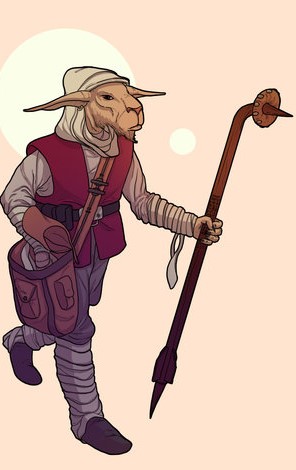 The planet Bimmisaari is home to two distinct sapient species. They each refer to themselves as Bimms, and so do the rest of the peoples of the galaxy. Although they are not cross-fertile, the two species arc both mild-tempered and peaceful and haw coexisted for nearly all their recorded history.
The planet Bimmisaari is home to two distinct sapient species. They each refer to themselves as Bimms, and so do the rest of the peoples of the galaxy. Although they are not cross-fertile, the two species arc both mild-tempered and peaceful and haw coexisted for nearly all their recorded history.
Xenobiologists believe that the near-Humans landed on Bimmisaari millennia ago under unknown circumstances and adopted Bimm society as their own–but they have no genetic relationship to any other fauna on the planet. The furred humanoid species is thought to have evolved naturally on the planet.
Bimms dwell side-by-side in picturesque cities that dot their homeworld, surrounded by thick forests. Alien visitors to these towns (or Bimm enclaves on other worlds) are always treated as honoured guests.
Personality: Both species of Bimms are mild-mannered and cordial. The near-Human Bimms greatly value storytelling, particularly tales of heroic adventures. For all their love of heroics, they favour scholarly and artistic pursuits, preferring to record or invent tales and ballads of heroic deeds rather than perform them. Nonetheless, it is not unheard of for a Bimm to join a group of adventurers to witness true-to-life heroics for use in creative works.
The furry, humanoid thrums are born merchants, hagglers, and shoppers. They low “the art of the deal” and do not consider a day complete if they haven't engaged in a spirited round of haggling or found a good deal at a wholesaler or market outlet. They consider fair dealing a point of honour, and stealing and shoplifting is viewed as a crime on the magnitude of murder.
All Bimms hold Jedi in especially high regard.
Physical Description: The first and most commonly encountered Bimms are near-Humans of short stature that roughly resemble Human children in physical build, although males can grow (and take pride in) thick, full beards. Males and females both stand Ito 1.5 meters tall.
The second species of Bimms are also small beings, standing 1 to 14 meters tall, with females slightly taller than males on avenge. They are floppy-eared humanoids covered in short fur that ranges in colour from tan to a deep black. Their faces feature elongated muzzles and tiny black eyes. They have three long fingers and an opposable thumb on each hand. They favour the colour yellow and are often clad in shades of that colour.
Homeworld: Bimmisaari, a temperate and densely forested planet located in the outer reaches of the Mid Rim.
Language: The two species of Moms share the same language, spoken as a harmonious singsong that sounds more like a collection of ballads than a standard form of communication.
Example Names: Rycar Ryjerd, Jarel Rulinam, Roki Morjara, Rav Mjalu.
Age In Years: Child 1-12; Young Adult 13-17; Adult 18-85; Middle Age 86-112; Old 113-133; Venerable 134+.
Adventurers: Bimm adventurers are typically scoundrels who work their way into the wealthy lives of nobles. Bimms of both types became Jedi in the days of the Old Republic.
Bimm Species Traits
- Ability Modifiers: -2 Strength, +2 Intelligence, +2 Charisma
- Size: As Small creatures, they gain a +1 size bonus to their Defense, a +1 size bonus on attack rolls, and a +4 size bonus on Hide checks, and a –4 penalty when grappling. They must use smaller weapons than Medium-size beings use, and their lifting and carrying limits are three-quarters those of Medium-size characters.
- Speed: base speed of 6 meters
- Free Language Skills: Read/Write and Speak Bimm.
Bith
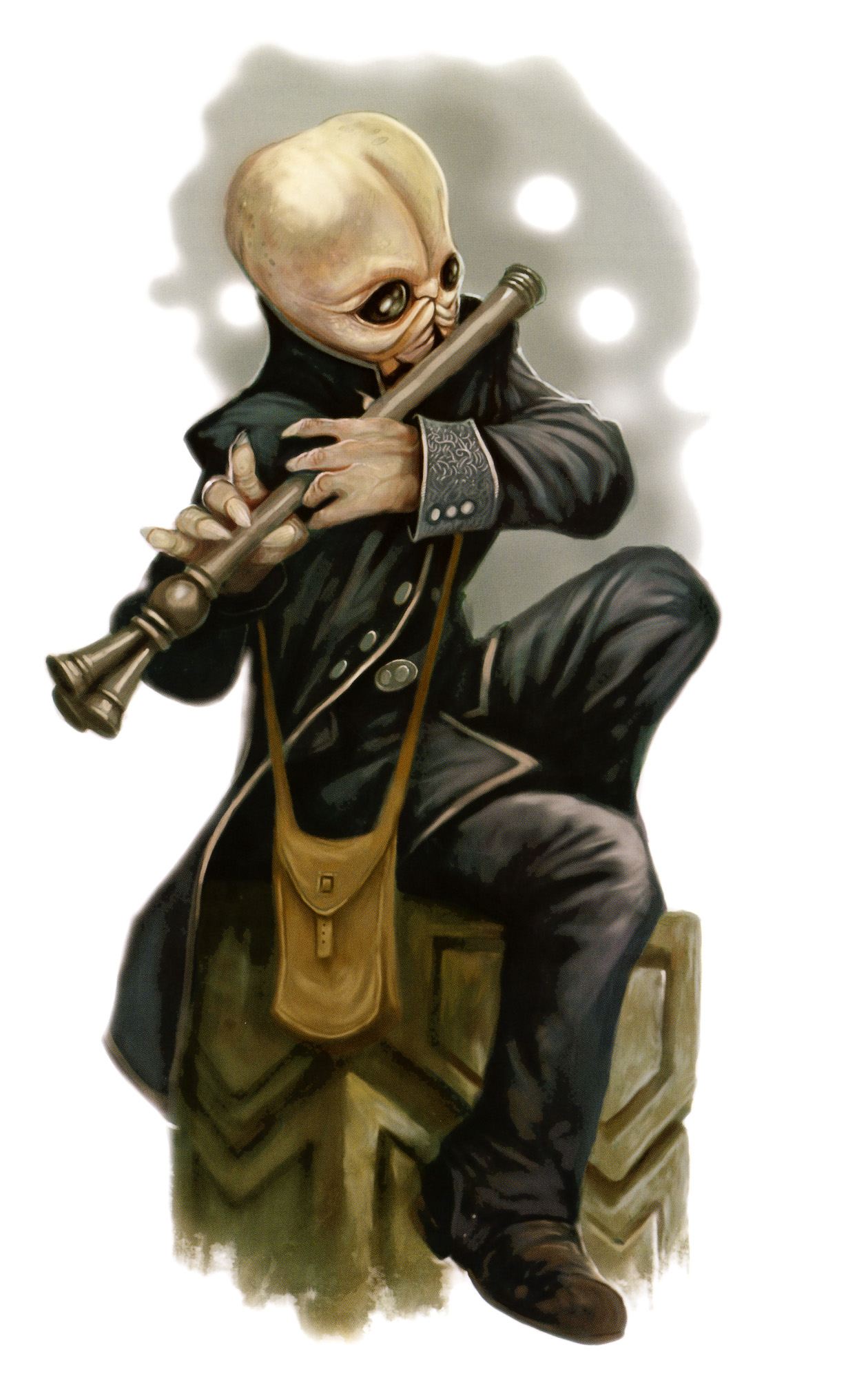 The Bith are an intellectually advanced humanoid species. Highly evolved and complex regions of their oversized brains relate to abstract skills such as language, mathematics, music, and scientific reasoning. In contrast, brain functions governing basic instinct and biological drives have atrophied.
The Bith are an intellectually advanced humanoid species. Highly evolved and complex regions of their oversized brains relate to abstract skills such as language, mathematics, music, and scientific reasoning. In contrast, brain functions governing basic instinct and biological drives have atrophied.
Warfare and strife has been unknown on the Bith homeworld for generations, and in the days of the Republic their senators were among the loudest voices in debates relating to galaxy-wide disarmament and universal weapons restrictions. During the terrors of the Clone Wars and the formation or the Empire, most Bith returned to the hermetically sealed, domed cities of their homeworld where they resolved to wait out the dark times. Some ambitious Bith continued to travel the galaxy throughout the Rebellion era, however. They included highly sought-after engineers, computer programmers, ship designers, negotiators, investigators, educators, and commercial artists. Shortly after the Hapans offered aid to the New Republic, the Bith re-established formal relations with the rest of the galaxy.
Bith do not need to sleep if they spend 4 to 6 hours of every 24-hour period engaged in focused meditation. During these meditative trances, the Bith remain somewhat aware of their surroundings.
Personality: Bith are dedicated pacifists and tend to be thoughtful, quiet, and introverted. They take great interest and pleasure in intellectual and artistic pursuits.
Physical Description: Bith have grey to milky-white skin and stand 1.6 to 1.8 meters tall. Their large black eves give them incredibly sharp vision, permitting them to focus on microscopic objects, but their long-range vision isn't very dear. (Their acute sense of smell partially compensates for their poor long-range vision.)
Homeworld: The small planet of Clak’Dor VII, located in the Outer Rim's Colu system (Mayagil Sector). Once a garden paradise with technologically advanced cities, Clak'Dor VII was reduced to an ecological wasteland following a war between the Bith cities of Nozho and Weogar, forcing the Bith to live in domed, artificially sustained ecosystems.
Language: Bith speak and read Bith. Bith who trawl the galaxy commonly speak Basic as well.
Example Names: Lirin Car'n, Fiz Cor'grill, Figrin Da'n, Doikk Na'ts, Tedn Dahai, Herian I'ngre, Angor Farn, Brin Da'p, Farquil, Foz Cor'grill, Nalan Cheel, Nara Deega, Ickabel G'ont, Tech M'or, Tisilan.
Age In Years: Child 1-11; Young Adult 12-15; Adult 16-50; Middle Age 51-70; Old 71-84; Venerable 85+.
Adventurers: Bith heroes tend to be nobles. Bith Force-users are not unheard of, and Bith Jedi consular, are relatively common during the days of the Old Republic. It is possible that some survived the Jedi Purge on the Bith homeworld.
Bith Species Traits
- Ability Modifiers: -2 Constitution, +2 Intelligence, +2 Charisma
- Size: As Medium creatures, they have no special modifiers due to their size.
- Speed: base speed of 10 meters
- Heightened Smell: Bith can identify an individual by smell at a range of 10 meters with a successful Wisdom check (DC 15).
- Meditative Trance: Instead of sleeping for 8 hours, a Bith can enter a trance that lasts 4 hours. At the end of the trance, he gains the benefits of having slept for 8 hours. The trance cannot be entered more than once per standard day. During the trance, the Bith remains some-what aware of his surroundings and can make listen and Spot checks to avoid being surprised.
- Micro-Vision: Bith gain a +4 species bonus on Search and Spot checks when limiting the use of these skills to an area up to 4 meters distant. However, Bith are myopic and suffer a -2 penalty on Spot checks to notice things that are 10 meters away or farther.
Bith suffer a -4 penalty per range increment on ranged attack rolls instead of the normal -2 penalty per range increment. - Free Language Skills: Read/Write and Speak Bith.
Blood Carver
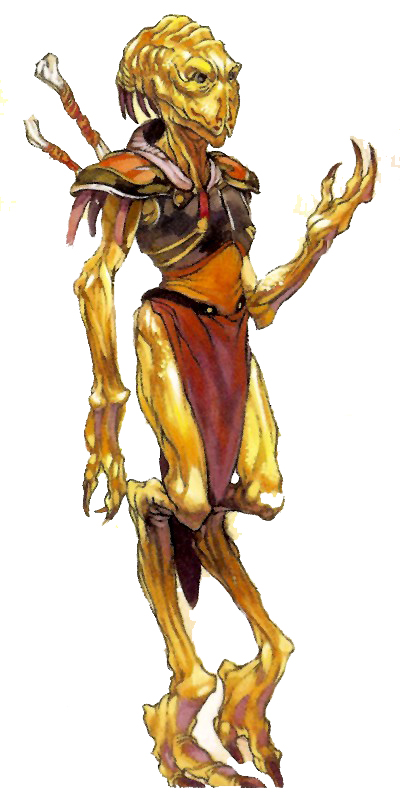 Blood Carvers joined the Republic 110 years before the Battle of Yavin and live up to their odd moniker in two ways. They are renowned for their masterful sculptures carved from bright red blood wood. They are also skilled assassins, though they rarely mutilate their victims. In that sense. “Blood Carver" is more of a metaphor.
Blood Carvers joined the Republic 110 years before the Battle of Yavin and live up to their odd moniker in two ways. They are renowned for their masterful sculptures carved from bright red blood wood. They are also skilled assassins, though they rarely mutilate their victims. In that sense. “Blood Carver" is more of a metaphor.
Personality: Blood Carvers are proud warriors with strong ties to their tribal leaders. They find flattery and exorbitant wealth disdainful. Among tribal ranks, obsequiousness and greed are punishable by anything from a simple beating to exile.
Physical Description: Triple-jointed humanoids with iridescent gold skin, wide beaklike noses, and beady black eyes, Blood Carvers stand about 2 meters tall. They typically wear close-fitting clothing that allows them to move quietly, and they sport tribal tattoos along the ridge of their nose flaps.
Homeworld: Blood Carvers originated on Batorine, a temperate world located in the Colonies region. Although many tribes of Wood Carvers relocated to Coruscant when their homeworld was attacked. Batorine is still home to many Blood Carver fiefdoms.
Language: Blood Carvers speak Batorese, a language that uses sounds as well as scents and skin coloration to a lesser degree. It is difficult for others, including protocol droids, to understand Batorese and impossible for others to speak it. The majority of Blood Camels learn to speak Basic as well.
Example Names: Ke Daiv, Pa Gara, Mu Fiev, Va Tosh.
Age In Years: Child 1-8; Young Adult 9-11; Adult 12-38; Middle Age 39-65; Old 66-82; Venerable 83+.
Adventurers: Blood Carvers rarely operate independently of their tribes. Exiled Blood Carvers will sometimes form small groups or individually embark on quests for glory or paths of enlightenment. Some Blood Carvers explore the galaxy in search of ways to improve their standing within their tribes. Blood Carver heroes can pursue any heroic class, although they are most commonly scouts, soldiers, or Force adepts.
Blood Carver Species Traits
- Ability Modifiers: +2 Dexterity, -2 Wisdom, -2 Charisma
- Size: As Medium creatures, they have no special modifiers due to their size.
- Speed: base speed of 12 meters
- Sneak Attack: If a Blood Carver faces an opponent who is unable to defend themselves effectively from their attack, they can strike a vital spot for 1d6 points of extra damage. This extra damage applies only to melee attacks or ranged attacks within 10 meters. The sneak attack damage applies only to opponents that have discernible anatomies and are susceptible to critical hits.
Blood Carver heroes and professionals gain an additional die of sneak attack damage every, five levels (+2d6 at 5th level. +3d6 at 10th level, and so on). The sneak attack bonus stacks with the sneak attack ability of prestige classes such as the bounty hunter and findsman. - Skill Bonus: Blood Carvers have flexible three-sectioned limbs. Blood Carver receive a +2 species bonus on Escape Artist checks.
- Free Language Skills: Read/Write and Speak Batorese.
Bothan
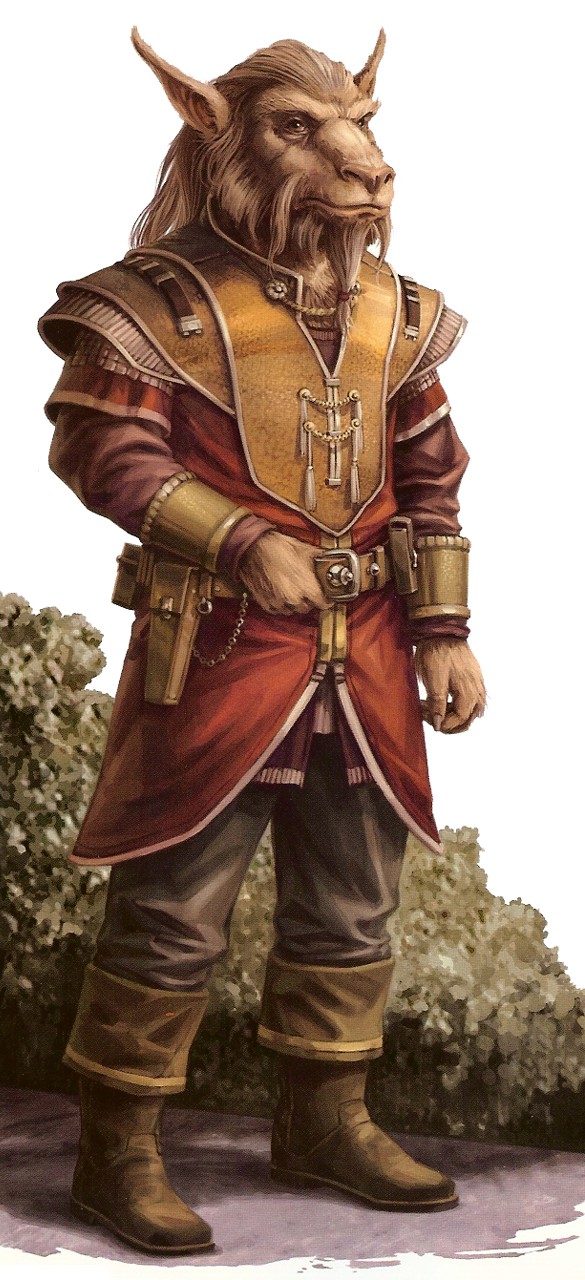 Bothans hail from the Mid Rim planet of Bothawui. They developed the technology to travel among the stars millennia ago and are longstanding members of galactic civilization.
Bothans hail from the Mid Rim planet of Bothawui. They developed the technology to travel among the stars millennia ago and are longstanding members of galactic civilization.
To the Bothans, information is the galaxy's most valuable currency, as well as its most potent weapon. As a culture, they believe that direct confrontation with foes-whether economic, political, or martial-is pointless. In an open conflict, the object or possession both sides desire is often damaged or destroyed. This attitude has made espionage a natural line of work for Bothans. Information and spies are their greatest exports. The famed Bothan spynet is the largest independent intelligence-gathering organization the galaxy has ever known.
Beings of power everywhere find Bothans irritating because they have a tendency to use every hit of information they can find to acquire leverage or money. However, no one wants to be the only person without access to the spynet, so everyone continues to deal with the Bothans.
Personality: Bothans are manipulative, crafty, suspicious, and curious by nature. Some might even call them paranoid. They are also loyal and brave.
Physical Description: Bothans stand 1.6 meters tall on average and are covered with fur that ripples in response to their emotional state. They have tapered, pointed ears, and both males and females sport beards.
Homeworld: The industrial world of Bothawui, located in the Mid Rim. Bothans also populate various colony worlds throughout the Mid Rim, including Kothlis and Torolis.
Language: Bothans speak and read Bothese and Basic.
Example Names: Borsk Fey'lya, Karka Kre'fey, Koth Melan, Tav Breil'lya, Tereb Ab'lon, Askar Rayl'skar, Asyr Sei'lar, Velst Nay'sro, Escra Plo'kre, Oneron Fil'vye, Liska Dan'kre, Tchaw Fenn, Se'lab, Maxeena Sov'yla, Drovus.
Age In Years: Child 1-11; Young Adult 12-16; Adult 17-45; Middle Age 46-65; Old 66-84; Venerable 85+.
Adventurers: Bothan adventurers, such as operatives in the spynet, engage in daring deeds-even when such deeds place them at great personal risk. In addition to intelligence operatives, Bothan heroes serve as Soldiers and pilots, diplomats and ambassadors. Their curiosity leads some to be explorers and scouts. Even when a Bothan takes up a noble cause, their cultural upbringing makes it hard not to consider the profit and prestige in the situation. Bothan Jedi are rare, as most Bothans lack the Jedi Order's selfless altruism.
Bothan Species Traits
- Ability Modifiers: +2 Dexterity, -2 Constitution
- Size: As Medium creatures, they have no special modifiers due to their size.
- Speed: base speed of 10 meters
- Skill Bonus: Bothans are skilled at intelligence gathering. Bothan receive a +2 species bonus on Gather Information and Spot checks.
- Free Language Skills: Read/Write and Speak Basic and Bothese.
Caamasi
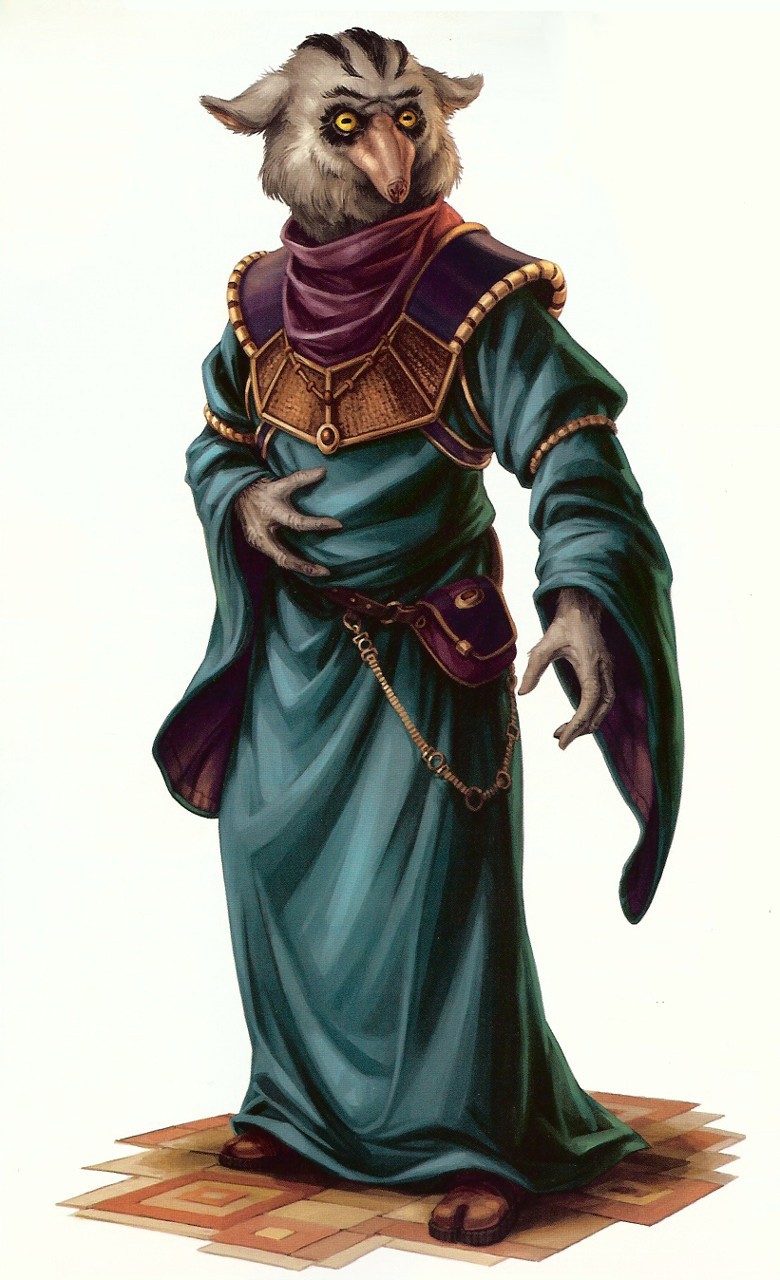 Other cultures view the Caamasi as artistic, wise, and peaceful. On many worlds, the word for “friend from afar" or "misted stranger” is "caamasi." Among theft own people, the Caamasi have a legend that says that when the Jedi Order first formed millennia ago, Jedi came to Caamas to learn how to use the Force ethically. Even if this story is not true, the gentle manner and moral strength of the Caamasi make it easy to believe.
Other cultures view the Caamasi as artistic, wise, and peaceful. On many worlds, the word for “friend from afar" or "misted stranger” is "caamasi." Among theft own people, the Caamasi have a legend that says that when the Jedi Order first formed millennia ago, Jedi came to Caamas to learn how to use the Force ethically. Even if this story is not true, the gentle manner and moral strength of the Caamasi make it easy to believe.
During the height of the Old Republic, Caamasi Jedi were uncommon. Shortly after the Clone Wars, their homeworld of Caamas was devastated by an orbital bombardment ordered by the Emperor. The planet's vegetation and animal life, including most Caamasi, died within a day, leaving a dead world. The few hundred thousand Caamasi who roamed the galaxy afterward had been elsewhere at the time, or had miraculously survived the bombardment. By the time of The New Jedi Order era, most Caamasi hail from the planet Kerilt, though there was once a considerable colony on Alderaan. The Alderaanian Caamasi also met their end by way of the Emperor's whim.
Caamasi display a unique ability to share memories, which they call memnii. A Caamasi can effectively record a memory in their mind so that it is never forgotten. Experiencing memnii is as vivid as participating in the events in question. Using a sort of telepathy, a Caamasi can share memnii with another Caamasi, or in some cases, a Jedi or other Force-user. Caamasi sometimes intermarry between clans specifically to share memnii with their entire culture. The desire to spread memnii results from a need to never forget the wisdom of their ancestors or the beauty of Caamas. As a result, Caamasi are just as likely to store and share very unpleasant memnii such as vivid memories of brutal battles and cruel tortures, as well as experiences as sweet and loving as the births of their children or the honour and wisdom of revered ancestors.
Personality: Caamasi are thoughtful, contemplative pacifists. They enjoy exploration, artistic pursuits, and conversation. They are generous, considerate. and slow to pass judgment.
Physical Description: Caamasi have tall, lean bodes covered with golden down. Regal rings of purplish fur surround their eyes, while stripes of purple fur extend around to the backs or their heads and shoulders. Caamasi have long, delicate, three-fingered hands. They average 1.8 meters tall.
Homeworld: The ravaged world of Caamas, located in the Core Worlds region. Following the Empire's attack on Caamas, survivors migrated to other worlds including Kerilt, a Mid Rim jungle world in the Algara system.
Language: Caamasi speak and read Caamasi and Basic.
Example Names: Elegos A'kla, Ylenic It'kla, Releqy, Tehas Sulkee, Meqli Likarin.
Age In Years: Child 1-11; Young Adult 12-15; Adult 16-49; Middle Age 50-76; Old 77-89; Venerable 90+.
Adventurers: Because of their pacifistic nature, Caamasi are never soldiers or thugs. Heroic Caamasi tend to be nobles. Caamasi with a strong connection to the Force may become Jedi consulars who use their Force powers to help mediate disputes.
Caamasi Species Traits
- Ability Modifiers: -2 Strength, -2 Constitution, +4 Wisdom
- Size: As Medium creatures, they have no special modifiers due to their size.
- Speed: base speed of 10 meters
- Memory Sharing (Memnii): Caamasi can create strong, lasting memories and share them with others of their species by using a kind of telepathy. Among the Caamasi, sharing memnii is an automatic ability, requiring only time. Sharing a memory requires as much time as the events remembered.
Force-using characters can also receive memnii from a willing Caamasi with a successful Telepathy check (DC 15). Experiencing memnii is not like having a photographic memory of those events. Instead, the receiving character must make an Intelligence check (DC 10) to remember specific details. A character who accesses a memnii with Telepathy has a +2 circumstance bonus on Intelligence checks to remember details about the events in question. - Skill Bonus: Caamasi receive a +2 species bonus on Diplomacy checks.
- Free Language Skills: Read/Write and Speak Basic and Caamasi.
Caarite
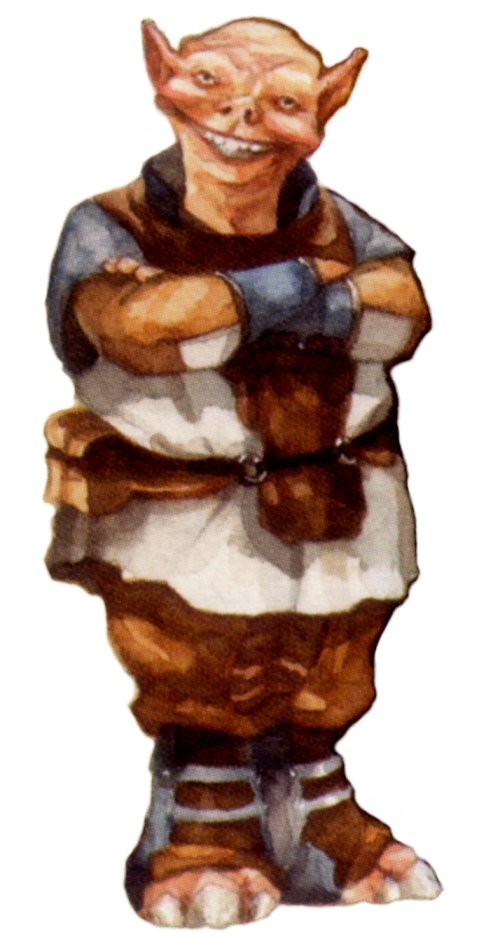 Caarites are sly, ingratiating beings whose friendly demeanours overshadow their penchant for crooked dealings. While they suffer from a rather poor reputation, it is difficult for anyone around a Caarite for an extended time to believe it capable of anything truly malicious. They wear broad grins, bearing a double row of wide, flat, white teeth. Taking advantage of their frail, friendly appearance, they seize the upper hand in negotiations, exuding an almost childlike charm when dealing directly with large groups of individuals.
Caarites are sly, ingratiating beings whose friendly demeanours overshadow their penchant for crooked dealings. While they suffer from a rather poor reputation, it is difficult for anyone around a Caarite for an extended time to believe it capable of anything truly malicious. They wear broad grins, bearing a double row of wide, flat, white teeth. Taking advantage of their frail, friendly appearance, they seize the upper hand in negotiations, exuding an almost childlike charm when dealing directly with large groups of individuals.
Personality: Caarites are friendly, entertaining, and opportunistic. They desire to get the better of their rivals by any means necessary and demonstrate few scruples at the bargaining table.
Physical Description: Caarites stand 1 meter tall (on average), with features that are vaguely porcine. They have slightly elongated snows turned delicately upward at their tips. Their broad, open faces make their open smiles look even friendlier. Their flesh is pale pink, and their bodies are hairless.
Homeworld: The humid Outer Rim planet of Caarimon.
Language: Carnes speak Caarimala and Basic. Many Caarites know at least one additional language.
Example Names: Velin Wir, Thurm Loogg. Belrwm Mar, Fiana Jor, Zoda Brell.
Age In Years: Child 1-10; Young Adult 11-15; Adult 16-44; Middle Age 45-57; Old 58-74; Venerable 75+.
Adventurers: Caarites who become adventurers do so for personal gain. They favour nonviolent tactics when face-to-face with an adversary, but they nonetheless carry a number of tools and ranged weapons. Caarites Favour the scoundrel and finger classes. Because they are averse to physical combat, they do not take up the soldier class. Some Caarites arc Force-Sensitive, but their inherent greed prevents them from following the path of the Jedi.
Caarite Species Traits
- Ability Modifiers: -2 Constitution, +2 Charisma
- Size: As Medium creatures, they have no special modifiers due to their size.
- Speed: base speed of 6 meters
- Climate Adaptation: Caarite gain a +2 species bonus on Survival checks in hot climates and suffer a -2 species penalty on Survival checks in cold climates.
- Free Language Skills: Read/Write and Speak Basic and Caarimala.
Cathar
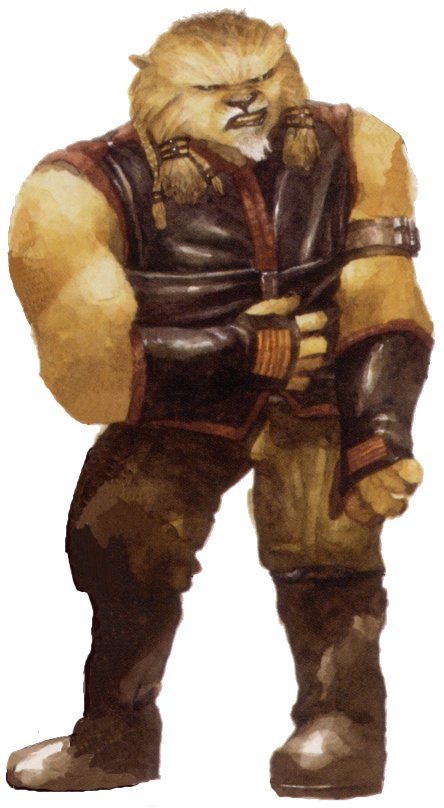 The Cathar are an ancient, socially advanced species of bipedal feline humanoids from a planet of the same name. Cathar itself is a large world of numerous ecological niches, Including rough uplands with gigantic insect predators.
The Cathar are an ancient, socially advanced species of bipedal feline humanoids from a planet of the same name. Cathar itself is a large world of numerous ecological niches, Including rough uplands with gigantic insect predators.
The Cathar species dwells in large, living city-trees. Each tree is artistically candid with friezes showing the triumphant history of the Cathar and their heroes. Cathar use the wide grasslands known as the Vast Veldt as a place of solitude.
Two of the greatest Cathar heroes, the female Sylvar and her mate Crado, were powerful Jedi Knights. Four thousand years before the Galactic Civil War, Crado fell to the dark side under the tutelage of Exar Kun. He was destroyed in an explosion after flying to activate an ancient Sith superweapon for his master. Sylvar, angry over the death of her mate, almost fell to the dark side herself before regaining the Jedi path. Both are remembered on Cathar itself in meticulously carved works of tree-art.
Personality: Cathar are proud, passionate beings with strong morals and equally strong ties to tradition and family. They also form strong friendships and unshakable loyalties. Cathar generally hate as fiercely as they love. Although even-tempered, they are often quick to act. Their ferocity in battle is both legendary and terrifying.
Physical Description: Cathar have leonine features and flowing manes, with males' manes generally larger than those of females. Male Cathar have short beards and two tusks jutting from the lower jaw, while females merely have impressive fangs along the upper jaw. Males average 1.8 meters tall. while females average 1.6 meters tall.
Homeworld: Cathar, a temperate world located in the Expansion Region.
Language: Cathar speak and read Catharese and Basic. punctuating their spoken words with the occasional low growl.
Example Names: Crado, Elashi, Feeth, Larducias, Manshara, Nondon, Nonak, Stragos, Sylvar, Tinisho.
Age In Years: Child 1-11; Young Adult 12-17; Adult 18-49; Middle Age 50-65; Old 66-89; Venerable 90+.
Adventurers: Cathar adventurers can belong to any heroic class, although nobles, scouts, and soldiers are the most common. Force-sensitive Cathar often hear the call to join the ranks of the Jedi Order as Jedi consulars or Jedi guardians. Cathar scoundrels are rare. but those that exist have morals and loyalties that they would never violate for personal gain.
Cathar Species Traits
- Ability Modifiers: +2 Dexterity, -2 Intelligence
- Size: As Medium creatures, they have no special modifiers due to their size.
- Speed: base speed of 12 meters
- Natural Weapons (Claws): Cathar have sharp claws that allow them to make unarmed attacks without provoking attacks of opportunity. As an attack action, a Cathar can make one claw attack (with no penalty) or combine its primary claw attack with off-hand claw attacks (suffering the normal penalties for multiweapon fighting). Each claw deals 1d6 points of slashing damage plus the Cathar's Strength modifier.
- Free Language Skills: Read/Write and Speak Basic and Catharese.
Celegian
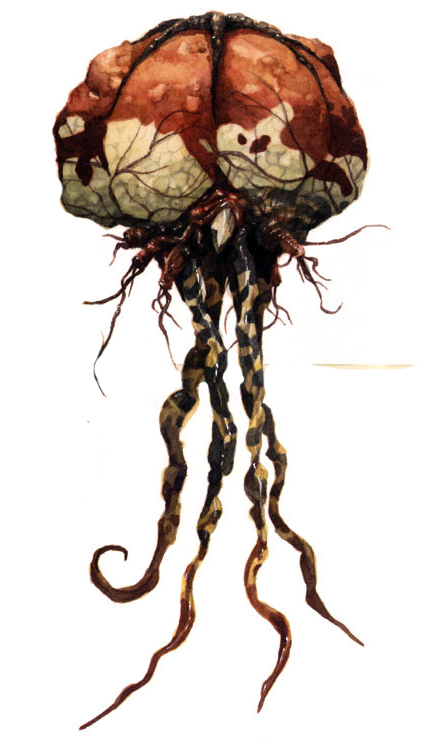 Celegians arc an ancient species known for their great intellect and wisdom. Evolved from ocean-dwelling invertebrates, the Celegians' ancestors eventually adapted to living on land. The atmosphere of their homeworld is rich in cyanogen gas, which is poisonous to most sentient beings. Conversely, oxygen is lethal to Celegians.
Celegians arc an ancient species known for their great intellect and wisdom. Evolved from ocean-dwelling invertebrates, the Celegians' ancestors eventually adapted to living on land. The atmosphere of their homeworld is rich in cyanogen gas, which is poisonous to most sentient beings. Conversely, oxygen is lethal to Celegians.
To move their massive jellyfish like bodies, Celegians evolved a natural form of locomotion similar to a repulsorlift generator. Their soft fleshy bodies, writhing masses of tentacles, and dependence on life-support chambers result in Celegians looking as if they constantly float in water.
Personality: Celegians are wise, thoughtful beings who search for logical solutions to problems. They enjoy contemplating riddles, puzzles, and paradoxes. Celegians rarely put themselves in harm's way and avoid conflict wherever possible.
Physical Description: A Celegian's body resembles a brain like organism with a mass of tentacles floating beneath it. The brain averages 1.2 meters in diameter, and the tentacles vary in length from 1.8 to 22 meters. Away from their homeworld. Celegians are always encountered within sonic sort of mobile life-support chamber, usually made of transparisteel.
Homeworld: Celegia, an ancient world of raging seas located in the Expansion Region.
Language: Celegians communicate using a sophisticated form of telepathy. They possess no spoken or written language.
Example Names: Ealu, Jolorr, Ooroo, Ruwaa.
Age In Years: Child 1-10; Young Adult 11-20; Adult 21-142; Middle Age 143-210; Old 211-250; Venerable 251+.
Adventurers: Celegians are natural explorers and are occasionally found in the company of other species with similar interests. Celegians encountered far from their homeworld are usually nobles or scouts. Celegians Force adepts and Jedi are extremely rare.
Celegian Species Traits
- Ability Modifiers: -2 Dexterity, +2 Intelligence, +2 Wisdom, -2 Charisma
- Size: As Large creatures, they suffer a -1 size penalty on Defense, a -1 size penalty on attack rolls, and a -4 penalty on hide check, and a and a +4 penalty when grapplings. They have a Face/Reach of 2m by 2m/4m. Their lifting and carrying limits are doubled of Medium-sized characters.
- Speed: Celegians use a natural form of levitation to hover and move about. Within a cyanogen atmosphere or floating life-support chamber, Celegians fly at a speed of 6 meters (average manoeuvrability). They Swim at a speed of 16 meters in the cyanogen seas of their homeworld.
- Cyanogen Breather: Celegian cannot survive without their native cyanogen atmosphere. After being exposed to an oxygen atmosphere for 1 round without a life-support chamber, a Celegian must make a Fortitude save (DC 10). The DC increases by +4 each subsequent round, if the save fails, the Celegian suffers 1d6 points of temporary Constitution damage per round until it is returned to a cyanogen atmosphere. Exposure to cyanogen causes a similar reaction in oxygen breathers.
- Expert Swimmer: Due to their tumultuous cyanogen seas of their homeworld Celegain became expert swimmers. Celegian gain a +10 species bonus on Swim checks.
- Telepathy: A Celegian can communicate telepathically with any number of sentient beings within 500 meters. A being that wishes to resist telepathic contact with a Celegian must make a Will save (DC 10 + the Celegian's Wisdom modifier). A successful saving throw denies the Celegian telepathic contact, although the character in question knows that something has attempted to contact him. The Celegian can continue to attempt to establish contact for as long as the target is within range. All beings that receive telepathic communication from a Celegian "hear" the message in their own primary language. This ability is primarily used for communication: it cannot "steal" memories or information.
- Free Language Skills: None
Cerean
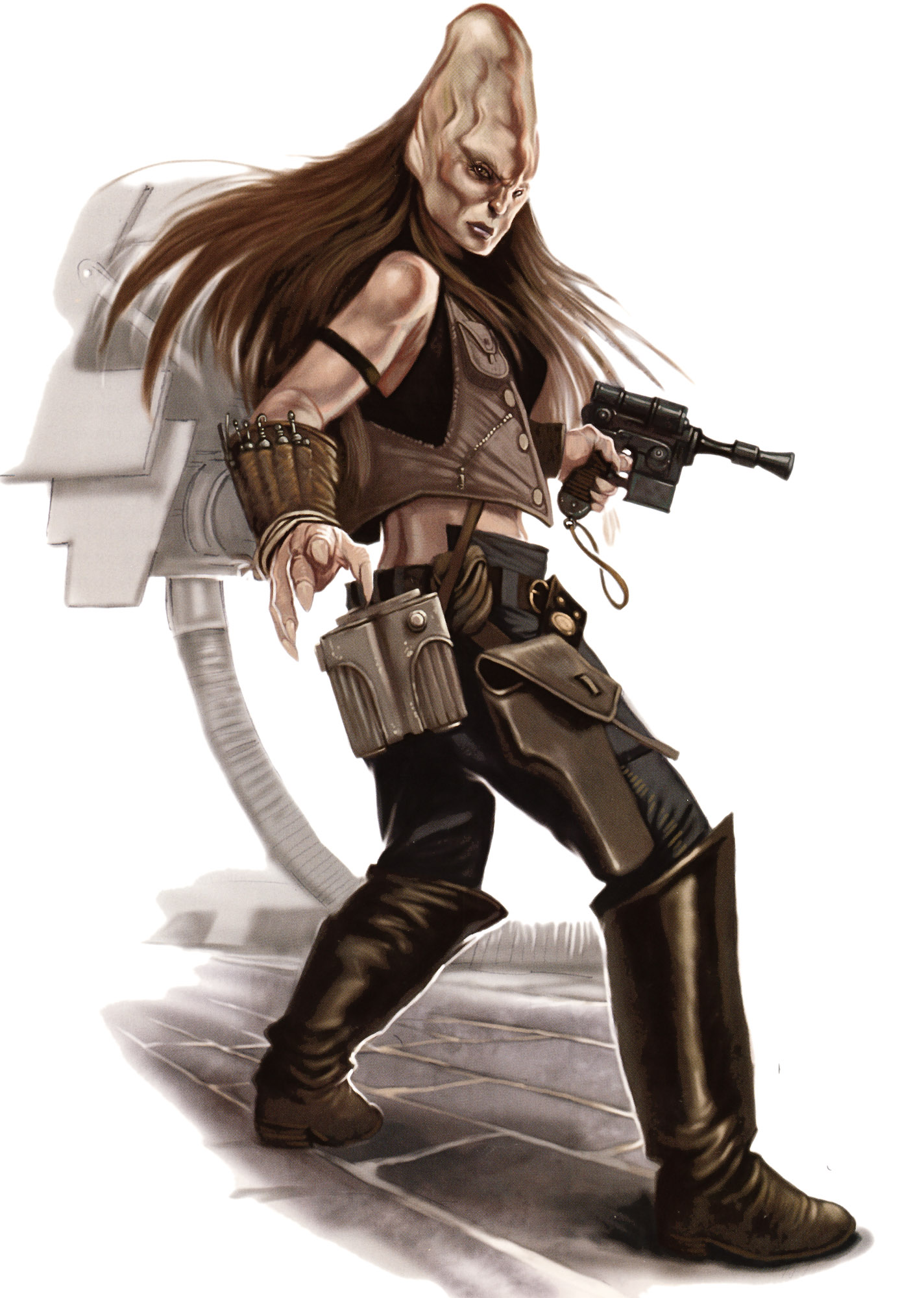 Cereans are a sophisticated and cultured humanoid species that originated on Cerra, a world on the fringes of known space. Their elongated heads distinguish them from most other humanoid species.
Cereans are a sophisticated and cultured humanoid species that originated on Cerra, a world on the fringes of known space. Their elongated heads distinguish them from most other humanoid species.
Cereans established contact with the rest or the galaxy shortly before the Galactic Republic was transformed into the Empire. The Cereans swiftly gained galactic fame as expert astrogators, cryptographers, and economists. Few patterns or trends, no matter how convoluted or obscure, escape the notice of a Cerean.
The Cerean homeworld is largely an unspoiled paradise. Cerean society is matriarchal, and the Cerean culture's traditional values emphasize living in harmony with nature and minimizing any impact on the environment from technology.
The peaceful philosophies of the Jedi appeal to Cereans, and those who long for adventure find the tenets and ways of the Jedi Order very alluring.
Personality: Cereans tend to be calm, rational, and extremely, logical.
Physical Description: Cereans average 2 meters tall and have a similar build to Humans. Their elongated craniums house complex binary brains that enable them to process information and solve problems rapidly. Cereans also have two hearts beating in their chests.
Homeworld: Cerea, a blissful planet located in the Mid Rim.
Language: Cereans speak and read Cerean and Basic.
Example Names: Ki-Adi, So Leet, Sylvn, Ti-Dal, Maj-Odo, Skeel,Kordren, Bin-Garda.
Age In Years: Child 1-10; Young Adult 11-15; Adult 16-35; Middle Age 36-53; Old 54-64; Venerable 65+.
Adventurers: Cereans who become adventurers do so in direct contradiction to their traditions and beliefs. Even so, when a cause or situation turns a Cerean to this path, they try to approach life with as many of the Cerean beliefs intact as possible. Aggression should be the last resort after all peaceful solutions are attempted, for example. The binary brain allows a Cerean to constantly weigh both sides in any disagreement and give two points of view equal consideration. This ability extends even to issues surrounding the Force, and a Cerean Force-user often contemplates the light side and the dark side simultaneously.
Cereans who choose a path of adventure and danger can belong to any heroic class.
Cerean Species Traits
- Ability Modifiers: -2 Dexterity, +2 Intelligence, +2 Wisdom
- Size: As Medium creatures, they have no special modifiers due to their size.
- Speed: base speed of 10 meters
- Quick Reaction: Despite their general lack of coordination, Cerean' reaction speed is superior to that of most other species. Cerean gain a +2 species bonus on initiative checks.
- Free Language Skills: Read/Write and Speak Basic and Cerean.
Chadra-Fan
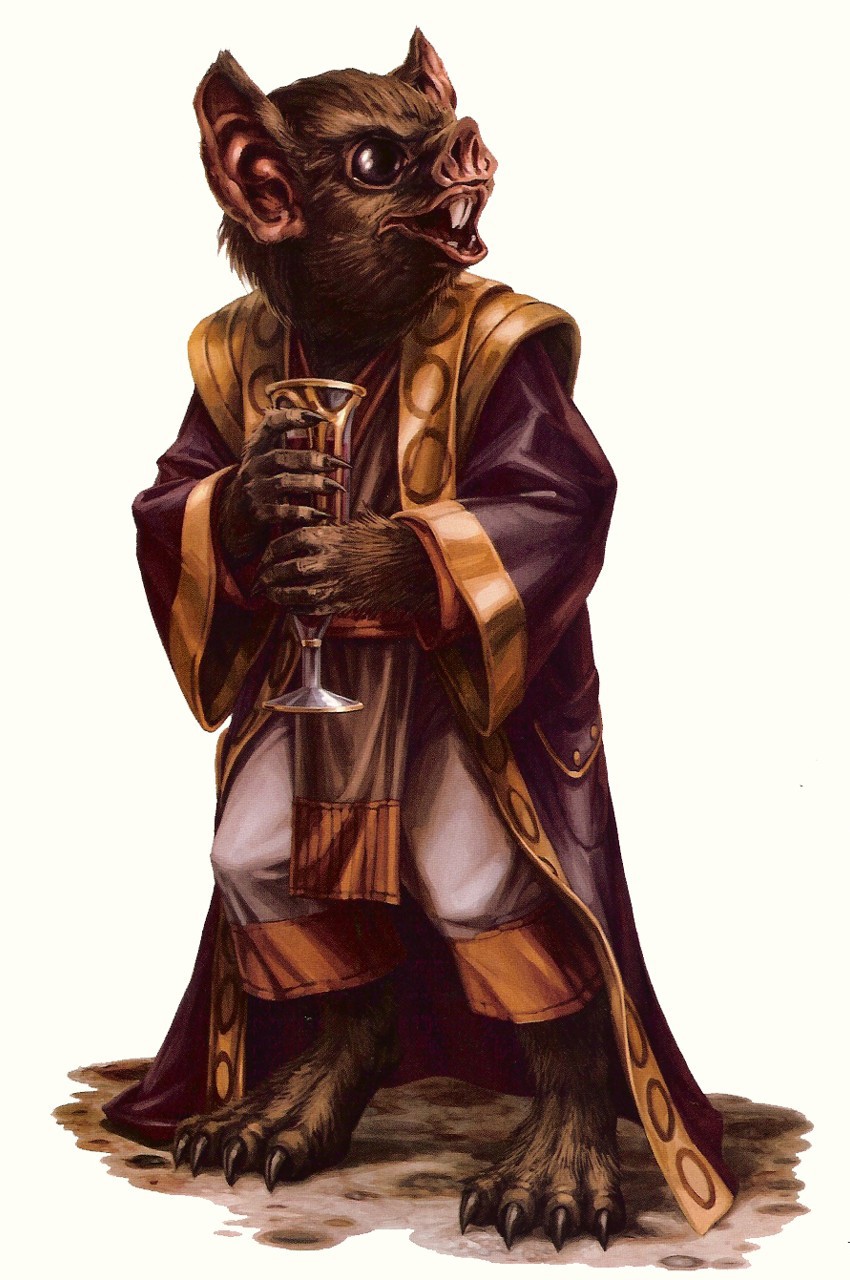 Chadra-Fan hail from the world of Chad in a rarely visited Outer Rim system of the same name. Their culture is technologically primitive by galactic standards; a string of natural disasters on their homeworld has forced them to focus on the necessity of survival. What high technology they possess has been brought to Chad by scouts and traders and subsequently copied or modified by the Chadra-fan.
Chadra-Fan hail from the world of Chad in a rarely visited Outer Rim system of the same name. Their culture is technologically primitive by galactic standards; a string of natural disasters on their homeworld has forced them to focus on the necessity of survival. What high technology they possess has been brought to Chad by scouts and traders and subsequently copied or modified by the Chadra-fan.
Chadra-Fan compulsively tinker. Any mechanical device left within reach has the potential to be disassembled and then reconstructed. As they have been subjecting devices to this treatment since early child-hood. Chadra-Fan have gained an innate sense of how most technology functions and are often found working as mechanics.
Virtually all Chadra-Fan that are encountered off their homeworld are either slaves or former slaves. Curiously, most Chadra-Fan do not resent being enslaved, as they view it as a grand adventure.
Personality: In general, Chadra-Fan are exuberant in the extreme and like virtually everyone they meet. It takes quite a bit of abuse to curtail of obliterate their cheery disposition. Chadra-Fan do not survive well on their own and constantly seek companionship.
Physical Description: Chadra-Fan are small humanoids with flat faces, round dark eye, large ears, and flat noses. Chadra-Fan stand 1 meter tall (on average), and their entire bodies are covered in gleaming fur, except for their oversized hands.
Homeworld: Chad, a technologically primitive Outer Rim world known for its vast seas, sprawling marshes, and ferocious hurricanes.
Language: Chadra-Fan speak and read Chadra-Fan, but those who leave their homeworld pick up Basic quickly. Their voices sound squeaky and nasal when they speak Basic.
Example Names: T'achak, T'andar, T'ar Ta'avon, Yarbolk Yemm, Kabe, Chan, Fandar, Fugo, Tutti Snibit, Trubor.
Age In Years: Child 1-11; Young Adult 12-15; Adult 16-40; Middle Age 41-59; Old 60-79; Venerable 80+.
Adventurers: Chadra-Fan heroes are typically fringers, scoundrels, and tech specialists. Chadra-Fan Jedi, are extremely rare, although at least one is known to exist during The New Jedi Order era.
Chadra-Fan Species Traits
- Ability Modifiers: -2 Strength, +2 Dexterity, -2 Wisdom, +2 Charisma
- Size: As Small creatures, they gain a +1 size bonus to their Defense, a +1 size bonus on attack rolls, and a +4 size bonus on Hide checks, and a –4 penalty when grappling. They must use smaller weapons than Medium-size beings use, and their lifting and carrying limits are three-quarters those of Medium-size characters.
- Speed: base speed of 6 meters
- Darkvision: Chadra-Fan can see in the dark up to 20 meters. Darkvision is black and white only but otherwise functions as normal sight.
- Isolation Aversion: Chadra-Fan do not handle isolation well. After each 24-hour period spent alone, a Chadra-Fan must succeed at a Will save (DC 15) or suffer 1d4 points of temporary Strength, Dexterity, and Constitution damage. A Chadra-Fan reduced to 0 Strength or Dexterity falls unconscious and can no longer make saving throws. A Chadra-Fan reduced to 0 Constitution or 0 wound points dies.
- Low-Light Vision: Chadra-Fan can see twice as far as normal in dim light, and retain the ability to distinguish color and detail under these conditions.
- Skill Bonus: Chadra-Fan are Mechanically inclined. Chadra-Fan receive a +2 species bonus on Repair checks.
- Free Language Skills: Read/Write and Speak Chadra-Fan.
Chagrian
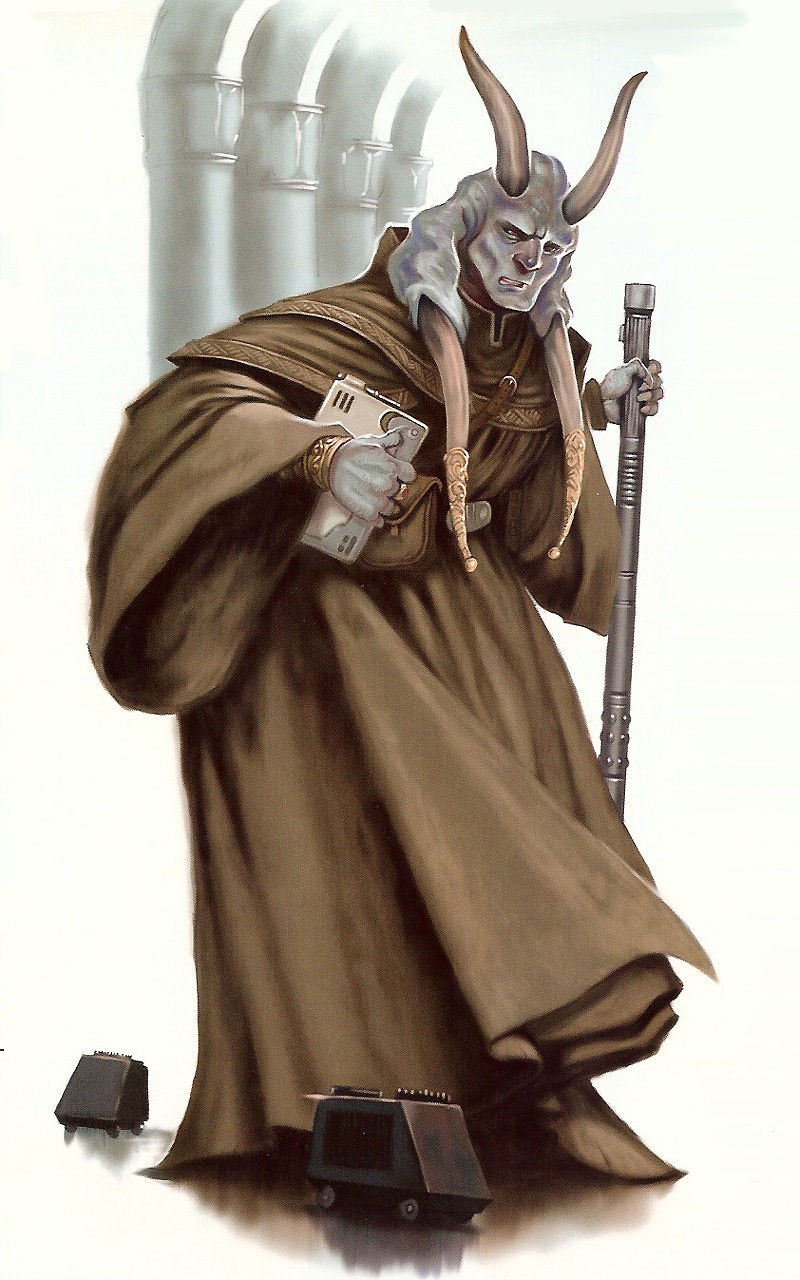 Chagrians arc powerfully built amphibian humanoids that are equally comfortable on land and in water, something that is reflected both in their architecture and in their culture. Early in the evolutionary stages of life on Champala, the system's sun went through an unstable period and bombarded its orbiting bodies with massive amounts of radiation. Only species that developed an ability to withstand the radiation survived. The Chagrians were among those species, and their skin-which ranges in colour from light blue to deep indigo-continues to provide them with remarkable natural protection from radiation of all kinds.
Chagrians arc powerfully built amphibian humanoids that are equally comfortable on land and in water, something that is reflected both in their architecture and in their culture. Early in the evolutionary stages of life on Champala, the system's sun went through an unstable period and bombarded its orbiting bodies with massive amounts of radiation. Only species that developed an ability to withstand the radiation survived. The Chagrians were among those species, and their skin-which ranges in colour from light blue to deep indigo-continues to provide them with remarkable natural protection from radiation of all kinds.
Chagrian civilization arose on the thin coastal bands of Champala's small, jungle-covered continents. Their cities are built in long strips in the tidal vanes. At high tide, most buildings are completely submerged. When these buildings fill with water during high tide, the Chagrians swim from building to building, from floor to floor. All but Champala's oldest starports are built on high plateaus well away from the cities, with aircars ferrying visitors back and forth.
Chagrians are born with a weak sense of taste and lose it completely shortly after becoming adults. They do not celebrate eating the way many other species do. Indeed, they view it as a necessary nuisance; food is fuel for the body, nothing more. Modem Chagrian adults consume nutrient capsules to avoid wasting time eating. When traveling the galaxy, they carry nutritional analysers to scan unfamiliar food and determine its nutritional worth.
A number of Chagrians joined the Rebel Alliance, and several of their number played a major part in liberating Mon Calamari and other water worlds from Imperial domination. As the New Republic formed, the Chagri system was one of the first to join, and the Chagrians remain among its staunchest supporters.
Personality: Chagrians are law-abiding and even-tempered. The species has always known abundance, so greed and avarice are uncommon traits among them. Chagrians prefer to live in cosmopolitan areas, where they can interact with other people and species.
Physical Description: Chagrians have blue skin. Males and females both have a pair of horns, known as “lethorns," protruding from fleshy growths on the side of their heads. Lethorns can become quite large and can be draped over the shoulders. Males have a second pair of horns sprouting from the tops of their heads; these sharp horns were once used to battle for mates, but now they serve only as a source of vanity. Males and females of the species both stand between 1.7 arid 2.2 meters tall.
Homeworld: The water world of Champala in the Chagri system, a favourite vacation spot among the Inner Rim worlds.
Language: Chagrians speak and read Chagri. Chagrians who leave Champala typically learn to speak Basic as well.
Example Names: Mas Amedda, Belar Tasseva, Myn Seda, Shiran Vallendri, Ketrias Gorran.
Age In Years: Child 1-12; Young Adult 13-16; Adult 17-42; Middle Age 43-56; Old 57-75; Venerable 76+.
Adventurers: Chagrian adventurers can be of any heroic class, although Chagrian Jedi are rare.
Chagrian Species Traits
- Ability Modifiers: +2 Strength, -2 Dexterity
- Size: As Medium creatures, they have no special modifiers due to their size.
- Speed: base speed of 10 meters
- Breathe Underwater: As amphibious creatures, Chagrian can't drown in water. They gain a +4 species bonus on Swim checks.
- Low-Light Vision: Chagrian can see twice as far as normal in dim light, and retain the ability to distinguish color and detail under these conditions.
- Radiation Resistance: Chagrian receive a +4 species bonus on Fortitude saves against radiation.
- Free Language Skills: Read/Write and Speak Chagri.
Charon
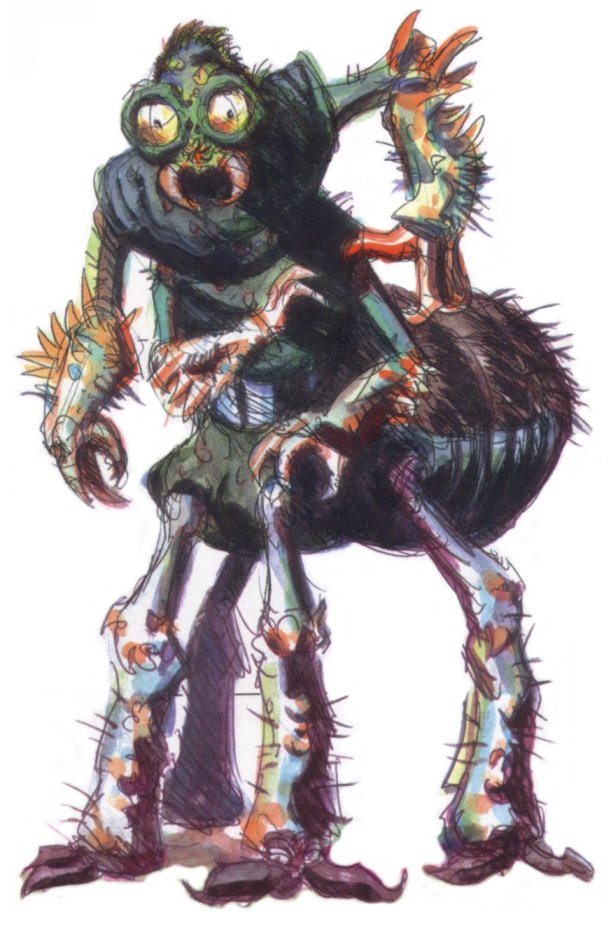 Most Charon are dangerous, single-minded sentients bent on killing every other being they encounter. The species comes from a dimension known as otherspace, a region beyond the confines of the known galaxy, but the name of the Charon homeworld and its location are mysteries yet to be solved by others who have encountered them.
Most Charon are dangerous, single-minded sentients bent on killing every other being they encounter. The species comes from a dimension known as otherspace, a region beyond the confines of the known galaxy, but the name of the Charon homeworld and its location are mysteries yet to be solved by others who have encountered them.
The proximity of the Charon homeworld to a black hole gave birth to a ruling death cult that believes the mission of the Charon should be to destroy all life. The death cult seeks to cast every living thing “Into the Void of Death.” A figure known as the Prophet of the Void leads this cult and thus governs Charon society.
Until the rise of the New Jedi Order, Charon were confined to otherspace, where they annihilated all other sentient species they'd encountered. The secret to hyperdrive technology continued to elude the death cult, however, so most Charon ships were incapable of leaving otherspace.
Shortly after the Battle of Endor. a Charon splinter faction called the Cult of Light succeeded in constructing their first hyperdrive. Each new hyper-drive built gives hope to hundreds of Charon eager to find new life in another galaxy. Led by a figured called the Illuminated One, the Cult of Light does not believe in the eradication of all sentient life, but rather seeks peaceful contact with other species willing to share new technology. The Cult of Light also seeks uninhabited worlds to colonize.
By the time Coruscant falls to the Yuuzhan Vong, the Prophet of the Void has learned about the Cult of Light and begun hunting down suspected members of the splinter faction. Meanwhile, the Cult of Light struggles to build more hyperdrives while keeping the new technology out of the death cult's clutches.
Charon bioscientists construct ships, weapons, and devices from living matter using similar techniques as the Yuuzhan Vong, although the two species have yet to encounter one another.
Personality: Charon who serve the Prophet of the Void believe in entropy, and they strict relentlessly to destroy all life. Charon who follow the Illuminated Out desire to escape otherspace and build a new and thriving society somewhere in the known galaxy. All Charon, regardless of allegiance, pursue their desires with single-minded determination if not ruthlessness. Although they prefer bioorganic technology, they do not shun or despise devices of a mechanical nature.
Physical Description: Charon possess both humanoid and arachnoid qualities. A Charon has four arms and four legs, giant slit-pupil eyes, and a large trailing abdomen capable of spinning webs. A thick, mottled carapace encases its body. The average Charon stands about 2.25 meters tall.
Homeworld: Otherspace is actually a pocket dimension formed by a series of black holes. Only the Charon know the exact location of their homeworld—a bleak, cold, and barely habitable globe.
Language: Charon speak a bizarre language full of clicks, squeals. and scratching sounds made by rubbing their mandibles together. This language can only be duplicated be, other insectoid species. The Charon written language is a series of intricate web shapes indistinguishable from a decorative pattern.
Example Names: Charon who serve the Prophet of the Void do not have personal names. Charon belonging to the Cult of tight sometimes adopt names, usually after meeting other species in the known galaxy: possible Charon names include Fa’chak, H’zlsh, Ry’shyrr, Sya’kalla, and Tin’soth.
Age In Years: Child 1-3; Young Adult 4-5; Adult 6-33; Middle Age 34-55; Old 56-64; Venerable 65+.
Adventurers: Those who are aware of the Charon believe the entire species is trapped in otherspace, but some signs of Charon activity in the known galaxy surface occasionally. Charon heroes only exist within the Cult of Light, though a few have made allies among non-Charon. Most Charon heroes are tech specialists (called bioscientists) or soldiers (called warriors). No Charon Force-users are known to exist.
Charon Species Traits
- Ability Modifiers: +2 Strength, +2 Constitution, +2 Intelligence, -6 Charisma
- Size: As Large creatures, they suffer a -1 size penalty on Defense, a -1 size penalty on attack rolls, and a -4 penalty on hide check, and a and a +4 penalty when grapplings. They have a Face/Reach of 2m by 2m/4m. Their lifting and carrying limits are doubled of Medium-sized characters.
- Speed: base speed of 12 meters
- Damage Reduction: Charon have thick carapace. A Charon receive DR 2. This ability stacks with DR values provided by manufactured armor.
- Extra Limbs (4): Charon have four arms. The extra limbs give them a +4 species bonus on Climb checks and grapple checks.
A Charon has one primary hand and three off hands. A Charon can wield up to four weapons, but the normal penalties for fighting with multiple weapons apply (see the Multiweapon Fighting feat description). - Natural Weapons (Claws): Charon have sharp claws that allow them to make unarmed attacks without provoking attacks of opportunity. As an attack action, a Charon can make one claw attack (with no penalty) or combine its primary claw attack with off-hand claw attacks (suffering the normal penalties for multiweapon fighting). Each claw deals 1d6 points of slashing damage plus the Charon's Strength modifier.
- Quadrupedal: Charon gain a +4 stability bonus against bantha rushes and trip attacks.
- Web: A Charon can shoot strands of sticky webbing from spinnerets in its abdomen; it can do this a number of times per day equal to 3 + the Charon's Constitution bonus (minimum 3 times per day). As an attack action, the Charon can make a ranged touch attack to entangle an opponent within 12 meters (see the Character Condition Summary in the Star Wars Roleplaying Game for the effects of being entangled). As a full-round action, the Charon can cover an adjacent 2-meter-by-2-meter-by-2-meter volume with impassable webbing. The webbing has a hardness of 0, 15 wound points per 2-meter cube, and a break DC of 30. Fire and lightsabers deal double damage to the webs.
- Free Language Skills: Read/Write and Speak Charon.
Chev
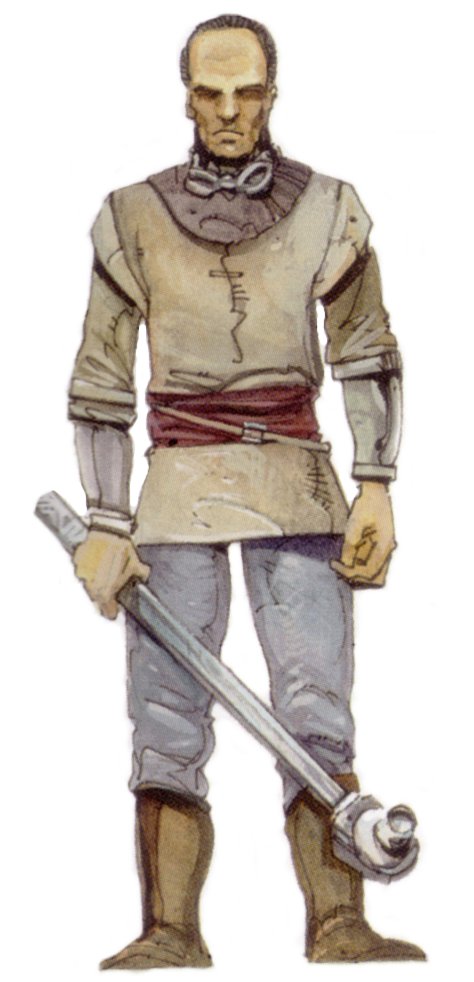 The Chevs are a near-Human species native to the world of Vinsoth, where they live in small farming and manufacturing communities scattered across the planet's surface. With the exception of a few bands of rebels that hide in the world's mountains, all Chev are slaves of the Chevin, the pachydermoid species with whom they share the world. The Chev villages are all surrounded by mine fields and fences intended to protect the Chevs from predators and banish any thoughts of escape.
The Chevs are a near-Human species native to the world of Vinsoth, where they live in small farming and manufacturing communities scattered across the planet's surface. With the exception of a few bands of rebels that hide in the world's mountains, all Chev are slaves of the Chevin, the pachydermoid species with whom they share the world. The Chev villages are all surrounded by mine fields and fences intended to protect the Chevs from predators and banish any thoughts of escape.
Millennia ago, the Chevs lived in grand cities, but the more aggressive Chevin shattered their peaceful civilisation. Chev communities exist primarily to supply food and manufactured goods for their nomadic masters, although they are permitted to trade goods between villages. They have a rich culture, filled with folklore, a wide range of musical. dramatic, and artistic forms of expression, and religious traditions. The Chevin have never made any effort to discourage the Chevs from practicing their cultural rites within the boundaries of their settlements, as the overlords find the activities interesting to watch and believe it helps increase the productivity of the slaves. Also, aspects of Chev religious beliefs exist that the Chevin find suits their purposes—such as ancient myths describing how the Chevs would be enslaved as punishment for their pride in their great cities. Other beliefs are less appreciated by the Chevin—such as the tales that some day the Chevs will be delivered from their bondage and rise to rule all space—but the Chevin are willing to take the bad with the good. Further, a number of Chevin masters have discovered offworld markets for the more impressive Chev artistic works. Some Chevin have even managed to sell Chev theatre troupes at “group rates.”
Unlike many other slave populations, the Chevs are well educated and as informed about the galaxy at large as their Chevin masters, perhaps even more so. The Chevin have always taken relatively good care of the Chevs because they believe healthy, bright, and happy slaves are more efficient than starved. Illiterate, and rebellious ones. The Chevin pass virtually every bit of knowledge they gain about the galaxy at large. Including technology—with the exception of repulsor-lifts, comlinks, and weaponry—to their slaves.
One drawback to the Chevin's permissive attitudes toward Chev culture, at least from the point of view of oppressive slave masters, is that they remain unaware of high-tech rebel movements within Chev villages. Like the Chevin, the Chevs take quickly to advanced technology and secretly build communications devices, jamming devices, sensors, and weapons from parts stolen from farming equipment or Chevin communities. Although the seeds of rebellion are first planted during the time of Old Republic, it isn't until The New Jedi Order era that organized outworlders begin helping the Chevs expand their network of rebels.
All Chevs encountered off Vinsoth are either current or former slaves. When the Old Republic contacted the Chevin, they almost instantly started exporting their slave population, either to other slavers or to Chevin colonies offworld. Most Chevs prefer to remain low-key and avoid political entanglements for fear of being recaptured by wandering Chevin.
Personality: The Chevs are not a broken people, despite their apparent subservience to the Chevin. Their passive, compliant behaviour belies a sly craftiness and firm resolve. Centuries of slavery have made the Chevs protective of their cultural heritage as well as forced them to become highly adaptive. Chevs know that they will overthrow their masters some day, but until that day conies, they remain patient and guarded.
Physical Description: Chev skin colour ranges from pale white to slate grey, with hair colours displaying similar variances (rare Chevs have wheat-coloured hair). They have sloping foreheads with pronounced brows and large, black eves that appear lidless. (They do in fact have transparent membranes that can cover the eyes to protect and clean them.)
Chevs usually dress in simple, sturdy garments but wear whatever style of clothing seems most practical for their line of work. They are shorter on average than baseline Humans, standing 1.4 to 1.8 meters tall.
Homeworld: Vinsoth, a temperate and verdant world located in the Outer Rim—a world they share with the pachydermoid Chevin.
Language: All Chevs speak Basic in addition to their own language and that of the Chevin; their masters encourage the Chevs to practice the galactic tongue to make them more useful and easier to sell to offworlders.
Example Names: Afrec, Amencia, Brophar, Inchef, Percifel, Sajan, Varel, Zethan.
Age In Years: Child 1-13; Young Adult 14-18; Adult 19-40; Middle Age 41-62; Old 63-74; Venerable 75+.
Adventurers: Chev adventurers are typically fringers, scouts, and tech specialists. While it is possible for Chevs to master the Force, the Chevin would take a dim view of anyone who undertook such activities.
Chev Species Traits
- Ability Modifiers: None
- Size: As Medium creatures, they have no special modifiers due to their size.
- Speed: base speed of 10 meters
- Bonus Feat: Chev receive the bonus feat Rugged.
- Free Language Skills: Read/Write and Speak Chev, Chevin and Basic.
Chevin
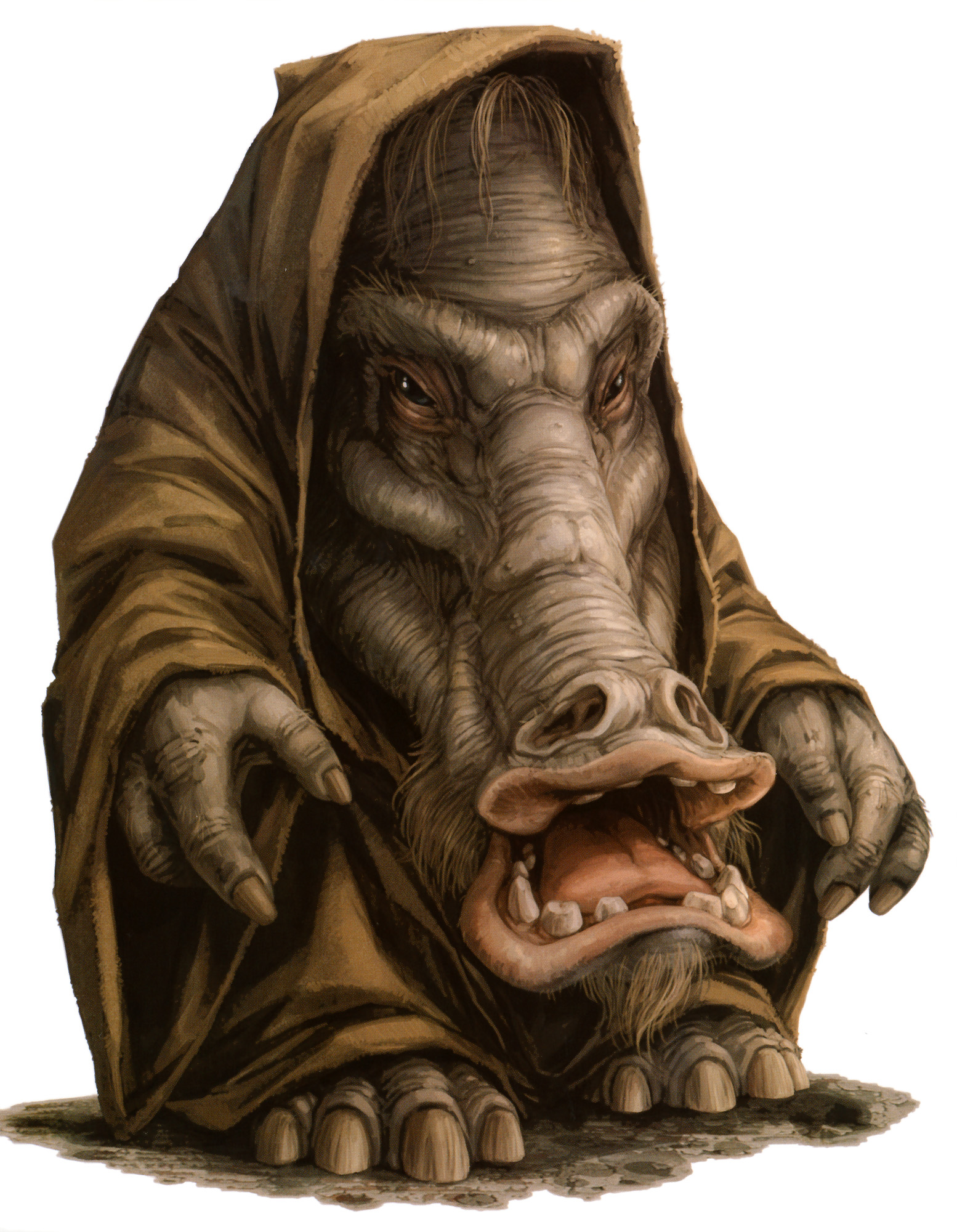 The Chevin are a migratory pachydermoid species native to the planet Vinsoth. Chevin society remains primitive by galactic standards. Before Old Republic scouts and merchants made contact with them, the Chevin lived in nomadic warrior clans. The pachydermoid took what they needed to survive from settlements of Chet a sapient near-Human species of farmers who have been under Chevin domination for the entire recorded histories of both species. When visitors to Vinsoth introduced advanced technology to the world, the Chevin adapted it to their society rather than conforming to what the visitors claimed was a better way to live. The Chevin also discovered the lucrative slave trade, and they started rounding up Chev and selling them to interested offworlders.
The Chevin are a migratory pachydermoid species native to the planet Vinsoth. Chevin society remains primitive by galactic standards. Before Old Republic scouts and merchants made contact with them, the Chevin lived in nomadic warrior clans. The pachydermoid took what they needed to survive from settlements of Chet a sapient near-Human species of farmers who have been under Chevin domination for the entire recorded histories of both species. When visitors to Vinsoth introduced advanced technology to the world, the Chevin adapted it to their society rather than conforming to what the visitors claimed was a better way to live. The Chevin also discovered the lucrative slave trade, and they started rounding up Chev and selling them to interested offworlders.
Chev slaves and foodstuffs are the most common exports from Vinsoth. To obviate unrest among the Chev slaves, Chevin take relatively good care of them and allow the Chev to present their cultural heritage.
Not surprisingly, the Chevin have carved a niche for themselves in the galactic criminal underworld, becoming known to the galaxy at large as a species of smugglers, gun-runners, profiteers, gamblers, slavers, and blackmailers. Indeed, most Chevin that interact with the galaxy at large are involved in one or more of the above "professions."
Personality: Most Chevin are simple creatures interested only in acquiring money, power, and status. They use intrigue, manipulation of beings in places of authority, careful investments, and outright theft. They tend to stay clear of direct involvement with specific political factions or power groups. attempting at all times to deal with all who can pay for their services.
While law-abiding beings try to avoid dealing with Chevin for fear of falling victim to some criminal scheme, more risk-prone individuals and criminals eagerly seek them out because Chevin are, in fact, honest in their business dealings in the underworld. A Chevin never double-crosses a business partner and expects to be dealt with honestly in return.
Physical Description: Chevin walk on two thick legs and have massive bodies that are as wide as they are tall. Their powerful arms end in large, three-fingered hands. Their heads rest on curved necks that angle toward their ground and their heavily lidded eyes appear to be solid black and pupilless. Adult Chevin stand roughly 2 to 3 meters tall.
Homeworld: Vinsoth, a temperate and verdant world located in the Outer Rim—a world they share with the near-Human Chev.
Language: Chevin speak and read Chevin. Those who travel the galaxy also learn to speak Basic.
Example Names: Ephant Mon, Goorin, Hagalor, Negna Mundro, Osman, Pedna Scotian.
Age In Years: Child 1-12; Young Adult 13-18; Adult 19-155; Middle Age 156-211; Old 212-256; Venerable 257+.
Adventurers: Chevin adventurers are typically fringers or scoundrels. The Chevin also have obscure Force traditions, so Chevin Force adepts do exist.
Chevin Species Traits
- Ability Modifiers: +2 Strength, -2 Dexterity, +2 Constitution, -2 Wisdom
- Size: As Medium creatures, they have no special modifiers due to their size.
- Speed: base speed of 10 meters
- Natural Armor: Chevin have thick hides. Chevin receive a +2 natural armor bonus to Defense.
- Free Language Skills: Read/Write and Speak Chevin.
Chiss
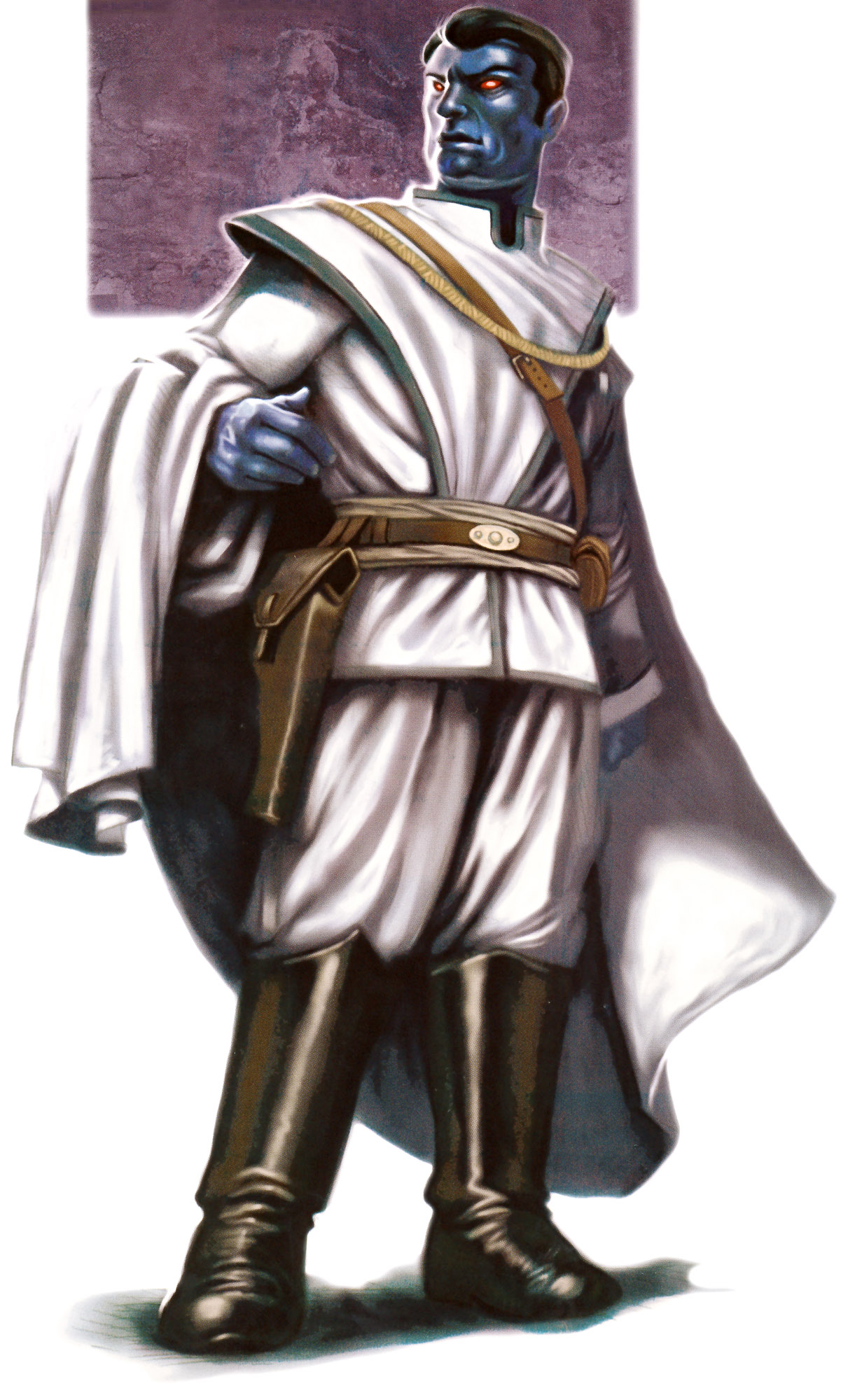 The Chiss are a near-Human species hailing from the planet Csilla in the Unknown Regions. Their existence was a mystery to the galaxy at large until sonic five years after the Battle of Endor when Grand Admiral Thrawn, a Chiss, rallied the scattered Imperial forces and almost destroyed the New Republic. Even then, Thraen’s species remained virtually unknown until a decade later.
The Chiss are a near-Human species hailing from the planet Csilla in the Unknown Regions. Their existence was a mystery to the galaxy at large until sonic five years after the Battle of Endor when Grand Admiral Thrawn, a Chiss, rallied the scattered Imperial forces and almost destroyed the New Republic. Even then, Thraen’s species remained virtually unknown until a decade later.
The Chiss control over two dozen star systems from the Chin homeworld. New Republic scientists (and many Chiss historians) believe that the species is descended from a very old Human colony, perhaps even predating the founding of the Old Republic.
The Chiss species has a rigid. disciplined society that xenosociologists attribute to the cold climate of their homeworld. They do not show signs of decadent or greedy behaviour, so most relate Chiss colonial expansion to a desire to impose order onto chaotic nearby star systems. Chiss society is controlled by four ruling “families”—not true biological groups, but effectively four separate branches of government. The Csapla clan dictates colonial issues, natural resources, and agriculture; the Nuruodo family (the clan of the famed Grand Admiral Thrawn) controls the military and foreign affairs; the lnrokini handle industry, the sciences, communication, and non-military technology; and the Sabosen clan oversees justice, public health, and education.
Chiss codes of conduct forbid them to strike first. (Thrawn violated this code by executing a pre-emptive strike against the Outbound Flight project, a Jedi expedition launched just before the fall of the Old Republic. His exile eventually brought him to the attention of the Emperor.) Once attacked, the Chiss do not rest until the attackers are destroyed or completely subjugated. The Ssi-ruuk Imperium was all but destroyed by Chiss fleets after the reptilian conquerors assaulted outlying Chiss colonies, for example.
Chiss who have dealt with the Empire or the New Republic have almost universally been operatives of the Nuruodo family.
Personality: As a species, the Chin are disciplined, cold, and arrogant. They strive to gain the advantage in any tactical or social situation. Chiss who consort with non-Chin never completely shake their xenophobic instincts. Around non-Chiss and other potential enemies, a Chiss remains pensive and aloof, constantly plotting tactics to ensure victory in a possible confrontation. After suffering a defeat or setback, a Chiss often contemplates what might be done differently to ensure victory the next time.
Chiss display a great deal of interest in the arts and sciences of other cultures. They study the culture of a potential enemy the way a biologist would observe the behaviour of a dangerous insect—with detachment and extreme caution.
Physical Description: The Chiss have blue skin and glowing red eyes, the shades of which grow darker depending on the level of oxygen in the atmosphere they breathe. The higher the level of oxygen, the more intense the colour of a chiss's eyes and skin. Their hair is usually black, although in some rare cases it turns grey with age. This is particularly common among females and it signifies someone whose children will have great impact on Chiss society.
Male and female Chiss tend to be more powerfully built than baseline Humans, but otherwise they exhibit the same variances that exist between humanoid sexes. They stand between 1.6 and 2.1 meters tall.
Homeworld: Csilla, a frigid world in the Unknown Regions.
Language: Chiss speak and read Cheunh, a complex language. To master the language, non-Chiss must spend 2 points for the Read/Write Cheunh skill and 2 points for the Speak Cheunh skill. Chiss can speak with Basic with ease, but few know the language since it is uncommon in their empire.
Example Names: Chiss have long three-part names, which they abbreviate when dealing with non-Chiss. Case in point, the Chiss named Mitth’raw’nuruodo is better known as Thrawn. Other abbreviated names: Dreel, Parkk, Karyee, Lev, Sorn, Szardra, Voss, Zilvard.
Age In Years: Child 1-10; Young Adult 11-13; Adult 14-50; Middle Age 51-62; Old 63-79; Venerable 80+.
Adventurers: Chiss adventurers tend to be nobles, scoundrels, scouts, or soldiers. It is unknown whether they have any Force traditions.
Chiss Species Traits
- Ability Modifiers: +2 Intelligence
- Size: As Medium creatures, they have no special modifiers due to their size.
- Speed: base speed of 10 meters
- Free Language Skills: Read/Write and Speak Cheunh.
Clawdite
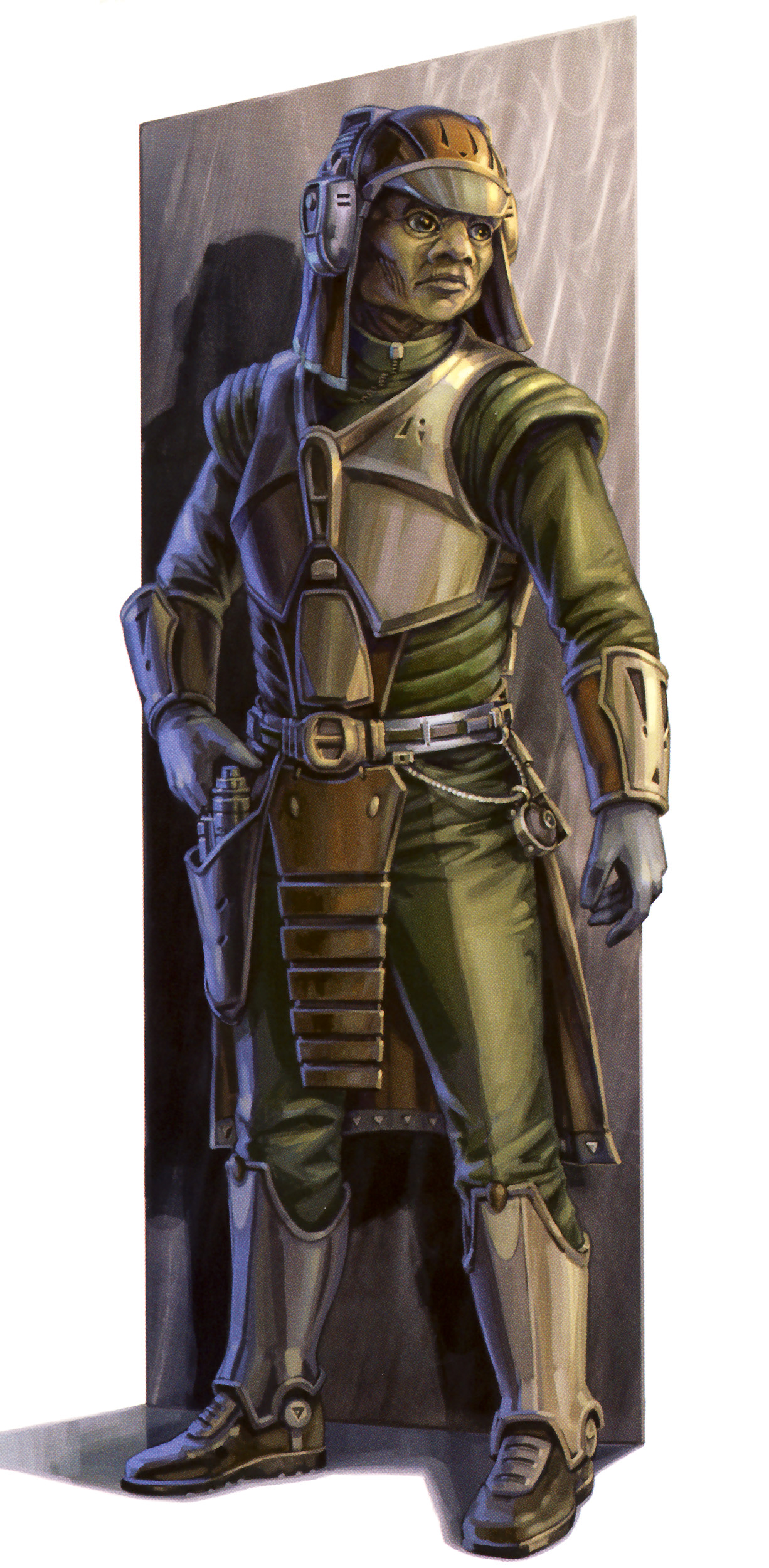 Clawdites are genetic variants of Zolanders, a species from the Mid Rim planet of Zolan. Hundreds of generations ago, radiation bombarded the planet and exposed the Zolanders to a skin-eating contagion. Many Wanders fled the planet and received genetic reconstruction that not only healed their wounds but also gave them their shapeshifting abilities. Upon their return, however, they were shunned and feared by those who had remained behind. The shapeshifters, resentful of Zolanders for centuries of institutional persecution, adopted a new species name: Clawdites.
Clawdites are genetic variants of Zolanders, a species from the Mid Rim planet of Zolan. Hundreds of generations ago, radiation bombarded the planet and exposed the Zolanders to a skin-eating contagion. Many Wanders fled the planet and received genetic reconstruction that not only healed their wounds but also gave them their shapeshifting abilities. Upon their return, however, they were shunned and feared by those who had remained behind. The shapeshifters, resentful of Zolanders for centuries of institutional persecution, adopted a new species name: Clawdites.
Clawdites have limited shapeshifting abilities that allow them to change the colour and texture of their skin and conceal their true reptilian appearance. In their natural form, Clawdites are indistinguishable from Zolanders except under genetic examination. Their skin-changing abilities vary from individual to individual and can be improved with practice.
Shapeshifting Clawdites must treat their skin with special oils to prevent splitting. A talented shapeshifter can assume the appearance of any Medium-size humanoid species of similar mass and posture, though the epidermis cannot duplicate the features of a specific, individual. The wrinkled skin of a Weequay is an easy match, but no Clawdites can assume the posture of a Dug or generate the extra flesh needed to create a lthorian hammerhead. Clothes and jewellery can also be mimicked, provided they lie close to the skin.
Personality: Clawdites are quiet loners who avoid others except when it serves to advance their own agendas. Clawdites view the universe with detached pragmatism. Driven by self-interest and wary of betrayal, they do not form friendships easily and have trouble understanding the concepts of loyalty and devotion.
Physical Description: Clawdites are reptilian humanoids with reptilian skin that varies in colour from yellow to green. Adults stand 1.5 to 2 meters tall.
Homeworld: Zolan, a nondescript planet located in the Mid Rim.
Language: Clawdites speak and read their own language. The spoken language consists of hissing sibilants punctuated by guttural croaks.
Example Names: Zam Wesell, Eru Massest, Prit Kesso, Pessk Maseel, Zapes Orn.
Age In Years: Child 1-10; Young Adult 11-17; Adult 18-49; Middle Age 50-71; Old 72-85; Venerable 86+.
Adventurers: Clawdite adventurers can be members of any class, though their outsider natures are best suited for fringer, scoundrel, scout, or bounty hunter classes. A Clawdite Jedi is possible but unlikely. Clawdites strong in the Force are more likely to become Force adepts.
Clawdite Species Traits
- Ability Modifiers: -2 Strength
- Size: As Medium creatures, they have no special modifiers due to their size.
- Speed: base speed of 10 meters
- Shapeshift: A Clawdite can alter his or her appearance to appear as a member of another Medium-size humanoid species. Changing appearance is a full-round action and grants a +10 species bonus on Disguise checks. A Clawdite gains none of the special qualities or species traits of the mimicked species, but the effect lasts as long as the Clawdite wishes. Whenever a Clawdite changes form to appear as any species other than Clawdite, they must succeed at a Fortitude save (DC 12) or suffer 1 point of temporary Constitution damage immediately after the transformation. A Clawdite can reduce the transformation time to a move action, but doing so raises the save DC to 18.
A Clawdite cannot create or conceal heavy clothing as part of the transformation and immediately reverts to his or her natural form when stunned, fatigued, exhausted, unconscious, dying, or dead. - Free Language Skills: Read/Write and Speak Clawdite.
Codru-Ji
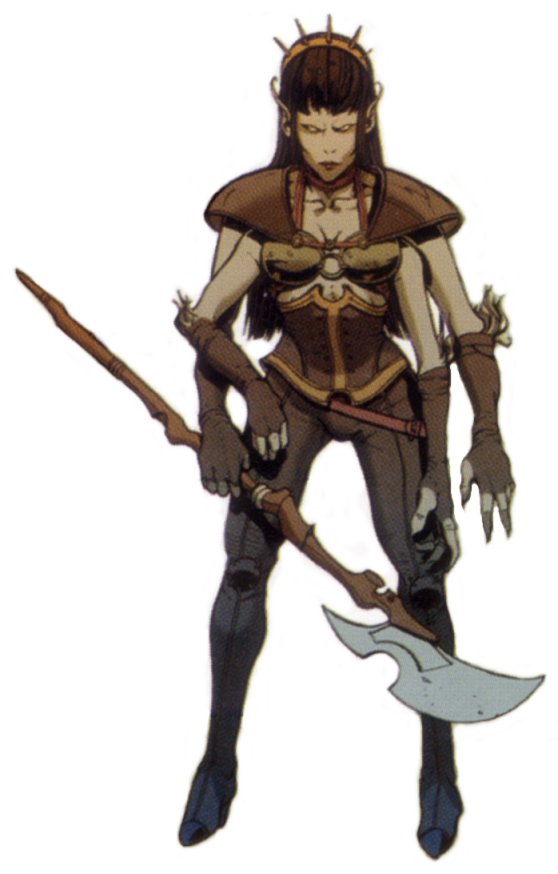 Codru-Ji enjoy their isolation from the rest of the galaxy, and their enclosed society doesn't easily welcome members of other species. The Codru-Ji have been approached to join the Republic on more than one occasion and have always declined. They are not xenophobic, but they protect their way of life as fiercely as they guard their young. Their peculiar customs include ritual kidnappings, the consequences of which seldom amount to more than intense negotiations, after which the victim is returned unharmed. Outsiders among the Codru-Ji are cautioned never to travel alone.
Codru-Ji enjoy their isolation from the rest of the galaxy, and their enclosed society doesn't easily welcome members of other species. The Codru-Ji have been approached to join the Republic on more than one occasion and have always declined. They are not xenophobic, but they protect their way of life as fiercely as they guard their young. Their peculiar customs include ritual kidnappings, the consequences of which seldom amount to more than intense negotiations, after which the victim is returned unharmed. Outsiders among the Codru-Ji are cautioned never to travel alone.
Codru-Ji adults have six limbs: four arms and two legs. Their children resemble six-legged. 1-meter-long canines (called Wyrwulves) until puberty, at which time they cocoon and emerge after a few weeks as fully developed Codru-Ji. Codru-Ji adults sleep standing up.
Personality: Despite their similarities to many other species, Codru-Ji find it difficult to integrate into the “galactic scene.” They find it difficult to adapt to other species' customs, and they are wary of outsiders, especially any who seem to have a hidden agenda.
Physical Description: Humanoids with four arms and long, pointed ears, Codru-Ji adults stand about 1.6 meters tall. Barely resembling their parents, Codru -Ji children are often mistaken for pets by uninformed beings.
Homeworld: Munto Codru is an isolated world in the Outer Rim that usually goes unnoticed by the galaxy at large. Archaeologists believe it was once inhabited by an advanced species of artisans that built the huge stone palaces that dot Munto Codru's temperate landscape. The Codru-Ji worship these enormous structures, and many believe them haunted.
Language: Codruese is a language of snarls, whines, throaty barks, and other canine noises mixed with a complex vocabulary and many strange idioms.
Example Names: Adaavi, Deceven, Jorrdu, Ketanna, Merasska, Raiko, Veesani, Zallfric. Wyrwulves are given short. affectionate names (such as Hrika and Lirri) until they transform into young adult Codru-Ji, when they inherit their real names.
Age In Years: Child 1-8; Young Adult 9-12; Adult 13-44; Middle Age 45-60; Old 61-84; Venerable 85+.
Adventurers: Codru-Ji rarely venture offworld: those who do are typically fringers, nobles, scoundrels, and Force adepts. Codru-Ji may also become Jedi consulars and Jedi guardians.
Codru-Ji Species Traits
- Ability Modifiers: None
- Size: As Medium creatures, they have no special modifiers due to their size.
- Speed: base speed of 10 meters
- Extra Limbs (4): Codru-Ji have four arms. The extra limbs give them a +4 species bonus on Climb checks and grapple checks.
A Codru-Ji has one primary hand and three off hands. A Codru-Ji can wield up to four weapons, but the normal penalties for fighting with multiple weapons apply (see the Multiweapon Fighting feat description). - Bonus Feat: Codru-Ji receive the bonus feat Multidexterity (Ignore the 15 Dexterity prerequisite for this feat).
- Free Language Skills: Read/Write and Speak Codruese.
Colicoid
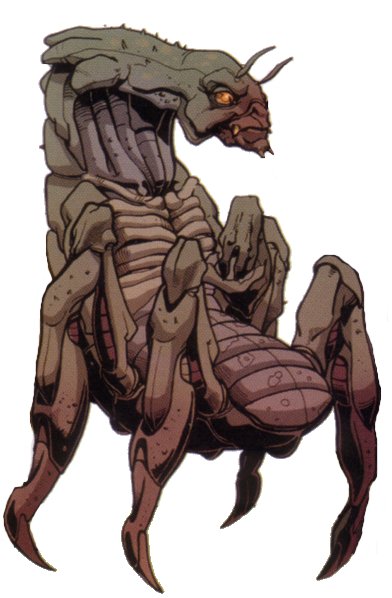 Colicoid are an insectoid species native to Colla IV. In battle, Colicoids curl up into a protective ball, then unfurl suddenly, catching their prey off guard. Their alien, insectoid minds give them a natural defense against Jedi mind tricks.
Colicoid are an insectoid species native to Colla IV. In battle, Colicoids curl up into a protective ball, then unfurl suddenly, catching their prey off guard. Their alien, insectoid minds give them a natural defense against Jedi mind tricks.
Colicoids arc highly intelligent, emotionless, and cannibalistic (particularly when food is scarce). Long ago, they transferred their ruthlessness to commerce, making them brutally efficient at business. Despite the Colicoids' successful commercial ventures and their strict business protocols, enough visitors to the Colla system have been murdered and consumed by the Colicoids that Colla IV has spent years in diplomatic disputes. Many diplomats consider an assignment to Colla IV a death sentence.
Colicoids are responsible for designing the Trade Federation's murderous droidekas—destroyer droids fashioned to resemble their creators.
Personality: Colicoids possess a ruthless cunning that serves them well on the battlefield and at the negotiating table. They are vicious, calculating creatures driven by greed, and they show little regard for others.
Physical Description: Colicoids are tall, insectoid beings with multiple appendages, chitinous bodies, and powerful stinging tails. Their flat heads have multi-faceted eyes that give them superior vision, and their long antennae provide an acute sense of smell. An adult Colicoid averages 1.8 meters tall.
Homeworld: Colla IV, located on the border of the Inner Rim and the Expansion Region.
Language: The Colicoid language involves clicks and humming noises from their antennae and jointed legs, which is difficult to interpret and impossible for other species to reproduce. They speak Basic with a noticeable buzz. Colicoids often converse in their own language while in the presence of other species—few would be pleased to hear what schemes and plots the- Colicoids discuss right in front of them. Colicoids do not have a written language of their own and must use Basic.
Example Names: Bzhat, G'zharp, Kyrrik, J'kilkrizt, T'karzhk, Ytil.
Age In Years: Child 1-4; Young Adult 5-7; Adult 8-33; Middle Age 34-49; Old 50-64; Venerable 65+.
Adventurers: Colicoids are rarely anything other than soldiers, although an enterprising Colicoid might find success as a scoundrel, scout, or bounty hunter. No Colicoid Force-users are known to exist.
Colicoid Species Traits
- Ability Modifiers: +2 Dexterity, +2 Intelligence, -2 Wisdom, -6 Charisma
- Size: As Medium creatures, they have no special modifiers due to their size.
- Speed: base speed of 10 meters
- Damage Reduction: Colicoid have armored carapaces. A Colicoid receive DR 2. This ability stacks with DR values provided by manufactured armor.
- Defensive Ball: When threatened or attacked, a Colicoid can curl itself up into a tight ball, protecting its vital organs and exposing its tough chitinous carapace. Rolling into a tight ball is full-round action and grants a +4 natural armor bonus to Defense. Once in a ball, the Colicoid cannot take any move or attack actions and can grasp only a single small object (like a comlink). The Colicoid cannot see while curled up but listens and smells without hindrance. As a free action, the Colicoid can rapidly unroll into a full standing position. It can then make a normal attack: usually with its stinger.
- Force Resistance: Colicoid gain a +
10 species bonus on Will saves to resist the Force skills Affect Mind, Friendship, Illusion, and any other mind-influencing Force skill that allows the target a Will save.
- Poison Stinger: The sting attack does not provoke attacks of opportunity. Stinger poison: Injury DC 12; initial 1d6 Str; secondary 2d6 Str.
- Reviled: Colicoid are universally despised and suffer a -2 species penalty on Diplomacy or Charisma checks to improve the attitude or a member of another species.
- Bonus Feat: Colicoid receive the bonus feat Alertness.
- Free Language Skills: Speak Colicoid.
Cragmoloid
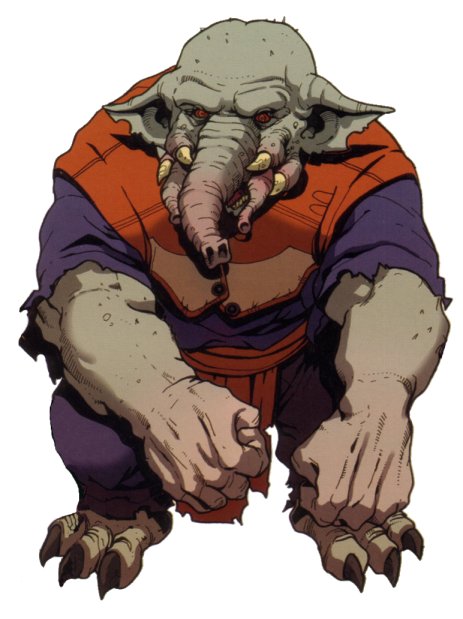 A little-known species hailing from the plains of Ankus, Cragmoloids are a rare race. During the Rebellion era, most Cragmoloids seen are in Imperial work camps. A few joined the Rebellion. hoping to liberate their people. Despite their prodigious strength, few become mercenaries, as they find gratuitous violence distasteful. Massively built and extremely powerful, Cragmoloids are physically intimidating, cumbersome, and irritable, but keenly aware of their surroundings.
A little-known species hailing from the plains of Ankus, Cragmoloids are a rare race. During the Rebellion era, most Cragmoloids seen are in Imperial work camps. A few joined the Rebellion. hoping to liberate their people. Despite their prodigious strength, few become mercenaries, as they find gratuitous violence distasteful. Massively built and extremely powerful, Cragmoloids are physically intimidating, cumbersome, and irritable, but keenly aware of their surroundings.
Personality: An extremely proud and clan-oriented people, Cragmoloids sink into a deep despair if separated from home, family, and friends. They are quick to anger and have a strong dislike for dishonesty and subterfuge. They prefer to be direct in their response to problems and think that those who resort to "tricks" are dishonourable.
Physical Description: Cragmoloids resemble 3-meter-tall anthropomorphic elephants with tusks and thick, leathery hides. They have tiny red, beady eyes.
Homeworld: Ankus, a rocky planet in the Unknown Regions near Ord ManteII.
Language: Cragmoloids speak and read Cragii. Cragmoloids who leave their homeworld also learn to speak Basic.
Example Names: Akoom, Darak, Ormoj, Rooty, Urun, Vuula.
Age In Years: Child 1-7; Young Adult 8-14; Adult 15-69; Middle Age 70-86; Old 87-119; Venerable 120+.
Adventurers: Cragmoloid adventurers are usually fringers, scouts, or scoundrels. Despite an average number of Force-users among the species, there are no known examples of Cragmoloid Jedi.
Cragmoloid Species Traits
- Ability Modifiers: +4 Strength, -2 Dexterity, -2 Intelligence
- Size: As Large creatures, they suffer a -1 size penalty on Defense, a -1 size penalty on attack rolls, and a -4 penalty on hide check, and a and a +4 penalty when grapplings. They have a Face/Reach of 2m by 2m/4m. Their lifting and carrying limits are doubled of Medium-sized characters.
- Speed: base speed of 10 meters
- Natural Armor: Cragmoloids have thick, leathery hides. Cragmoloid receive a +2 natural armor bonus to Defense.
- Natural Weapons (Tusks): Cragmoloid have powerful tusks with which they can gore prey. A Cragmoloid’s gore attack deal
2d6 points of piercing damage plus the Cragmoloid’s Strength modifier. The gore attack does not provoke attacks of opportunity. A Cragmoloid who charges an opponent and scores a hit deals double damage with its gore attack.
- Free Language Skills: Read/Write and Speak Cragii.
Dantari
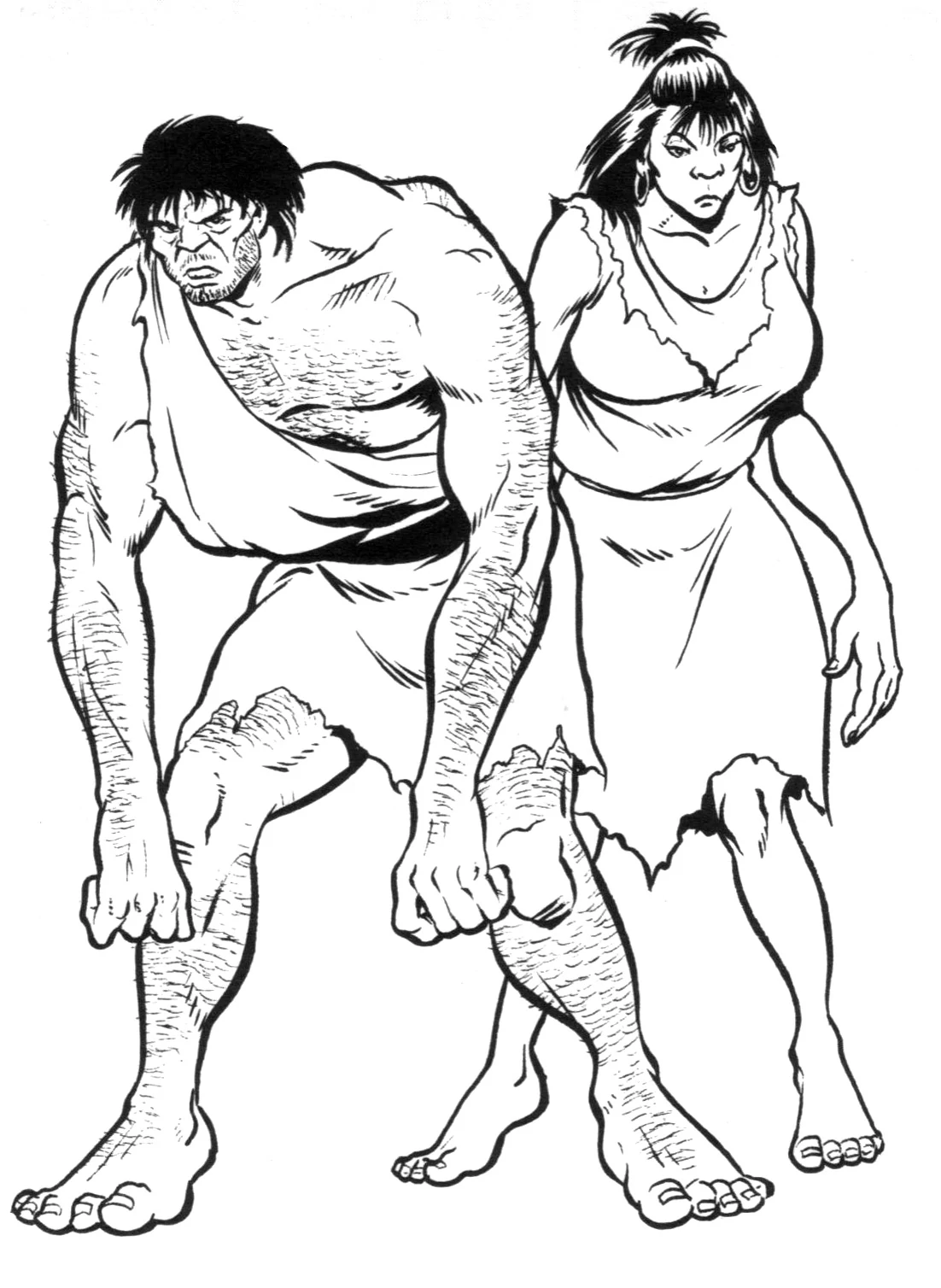 The primitive natives of Dantooine are called Dantari, tribal humanoids that lead a nomadic life along the Ocean coasts of the planet. The Dantari fashion simple clothing from the skins of local animals and crude weapons out of sticks and stories.
The primitive natives of Dantooine are called Dantari, tribal humanoids that lead a nomadic life along the Ocean coasts of the planet. The Dantari fashion simple clothing from the skins of local animals and crude weapons out of sticks and stories.
The Darnall are so few that the New Republic, like the Empire and the Old Republic before it, considers Dantooine an uninhabited world—though Dantooine has been colonized at least twice in the past. Jedi Master Vodo-Siosk Baas settled there four thousand years before the Battle of Yavin, and refugees from the volcanic world of Eol Sha made a new home on Dantooine seven years after Battle of Ender. In between, before the Battle of Yavin, Dantooine served as a base for the Rebel Alliance.
The settlers from Eol Sha met an unfortunate end, utterly wiped out by Admiral Daala, the Imperial commander in charge of the Maw Cluster installation near Kessel. Curiously, the arrival of Dania's forces was an event of unprecedented awe to the primitive Dantari, who began incorporating Imperial symbology into their own belief systems. The Dantari tattooed themselves with crude images of Imperial crests, AT-ATs, blaster rifles, and in the case of the truly brave, full-body depictions of stormtrooper armor. The best warriors have weapons fashioned from bits of metal scavenged from damaged Imperial vehicles, or perhaps from the ruins of the Eol Sha colony.
As primitives, Dantari are unskilled with technological items.
Personality: Dantari are a peaceful, highly adaptive nomadic people. Though primitive and isolated, they are curious about technology and other wonders. Darnall revere the stars and show a keen interest in anyone who claims to come from them. They are neither cruel nor vindictive, although they are capable and tenacious warriors in battle.
Physical Description: The Dantari resemble hulking Humans dressed in primitive garb. They typically have tanned, leathery skin and dark hair.
Homeworld: Dantooine, an isolated and unspoiled Outer Rim world covered by grasslands and large oceans.
Language: Dantari have a spoken language as well as a crude written language known by a learned few.
Example Names: Dayan, Esada, Jendar, Norr, Norra, Tuber, Uladi.
Age In Years: Child 1-11; Young Adult 12-15; Adult 16-35; Middle Age 36-54; Old 55-69; Venerable 70+.
Adventurers: Dantari adventurers living on Dantooine are usually fringers or scouts. Dantari shamans may also be Force adepts. Dantari plucked from their homeworld can adopt virtually any heroic class, although tech specialists are unlikely given their primitive nature.
Dantari Species Traits
- Ability Modifiers: +2 Strength, -2 Intelligence
- Size: As Medium creatures, they have no special modifiers due to their size.
- Speed: base speed of 10 meters
- Primitive: Dantari with heroic or professional classes receive the bonus feats Weapon Group Proficiency (primitive weapons) and Weapon Group Proficiency (simple weapons) instead of the usual Weapon Group Proficiency bonus feats.
- Free Language Skills: Speak Dantari.
Dashade
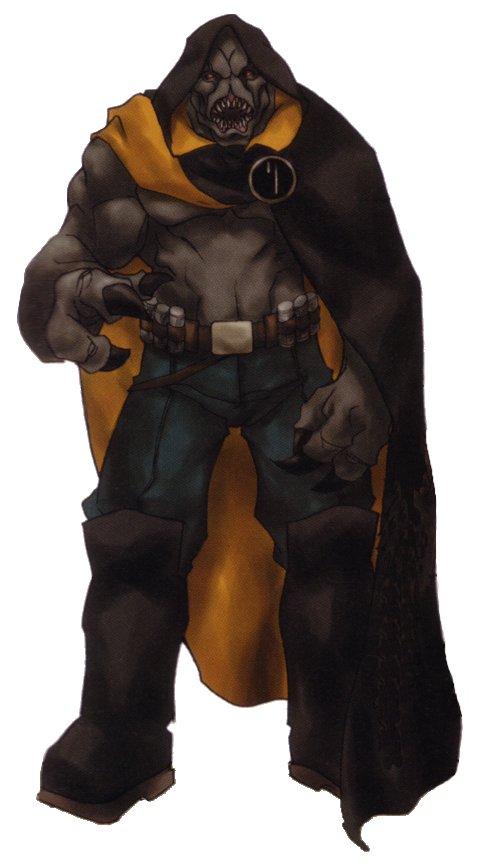 The Dashade were renowned and feared as deadly mercenaries and assassins. The name "Shadow Killer," an honorary title given to the most accomplished Dashade killers, was spoken only in whispers and sent involuntary shivers through those who heard the words. At the height of the Sith War, however, the species was all but wiped out when the Cron Cluster Explosion destroyed their home star system.
The Dashade were renowned and feared as deadly mercenaries and assassins. The name "Shadow Killer," an honorary title given to the most accomplished Dashade killers, was spoken only in whispers and sent involuntary shivers through those who heard the words. At the height of the Sith War, however, the species was all but wiped out when the Cron Cluster Explosion destroyed their home star system.
The Dashade originated on Urkupp in the harsh glare of the Cron Ouster's multiple suns. Many of Urkupp’s lifeforms adapted to the extreme heat conditions by developing a curious ability to absorb the heat and then dissipate it gradually. When enough beings were gathered in one location, they ended up creating weather systems that led to cooler conditions.
The sparse resources on their world led to the rise of warlords and a religion built around the notion that the righteous and virtuous are blessed with strength and power by the unseen forces that govern the universe. When the species developed rudimentary spacefaring capabilities and encountered the Sith and the Jedi, their religious beliefs deepened. The Dashade discovered that they had partial immunity to the much-vaunted Force abilities of both cultures. Consequently, Dashade became valued hirelings by both sides of the conflict.
The Sith and a number of other cultures that inhabited star systems near the Cron Cluster used Dashade mercenaries as bodyguards and assassins. The Jedi and official Republic institutions hired Dashade as combat instructors. Jedi Masters viewed Dashade combat prowess and Force resistance as a means to show Padawans (and even over-confident Jedi Knights) the danger of relying too heavily on their Force abilities in combat.
With the destruction of Urkupp, it is widely believed that the Dashade were rendered extinct. It is known, however, that at least one of the royal families of the Falleen put a number of their Dashade retainers into cryogenic suspension, preserving their prowess and unique abilities for use by future generations of Falleen leaders. New Republic historians sifting through secret Imperial databases have learned that a number of early assaults on Jedi strongholds during the Rebellion era may have involved Dashade mercenaries. Many reports indicate that aliens of an unknown species resistant to Force abilities spear-headed the attacks.
The number of Dashade that survived the destruction of Urkupp is unknown, but a growing number of New Republic analysts suspect the Dashade may have established one or more colonies beyond the Cron Cluster before the disaster that destroyed their homeworld. Considering the harsh nature of their planet of origin, it is conceivable that one or more colonies of Dashade are thriving in star systems that the rest of the galaxy has written off as impossible to colonize.
Personality: Dashade are secretive, menacing beings who believe they are physically and mentally superior to most—if not ail—other sentient lifeforms in the galaxy. Dashade hired as mercenaries and assassins remain loyal to their employers only so long as they profit from the relationship and are allowed to demonstrate their combat prowess.
Physical Description: The Dashade are hairless humanoids with high foreheads. beady eyes, and lamprey like mouths. Adults of the species stand between 1.7 and 2 meters tall, with no difference in height and build between males and females. Their skin colours are olive green, dark grey, or black, and they have orange, red, or black eyes.
Homeworld: Urkupp, an irradiated world located in the Cron Cluster. A supernova destroyed the planet and its inhabitants during the Sith War.
Language: Dashade speak and read Dashadi. Most Dashade also speak Basic.
Example Names: Alaris Koth, Ket Maliss, Tel Sorath, Nos Kellex, Tessun Kel.
Age In Years: Child 1-10; Young Adult 11-15; Adult 16-44; Middle Age 45-69; Old 70-84; Venerable 85+.
Adventurers: Dashade adventurers may be soldiers, elite troopers, and bounty hunters. Circumstances might compel a lone Dashade to take up life as a scoundrel. Dashade have no known Force traditions.
Dashade Species Traits
- Ability Modifiers: +2 Dexterity, -2 Wisdom, -2 Charisma
- Size: As Medium creatures, they have no special modifiers due to their size.
- Speed: base speed of 10 meters
- Force Resistance: Dashade gain a +
10 species bonus on Will saves to resist the Force skills Affect Mind, Friendship, Illusion, and any other mind-influencing Force skill that allows the target a Will save.
- Heat Dissipation: Dashade can dissipate the heat emanating from their bodies. Dashade can negate equipment bonuses that rely on detecting heat signatures—such as infrared scanning—by adjusting the temperature around their bodies.
- Radiation Resistance: Dashade receive a +2 species bonus on Fortitude saves against radiation.
- Free Language Skills: Read/Write and Speak Dashadi.
Defel
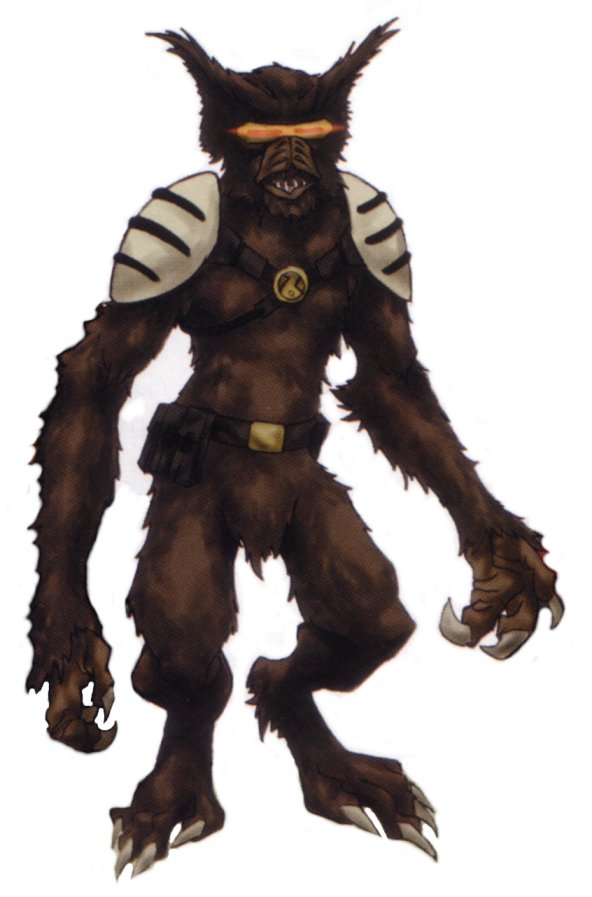 Defel originate on Af’El, a high-gravity world. Due to the unusual chemical composition of Af’El’s upper atmosphere, only ultraviolet light passes freely to the surface of the planet, while longer wavelengths of light are completely deflected. Because of this, all life-forms on Af'El, including the Defel, are completely blind to the non-ultraviolet spectrum. To function away from their homeworld. Defel must wear special visors that allow them to "see" light wavelengths other than ultraviolet. A Defel without such a visor is effectively blind in normal light.
Defel originate on Af’El, a high-gravity world. Due to the unusual chemical composition of Af’El’s upper atmosphere, only ultraviolet light passes freely to the surface of the planet, while longer wavelengths of light are completely deflected. Because of this, all life-forms on Af'El, including the Defel, are completely blind to the non-ultraviolet spectrum. To function away from their homeworld. Defel must wear special visors that allow them to "see" light wavelengths other than ultraviolet. A Defel without such a visor is effectively blind in normal light.
Defel fur absorbs light wavelengths such that in darkness, a Defel is invisible even to beings with dark-vision. Their unnerving, shadowy appearance in the light makes even those Defel who aren't skilled combatants useful bodyguards, since few beings are aware of the source of this strange effect.
On Af’El, the Defel live in large, well-maintained underground cities considered among the marvels of the galaxy. Some leave their homeworld in search of adventure, but most leave to work for other beings on specific contract jobs. While many Defel trade on their unique physical characteristics and the legends that surround their kind, most work for starship manufacturers and smelling plants that produce durasteel and other alloys requiring a carefully balanced mix of ores. The Defel have produced some of the galaxy's best metallurgists, and they are valued as much for their knowledge in this field as for their talent for more violent pursuits.
Personality: Defel are proud and independent to the point of stubbornness. They don't like others telling them what to do or how to do it. They are loyal to their friends and employers, but not always trustworthy. They can be secretive and conniving.
Physical Description: The Defel are a curious mammalian species, appearing as a mysterious bipedal shadow with reddish eyes and long white fangs. Under Ultraviolet light, however, it becomes clear that Defel are stocky beings covered in fur that ranges from brilliant yellow to dazzling azure. They have long fingers that end in vicious yellow claws and protruding lime-green snouts. They stand between 1 meter and 1.5 meters tall.
Homeworld: Af’El a high-gravity planet orbiting the super-giant Ka'Dedus in the Outer Rim.
Language: Defel speak and read Defel. Only those who travel away from Af’El bother to learn Basic.
Example Names: Kl'aal, Defeen, Dourlas, Freel, Glasfir'a'lik, Gr'vesh, Morr, Vex, Yarchur, Zomil.
Age In Years: Child 1-6; Young Adult 7-10; Adult 11-49; Middle Age 50-74; Old 75-89; Venerable 90+.
Adventurers: Defel adventurers are typically scouts, scoundrels, soldiers, or tech specialists. Force-sensitive Defel are exceedingly rare.
Defel Species Traits
- Ability Modifiers: -2 Strength, +2 Intelligence
- Size: As Small creatures, they gain a +1 size bonus to their Defense, a +1 size bonus on attack rolls, and a +4 size bonus on Hide checks, and a –4 penalty when grappling. They must use smaller weapons than Medium-size beings use, and their lifting and carrying limits are three-quarters those of Medium-size characters.
- Speed: base speed of 6 meters
- Blindness: Away from their homeworld, Defel must wear special visors that cost 100 credits apiece. Without the visor, a Defel is considered blinded (see the Character Condition Summary in Chapter Twelve of the Star Wars Roleplaying Game).
- Invisibility: In normal light, Defel appear as visible patches of darkness, much like shadows. In areas of low light, they are effectively invisible. Unless the Defel is under direct normal sunlight (or the artificial equivalent, such as a well-lit arboretum), it gains a +2 circumstance bonus to attacks, and its target loses its Dexterity bonus (if any) to Defense. Attacks against a Defel in these circumstances suffer a 50% miss chance. Under especially low-light conditions (such as a dimly lit cantina), the attacker must also guess which 2-meter square the Defel occupies (sec Concealment Miss Chance in Chapter Eight of the Star Wars Roleplaying Game).
- Free Language Skills: Read/Write and Speak Defel.
Devaronian
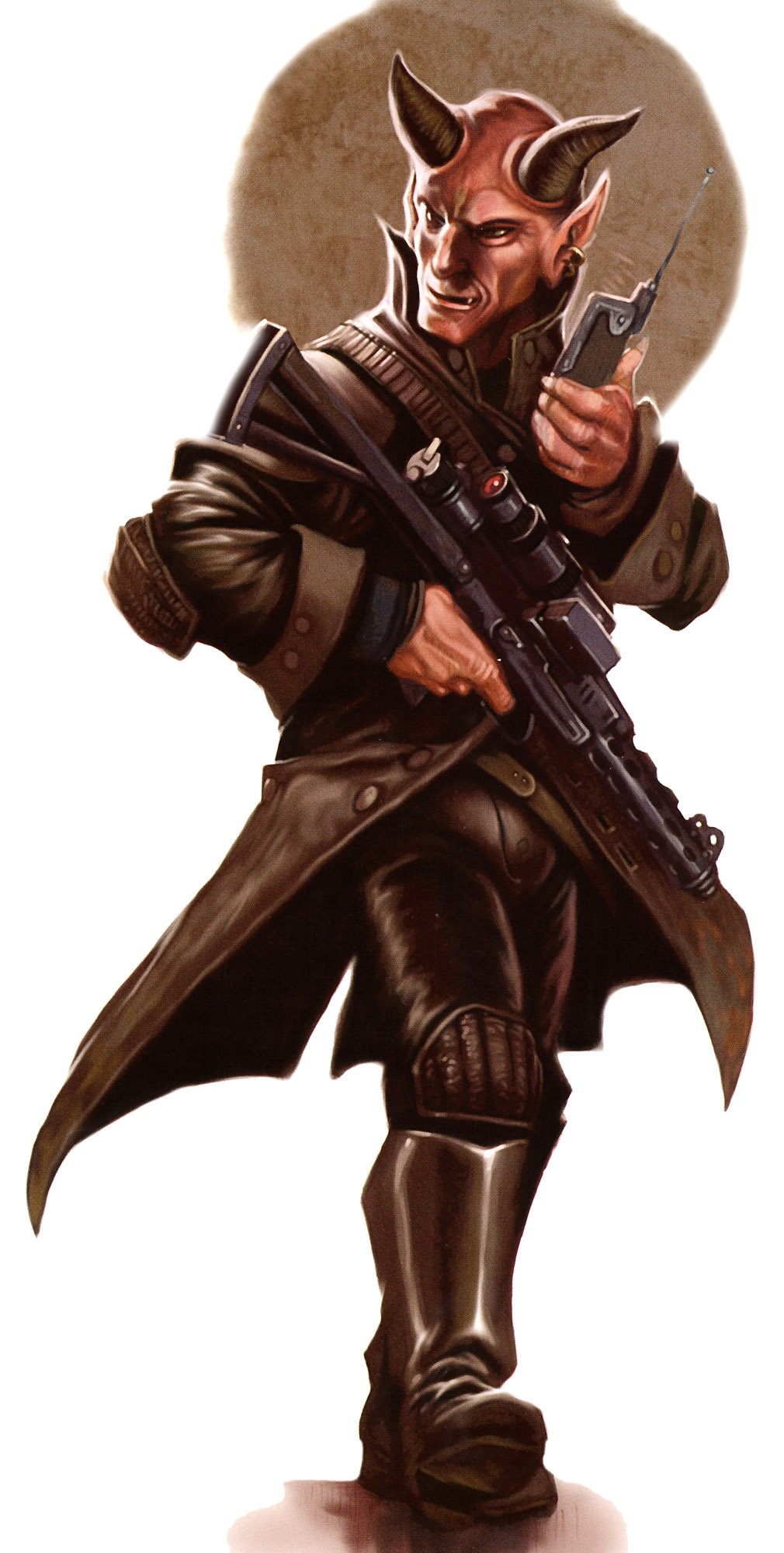 Devaronians are among the first species in the galaxy to develop interstellar travel, and the males of the species have been common sights in spaceports throughout the galaxy for thousands of years. Devaronian males are driven by an urge to wander. As such, they are often found traveling the galaxy as tramp freighter captains and scouts. Female Devaronians, on the other hand, are content to remain in a single location, and, as such, raise the young and run the government of Devaron. The males send as much money as they can back to their families on Devaron, but they seldom return to the homeworld. The females are content with this arrangement, as they tend to view the restless males as disruptive to home life.
Devaronians are among the first species in the galaxy to develop interstellar travel, and the males of the species have been common sights in spaceports throughout the galaxy for thousands of years. Devaronian males are driven by an urge to wander. As such, they are often found traveling the galaxy as tramp freighter captains and scouts. Female Devaronians, on the other hand, are content to remain in a single location, and, as such, raise the young and run the government of Devaron. The males send as much money as they can back to their families on Devaron, but they seldom return to the homeworld. The females are content with this arrangement, as they tend to view the restless males as disruptive to home life.
Personality: Devaronian males are bold, daring, bull-headed, rash, terse, unscrupulous, and stingy with their credits. They love being the masters of their own destinies. Female Devaronians are generally bright, wise, scrupulous, and sharp-tongued.
Physical Description: Devaronian males are hair-less, with red-tinted skin, sharp incisors, and a pair of large horns growing from their foreheads. Their appearance is not unlike the devils of a thousand myths. Female Devaronians are covered in thick fur that ranges in color from brown to white. Females are hornless and have prominent canine teeth. Devaronians stand 1.6 meters tall on average.
Homeworld: Devaron, a world of low mountains and deep valleys linked by thousands of rivers. The planet is located in the Expansion Region.
Language: Devaronians speak and read Devaronese. Many also learn to speak Basic. Their speech is low, guttural, and full of snarling consonants.
Example Names: Dmaynel Kiph, Elassar Targon, Jubal, Kaapp Dendo, Tyrn Jiton, Lak Jit, Oxbel, Saricia, Sires Vant, Trynic, Uliex Vinaq, Vilmarh Grahrk.
Age In Years: Child 1-12; Young Adult 13-17; Adult 18-44; Middle Age 45-64; Old 65-79; Venerable 80+.
Adventurers: Male Devaronian heroes tend to be flingers, scoundrels, scouts, or tech specialists. Invariably, they are found in occupations that allow them freedom to travel whenever and wherever they wish. Due to the oppressive nature of the Empire. many Devaronian males joined the Rebellion—not because of politics, but because they were annoyed that their freedom to travel was being curtailed.
Female Devaronian heroes tend to be flingers and nobles. Those who are strong in the Force sometimes break with tradition and leave Devaron to study at a Jedi temple.
Devaronian Species Traits
- Female Ability Modifiers: -2 Dexterity, +2 Intelligence, +2 Wisdom.
- Male Ability Modifiers: +2 Dexterity, -2 Wisdom, -2 Charisma.
- Size: As Medium creatures, they have no special modifiers due to their size.
- Speed: base speed of 10 meters
- Free Language Skills: Read/Write and Speak Devaronese.
Draethos
 Draethos are roughly humanoid beings who live nearly 800 years. Although they are reputed to be Fierce and unrepentant warriors, Draethos at large have failed to live up to this reputation. In fact, Draethos encountered away from their homeworld are pacifistic and highly intelligent, if socially inept and shy. In fact, Draethos who choose not to follow the warrior's path are exiled from their homeworld and forced to live on desolated planets or among aliens.
Draethos are roughly humanoid beings who live nearly 800 years. Although they are reputed to be Fierce and unrepentant warriors, Draethos at large have failed to live up to this reputation. In fact, Draethos encountered away from their homeworld are pacifistic and highly intelligent, if socially inept and shy. In fact, Draethos who choose not to follow the warrior's path are exiled from their homeworld and forced to live on desolated planets or among aliens.
Exiled Draethos feel compelled to learn as much as possible. becoming experts on several topics by early adulthood. These Draethos are so enthralled with learning that they rarely pause to apply what they learn. Unlike other species obsessed with knowledge, Draethos seldom appreciate a good debate, even if it's in their field of expertise. Their love of knowledge accompanies a fear of missing an important detail while debating or a failure to put into words what they know explicitly to be true. Older Draethos usually overcome this fear.
Personality: Exiled Draethos are highly intelligent but socially awkward. They have trouble grasping the complex customs of other species arid thus tend to keep to themselves. They generally avoid conflict and strife.
Draethos living on the homeworld are either haughty, spoiled aristocrats or fierce, aggressive warriors eager to demonstrate their combat prowess. Fortunately For the rest of the galaxy, they keep to themselves and spend most of their energies honing their skills and hunting other fierce predators on their own planet.
Physical Description: Draethos are slender, tightly muscled humanoids that average 1.8 meters tall. Their coarse, scaly skin ranges in colour from violet to mauve, to grey. Their eyes are black, pupilless, and set into the sides of their sloped head. They have webbed hands, and their lipless mouths give the illusion of a large overbite.
Homeworld: Thosa, a barren world of jagged, windswept mountains and deep caves, located in the Outer Kim. Very few non-Draethos know the planet's name and precise location.
Language: Draethos speak and read Draethos. Their spoken language sounds like a flurry of cacophonous clicks and sighs.
Example Names: Odan-Urr, Omal-Zan, Uval-Nor, Shal-Orl, Tyan-Ruu.
Age In Years: Child 1-12; Young Adult 13-17; Adult 18-399; Middle Age 400-699; Old 700-780; Venerable 781+.
Adventurers: Draethos who reside on Thosa are soldiers foremost, with a few nobles overseeing the warrior caste. Others may be Force adepts who practice mysterious Force traditions.
Draethos adventurers who leave their homeworld can belong to any heroic class, and a few might study to become Jedi consulars or (more rarely) Jedi guardians.
Draethos Species Traits
- Ability Modifiers: +2 Intelligence, -2 Charisma
- Size: As Medium creatures, they have no special modifiers due to their size.
- Speed: base speed of 10 meters
- Low-Light Vision: Draethos evolved from cave-dwelling creatures and possess low-light vision. Draethos can see twice as far as normal in dim light, and retain the ability to distinguish color and detail under these conditions.
- Natural Armor: Draethos have tough skin. Draethos receive a +1 natural armor bonus to Defense.
- Telepathy: A Draethos can communicate telepathically with any number of sentient beings within 500 meters. A being that wishes to resist telepathic contact with a Draethos must make a Will save (DC 10 + the Draethos's Wisdom modifier). A successful saving throw denies the Draethos telepathic contact, although the character in question knows that something has attempted to contact him. The Draethos can continue to attempt to establish contact for as long as the target is within range. All beings that receive telepathic communication from a Draethos "hear" the message in their own primary language. This ability is primarily used for communication: it cannot "steal" memories or information.
- Bonus Feat: Draethos receive the bonus feat Endurance.
- Free Language Skills: Read/Write and Speak Draethos.
Drall
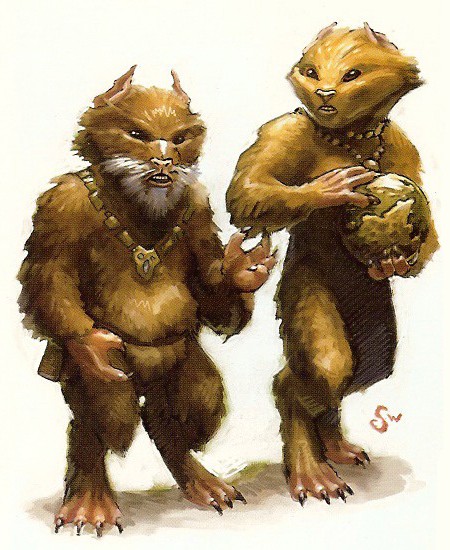 The Drall are mild-mannered, short humanoids. As a species, they are methodical researchers, careful observers, and considered among the best theoretical thinkers in the galaxy. Although well-versed in virtually every widely used technology in the galaxy, and often numbered among scientists who are on the cutting edge in a number of fields. Droll are primarily interested in abstract concepts and accumulating knowledge for the sake of knowledge. Therefore, despite the advanced nature of their scholarly pursuits, the world of Drall trails behind the rest of the galaxy in technological achievement, and the Drall themselves usually implement technology developed by others. For example, despite them having been part of the galactic community for over twenty millennia. the Drall still rely exclusively on spacefaring technology built by the Corellians.
The Drall are mild-mannered, short humanoids. As a species, they are methodical researchers, careful observers, and considered among the best theoretical thinkers in the galaxy. Although well-versed in virtually every widely used technology in the galaxy, and often numbered among scientists who are on the cutting edge in a number of fields. Droll are primarily interested in abstract concepts and accumulating knowledge for the sake of knowledge. Therefore, despite the advanced nature of their scholarly pursuits, the world of Drall trails behind the rest of the galaxy in technological achievement, and the Drall themselves usually implement technology developed by others. For example, despite them having been part of the galactic community for over twenty millennia. the Drall still rely exclusively on spacefaring technology built by the Corellians.
Drall society is a clan-based combination of a matriarchy and a meritocracy. No elected or direct hereditary leaders exist on the Drall homeworld. Instead, each family heeds a “Duchess,” a female Drall who is deemed the most fit to lead. Once appointed. the Duchess becomes the owner of all the family's property, and she holds the position for life or until she steps down and passes the title and property along to a suitable heir. Most of the Drall clans follow the overall direction set by the Duchess of the most prosperous and powerful of all the clans.
Family life is also the most commonly discussed topic among Drall—exchanging gossip about one's family is a perfectly acceptable form of small talk. Drill find it surprising that other species may consider probing questions about family affairs an invasion of privacy, although once this is spelled out to them they quickly take steps to avoid offense.
Most Drall who venture from their homeworld work for megacorporations as researchers or medical specialists—one of Drall's main exports, aside from scientific knowledge, is processed medicinal herbs—although a few also make good livings as information broken.
Personality: Drall take pride in being viewed as well mannered and considerate. They are also intelligent, reasonable, and difficult to anger. Drall are scrupulously honest in their business dealings, and if they promise to perform a task for a certain payment, they always do so to the best of their ability. They expect others to behave in a similar fashion.
Physical Description: Drall have short muzzles and almond-shaped black eyes. Their bodies are covered in fur that ranges from brown and black to reddish-grey. The have short limbs and clawed hands and feet. They tend not to wear clothing, although both males and females often wear elaborate necklaces, headdresses, and other types of jewellery. Adult Drall stand between 0.9 and 1.5 meters tall, with most females being taller and more solidly built than the males.
Homeworld: The Core World of Drall, in the Corellia system.
Language: Drall speak their native language (Drallish), and most know Basic as well.
Example Names: Driggs, Ebrihim, Garth, Gredda, Hedreg, Marcha, Norghar.
Age In Years: Child 1-3; Young Adult 4-7; Adult 8-25; Middle Age 26-55; Old 56-89; Venerable 90+.
Adventurers: Drall who are unemployed or not quite ready to settle down and start a family are sometimes drawn to a life of exploration and adventure. Drall adventurers tend to be nobles, scout, scoundrels, or tech specialists. Force-users among the Drall are rare.
Drall Species Traits
- Ability Modifiers: -2 Strength, -2 Dexterity, +2 Intelligence, +2 Wisdom, +2 Charisma
- Size: As Small creatures, they gain a +1 size bonus to their Defense, a +1 size bonus on attack rolls, and a +4 size bonus on Hide checks, and a –4 penalty when grappling. They must use smaller weapons than Medium-size beings use, and their lifting and carrying limits are three-quarters those of Medium-size characters.
- Speed: base speed of 6 meters
- Free Language Skills: Read/Write and Speak Drallish.
Dressellian
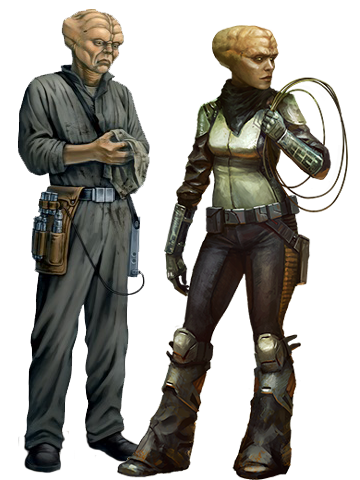 Two hundred years before the Battle of Yavin, Dressellians were simple hunters foraging for food in the wild. Two centuries later, they'd evolved into a burgeoning industrial-level society with a loose coalition government. The Empire gave a choice: slavery or death. To the Empire's surprise, many Dressellians chose death, albeit in combat. The Bothans supplied the Dressellian resistance with weapons, and sheer defiance and tenacity allowed the "primitive alien scum" to drive back the Imperial invaders of their world.
Two hundred years before the Battle of Yavin, Dressellians were simple hunters foraging for food in the wild. Two centuries later, they'd evolved into a burgeoning industrial-level society with a loose coalition government. The Empire gave a choice: slavery or death. To the Empire's surprise, many Dressellians chose death, albeit in combat. The Bothans supplied the Dressellian resistance with weapons, and sheer defiance and tenacity allowed the "primitive alien scum" to drive back the Imperial invaders of their world.
Dressellians joined with the Rebel Alliance shortly before the Bathe of Endor, and since then members of the species have been spotted in every corner of the civilized galaxy. Dressel joined the New Republic shortly after the Empire's defeat, although it usually takes some coaxing by the Bothans to get them to care about matters affecting the galaxy at large.
The Yuuzhan Vong invasion has stoked the Dressellian passion for freedom, Dressellians everywhere, from lone tramp freighter pilots to the stalwart defenders of Dressel, oppose these galactic oppressors at every turn by helping to evacuate or defend Republic colonies.
Personality: Dressellians are fiercely independent loners by nature. Their early encounters with other species (such as the Humans of the Galactic Empire) have made a lasting impression, and they are generally wary of "outlanders." Most Dressellians have a high regard for Bothans, however, given the two species' shared history of peace. Although self-serving and quick to anger. Dressellians are loyal to others who have aided them and asked for nothing in return.
Physical Description: Dressellians have elongated hairless heads, wrinkled flesh, and wiry bodies. The average Dressellian stands about 1.8 meters tall. Their wrinkled skin has earned them the callous nickname “prune face.” to which all Dressellians take offense.
Homeworld: Dressel is a temperate Mid Rim world rich in natural resources. Bothan explorers discovered it shortly before the dissolution of the Old Republic and chose not to interfere with the Dressellians, who were, at the time, a hunting-and-gathering society. The Bothans colonized a nearby asteroid belt instead. By the lime the Empire occupied Dressel, the Dressellians had developed industrial-level technology—steam-powered machines, slugthrowers. and so on.
Language: Dressellians speak Dressellese, a simple language that's evolved over millennia. As Dressellian and Bothan relations improved, many Bothese terms found their way into the Dressellese language. Since the yoke of Imperial oppression has been lifted from Dressel, the Dressellians have adopted the Bothese alphabet over their more archaic symbol-based system for written Dressellese.
Example Names: Dreefa, Errillan, Leerayem, Orrimaarko, Parskeer, Pyrron Nox, Reeft, Tremorra.
Age In Years: Child 1-9; Young Adult 10-14; Adult 15-45; Middle Age 46-59; Old 60-79; Venerable 80+.
Adventurers: Dressellians prefer the comforts of home wandering the galaxy. With the formation of the New Republic, much of the prejudice against Dressellians has disappeared, and they have begun to roam the galaxy in search or adventure. Dressellian heroes are most commonly flingers, scoundrels, and scouts. Dressellian Force-users are very rare.
Dressellian Species Traits
- Ability Modifiers: +2 Constitution, -2 Charisma
- Size: As Medium creatures, they have no special modifiers due to their size.
- Speed: base speed of 10 meters
- Defiance: Dressellian gain a +2 species bonus on Will against fear effects (such as the Frightful Presence feat) and impose a -2 penalty on Intimidate cheeks made against them.
- Early Technology: Dressellian with hero or professional class levels receive the bonus feats Weapon Group Proficiency (simple weapons) and Weapon Group Proficiency (slugthrowers) at 1st level instead of the usual Weapon Group Proficiency feats available to whatever class they select.
- Free Language Skills: Read/Write and Speak Dressellian
Dug
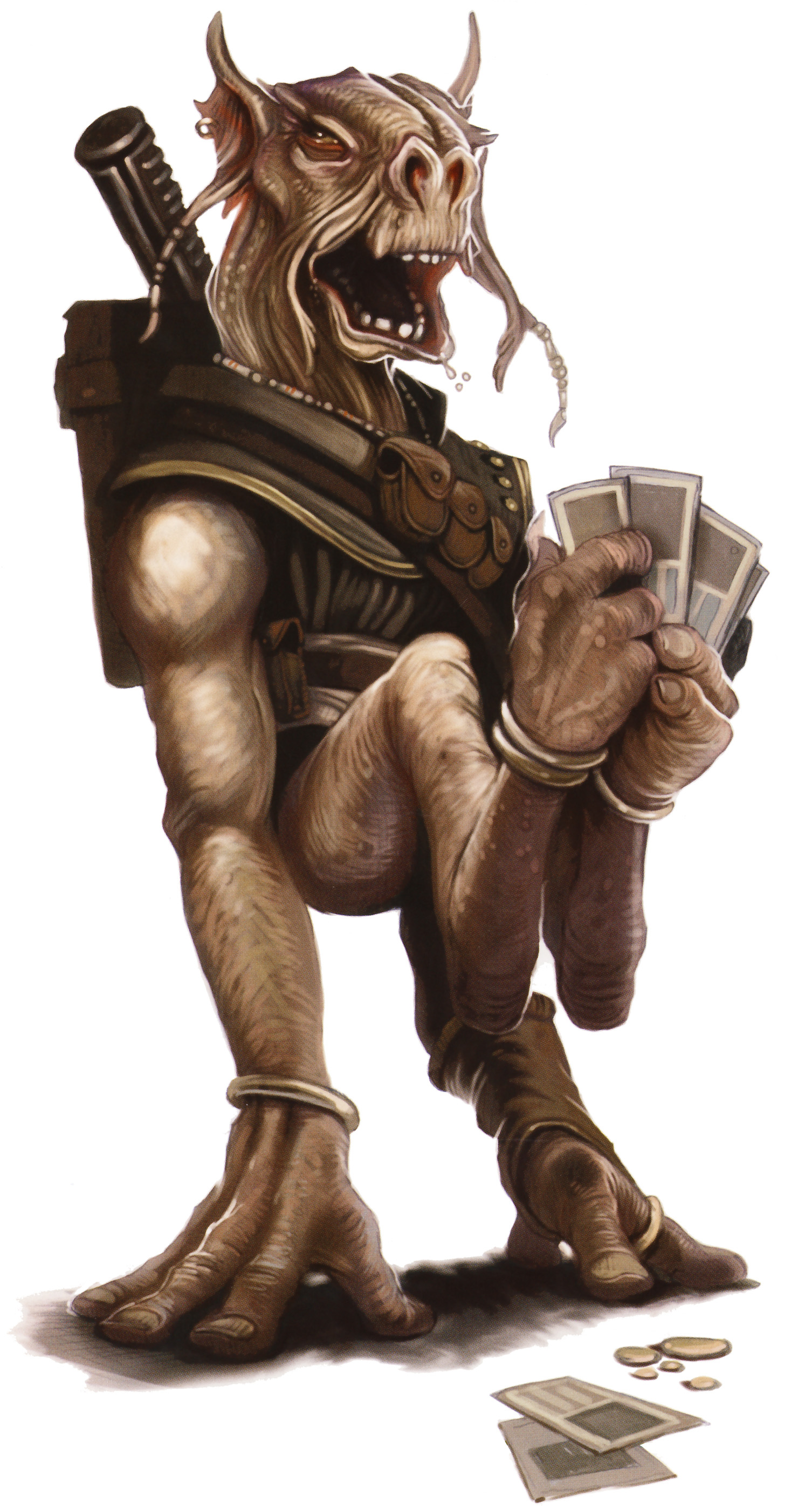 The Dugs are a species of small arboreal creatures with a well-deserved reputation for unnecessary brutality and extreme mean-spiritedness. Evolving in the tops of trees on their high-gravity world of Malastare has made them both agile and strong. Few Dugs have any desire to leave Malastare, preferring instead to remain on their home planer, where they struggle to keep control of their native lands on the world’s continent continent.
The Dugs are a species of small arboreal creatures with a well-deserved reputation for unnecessary brutality and extreme mean-spiritedness. Evolving in the tops of trees on their high-gravity world of Malastare has made them both agile and strong. Few Dugs have any desire to leave Malastare, preferring instead to remain on their home planer, where they struggle to keep control of their native lands on the world’s continent continent.
Dugs view themselves as embattled warriors, always fighting for what is rightfully theirs, but always being beaten back by just about everyone else in the galaxy. Their first contact with aliens occurred when Gran established a colony on Malastare, triggering a long and brutal war. The Republic Settled the dispute in favor of the Gran, pushing the Dugs to the political and economic fringes of their own world. This was but the first in a long string of clashes with The Dugs responded by pitying themselves, yet in return, the rest of the galaxy just felt more disgust and disappointment. Knowing that no one else wants to have anything to do with them, the Dugs have developed an openly self-congratulatory culture. Every Dug claims an ancestry that includes legendary, heroes and patriots.
Personality: Dugs are adversarial, derogatory, selfish, bullying, and temperamental - especially around aliens. Even within their own society they tend to push around others they, regard as weaklings while deferring to their obvious betters.
Physical Description: Dugs possess Four strong, spidery limbs, ear fins, and a unusual posture that helps them swing through the trees of their homeworld. They use their upper limbs as legs and their lower limbs as arms. Male Dugs have loose Maps of skin around their necks that inflate during mating calls. Dug males and females are the same size, roughly 1 meter tall.
Homeworld: The Mid Rim planet of Malastare.
Language: Few Dugs bother to learn Basic, and those who can speak it only with minor difficulty. They rarely do so, however, hoping instead to force others to acknowledge Dug society by making them learn their native language.
Example Names: Drodwa, Flugo, Gorlok, Langro Dis, Luvagwa, Pugwis, Rewulga, Sebulba, Sloor.
Age In Years: Child 1-9; Young Adult 10-14; Adult 15-44; Middle Age 45-59; Old 60-74; Venerable 75+.
Adventurers: Dug adventures are usually Fringers and scoundrels. Dugs have no known Force traditions, although Force adepts are permissible. Dugs have neither the disposition nor the inclination to become Jedi.
Dug Species Traits
- Ability Modifiers: +2 Dexterity, -2 Wisdom, -2 Charisma
- Size: As Small creatures, they gain a +1 size bonus to their Defense, a +1 size bonus on attack rolls, and a +4 size bonus on Hide checks, and a –4 penalty when grappling. They must use smaller weapons than Medium-size beings use, and their lifting and carrying limits are three-quarters those of Medium-size characters.
- Speed: base speed of 6 meters
- Agility: Dug receive a +2 species bonus on Climb and Jump checks.
- Bonus Feat: Dug receive the bonus feat Lightning Reflexes.
- Free Language Skills: Read/Write and Speak Dug
Duros
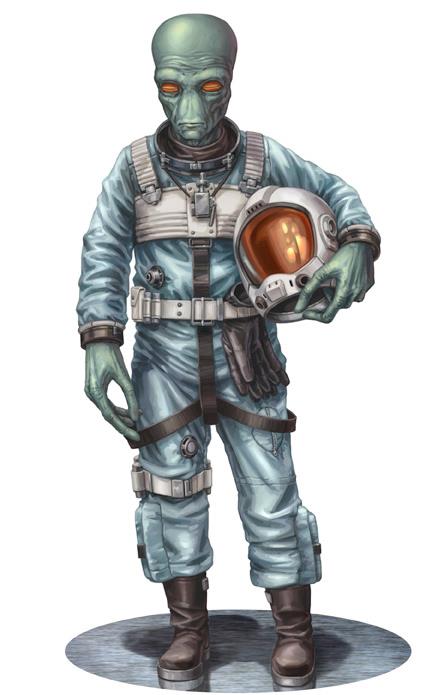 The Duros are tall, hairless humanoids from the Duro system.
The Duros are tall, hairless humanoids from the Duro system.
The Duros were one of the first species to become a major influence in the Galactic Republic, and in the past, many respected scholars credited the Duros with creating the first hyperdrive. Although this theory fell into disfavour as the Empire’s Human-centred philosophies took hold in academic circles, one cannot deny that the Duros have been traveling among the stars for at least as long as Humans.
The Duros seem to have a natural affinity for space travel. Many of them possess an innate grasp of the mathematical underpinnings of astrogational computations, and many tales are swapped in cantinas about Duros astrogators calculating the coordinates for supposedly impossible jumps in their heads. Although not as numerous as Humans, the Duros are almost as omnipresent: all but the smallest settlements in known space feature Duros populations.
The Duros species has existed on other worlds in isolation from the rest of their kind, evolving in slightly different directions from the baseline species. The most populous and well-known near-Duros species are the Neimoidians, a people rarely encountered during the Rebellion era.
Personality: A Duros tends to be intense and adventurous, always seeking to learn what's at the end of the next hyperspace jump. They are a proud, self-sufficient fun-loving people who also have a tendency toward gregariousness.
Physical Description: Duros average about 1.8 meters tall. Large eyes and wide, lipless mouths dominate their noseless faces. Their skin color ranges from blue-grey to deep azure.
Homeworld: Duro, a toxic planet located at the extreme outer edge of the Core Worlds region. The Duros live on orbital cities within the Duro system.
Language: Duros speak and read Durese and Basic.
Example Names: Baniss Keeg, Dorai, Ellors Madak, Kadlo, Kir Vantai, Klis Joo, Lai Nootka, Monnda Tebbo, Oso Nim.
Age In Years: Child 1-9; Young Adult 10-14; Adult 15-35; Middle Age 36-49; Old 50-69; Venerable 70+.
Adventurers: Duros adventurers include hyper-space explorers, star charters, and spacers of all descriptions. They also tend to gravitate toward the sciences, including engineering and astrogation. Some Duros shun exploration in favour of smuggling and trading; and a small number go into diplomatic professions.
Duros Species Traits
- Ability Modifiers: -2 Strength, +2 Dexterity, -2 Constitution, +2 Intelligence
- Size: As Medium creatures, they have no special modifiers due to their size.
- Speed: base speed of 10 meters
- Bonus Feat: Duros receive the bonus feat Spacer.
- Free Language Skills: Read/Write and Speak Basic and Durese.
Ebranite
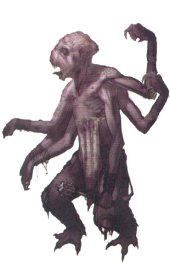 Ebranites are six-armed humanoids skilled at climbing. They dwell in the great canyons and cavern networks of their homeworld and use clubs, bows, and slings to hunt for food.
Ebranites are six-armed humanoids skilled at climbing. They dwell in the great canyons and cavern networks of their homeworld and use clubs, bows, and slings to hunt for food.
Ebranite families unite as clans called thildas, each one consisting of 20 to 30 families that work together and protect one another. All Ebranites have their clan's insignia tattooed on their uppermost left arm at birth, and they remain loyal to their respective thildas until death. A council, or ghantar, leads each thilda. The clan leader, or fyaban, is typically an Ebranite elder.
Ebranites were all but ignored by the Old Republic. When the Empire seized control of Ebra. Imperial taskmasters put the primitive Ebranites to work in oil mines. A few escaped and joined the Rebel Alliance. The imperial occupation has taught the average Ebranite to be wary of outlanders and suspicious of outlander technology.
Personality: Ebranites are fiercely loyal to their family and their clan, in that order. Their general mistrust of technology can be overcome with time. Since the Battle of Endor, more Ebranites have learned to overcome their reservations concerning outlanders, and those whose families were annihilated under Imperial rule have made new lives for themselves within the greater galactic society. Ebranites arc generally resourceful, tenacious, and quick to anger.
Physical Description: Ebranites have six strong arms, each ending in a six-fingered hand. They have broad, flat feet, a tapered, hairless head with no visible ears, and pupilless eyes. Ebranite adults stand about 1.5 meters tall.
Homeworld: Ebra, the second planet of the Douse system (located in the Mid Rim), is a covered in towering mountains separated by sheer canyons. The Ebranites are perfectly suited to moving around this terrain and have created settlements in caves set into the canyon walls.
Language: Ebranites speak Ebranese, a language of honks, growls, and moans. Written Ebranese uses a primitive pictographic representation of past events.
Example Names: Boda Etaan, Groex Gal, Eretha Narra, Rith Tar'ak, Erox Vor'an.
Age In Years: Child 1-13; Young Adult 14-17; Adult 18-45; Middle Age 46-69; Old 70-84; Venerable 85+.
Adventurers: Ebranites are confined to their homeworld during the Rise of the Empire era. Ebranites begin to explore the galaxy during the Rebellion era and can be found in every corner of the galaxy during The New Jedi Order era. Ebranite heroes are typically fingers and scouts, and Force-users among the species are exceedingly rare.
Ebranite Species Traits
- Ability Modifiers: +2 Strength, -2 Dexterity, +2 Constitution, -2 Intelligence, -2 Charisma
- Size: As Medium creatures, they have no special modifiers due to their size.
- Speed: Base speed is 6 meters, or 12 meters when climbing. They move slowly and awkwardly on flat terrain.
- Darkvision: Ebranite can see in the dark up to 20 meters. Darkvision is black and white only but otherwise functions as normal sight.
- Extra Limbs (6): Ebranites have six arms. The extra limbs give them a +6 species bonus on Climb checks and grapple cheeks. Ebranites can hold items in each of their six hands, but their brains arc not complex enough to let them use more than four arms in combat.
An Ebonite has one primary hand and three off hands. An Ebranite can wield up to four weapons, but the normal penalties for fighting with multiple weapons apply (see the Multiweapon Fighting feat). - Natural Armor: Ebranite receive a +2 natural armor bonus to Defense.
- Primitive: Ebranite with heroic or professional classes receive the bonus feats Weapon Group Proficiency (primitive weapons) and Weapon Group Proficiency (simple weapons) instead of the usual Weapon Group Proficiency bonus feats.
- Rage: When an Ebranite takes damage from an attack, it can choose to enter a frenzied state. In this state, the Ebranite gains +4 Strength. +2 vitality points per level (+0 for commoners), and a +2 rage bonus on Fortitude and Will saves, but suffers a -2 penalty to Defense. While raging, the Ebranite cannot use skills that require patience and concentration, such as Move Silently. Combat Expertise, or Force-based abilities. The rage lasts for a number of rounds equal to 5 + the Ebranite's Constitution modifier. At the end of this duration, the Ebranite loses the bonus to Strength and the bonus vitality points. Furthermore, the Ebranite is fatigued (-2 penalty to Strength and Dexterity, can't run or charge) for a number of rounds equal to the rage's duration.
- Skill Bonus: Ebranite receive a +4 species bonus on Hide checks in mountainous or rocky terrain.
- Free Language Skills: Read/Write and Speak Ebranese and Basic.
Elom
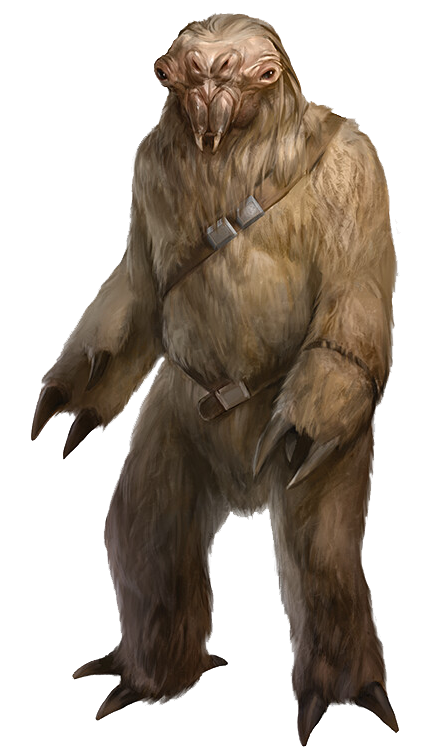 The Eloms dwell deep beneath the surface of a world with the same name. Despite their savage and fearsome appearance, they are an easy going, pacifistic species of strict herbivores.
The Eloms dwell deep beneath the surface of a world with the same name. Despite their savage and fearsome appearance, they are an easy going, pacifistic species of strict herbivores.
The existence of the Eloms remained unknown even after the Old Republic made contact with a more technologically advanced species (the Elomin) living on the surface. The Eloms were believed to have died out when the environment of the world turned to permanent drought. The Elomin discovered the underground communities of Eloms during a mining accident. Initially, the Elomin viewed the Eloms as easily trainable beasts and used them as cheap slaw labour in their mines, but when Old Republic xenosociologists studied the Eloms, it became apparent they were sentient.
Over the objections of the Elomin, the Old Republic enforced treaties that gave the Eloms territorial rights to the both the underground tunnels and the lands above them. Elomin resentment soon passed, however, in the face of the open-armed acceptance they enjoyed from the peaceful, unsophisticated Eloms. Further, the Eloms had no interest in becoming involved with the offworld business dealings of the Elomin, but were content with living as they had for countless centuries. For the most part, the Eloms were more than happy to leave the Horns to their caves.
The attitudes of many Eloms changed slightly when the Empire revoked all treaties established by the Old Republic on Elom and enslaved the Elomin to mine lommite. Young Eloms in particular were disturbed by, the Imperial troops' mistreatment of their neighbours, so they started to fight to free their world. Initially, the Eloms merely liberated a few Elomin from isolated mine shafts, but after the Rebel Alliance sent commandos to help the Eloms, entire slave camps vanished into the Elom cities hidden at the centre of deep labyrinths.
Following the creation of the New Republic, a number of young Eloms left their underground lives to seek their fortune on their homeworld's surface or even among the stars.
Personality: Eloms are ambitious and highly intelligent, but they often underestimate the capacity for evil that exists in other species. They are frequently manipulated into becoming involved with illegal activities. Eloms arc generous, easy going, quick to forgive, and eager to learn useful skills and trades.
Physical Description: Eloms are stocky mammalian bipeds with oily fur and layers of fat designed to capture moisture. Their hands and feet have hooked claws that are optimal for digging, and they have prehensile toes on each foot. Their small, round eyes are sensitive to bright light and are set at the far extremes of a wide face dominated by two rock-hard, sharp tusks and thick jowls that the Elom me to store excess food. They are sturdy beings that average 1.4 meters tall as adults.
Homeworld: The cold, mineral-rich desert world of Elom, located in the Outer Rim.
Language: The structure of the Elom mouth makes it difficult for them to speak Basic (they must spend 2 skill points to get the Speak Basic skill), but it is possible for them to do so.
Example Names: Broig, Gossof, Oront, Qurgg, Skona, Trugbuz, Ukskul.
Age In Years: Child 1-11; Young Adult 12-17; Adult 18-49; Middle Age 50-65; Old 66-89; Venerable 90+.
Adventurers: Eloms who are taken away from their homeworld become or remain professionals (almost exclusively thugs in the employ of criminal organizations). The few adventuring Eloms tend to be fringers or scouts.
Elom Species Traits
- Ability Modifiers: +2 Strength, -2 Dexterity, +2 Intelligence, -2 Wisdom, -2 Charisma
- Size: As Small creatures, they gain a +1 size bonus to their Defense, a +1 size bonus on attack rolls, and a +4 size bonus on Hide checks, and a –4 penalty when grappling. They must use smaller weapons than Medium-size beings use, and their lifting and carrying limits are three-quarters those of Medium-size characters.
- Speed: base speed of 6 meters
- High Light Sensitivity: Elom evolved in an under-ground tunnel system illuminated only by faintly glowing moss. If they venture into light brighter than gloom of early dawn, they are effectively blinded (See Core book Chapter 12 Character Condition Summary).
- Strong back: Elom move at full speed even when carrying a medium or heavy load (unlike other creatures whose speed is reduced in such situation).
- Free Language Skills: Read/Write and Speak Elom.
Elomin
 For several centuries, the galaxy believed the Elomin were the only sentient species on the desert world Elom. When the Old Republic first visited Elton a century before the rise of the Empire, the Elomin were divided into separate political nations, used internal combustion engines and slug-throwing weaponry, and were barely able to launch satellites into orbit. Blasters, repulsorlifts, and starships were beyond anything the Elomin had ever imagined. They took quickly to the advanced technology the first-contact specialists chose to share with them. By the time the Galactic Civil War erupted, the Elomin and their world were active participants in the galactic economy.
For several centuries, the galaxy believed the Elomin were the only sentient species on the desert world Elom. When the Old Republic first visited Elton a century before the rise of the Empire, the Elomin were divided into separate political nations, used internal combustion engines and slug-throwing weaponry, and were barely able to launch satellites into orbit. Blasters, repulsorlifts, and starships were beyond anything the Elomin had ever imagined. They took quickly to the advanced technology the first-contact specialists chose to share with them. By the time the Galactic Civil War erupted, the Elomin and their world were active participants in the galactic economy.
The world of Elom is rich in deposits of lommite, a mineral used in the fabrication of transparisteel. Lommite became a sought-after commodity, and the Elomin were canny enough to enter into mining agreements with offworld shipbuilders that would not damage the environment of their world.
Culturally, the Elomin try to discover or create order in all things. They view the universe as a logical, organized puzzle and endeavour to find the pieces and bring them to their logical places. When confronted with something that doesn't fit into the pattern they have defined, they may try to redefine the pattern but are just as likely to attempt to ignore the discordant details. Such was the case when the Elomin first discovered the existence of the underground-dwelling Eloms, another sentient species native to their world. The Elomin first denied the existence of the Eloms and then later denied they were sentient. It wasn't until the Old Republic granted the Eloms all the rights of sentiments under its laws and the Eloms helped the Elomin resist Imperial oppression during the Rebellion era that they fully acknowledged the existence and independence of their neighbours.
Personality: Elomin have difficulties relating to other species, which they view as perpetrators of chaos. They excel as pilots, navigators, and theoretical thinkers as long as they can operate independently or with other Elomin. They get along well the Woostoids and other species that value logic and order as much as they do, but Elomin consider dealing with Humans and other illogical beings an exercise in frustration.
Physical Description: The Elomin are slender humanoids with four hornlike protrusions on the top of their heads and large ears that taper to points. Skin colours range from bright red to deep black, and their seemingly pupillless eyes are usually bright blue or red. They stand between 1.6 and 1.9 meters tall.
Homeworld: The cold, mineral-rich desert world of Elom, located in the Outer Rim.
Language: Elomin speak and read Elomin, and they can learn and speak Basic with no difficulty.
Example Names: Brafid, Rennimdius, Verrinnefra, Monjai, Notoganarech, Theosidicc, Laerron.
Age In Years: Child 1-5; Young Adult 6-12; Adult 13-40; Middle Age 41-60; Old 61-72; Venerable 73+.
Adventurers: Elomin adventurers tend to be fringers, scouts, or tech specialists. Elomin Jedi consulars existed before the rise of the Empire, and a number of Elomin religious traditions exist that revolve around the Force, allowing for Force adepts.
Elomin Species Traits
- Ability Modifiers: None
- Size: As Medium creatures, they have no special modifiers due to their size.
- Speed: base speed of 10 meters
- Xenophobic: Elomin are cautious in their dealing with all species they consider illogical or disorderly. The somewhat xenophobic Elomin suffer a -4 penalty on Diplomacy or Charisma checks made to improve the attitudes of members of other species. Likewise, they impose a -4 penalty on other species attempts to improve Elomin attitudes toward them.
- Free Language Skills: Read/Write and Speak Elomin
Em’liy
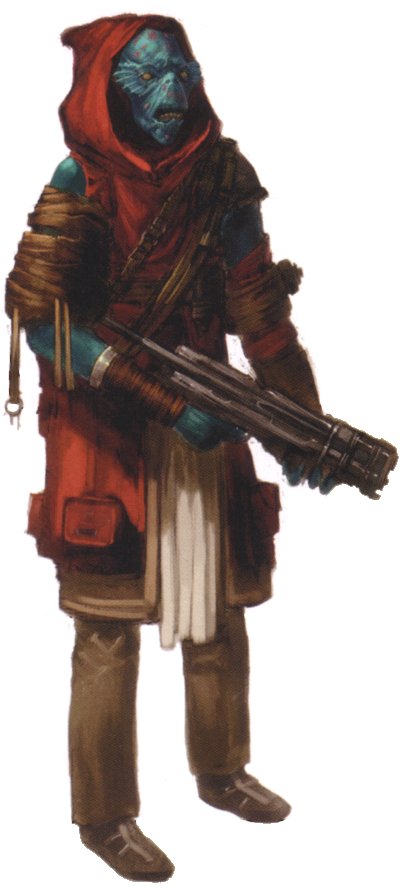 Imperial forces drove the Em’liy, the dominant species of Shalyvane, from their cities. A disgraced people with no home and no resources to rebuild cities, the Em’liy felt undeserving of a name and simply called themselves “Nomads.” Maligned and homeless for years, the Em’liy evolved into a hardy and tenacious people who have only recently begun to rebuild their capital city and explore the galaxy.
Imperial forces drove the Em’liy, the dominant species of Shalyvane, from their cities. A disgraced people with no home and no resources to rebuild cities, the Em’liy felt undeserving of a name and simply called themselves “Nomads.” Maligned and homeless for years, the Em’liy evolved into a hardy and tenacious people who have only recently begun to rebuild their capital city and explore the galaxy.
Angered Em’liy are dangerous foes and loyal friends. They are not easily impressed; those who impress them have allies for life. Entire wars have ended because one Em’liy general sufficiently impressed another in the course of battle. Since their fall from grace, however, much of their arrogance has left them, replaced with feelings of loss and restlessness. The Em’liy are deadly warriors, with a ferocity in battle unmatched by many warrior species. Observers have labeled this ferocity “berserker” behavior, though this not entirely accurate. Warring Em’liy give themselves over completely to a fight, letting the course of battle define their actions and thoughts. They control their own actions, but the Spirit of Battle (see Em'liy Species Traits, below) helps refine that control.
Personality: Em’liy are born survivors, raised to hunt for every morsel of food and fight for every drop of water. They take nothing for granted and tend to possess a fatalistic approach toward life. They expect no favors and express only contempt for the lazy, Spoiled, or domineering.
Physical Description: The Em’liy have muscular bodies with skin that ranges from yellow-tan to orange to blue. They wear their fine dark hair in long topknots to show caste status and inspire fear in enemies. The number of topknots varies from none to three, depending on caste. Otherwise, their bodies arc hairless.
Em’liy stand 1.9 meters tall, on average. They have a distinct lack of facial features—their smooth, noseless, and earless faces show little in the way of sensory organs. They have small, round eyes with no lids or lashes, and their thin mouth openings are nearly lipless. A thin, gas-permeable layer of skin covers their auditory and olfactory organs to protect them from the hot sun, harsh wind, and sandstorms of their homeworld.
Homeworld: Shalyvane, a desert world located in the Outer Rim.
Language: Em’liy speak and read Em’liy. Most Em’liy also learn to speak Basic.
Example Names: Evir,zan, Jelevos, Ji'kata, Karien, Neth, Shanzar, Tez'ra.
Age In Years: Child 1-10; Young Adult 11-15; Adult 16-35; Middle Age 36-53; Old 54-64; Venerable 65+.
Adventurers: Em’liy are nomads, and those who manage to leave their homeworld often adopt a nomadic lifestyle in space. bawling from one system to the next aboard tramp freighters and other vessels. Em’liy adventurers can be fringers, scouts, scoundrels, and soldiers. Em’liy nobles do not exist.
Although the Em’liy have no known Force traditions, members of their species could conceivably learn the ways of the Force and either train as Force adepts or members of the Jedi Order.
Em’liy Species Traits
- Ability Modifiers: +2 Constitution, -2 Wisdom, -2 Charisma
- Size: As Medium creatures, they have no special modifiers due to their size.
- Speed: base speed of 10 meters
- Spirit of Battle: Once per day, by focusing his or her mind on combat, an Em’liy can enter the Spirit of Battle. In this state, the Em’liy temporarily gains +4 Strength, a +2 competence bonus to Defense, a +2 competence bonus on saving throws, and +2 vitality points per character level (+0 for commoners).
The Spirit of Battle lasts for a number of rounds equal to 5 + the Em’liy’s Constitution modifier. An Em’liy can end the Spirit of Battle at any time voluntarily (as a free action). Upon ending the Spirit of Battle, the Emily becomes fatigued (-2 penalty to Strength and Dexterity, can't run or charge) for an number of rounds equal to the time spent in the Spirit of Battle or the rest of the combat encounter, whichever is longer.
While in the Spirit of Battle, an Em’liy cannot use skills or abilities that require patience or concentration. - Bonus Feat: Em’liy receive the bonus feat Skill Emphasis (Survival) and Stealthy.
- Free Language Skills: Read/Write and Speak Em’liy
Ewok
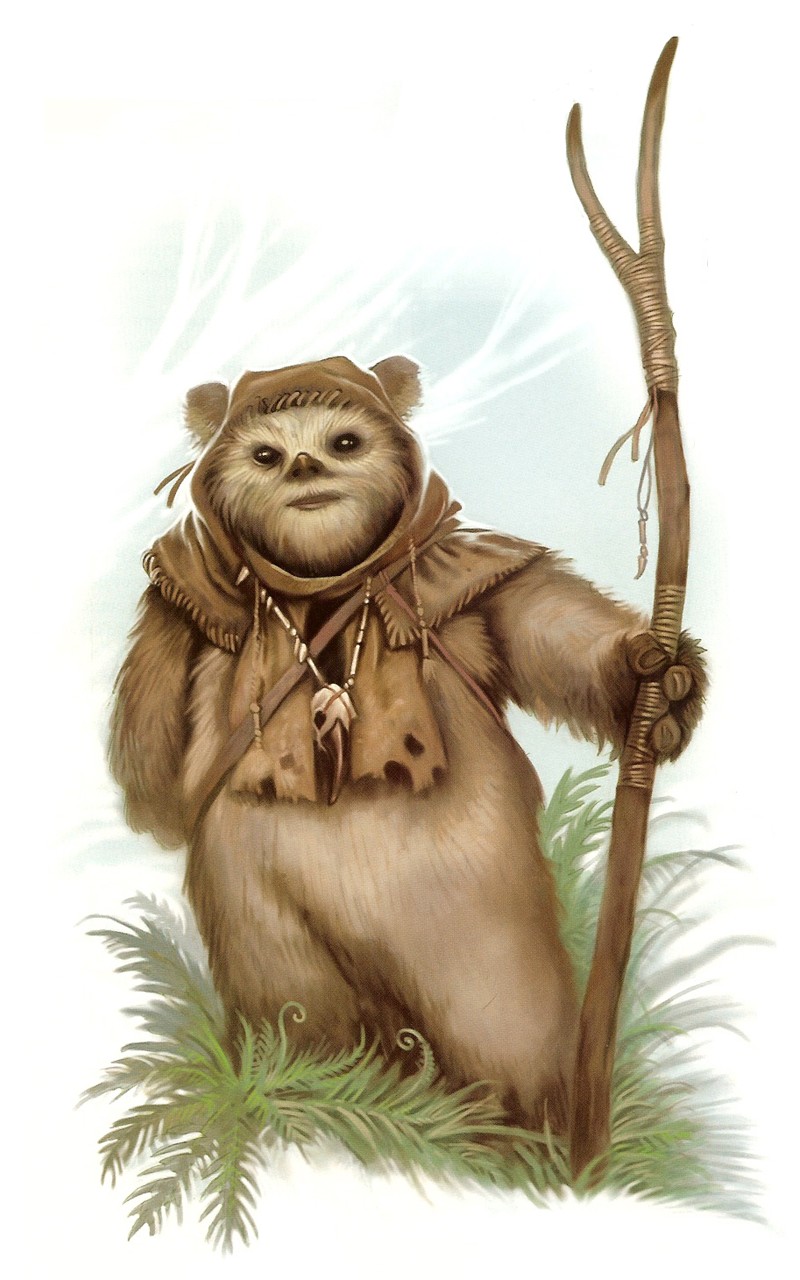 Ewoks are intelligent omnivores native to one or the moons orbiting Endor. Before the Battle of Endor, their existence was almost entirely unknown, except among a handful of Imperial scouts and xenobiologists.
Ewoks are intelligent omnivores native to one or the moons orbiting Endor. Before the Battle of Endor, their existence was almost entirely unknown, except among a handful of Imperial scouts and xenobiologists.
Ewoks are organized in tree-dwelling tribes. Tribal occupations are gender-based. Males hunt, forage, and make weapons, while females raise young and handle other domestic tasks. Ewok culture revolves around complex animistic beliefs involving the giant trees of the forest moon. The forests of Endor loom as large in their tales as they do in their lives.
Although technologically primitive, Ewoks are clever, inquisitive, and inventive. They are experts at creating tools, traps, and other contraptions using wood, cloth, vines, and stones. When first introduced to machines, they are skittish and wary, but Ewok curiosity soon overcomes fear, leading to wild and inventive experimentation. Ewoks can eventually learn to operate any item of technology.
Personality: Ewoks tend to be curious, superstitious, arid courageous, though they can be fearful around things that are strange and new.
Physical Description: Ewoks are furry bipeds that average about 1 meter tall. Their thick fur varies widely in color arid pattern. They often wear hoods, decorative Feathers, and animal bones.
Homeworld: The forest moon of Endor, a silvery gas giant on the fringes of the Unknown Regions.
Language: Ewoks speak Ewokese. They have no written form of their language. They can learn to speak Basic.
Example Names: Asha, Batcheela, Chirpa, Chukha-Trok, Deej, Grael, Gwig, Kneesaa, Latara, Leeni, Logray, Malani, Nippett, Paploo, Ra-Lee, Romba, Shodu, Teebo, Wicket, Wiley.
Age In Years: Child 1-9; Young Adult 10-13; Adult 14-29; Middle Age 30-44; Old 45-59; Venerable 60+.
Adventurers: An Ewok finds adventure through a love of excitement, a natural inquisitiveness, or a warrior's quest. Usually, an Ewok hero joins up with a scout or other hero who has access to a starship. Collecting powerful “magic” items from fallen opponents, such as a stormtrooper's helmet or a range finder from a blaster rifle, is a sure way for an Ewok to earn the respect of his or her tribe.
Ewoks encountered away from home are usually fringers or scouts.
Ewok Species Traits
- Ability Modifiers: -2 Strength, +2 Dexterity
- Size: As Small creatures, they gain a +1 size bonus to their Defense, a +1 size bonus on attack rolls, and a +4 size bonus on Hide checks, and a –4 penalty when grappling. They must use smaller weapons than Medium-size beings use, and their lifting and carrying limits are three-quarters those of Medium-size characters.
- Speed: base speed of 6 meters
- Primitive: Ewok with heroic or professional classes receive the bonus feats Weapon Group Proficiency (primitive weapons) and Weapon Group Proficiency (simple weapons) instead of the usual Weapon Group Proficiency bonus feats.
- Bonus Feat: Ewoks have heightened senses. Ewok receive the bonus feat Alertness .
- Free Language Skills: Speak Ewokese.
Falleen
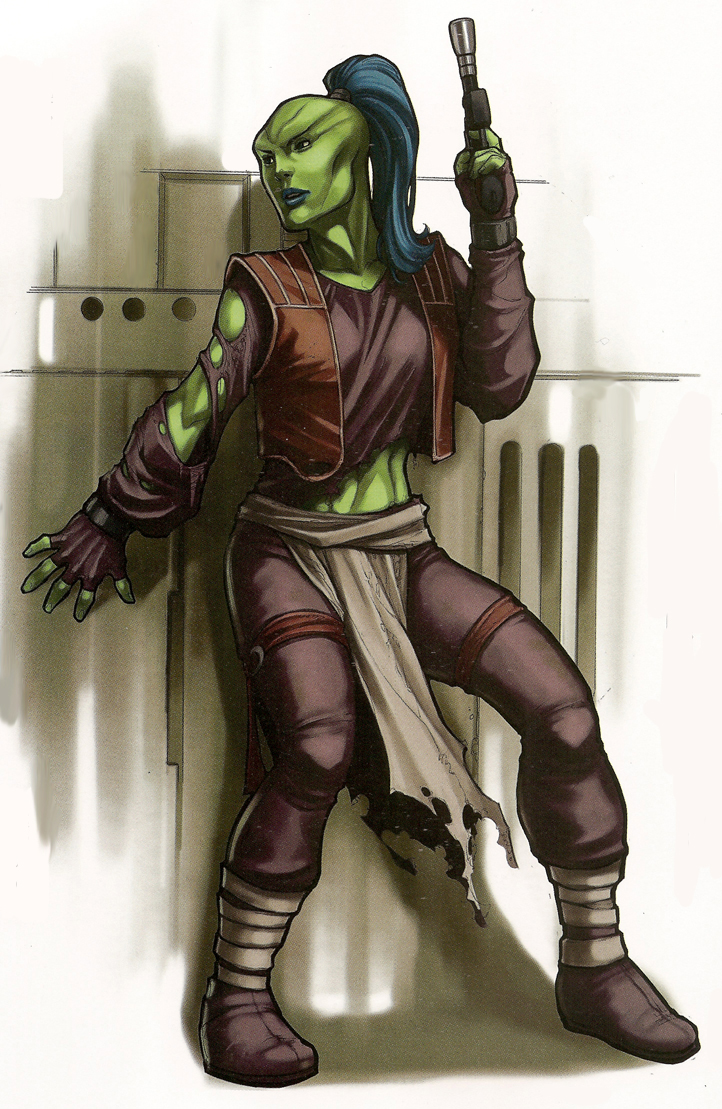 The Falleen are a species of reptilian humanoids from the Mid Rim system of the same name. They are widely regarded as one of the most aesthetically pleasing species of the galaxy, with an exotic appearance and powerful pheromone-creating abilities. While their pheromones are to attract suitable mates, they also have a pronounced effect on other humanoid species, leading many to describe Falleen as “irresistible”
The Falleen are a species of reptilian humanoids from the Mid Rim system of the same name. They are widely regarded as one of the most aesthetically pleasing species of the galaxy, with an exotic appearance and powerful pheromone-creating abilities. While their pheromones are to attract suitable mates, they also have a pronounced effect on other humanoid species, leading many to describe Falleen as “irresistible”
The Falleen are not commonly encountered off their homeworld. Although a small stellar-class spaceport exists on their world and they are technicity capable of mastering space travel, they have never felt an urge to do so. They are content to manage their own affairs and focus on their own world and culture, which they believe is inherently superior to everything else the galaxy has to offer. Many young Falleen nobles leave to spend their adolescent years touring the galaxy, for the most part finding nothing but confirmation of their innate superiority. A few, however, choose to remain among the stars, and during the Rebellion era. many of them join the Rebels.
In the early days of the Empire, an imperial biological weapons facility on Falleen accidentally released a deadly plague. Fortunately for the planet, Darth Vader was able to prevent the spread of the biological agent, by bombarding the city that was home to the facility. Over 200,000 Falleen were killed, but the planet survived. Still, many Falleen harbor lingering resentment toward Humans and Imperials in particular.
Falleen commoners encountered offworld are almost always part of an entourage led by a Falleen noble or diplomat. They can speak Basic with no difficulty.
Personality: Falleen are well mannered, self-assured, and driven to succeed. Even at the worst, they possess undeniable and unshakable charisma. Sometimes their sense of superiority makes them arrogant and seductive, but Falleen can also be sensitive and compassionate.
Physical Description: Falleen vary in height from 1.7 to 2.2 meters. Their lithe bodies are covered with scales that are typically deep green or gray-green, but the color fluctuates toward red or orange when they release their pheromones. Male and female Falleen are almost identical physically, except that the spiny ridge that runs down the back of the males is more pronounced than the one that runs clown the backs of the females.
Homeworld: Falleen, a temperate Mid Rim world dominated by mountains, jungles, and imperious, heavily guarded noble estates.
Language: Falleen have their own spoken and written language, and most Falleen who venture from their homeworld speak Basic as well.
Example Names: Anazider, Azool, Haxim, Jzora, Maziel, Rzadi, Savan, Xand, Xixor, Xzuhal.
Age In Years: Child 1-11; Young Adult 12-17; Adult 18-68; Middle Age 69-110; Old 111-145; Venerable 146+.
Adventurers: Falleen heroes are most frequently nobles or scoundrels. Falleen Jedi consulars and Jedi guardians are also possible.
Falleen Species Traits
- Ability Modifiers: +2 Charisma
- Size: As Medium creatures, they have no special modifiers due to their size.
- Speed: base speed of 10 meters
- Hold Breath: Many xenobiologists believe that the Falleen's reptilian ancestors were amphibious. A Falleen can hold their breath for a number of rounds equal to 25 times their Constitution score before he needs to make checks against drowning.
- Pheromones: The natural pheromones of Falleen affect the behavior of other sentient beings within 10 meters. Falleen gain a +1 species bonus on Bluff, Diplomacy, Entertain, Gather Information, and intimidate checks made against beings in range. Targets without respiratory systems (such as Givin) are unaffected. A Falleen can also temporarily enhance this effect through careful effort, increasing the bonuses by +1 for each hour of uninterrupted meditation. The bonus cannot exceed +4, While a Falleen never loses the basic species bonus of +1, the additional meditation bonus only lasts for 1 hour after meditation is completed.
- Free Language Skills: Read/Write and Speak Falleen
Farghul
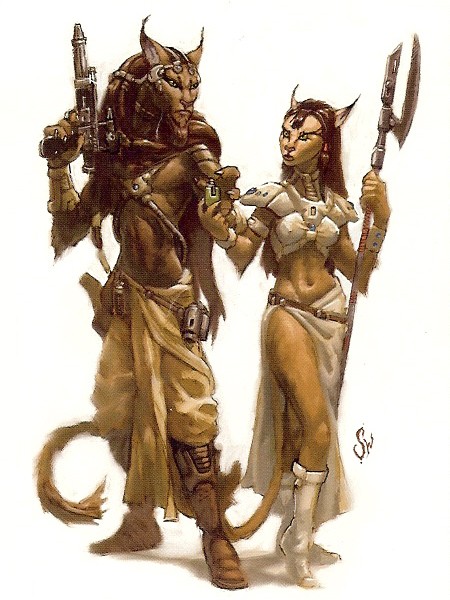 The Farghul are feline humanoids from the world of Farrfin. The Farghul are very conscious of their appearance and they are never seen in public without searing the highest quality of clothing they can afford, not to mention the latest fashions. When visiting other worlds, they always consult clothing stores so they can be appropriately attired. When on Farrfin, they usually wear elaborately decorated cloaks, skirts, or pants; tunics, shirts, and blouses are not part of traditional Farghul dress. Elaborate jewellery, however, is essential.
The Farghul are feline humanoids from the world of Farrfin. The Farghul are very conscious of their appearance and they are never seen in public without searing the highest quality of clothing they can afford, not to mention the latest fashions. When visiting other worlds, they always consult clothing stores so they can be appropriately attired. When on Farrfin, they usually wear elaborately decorated cloaks, skirts, or pants; tunics, shirts, and blouses are not part of traditional Farghul dress. Elaborate jewellery, however, is essential.
The Farghul prefer to rely on cunning and trickery rather than direct confrontation and force. Something has gone wrong somewhere along the way if a Farghul ends up in a fight, and it takes a lot of provocation to cause one to lose his or her good humor. A Farghul tries talk and bribery before resorting to violence.
The only authority that a Farghul respects is that of the Jedi—and they tend to be downright terrified of them. Farrfin has been a haven for rogues and scoundrels since the felinoids first contacted the Old Republic. When the Jedi Council spearheaded a Republic-sponsored effort to clean out a number of smuggling and pirate bases that were choking trade in surrounding star systems, the display of force rocked Farghul culture to its core and left a deep scar on the collective psyche of the playful beings. They have been suspicious of offworld governments ever since, and they were particularly distrustful of the Empire. However, they keep their dislike hidden behind smiling, respectful facades. Following the fall of the Empire, Farrfin joined the New Republic, but the world almost instantly became a hotbed of corruption and petty confidence schemes.
Personality: The Farghul in general have playful and mischievous personalities. They delight in puns, plays-on-words, sleight-of-hand tricks, and intellectual puzzles. They are good-natured, boisterous, and always ready with a wide smile and a terrible joke. Rigged games of chance are favorite pastimes among the Farghul, and if someone ever sees through such a con, they willingly return any money gained and cheerfully explain how they fixed the game. As such, they have a reputation as a species of unrepentant con-artists and thieves—and as far as adventuring Farghul are concerned, this is not far from the truth.
Physical Description: Farghul bodies are covered in medium-length, tawny fur, and they have pronounced muzzles, sharp fangs, and long prehensile tails. Their hands that feature stubby fingers with retractable, sharp claws. Farghul adults stand between 1.7 and 2 meters tall.
Homeworld: Farrfin, a temperate world located in the Core Worlds region.
Language: Farghul have their own written and spoken language, and most learn to speak Basic.
Example Names: Breela, Crelfax, Delfas, Lyrrin, Pashira, Rish, Shanifer, Terasa, Terath.
Age In Years: Child 1-5; Young Adult 6-10; Adult 11-50; Middle Age 51-70; Old 71-75; Venerable 76+.
Adventurers: Farghul adventurers are usually nobles or scoundrels. Farghul Jedi are practically unheard of, and those that have existed have been outcasts from Farghul society.
Farghul Species Traits
- Ability Modifiers: -2 Strength, +2 Dexterity, -2 Constitution, +2 Charisma
- Size: As Medium creatures, they have no special modifiers due to their size.
- Speed: base speed of 10 meters
- Strong Prehensile Tail: A Farghul with the Martial Arts feat can use his or her tail to wield a melee weapon and gain an extra off-hand attack per round. Penalties for two-handed fighting apply. The tail cannot be used as a weapon, but it can be used to make grapple attacks.
- Free Language Skills: Read/Write and Speak Farghul
Feeorin
 Feeorin are hulking, powerful humanoids found in small colonies on scattered Outer Rim worlds. They are strong and able to perform strenuous activities for prolonged periods without rest.
Feeorin are hulking, powerful humanoids found in small colonies on scattered Outer Rim worlds. They are strong and able to perform strenuous activities for prolonged periods without rest.
Their planet of origin remains a mystery, but it is believed that Feeorin colonists abandoned the world eons ago following a radical climate change. The colony transports spread out to the far reaches of the galaxy in search of habitable planets. The Feeorins who survived the search founded settlements on other worlds, where they were usually viewed as raiders or scavengers. Often hunted and eradicated by the native species, the Feeorin population dwindled. By the end the Rebellion era, fewer than one trillion Feeorins survive.
Fortunately, Feeorins are an extremely long-lived species. Their metabolisms are also unique, because a Feeorin does not “age” as normal species do. Instead of slow degradation until death, Feeorins seem to grow stronger and more powerful until the day they die, sometime between the ages of 300 and 400 years Death from “old age” happens without any warning they simply drop dead.
Personality: Like Humans, Feeorins display a wide array of personalities, although many Feeorin explorers and spacers are considered gruff and self-serving. Feeorins are sometimes quick to anger and impersonal, rarely going out of their way to make friends or acquaintances. They have a reputation of being brutal and dangerous.
Physical Description: Feeorins are well-muscled humanoid who average 2.2 meters tall. They come in many hues, from coal black to pale white, but green, yellow, and blue are the most common skin colors. They have bright red eyes and half-meter-long tendrils that cascade from the sides and back of their head.
Homeworld: Unknown.
Language: Feeorins speak and read Feeorin. Most Feeorins also speak Basic.
Example Names: Bral, Crayl, Dod, Dreyla, Kren, Nor, Nym, Pryn, Sayla, Zun.
Age In Years: Child 1-11; Young Adult 12-16; Adult 17-194; Middle Age 195-324; Old 325-399; Venerable 400+.
Adventurers: Perhaps because of their limited numbers. almost all Feeorin are adventurers by definition. They are typically fringers, scoundrels, and soldiers.
Feeorin Species Traits
- Ability Modifiers: +2 Strength, -2 Dexterity, +2 Constitution, -2 Wisdom, -2 Charisma
- Size: As Medium creatures, they have no special modifiers due to their size.
- Speed: base speed of 10 meters
- Low-Light Vision: Feeorin can see twice as far as normal in dim light, and retain the ability to distinguish color and detail under these conditions.
- Resilient: Feeorin gain a +2 species bonus on Fortitude saves.
- Stronger by Age: A Feeorin's Strength, Dexterity, and Constitution increase by 1 at middle-age and again at old age. Unlike other species, a Feeorin does not increase his or her intelligence, Wisdom, or Charisma as he or she ages.
- Bonus Feat: Feeorin receive the bonus feat Endurance.
- Free Language Skills: Read/Write and Speak Feeorin
Filordus
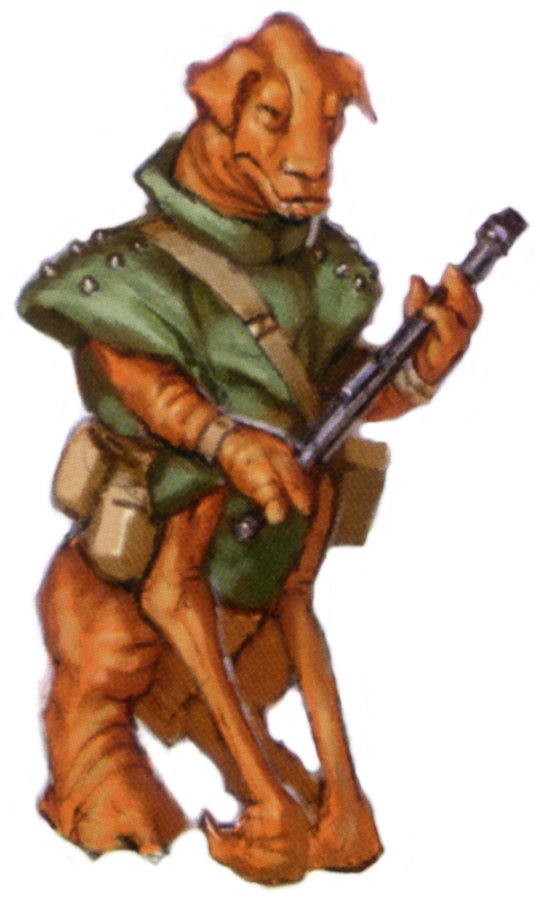 Filordi (singular: Filordus) care about two things: making their homeworld less hostile, and getting away from it. Some Filordi prefer to make what they can of their homeworld: thus, they have begun terraforming in earnest.
Filordi (singular: Filordus) care about two things: making their homeworld less hostile, and getting away from it. Some Filordi prefer to make what they can of their homeworld: thus, they have begun terraforming in earnest.
Hardy and intelligent. Filordi adapt quickly to circumstances. They are driven to succeed but seem incapable of planning for long-term success. In this way, they are a short sighted species. To survive, they consume every bit of any resource that comes their way. Frequently the best way to defeat them is to give them what they want, then leave before they change their mind.
Filordi are asexual and reproduce while dying. A week after its "parent" has died, an infant Filordi crawls from the corpse.
Personality: Most Filordi are persistent, resourceful, creative, and ruthlessly opportunistic.
Physical Description: Filordi stand 1.4 meters tall on average and have six limbs. Two arms hang from a Filordus's shoulder. Long, spindly front legs grow from its abdominal area. Shorter stubby back legs extend from its hindquarters. Both legs have pincer toes and flat feet—the pincers face rearward on the front legs and forward on the back legs. In a brawl, a Filordus usually crouches on its hind legs, fighting with its arms and pincers. Filordi can rise on their haunches and walk in bipedal fashion, but this is very tiring.
Their faces are humanoid. Their large ears can fold down over their eyes to protect them from wind and rain. Their bodies are covered in light-colored short hair, sometimes marked with blue stripes.
Homeworld: Filordis, an Inner Rim world circling a red star. The planet is rocky wasteland with fierce winds and frequent thunderstorms.
Language: Filordi speak and read Filordian. They cart speak Basic with gravely voices that miss some of the consonant sounds.
Example Names: Anazzar, Birkalz, Dreevan, Furran, Grizztil, Hizkal, Nirzru, Nui Gneppe, Surlan, Zebbil.
Age In Years: Child 1-9; Young Adult 10-14; Adult 15-39; Middle Age 40-55; Old 56-69; Venerable 70+.
Adventurers: Filordi frequently leave their homeworld to find better places to live. Once out in the galaxy, they dabble in many different pursuits, largely because they cannot focus on any one thing at great length. There are few Filordi nobles and no Force adepts among them. They take up all other classes. A few have even been trained as Jedi.
Filordus Species Traits
- Ability Modifiers: -2 Dexterity, +2 Constitution
- Size: As Medium creatures, they have no special modifiers due to their size.
- Speed: Base speed is 14 meters. With their four legs, they can move very quickly. When bipedal, their base speed drops to 6 meters.
- Acute Hearing: A Filordus gains a +4 species bonus on Listen checks due to its large, sensitive ears. However, a Filordus suffers a -2 penalty on saving throws against sonic attacks.
- Natural Weapons (Pincer): A Filordus can make one or two pincer attacks with its back legs, treating one as a primary attack and the other as an off-hand attack. Each pincer deals 1d6 points of slashing damage plus the Filordus's Strength modifier. The Filordus's pincer attacks do not provoke attacks of opportunity.
A Filordus can make pincer attacks in addition to a standard melee or ranged attack. but the pincers are both treated as off-hand attacks. - Free Language Skills: Read/Write and Speak Filordian
Frozian
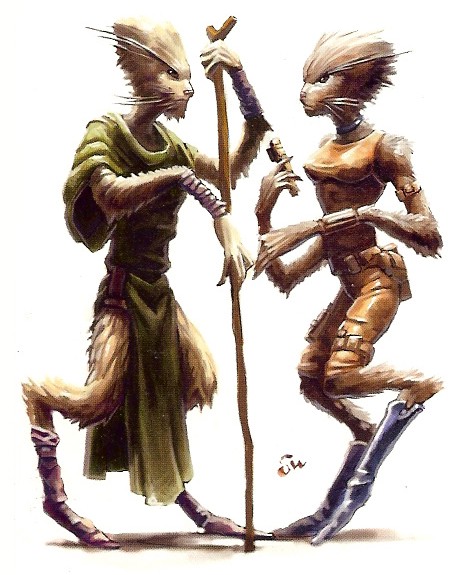 Frozians are mammalian humanoids who originated on the planet Froz. Like the Duros, the Frozians were early supporters of the Rebel Alliance. However, the Moff who governed their sector ruled with a heavy hand, ordering an attack on Froz to discourage insurrection in other systems. Star Destroyers reduced the beautiful low-gravity world of trees and oceans to a nearly lifeless globe.
Frozians are mammalian humanoids who originated on the planet Froz. Like the Duros, the Frozians were early supporters of the Rebel Alliance. However, the Moff who governed their sector ruled with a heavy hand, ordering an attack on Froz to discourage insurrection in other systems. Star Destroyers reduced the beautiful low-gravity world of trees and oceans to a nearly lifeless globe.
Remaining Frozians immediately joined the Alliance and devoted their lives to overthrowing the Empire. However, it soon became apparent that their entire species had been doomed to extinction. Deprived of their homeworld's light gravity and distinctive flora, the Frozians have become infertile. The generation of Frozians to survive the tyranny of the Empire is the last, with the species expected to die out in roughly one hundred standard years (unless scientists can find a way to recreate Froz's unique environment).
What Frozians remain usually have no contact with each other. They have integrated themselves into other societies and are resigned to their fate.
Personality: Frozians are honest and diligent, taking pride in their work. They uphold the virtues and laws of the culture into which they've integrated. They are strong-willed and show genuine concern for those around them, often making extra effort to care run those that they perceive as needy. When not actively engaged in helping themselves or others, Frozians are often depressed and, despite their best intentions, tend to ruin the mood of those around them as well.
Physical Description: Frozians are tall, thin humanoids with multiple joints in their arms and legs. This gives them a curious, loping gait when they walk. Their bodies are covered by short fur that ranges from sandy brown to chestnut. They have large brown eyes that are set on either side of a pronounced muzzle, giving the species excellent peripheral vision. From their muzzles grow thick whiskers that the Frozians twitch in elaborate gestures to emphasize their emotions. Adult Frozians stand 3 meters tall, on average, with males and females having comparable builds.
Homeworld: Froz, a lush world in the Core Worlds region. The Imperial Fleet bombarded the planet and destroyed its ecosystem. Now Frozians have no world to call their own.
Language: Frozians speak and read Frozian. They also tend to speak the predominant language of whatever planet of system they call home.
Example Names: Carlisgontoris, Micamberlecto, Rocatrinicel, Scorylance.
Age In Years: Child 1-8; Young Adult 9-13; Adult 14-40; Middle Age 41-60; Old 61-84; Venerable 85+.
Adventurers: Frozian adventurers are usually nobles, scouts, or tech specialists. Frozian Force adepts and Jedi are also possible.
Frozian Species Traits
- Ability Modifiers: -2 Dexterity, +2 Intelligence, +2 Wisdom
- Size: As Large creatures, they suffer a -1 size penalty on Defense, a -1 size penalty on attack rolls, and a -4 penalty on hide check, and a and a +4 penalty when grapplings. They have a Face/Reach of 2m by 2m/4m. Their lifting and carrying limits are doubled of Medium-sized characters.
- Speed: base speed of 12 meters
- Free Language Skills: Read/Write and Speak Frozian
Gamorrean
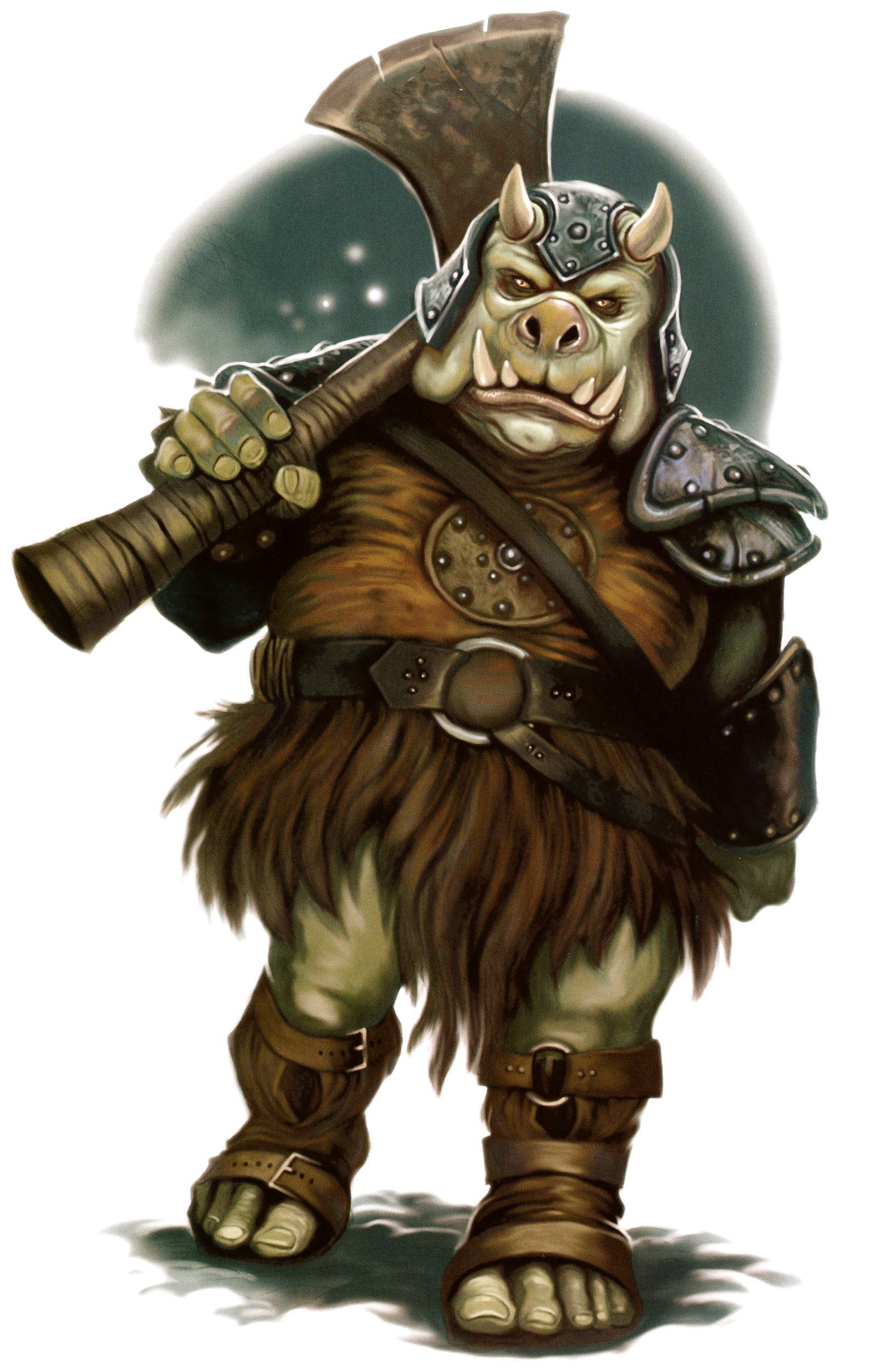 Gamorreans are green-skinned, porcine creatures from the Outer Rim world of Gamorr. Their tendency toward violence has made them valued bodyguards and enforcers for crime lords across the galaxy. Gamorreans are known for their great strength and martial prowess. They prefer to use large melee weapons in combat, often carrying big swords and axes. Most Gamorreans believe ranged weapons of any sort are the tools of cowards.
Gamorreans are green-skinned, porcine creatures from the Outer Rim world of Gamorr. Their tendency toward violence has made them valued bodyguards and enforcers for crime lords across the galaxy. Gamorreans are known for their great strength and martial prowess. They prefer to use large melee weapons in combat, often carrying big swords and axes. Most Gamorreans believe ranged weapons of any sort are the tools of cowards.
Gamorrean civilization is geared toward preparing and carrying out the never-ending wars between their clans. Males on Gamorr devote most of their time to warfare, while the females farm, hunt, weave, and manufacture weapons. The hatred between clans is so strong that even Gamorreans who leave their homeworld—either as slaves or to seek their fortune—carry their clan allegiances with them. Anyone who hires Gamorrean enforcers is wise to inquire about their clan backgrounds first: otherwise, the Gamorreans are likely to spend more time fighting each other than tending their duties.
Gamorreans are generally viewed as mindless brutes with primitive social values. The Gamorreans, however, don't care what others think of them as long as they are paid for their work and afforded plenty of opportunities to bash, hack, and slash.
Personality: Gamorreans are brutish, violent, and proud. They respect physical prowess and have no problem facing death against a worthy foe. They do display fear in the face of obviously superior opponents, considering such a display to be prudent and even rational.
Physical Description: Gamorreans average about 1.8 meters tall, with thick green skin covering powerful muscles. Close-set eyes, a thick snout, tusks, and small horns give them a distinctive look.
Homeworld: The preindustrial agricultural world of Gamorr, located in the Outer Rim.
Language: Gamorreans speak Gamorrean. They have no written version of the language. They can learn to understand other languages, but Gamorreans lack the mechanism to speak any other tongue but their own.
Example Names: Gartogg, Gorge, Greel, Grefnakk, Gundruk, Jubnuk, Krok, Kufbrug, Lugh, Mugshub, Ortugg, Rog, Tarkil Hroka, Tront, Ughok Snorg, Ugmush, Venorra, Voot, Warlug.
Age In Years: Child 1-6; Young Adult 7-12; Adult 13-29; Middle Age 30-39; Old 40-44; Venerable 45+.
Adventurers: Gamorreans leave their homeworld for a variety of reasons. Some are taken as slaves and later escape or buy out their contracts. Others sell their contracts on the open market, finding employment as bodyguards, mercenaries, and professional soldiers. A Gamorrean is constantly at war, no matter where he or she resides in the galaxy; it's often only a matter of figuring out who the enemy is.
Gamorrean heroes tend to select the fringer or soldier classes. To date, there are no known examples of Gamorrean Force-users.
Gamorrean Species Traits
- Ability Modifiers: +2 Strength, -2 Dexterity, -2 Intelligence
- Size: As Medium creatures, they have no special modifiers due to their size.
- Speed: base speed of 10 meters
- Primitive: Gamorrean with heroic or professional classes receive the bonus feats Weapon Group Proficiency (primitive weapons) and Weapon Group Proficiency (simple weapons) instead of the usual Weapon Group Proficiency bonus feats.
- Resilient: Gamorrean gain a +2 species bonus on Fortitude saves.
- Bonus Feat: Gamorrean receive the bonus feat Power Attack (If they meet the feats prerequisite: Strength 13 or higher).
- Free Language Skills: Speak Gamorrean
Gand
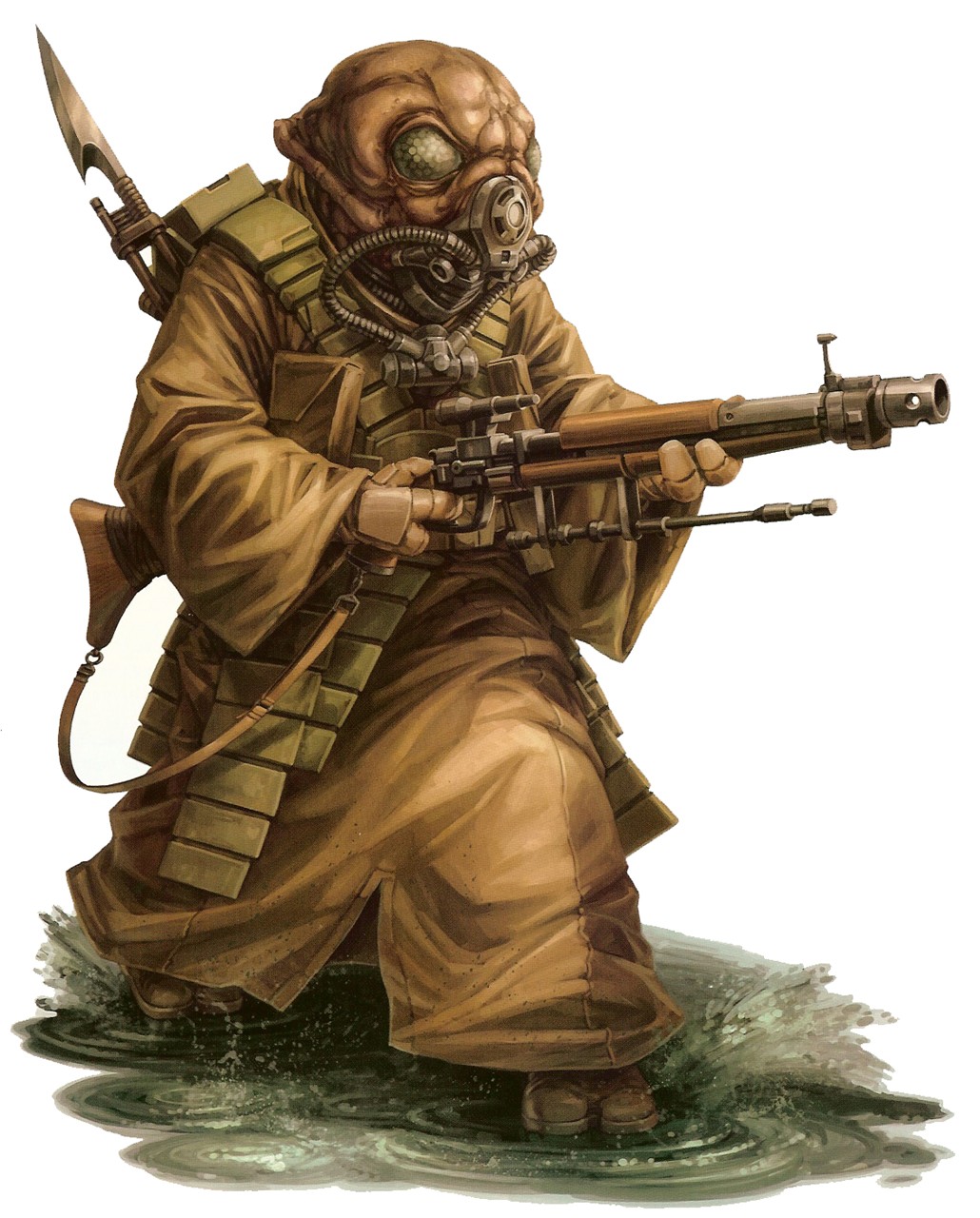 The Gand are stocky, three-fingered humanoids from the Outer Rim world of the same name. Many xenobiologists speculate that the Gand evolved from insects, but the Gand have repeatedly made it clear that they will not allow themselves to be studied.
The Gand are stocky, three-fingered humanoids from the Outer Rim world of the same name. Many xenobiologists speculate that the Gand evolved from insects, but the Gand have repeatedly made it clear that they will not allow themselves to be studied.
Gand culture remains shrouded in mystery to most non-Gand. So far, xenobiologists have identified nearly a dozen different subspecies of Gand living on their ammonia-shrouded world, but it remains unclear how they interact with each other and how the social structure works. It is known that Gand must literally earn a name for themselves; most Gand refer to themselves in third person until they have performed a number of important deeds that relate to their profession. Depending on a Gand's level of self-worth (which he continually redefines in his subconscious), he uses his first name, last name, or simply “Gand.” Only the most accomplished Gand who have completed a special ceremony on their homeworld use personal pronouns such as "I" and "me."
Thanks to their insectoid heritage, most Gand do not breathe like most other species do. They produce gases by ingesting food and expel waste gases through their exoskeletons. When they travel off their homeworld, most Gand wear a breathing apparatus that supplies them with ammonia in specifically regulated amounts.
Personality: Because of the self-deprecating nature of Gand society, where the whole is promoted over the individual, Gand are almost invariably soft-spoken and polite. Even the most accomplished Gand warrior downplays his achievements when discussing them and responds with humility when praised.
Physical Description: The Gand have three fingers on each hand and stand 1.6 meters tall on average. Their bodies are covered by durable exoskeletons that vary in color from green to gray to brown.
Homeworld: The Outer Rim world of Gand, a planet immersed in swirling ammonia clouds.
Language: Gand have their own spoken and written language. Most Gand are incapable of speaking Basic, although a few have appropriate vocal cords and mouths. Most Gand rely on translators of various kinds to be understood.
Example Names: After a Gand does something of merit, he is given a first name. A Gand who is well known among his kind earns a second name that appears before his first. Typical Gand names include: Qoryl Qrygg, R’kayza, Syron Aalun, Ussar Vlee, Venlyss Pnoor, Vviir Wiamdi, Vytor Shrike, Zuckuss, Zukvir.
Age In Years: Child 1-10; Young Adult 11-15; Adult 16-45; Middle Age 46-79; Old 80-94; Venerable 95+.
Adventurers: Gand adventurers tend to be scoundrels, soldiers, bounty hunters, and findsman. All Gand findsmen have at least one level in the findsman prestige class (see Chapter Two: Prestige Classes).
Gand Species Traits
- Ability Modifiers: +2 Wisdom, -2 Charisma
- Size: As Medium creatures, they have no special modifiers due to their size.
- Speed: base speed of 10 meters
- Darkvision: Gand can see in the dark up to 20 meters. Darkvision is black and white only but otherwise functions as normal sight.
- Natural Armor: Gand receive a +2 natural armor bonus to Defense.
- Free Language Skills: Read/Write and Speak Gand
Geonosian
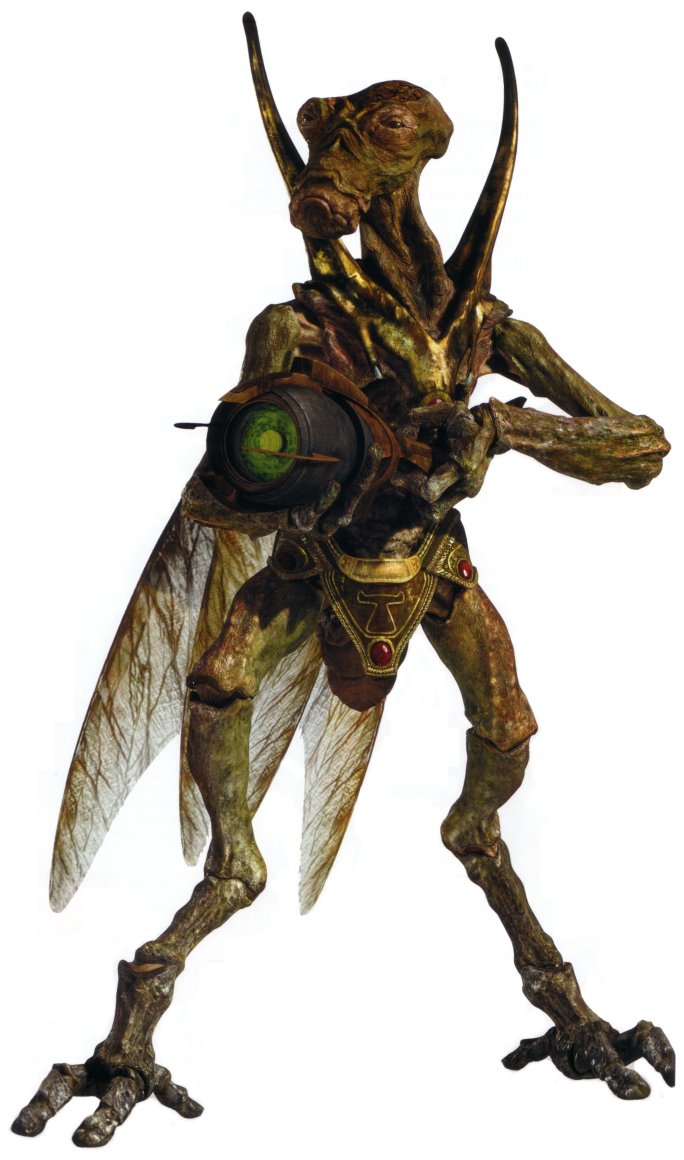 The Geonosians are a caste-dominated species from the world of Geonosis, in the system of the same name. They dwell in a spectacular architectural realm carved from the soaring, rocky spires that clot the planet's landscape. They are somewhat resistant to the radiation that occasionally showers their world, though Geonosians actually live underground to escape that phenomenon.
The Geonosians are a caste-dominated species from the world of Geonosis, in the system of the same name. They dwell in a spectacular architectural realm carved from the soaring, rocky spires that clot the planet's landscape. They are somewhat resistant to the radiation that occasionally showers their world, though Geonosians actually live underground to escape that phenomenon.
Geonosians are born into specific castes divided along the lines of their physical attributes, and though most Geonosians are content to remain within their caste until they die, some develop ambition. The life of a low-ranking Geonosian worker is ordinarily one of ongoing toil, labouring to fulfil the whims of a Geonosian aristocracy that sometimes makes spectacular demands. The society allows Geonosians from lower castes to escape from the drudgery through gladiatorial combat.
Geonosians relish battle and public executions. Anyone the Geonosians capture is sent to the arena, to provide amusement for the masses. There, the hapless individual either faces some savage beast or fights to the death against another sentient being. A Geonosian from a low caste who volunteers for these battles can, if he survives, achieve some measure of status by distinguishing himself in the arena—if only in the form of fame, fortune, and the right to be recognized by aristocrats (though still not treated quite as an equal). Most who survive long enough to amass any amount of real wealth or prestige use it to buy their way off Geonosis, never to return.
Despite their proximity to the Corellian Run trade route, Geonosians receive few visitors. They might get none at all if their droid factories weren't among the finest and most productive in the galaxy.
Personality: Geonosians tend to be contemptuous of other species, although the lucky few who escape the toil or their caste-driven society quickly learn to be more tolerant. Geonosian aristocrats are manipulative, domineering, and ambitious. They constantly strive to improve their standing and holdings while conspiring to eliminate or ruin their rivals. Geonosian warriors are highly competitive and eager to prow themselves.
Physical Description: Geonosians come in two varieties: aristocrats (leaders) and warriors (drones). Both varieties are physically strong and covered with bony ridges that protect arms, legs, and vital organs. They walk on two legs, and most Geonosians have rapidly fluttering wings sprouting from their bony shoulder blades. They stand 1.6 to 1.8 meters tall.
Homeworld: Geonosis, a rocky world in the Outer Rim that is periodically bombarded by radiation showers. Geonosis has its own asteroid ring, believed to be the remains of two collided moons.
Language: Geonosians speak and read Geonosian.
Example Names: Deetle, Eorlax, Hadiss, Krylla, Lysslo, Mazzag, Poggle, Qorn, Sollas, Vikkal.
Age In Years: Child 1-6; Young Adult 7-10; Adult 11-35; Middle Age 36-50; Old 51-64; Venerable 65+.
Adventurers: Due to their reluctance to leave their hives, Geonosians are rarely encountered away from their homeworld. A few manage to buy their way offworld. Some Geonosian aristocrats pursue offworld adventure as fingers or nobles, while free warriors might become fringers, soldiers, or tech specialists. No Geonosian Force-users are known to exist.
Geonosian Species Traits
- Aristocrat-Ability Modifiers: +2 Dexterity, -2 Constitution.
- Warrior Ability Modifiers: +2 Strength, -2 Intelligence, -2 Charisma.
- Size: As Medium creatures, they have no special modifiers due to their size.
- Speed: Base speed is 10 meters. Geonosians with wings also have a fly speed of 16 meters (poor maneuverability).
- Low-Light Vision: Geonosian can see twice as far as normal in dim light, and retain the ability to distinguish color and detail under these conditions.
- Natural Armor: A Geonosian has bony ridges. Geonosian receive a +2 natural armor bonus to Defense.
- Radiation Resistance: Geonosian receive a +2 species bonus on Fortitude saves against radiation.
- Exotic Weapon Proficiency: (Geonosian warriors) Geonosian with professional or heroic levels receive the bonus feat Exotic Weapon Proficiency(electrostaff) or Exotic Weapon Proficiency (sonic staff).
- Skill Bonus: Geonosian receive a +2 species bonus on all Craft checks.
- Free Language Skills: Read/Write and Speak Geonosian
Givin
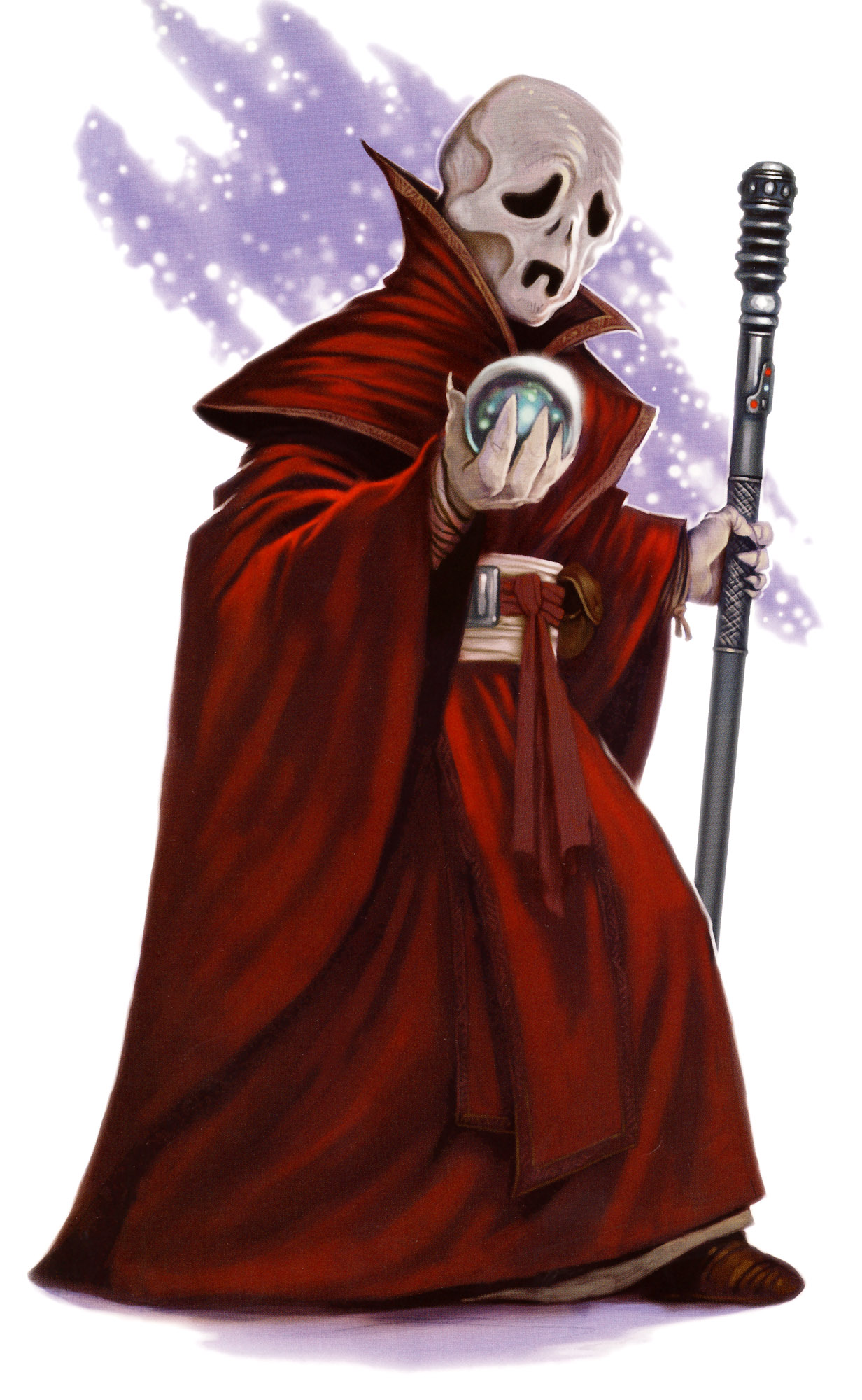 The Givin are humanoid aliens with extremely durable exoskeletons and ghastly visages. They evolved their exoskeletal structure in response to their homeworld's frequent environmental shifts, which regularly leave vast portions of the planet without atmosphere.
The Givin are humanoid aliens with extremely durable exoskeletons and ghastly visages. They evolved their exoskeletal structure in response to their homeworld's frequent environmental shifts, which regularly leave vast portions of the planet without atmosphere.
Givin society fixates on mathematics. Every Givin child receives extensive schooling on the subject, in preparation for competitions to enter monastic life. Givin monasteries devote themselves to unravelling the meaning of life via complex equations, and every young Givin dreams of being the one who solves the final formula. This devotion to numbers makes Givin particularly useful aboard starships, where they can calculate hyperspace vectors mow quickly than most navigation computers. Givin ships use computes only for data storage; the Givin always calculate their hyperspace jumps in their heads.
Givin make excellent shipwrights because of their precise mathematical thought processes. The shipyards of their homeworld compete with those of the Duros and the Verpine—the only other species for whom the Givin have any respect. Conversely, the skeletal features of the Givin combined with their tendency to express ideas as mathematical formulae make them somewhat unpopular with other species.
Personality: As a species, the Givin keep to themselves and rarely take interest in other species. To outsiders, they seem sombre and withdrawn. However, when confronted with an intriguing mathematical puzzle or equation. Givin become more animated as they struggle to contain their elation.
The Givin hold most "soft" species in a mixture of contempt and pity, due to their inability to survive in space unaided.
Physical Description: The Givin look like animated humanoid skeletons and average 1.8 meters tall. Their appendages are long, thin, and tubular, and they have large triangular eye sockets and frowning mouths. Their exoskeletons act as organic vacuum suits and are composed of impermeable bone plates connected by flexible membranes.
Homeworld: Yag'Dhul, a small and dense planet located in the Inner Rim. The planet is continually beset by massive tidal forces powerful enough to pull the water and the atmosphere to different locations, exposing large areas of the planet to hard vacuum. The Givin inhabit hermetically sealed cities built to withstand the incredible tidal forces.
Language: Givin have their own language, the written form of which incorporates several hundred mathematical symbols.
Example Names: Chrag’mak’al, Elis Helrot, Lersia Marth, Na-Soth Larr, Nisil Alarin, Sladru Nalas.
Age In Years: Child 1-10; Young Adult 11-14; Adult 15-48; Middle Age 49-64; Old 65-79; Venerable 80+.
Adventurers: Givin adventurers tend to be scouts and tech specialists.
Givin Species Traits
- Ability Modifiers: -2 Strength, +2 Constitution, +2 Intelligence, -2 Wisdom, -2 Charisma
- Size: As Medium creatures, they have no special modifiers due to their size.
- Speed: base speed of 10 meters
- Damage Reduction: Givin's exoskeleton acts as a suit of armor. A Givin receive DR 2. This ability stacks with DR values provided by manufactured armor.
- Mathematical Mind: The Givin are trained from early development to understand and pursue complex mathematics. Givin receive a +4 species bonus on skill checks involving mathematics, such as Astrogate, Knowledge (business), Knowledge (engineering), or Knowledge (physics).
- Natural Armor: Givin have resilient exoskeletons. Givin receive a +2 natural armor bonus to Defense.
- Unique Physiology: Givin have no external organs. Givin do not breathe in any conventional sense and are immune to the effects of inhaled chemicals and poisons. This also lets them operate in a vacuum without a vacuum suit or oxygen supply.
- Free Language Skills: Read/Write and Speak Givin.
Gossam
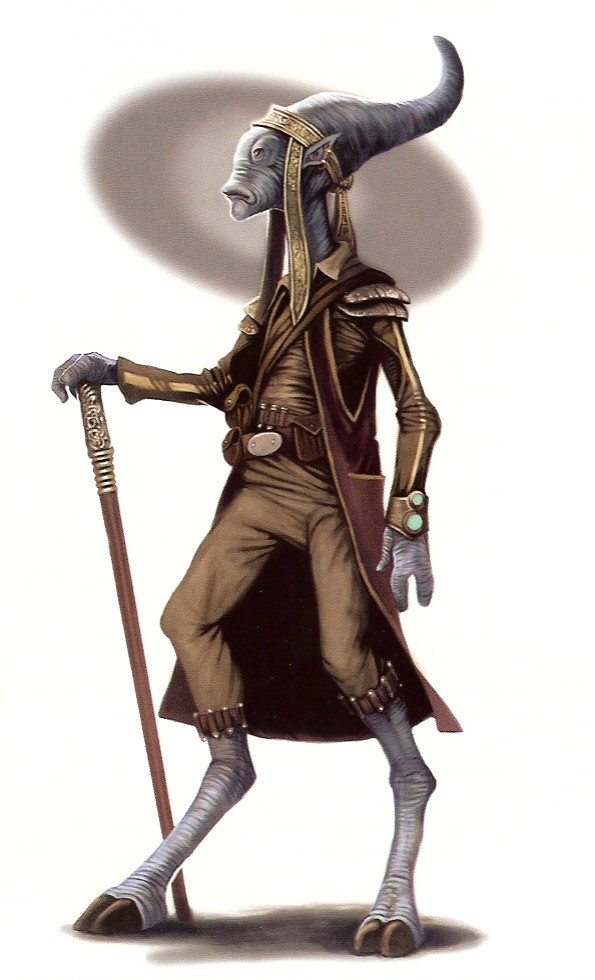 Gossam are diminutive reptilian humanoids known for their shrewd and cunning nature. Few Gossam on their homeworld own property and instead serve as indentured servants to the Commerce Guild. Most Gossam find this a dreary reality, rarely complaining out loud for fear of losing the roofs Over their heads.
Gossam are diminutive reptilian humanoids known for their shrewd and cunning nature. Few Gossam on their homeworld own property and instead serve as indentured servants to the Commerce Guild. Most Gossam find this a dreary reality, rarely complaining out loud for fear of losing the roofs Over their heads.
For ten years after the Battle of Naboo, the Gossam homeworld of Castell suffered a great depression due to the heavy taxation of trade routes. This resulted in lowered profits and little demand for CasteIlan goods. Gossam were at each other's throats over food, jobs, and passage offworld until the Commerce Guild finally appointed a Gossam as its president. President Shu Mai is credited with lifting Castell out of its depression through her aggressive business practices, her support of the Gossam workforce, and her taciturn negotiation tactics.
Personality: Gossam are selfish, scheming beings allied at the art of business. Their goods are usually cheap to manufacture and overpriced. They are always looking for an angle they can play to come out ahead. A Gossam's word means precious little in most other beings' opinions.
Physical Description: A Gossam stands roughly 1.25 meters tall and has pebbly green skin, large yellow eyes, an elongated neck, and a tapered head. In addition to exotic robes and finery. Gossam aristocrats and trade negotiators often wear elevated footwear to appear taller during meetings with other species.
Homeworld: Castell is an industrial world located on the edge of the Colonies region, near the Core Worlds region. The planet is central to the Commerce Guild's manufacturing operations.
Language: Gossam speak a language of the same name. It consists of lispy vocalizations, croaks, and trills. Written Gossam has a jagged alphabet that combines into short words and long sentences. Most Gossam also speak Basic.
Example Names: Min Cho, Xiri Gan, Zim Li, Shu Mai, Shan Sien Mei Tran.
Age In Years: Child 1-9; Young Adult 10-13; Adult 14-44; Middle Age 45-62; Old 63-74; Venerable 75+.
Adventurers: Most Gossam traveling the galaxy are either legitimate merchants or shady smugglers. Gossam pirates are also common. Due to their small stature, Gossam are frequently underestimated. Most tramp freighter captains pay little heed to reports of Gossam piracy—that is, until they have a Gossam pirate's blaster pistol shoved in their face.
Gossam heroes are typically nobles, scoundrels, or tech specialists. Force-users among the species are exceedingly rate.
Gossam Species Traits
- Ability Modifiers: -2 Strength, +2 Dexterity, -2 Constitution, +2 Wisdom, +2 Charisma
- Size: As Small creatures, they gain a +1 size bonus to their Defense, a +1 size bonus on attack rolls, and a +4 size bonus on Hide checks, and a –4 penalty when grappling. They must use smaller weapons than Medium-size beings use, and their lifting and carrying limits are three-quarters those of Medium-size characters.
- Speed: base speed of 6 meters
- Skill Bonus: Gossam receive a +4 species bonus on Diplomacy checks when haggling over price.
- Free Language Skills: Read/Write and Speak Gossam
Gotal
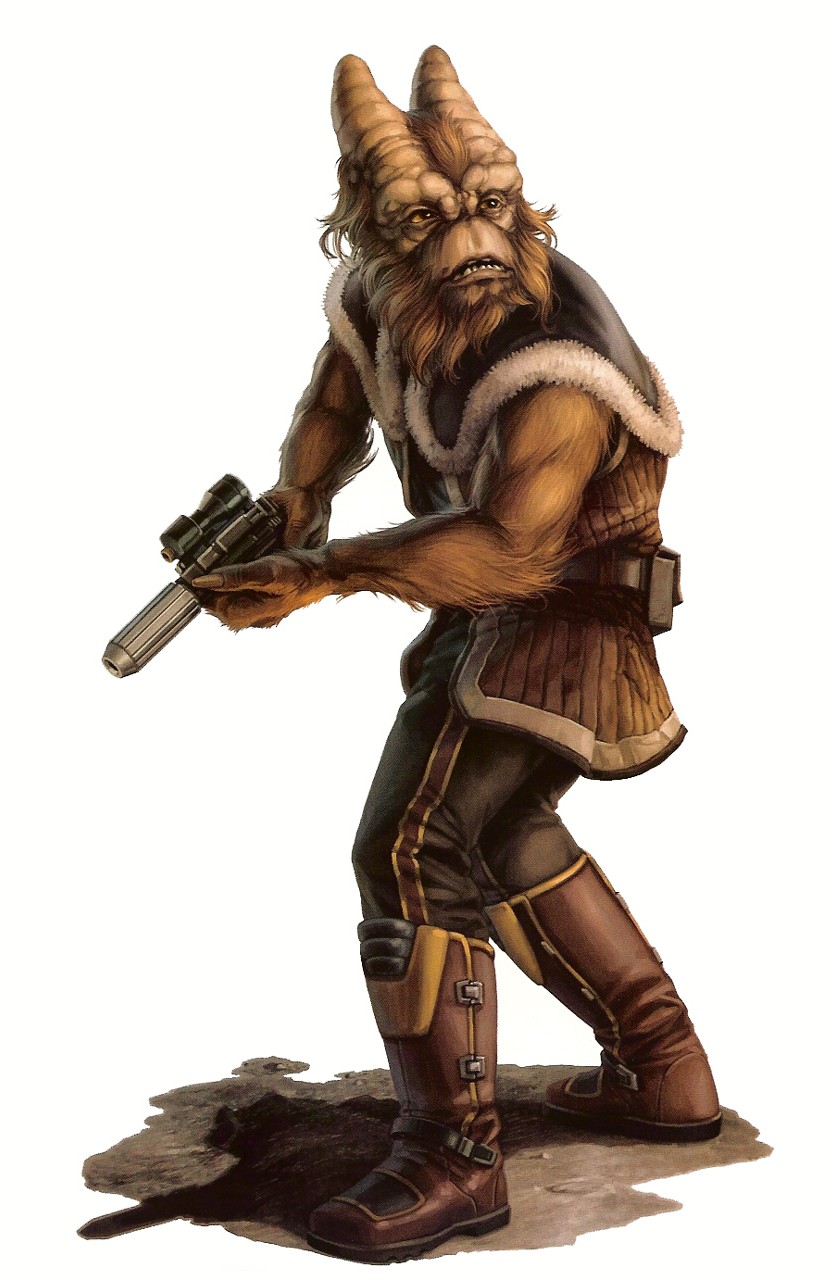 Gotals are mammalian humanoids noted for the “cones” on their heads that allow them to detect changes in magnetic fields, infrared emanations, neutrino waves, biokinetic emissions, radio waves, and virtually every other form of electromagnetic emission. A number of Jedi scholars believe a properly trained Gotal may even be able to detect the Force, but research by Jedi (during the days of the Old Republic) and the Empire (during the early days of the Jedi Purge) has proved inconclusive. The Gotals themselves are likewise split on this question, and so far there are no records of a Gotal being able to consistently detect the Force. However, Gotals can use their abilities to determine the mood, health, and general well being of others by sensing their electromagnetic auras. Gotals make excellent interrogators.
Gotals are mammalian humanoids noted for the “cones” on their heads that allow them to detect changes in magnetic fields, infrared emanations, neutrino waves, biokinetic emissions, radio waves, and virtually every other form of electromagnetic emission. A number of Jedi scholars believe a properly trained Gotal may even be able to detect the Force, but research by Jedi (during the days of the Old Republic) and the Empire (during the early days of the Jedi Purge) has proved inconclusive. The Gotals themselves are likewise split on this question, and so far there are no records of a Gotal being able to consistently detect the Force. However, Gotals can use their abilities to determine the mood, health, and general well being of others by sensing their electromagnetic auras. Gotals make excellent interrogators.
Other races often perceive the Gotals as beings without emotion, but this is not true. They experience deep feelings of love and hatred, and love at first sight among Gotals is common. Gotal couples conceive offspring almost immediately after their union, and their sensitivity to emotions makes them excellent mates and parents. Gotal children arc short-tempered and unruly until they reach roughly 12 standard years of age, when they are finally able to filter the energy waves detected by their cones. Their patient and gentle parents eventually teach them how to deal with the world around them.
Gotal society is equal in technological level to the galactic norm, and they swiftly implement advances when they encounter them. However, Gotals dislike droids and try to avoid them whenever possible; the electromagnetic radiation that the power cells of most droids produce interferes with the Gotals' cones, giving them headaches if they spend too much time near droids.
Personality: Because Gotals can read other beings so well, they are extremely polite and try to remain sensitive to the feelings of others. They rarely express negative opinions about other beings and keep their own emotions to themselves. In fact, the Gotal language does not have words to express emotions because their cones emanate a Gotal's emotional disposition. They only speak aloud to convey complicated or abstract ideas, never to express emotion.
Physical Description: Gotal skin color ranges from gray-brown to black. Their red-tinted eyes adjust quickly to changing light conditions, from extreme brightness to near-total darkness. Their primary sensory organs, however, are two cone-shaped protuberances on the tops of their heads.
Their flattened noses protrude roughly a centimetre from their faces, and their broad mouths contain sharp incisors. Shaggy gray fur covers their bodies. They display the standard sexual characteristics that exist between male and female mammals, although there are no other noteworthy differences in the builds between males and females of the species. Adult Gotals stand between 1.8 and 2.1 meters tall.
Homeworld: Antar 4, a moon orbiting the gas giant Antar in the Inner Rim system of Prindaar. Due to peculiarities in its orbit and its highly reflective mineral deposits, Antar 4 is bathed in light so intense it can burn out the ocular nerves of most species during the daylight cycles. During the night, the shadow cast by Antar is so deep that darkness is total. For this reason, most species on Antar 4 rely heavily on senses other than sight.
Language: Gotals speak and read Gotal. Most Gotals also learn to speak Basic.
Example Names: Abav Ghart, Feltipern Trevaag, Glott, Kith Kark, Lishma, Mahk’khar, Mnor Nha, Pari Notgoth, Sarlim Gastess, Tolokai, To-yel, Tuuve.
Age In Years: Child 1-9; Young Adult 10-12; Adult 13-40; Middle Age 41-60; Old 61-75; Venerable 76+.
Adventurers: Gotal adventurers tend to be nobles, scouts, or soldiers. Their unique abilities make them exceptional bodyguards, interrogators, counselors, or ambassadorial delegates.
Gotal Species Traits
- Ability Modifiers: None
- Size: As Medium creatures, they have no special modifiers due to their size.
- Speed: base speed of 10 meters
- Energy Reading: Gotals can read the emotions of any sentient being they focus on within a 10-metes radius, giving them a +3 species bonus on Bluff, Diplomacy, Intimidate, and Sense Motive checks when interacting with an individual in range. Gotals who possess the Track feat can use their head cones to locate members of a specific species, or beings whom they have met before, within 10 kilometres of their location.
- Low-Light Vision: Gotal can see twice as far as normal in dim light, and retain the ability to distinguish color and detail under these conditions.
- Uncanny Dodge: A Gotal retains his or her Dexterity bonus (if any) to Defense regardless of being caught flat-footed or struck by a hidden attacker.
- Free Language Skills: Read/Write and Speak Gotal
Gran
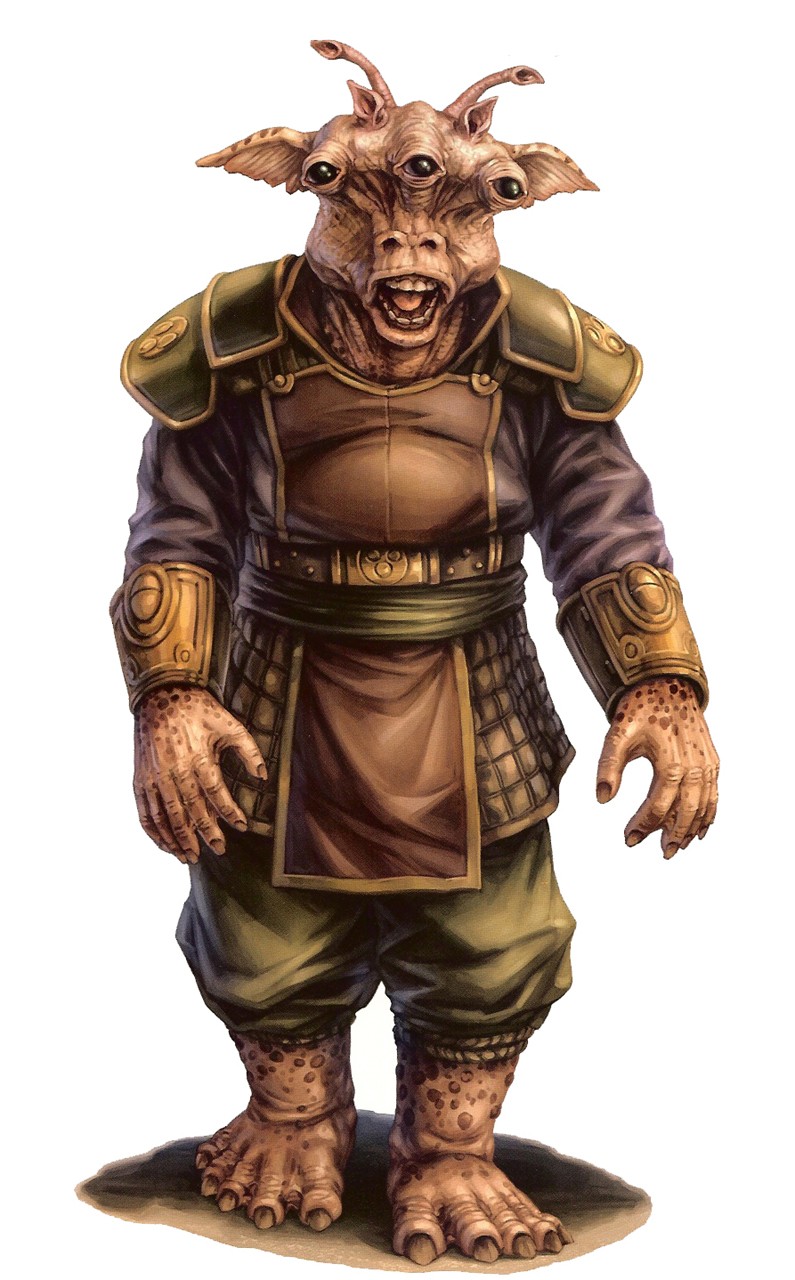 The Gran originated on the world of Kinyen. located in the star system of the same name. They have been part of galactic society for ages and have established colonies on countless worlds. Shortly after forming a colony on Malastare, the otherwise peaceful Gran became embroiled in a long and bloody conflict with that world's native population of Dugs, who resented the Gran intrusion.
The Gran originated on the world of Kinyen. located in the star system of the same name. They have been part of galactic society for ages and have established colonies on countless worlds. Shortly after forming a colony on Malastare, the otherwise peaceful Gran became embroiled in a long and bloody conflict with that world's native population of Dugs, who resented the Gran intrusion.
Despite their social nature, the Gran leadership on Kinyen used to bar non-Gran from venturing beyond specifically constructed “alien quarters” in that world's cities, in part because they feared potential conflict with other species (as happened on Malastare). As the Emperor's New Order rose to power, the Imperial government demanded access to all parts of Kinyen, and when the Gran refused to grant it, Kinyen was subjected to orbital bombardment. While the Gran leaders bowed to the superior might of the Emperor, many Gran left Kinyen and secretly joined the Rebel Alliance. Gran rebels served as transport pilots or medics, avoiding violence whenever possible.
Personality: Most Gran are friendly, agreeable, and talkative beings who respect diversity. They are slow to anger and enjoy the company of others (particularly other Gran). Their friendships survive until death. Few Gran can tolerate solitude for any length of time, and many become uncomfortable outside the company of other Gran.
Physical Description: The Gran are tan-skinned humanoids with pitch-black eyes mounted on three eyestalks and small horns that rise from the back of their heads. Adults stand between 1.5 and 1.8 meters tall. Male and female Gran have similar builds.
Homeworld: kinyen, a planet in the Expansion Region. After the Imperial Fleet bombards the planet, many Gran move to colonies on other worlds such as Malastare.
Language: Gran speak and read Gran. Gran can also learn to speak Basic with ease.
Example Names: Ainlee Teem, Aks Moe, Ask Aak, Baskol Yaersim, Cera Vixe, Cruegar, Kea Ra-Lan, Nadin Paal, Ree-Yees, Vee Naaq.
Age In Years: Child 1-10; Young Adult 11-15; Adult 16-40; Middle Age 41-62; Old 63-79; Venerable 80+.
Adventurers: Gran heroes tend to be nobles, scoundrels, scouts, and bounty hunters. Before the rise of the Empire, Gran Jedi consulars were common, and some might have survived the Jedi Purge.
Gran Species Traits
- Ability Modifiers: -2 Wisdom, +2 Charisma
- Size: As Medium creatures, they have no special modifiers due to their size.
- Speed: base speed of 10 meters
- Darkvision: Gran can see in the dark up to 20 meters. Darkvision is black and white only but otherwise functions as normal sight.
- Low-Light Vision: Gran can see twice as far as normal in dim light, and retain the ability to distinguish color and detail under these conditions.
- Bonus Feat: Gran receive the bonus feat Sharp-Eyed.
- Free Language Skills: Read/Write and Speak Gran
Gungan
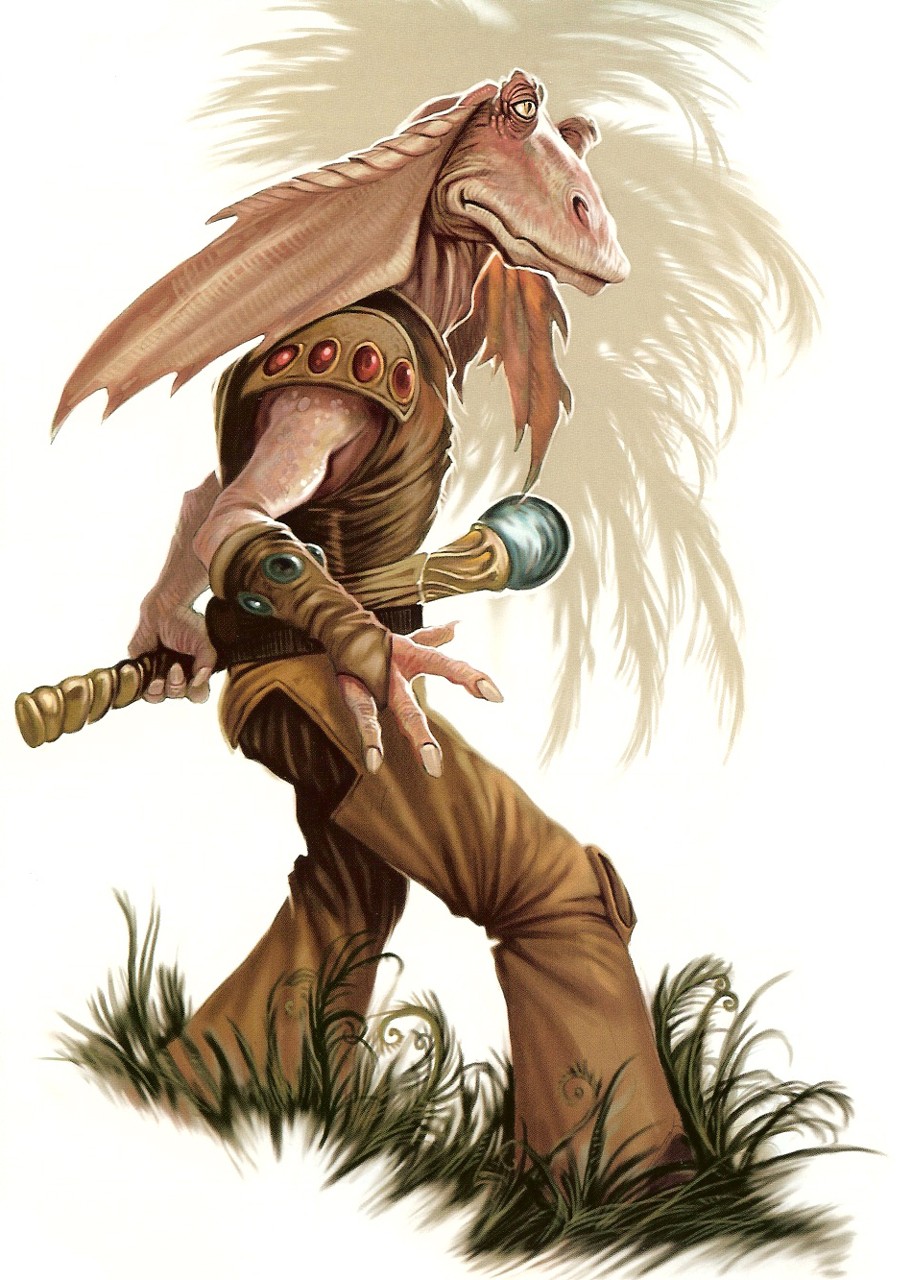 The Gungans are omnivorous humanoids native to the swamps of the Outer Rim world of Naboo. Centuries ago, they all but abandoned life on the surface of the world. They now live at the bottom of deep lakes and in the ocean. Gungans are technologically advanced, relying mostly on forms of biotech that allow them to not so much build their homes and production facilities as grow them. They take great cultural pride in coexisting with nature, manufacturing as much as possible from the natural resources of their underwater habitat while taking great strides to create items that blend with it.
The Gungans are omnivorous humanoids native to the swamps of the Outer Rim world of Naboo. Centuries ago, they all but abandoned life on the surface of the world. They now live at the bottom of deep lakes and in the ocean. Gungans are technologically advanced, relying mostly on forms of biotech that allow them to not so much build their homes and production facilities as grow them. They take great cultural pride in coexisting with nature, manufacturing as much as possible from the natural resources of their underwater habitat while taking great strides to create items that blend with it.
While the Gungan culture is peaceful, it evolved from a series of long, bloody clan wars. The arrival of Human settlers on Naboo forced them to unite. Elements of the warrior culture remain, and Gungans still admire strength and cunning. Most Gungan communities are devoted to fanning or manufacturing goods that are then traded to other Gungan settlements. They also reluctantly trade with the Humans of Naboo, though they keep contact to a minimum.
When the Trade Federation invaded Naboo, the Gungans mounted noteworthy resistance on the planetary surface. The conflict gave them respect for the other citizens of known space, inspiring them to join the rest of the galaxy. In the decades before the Empire was declared, the Gungans began to develop space travel.
Personality: Gungans tend to be inquisitive, cautious, and suspicious. They resist all forms of oppression and have little patience for troublemakers.
Physical Description: Gungans are lanky amphibious humanoids ranging from 1.6 to 2 meters tall, with two eyestalks, floppy ears, a bill-like mouth, and long tongues, When they are swimming, their nostrils seal, nictitating membranes cover their eyes, and their eyestalks partially retract into their skulls.
Homeworld: The beautiful Outer Rim world of Naboo (with colonies on the Ohma-D’un moon).
Language: Gungans speak and read Gunganese, a dialect of Basic interspersed with peculiar native phrases and speech patterns.
Example Names: Fassa, Jar Jar, Rugor, Pinknab Carsles, Tarpals, Teers Toba, Tobler Ceel, Yoss.
Age In Years: Child 1-12; Young Adult 13-15; Adult 16-35; Middle Age 36-54; Old 55-64; Venerable 65+.
Adventurers: Gungan adventurers have a strong warrior tradition, making them prized mercenaries and security guards. Many leave the underwater cities to explore the ancient swamps and shorelines of Naboo. Since the treaty with the Humans on Naboo, some Gungans have taken a larger step into galactic society. These brave individuals are driven by an impulse to explore and regain the warrior spirit of old. There are no examples of Gungan Jedi as yet, though legends of Force adepts among the Gungans do exist.
Gungan Species Traits
- Ability Modifiers: +2 Constitution, -2 Wisdom
- Size: As Medium creatures, they have no special modifiers due to their size.
- Speed: Base speed is 10 meters whether they are travelling on land or swimming.
- Extraordinary Reflexes: Gungans receive a +1 species bonus on Reflex saves.
- Hold Breath: A Gungan can hold their breath for a number of rounds equal to 25 times their Constitution score before he needs to make checks against drowning. Gungans also receive a +4 species bonus on Swim checks.
- Low-Light Vision: Gungan can see twice as far as normal in dim light, and retain the ability to distinguish color and detail under these conditions.
- Skill Bonus: Gungans have extraordinary hearing. Gungan receive a +2 species bonus on Listen checks.
- Free Language Skills: Read/Write and Speak Basic and Gunganese
H'nemthe
 H'nemthe are a deeply passionate and spiritual people. Male H’nemthe comprise 95% of the species' population; whether this is due to a species-wide genetic defect is unknown. After a H'nemthe couple conceive, the female eviscerates the male with her razor-sharp tongue.
H'nemthe are a deeply passionate and spiritual people. Male H’nemthe comprise 95% of the species' population; whether this is due to a species-wide genetic defect is unknown. After a H'nemthe couple conceive, the female eviscerates the male with her razor-sharp tongue.
Because their head cones can be used to detect heat differences in their environment and emotional differences in other creatures, H'nemthe are efficient hunters.
Personality: H'nemthe males are timid beings who spend most of their adult lives searching for true love. They also believe that death is an important part of life, and that one's own death paves the way for future generations. H'nemthe females lead a sheltered life until they begin to mate, and consequently they tend to be naive about matters outside the home.
Physical Description: A H'nemthe has blue-gray skin, a double set of cheekbones, a gently curved nose, three fingers on each hand, and a head crowned with four short cones. The average adult stands about 1.7 meters tall. The majority of H'nemthe encountered are male.
Homeworld: H’nemthe, an Outer Rim world with three moons. The moons' collective gravitational force creates unsettled weather conditions across the entire planet. Scientists believe that the H'nemthe evolved their heat-sensing cones to help them forage for food in the inclement weather.
Language: H’nemthe speak a language comprised primarily of squeaks, squeals, and other noises that other sentients find irritating. The written form of H’nemthe uses a wispy, contiguous line to make letters that string together to form words.
Example Names: Garriel, H’rassh, Liakkor, S’basso, Vir’roc, Vishki.
Age In Years: Child 1-6; Young Adult 7-10; Adult 11-44; Middle Age 45-59; Old 60-84; Venerable 85+.
Adventurers: H'nemthe males seldom seek glory or adventure, but if they are repeatedly rejected as mates, they may roam the galaxy instead of taking their own lives. H’nemthe heroes are typically male and can belong to any class, although fringers and tech specialists are the most common.
H'nemthe Species Traits
- Ability Modifiers: +2 Dexterity, -2 Wisdom, -2 Charisma
- Size: As Medium creatures, they have no special modifiers due to their size.
- Speed: base speed of 10 meters
- Natural Weapons (Tongue): (females only) H’nemthe females have razor-edged tongues. The tongue deals 1d6 points of slashing damage (plus Strength modifier) and threatens a critical hit on a 19-20. The tongue attack does not provoke attacks of opportunity.
- Skill Bonus: H’nemthe have keen senses. H'nemthe receive a +2 species bonus on Search and Spot checks and a +2 species bonus on Diplomacy and Sense Motive checks made against warm-blooded sentients within 20 meters.
- Free Language Skills: Read/Write and Speak H'nemthe
Herglic
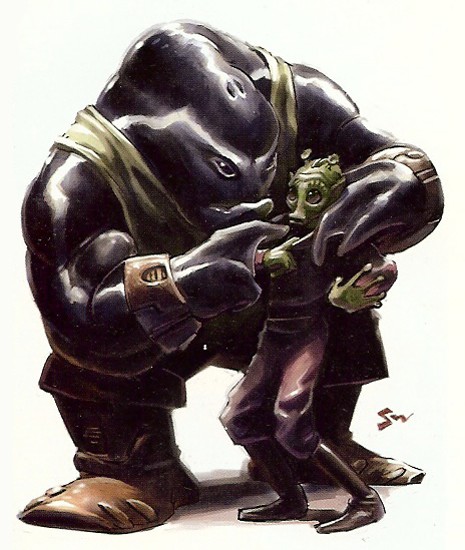 Herglics are massive humanoids believed to have evolved from water-dwelling mammals. Most evidence of an aquatic origin has long since been eliminated by evolution—fins, for example, have been replaced by arms.
Herglics are massive humanoids believed to have evolved from water-dwelling mammals. Most evidence of an aquatic origin has long since been eliminated by evolution—fins, for example, have been replaced by arms.
Herglics were among the founding species of the Old Republic. They developed space travel without contact with other species and were masters of an interstellar trade empire even as Cordials and Duros were taking their first steps to explore the galaxy around them. The Herglic empire collapsed for reasons that remain lost to history. In fact, they only inhabited a few systems along the Rimina Trade Route when the Duros first encountered them. Contact with other species reenergized their inquisitive natures, and until the rise of the Empire, blocky Herglic freighters were common sights along the trade routes.
Unfortunately for the Herglics, their homeworld was one of the first planets to suffer under the Emperor's New Order. When the Empire took over all spaceports and manufacturing centres on the planet, the otherwise peaceful Herglics launched an armed resistance, but the slaughter that followed convinced them to submit completely to the Empire's will.
Herglics are common sights on most technologically advanced worlds, primarily in spaceports and recreation centres and entertainment resorts. They are particularly common sights in casinos and at racetracks, placing bets and losing credits with wild abandon. Herglic settlements exist near virtually every spaceport throughout the Colonies and Expansion Region, and these communities frequently mirror the dominant cultures around them. Herglics tend to cluster in their own communities because they need to build everything slightly larger in scale to accommodate their large bodies.
Personality: Peaceful and easygoing, Herglics enjoy meeting new people and visiting exotic locales. They also love of all sorts of games of chance, and a Herglic who can pass by an opportunity to gamble is a strong-willed Herglic indeed.
Many Herglics are somewhat sensitive about their size. They feel awkward when they must take up two seats in restaurants and on transports, and they feel embarrassed by the way they have to negotiate their way through doorways while others can simply walk through.
Physical Description: Herglic adults stand between 1.7 and 2.2 meters tall. They have extremely wide, muscular bodies, with smooth, hairless skin that ranges in colour from pale blue to black. A few Herglics also display white stripes that run down the sides of their head and arms. They breathe through a blowhole at the top of their heads.
Homeworld: Giju, a world of islands, oceans, marshes, and glaciers located in the Colonies region.
Language: Herglics speak and read Herglese. Most Herglics also learn to speak Basic.
Example Names: Johzan B’oh, Udo Broxin, Doune, Elbor Cruhn, Fahjani Tohvar, Kaylo Nakuda, Kehlor M’ah, Lucrosh P’ohmahc, Raazor S’ovah, Sehvorah.
Age In Years: Child 1-15; Young Adult 16-19; Adult 20-55; Middle Age 56-79; Old 80-95; Venerable 96+.
Adventurers: Adventuring Herglics are typically nobles, scoundrels, scouts, and tech specialists. Before the rise of the Empire, a few Herglics also, became Jedi.
Herglic Species Traits
- Ability Modifiers: +4 Strength, -2 Dexterity, +2 Constitution, -2 Intelligence, -4 Wisdom
- Size: As Large creatures, they suffer a -1 size penalty on Defense, a -1 size penalty on attack rolls, and a -4 penalty on hide check, and a and a +4 penalty when grapplings. They have a Face/Reach of 2m by 2m/4m. Their lifting and carrying limits are doubled of Medium-sized characters.
- Speed: base speed of 8 meters
- Gambling Addiction: When exposed to a game of chance, a Herglic must succeed at a Will save (DC 15) to resist the urge to play. GMs is can apply a circumstance modifier to the save, as appropriate. For example, a Herglic who blunders into a casino while fleeing a bounty hunter might receive a circumstance bonus on his save. A Herglic vacationing on Cloud City with nothing more important to do that to meet other characters for lunch might suffer a —2 circumstance penalty.
- Natural Armor: Herglic have tough hides. Herglic receive a +2 natural armor bonus to Defense.
- Free Language Skills: Read/Write and Speak Herglese
Ho'Din
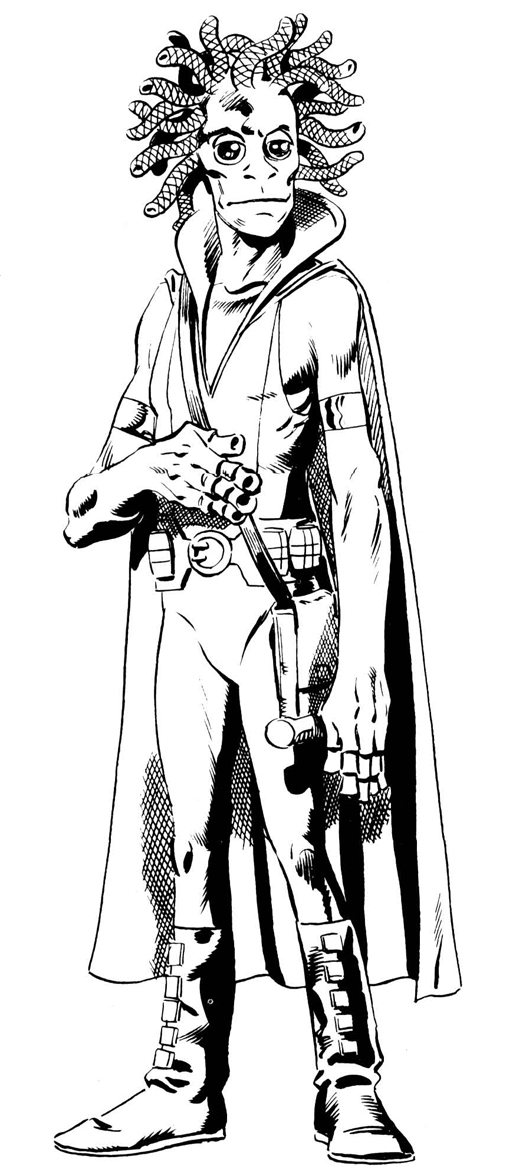 Ho’Din means “walking flower” in the native language of this gentle species. Although Ho'Din religion claims that the species descended from plant life, the Ho'Din actually evolved from reptiles. Nevertheless, Ho'Din are taught to believe that those who strive to preserve nature in life will be reborn as plants after death.
Ho’Din means “walking flower” in the native language of this gentle species. Although Ho'Din religion claims that the species descended from plant life, the Ho'Din actually evolved from reptiles. Nevertheless, Ho'Din are taught to believe that those who strive to preserve nature in life will be reborn as plants after death.
Three hundred years before the Battle-of Yavin, the Ho'Din entered an industrial age, clearing entire forests to make room for factories and cities. The damage to their homeworld's ecosystem unleashed a deadly parasite that nearly wiped out the species. The Ho'Din have since returned to their roots, as it were, having learned to live in harmony with their forests and draw sustenance and shelter from nature itself. The old factories and cities now stand as crumbling testaments to their early folly.
The Ho'Din show little interest in galactic affairs and for the most part keep to themselves. The Ho’Din use their botanical skills to concoct natural medicines, some of which have cured plagues on distant worlds.
Personality: Ho’Din are self-conscious and vain. Their concern with beauty is usually centred either on their personal appearance or that of their floral and arboreal creations. They do not take insults or criticism well and use modern technological devices only when necessary.
Physical Description: Ho’Din are slender humanoids with brightly colored scales, a crown of snakelike stalks for hair, large black eyes, and naturally webbed fingers and toes with suction cups. Their anemone hair can sense even the slightest variation or change in temperature. The average Ho’Din stands about 2.75 meters tall.
Homeworld: Moltok, a world of rain forests and volcanoes, is located in the Outer Rim. Technology is closely monitored and restricted on Moltok, for fear that it might somehow he used to harm the planet's delicate ecosystem.
Language: Ho'Din speak a language of the same name that has many hisses and croaks. The written language uses characters derived from the shapes of different plants native to Moltok. The Ho'Din vocabulary includes thousands of plant-based metaphors and idioms.
Example Names: Baji, Ism Oolos, Kutu, Par’tah, Plett, Spero, Usta.
Age In Years: Child 1-11; Young Adult 12-17; Adult 18-49; Middle Age 50-74; Old 75-89; Venerable 90+.
Adventurers: Ho'Din who leave Moltok are usually botanists whose skills are in demand, self-absorbed prima donnas, or radical dissidents. Ho'Din heroes are usually nobles, scouts, or Force adepts. Jedi consulars are also possible. Ho'Din tech specialists are unheard of.
Ho'Din Species Traits
- Ability Modifiers: +2 Strength, -2 Dexterity
- Size: As Large creatures, they suffer a -1 size penalty on Defense, a -1 size penalty on attack rolls, and a -4 penalty on hide check, and a and a +4 penalty when grapplings. They have a Face/Reach of 2m by 2m/4m. Their lifting and carrying limits are doubled of Medium-sized characters.
- Speed: base speed of 12 meters
- Cold-Blooded: Ho'Din cannot abide cold temperatures. Ho'Din stiffer a -4 penalty on Fortitude saves to resist the adverse effects of extreme cold (see Heat and Cold in Chapter Twelve of the Star Wars Roleplaying Game).
- Skill Bonus: Ho'Din receive a +2 species bonus on Climb checks, a +4 bonus on Knowlege (Wilderness lore) checks and a +4 species bonus on Survival checks made in forests.
- Free Language Skills: Speak/Write and Speak Ho'Din
Houk
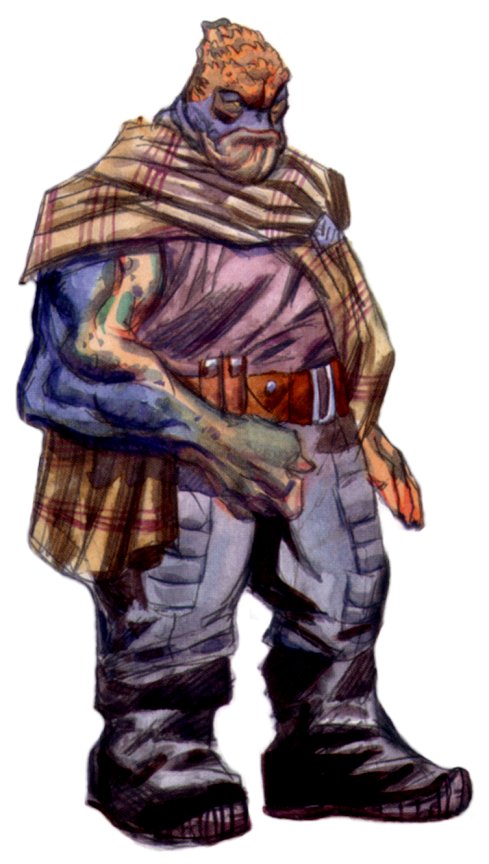 Houk have well-earned reputations as bullies, cheaters, and backstabbers. They are often compared to Wookiees because of their great strength and violent disposition, although Wookiees are usually more agreeable and trustworthy.
Houk have well-earned reputations as bullies, cheaters, and backstabbers. They are often compared to Wookiees because of their great strength and violent disposition, although Wookiees are usually more agreeable and trustworthy.
The Houk acquired hyperdrive technology several thousand years before the Battle of Yavin and spread across the galaxy, seeding many planets with small Colonies. During the Rebellion era, Imperial agents captured and experimented on hundreds of Houk colonists, hoping to create strong yet obedient slaves. The Houk did not submit easily, and most of them are never seen again. At least one Houk survived the ordeal, only to betray his Imperial overlords by joining the Rebel Alliance. Such treachery gave rise to the proverb, “Once a Houk, always as Houk.”
Personality: Houk are humourless, short-tempered beings who use their strength to antagonize weaker beings. Their propensity for deceit and skulduggery is matched only by the Hutts. These qualities are reflected both in their combat techniques and their political dealings. Although Houk descend from a culture where violence, corruption, and treachery are rampant, a few are actually hard workers who have learned to get along with others.
Physical Description: Houk are hulking bipeds with thick skin (usually dark blue or violet), hairless heads marked with bony ridges and a pronounced brow, flabby jowls, beady yellow eyes, and no visible ears or nose. The average Houk stands about 2.2 meters tall.
Homeworld: Lijuter, an arid and inhospitable planet in the Reibrin system, located in the Outer Rim. A number of space stations orbit Lijuter and its two moons, many of them serving as offworld settlements for Houk and various unscrupulous traders and sordid passers-by.
Language: Houk speak Houkese, a language of grunts marked with subtle tonal inflections that differentiate words that otherwise sound the same. Written Houkese uses a simple primitive alphabet in which each letter represents a simple verb and intricate pictograms represent nouns.
Example Names: Gorb Drig, Egome Fass, Agamor Krin, Morg Nar, Roath Vogog, Krelba Voss.
Age In Years: Child 1-12; Young Adult 13-15; Adult 16-44; Middle Age 45-59; Old 60-79; Venerable 80+.
Adventurers: Houk who travel the galaxy take full advantage of the reputation that precedes them. They often work for crime syndicates and pirates. The select few who rise above the vile corruption that passes For Houk society occasionally join independent bands of adventurers for profit or glory. Houk heroes tend to be soldiers, but flingers, scoundrels, and bounty hunters are possible as well. Fame-using Houk are unheard of.
Houk Species Traits
- Ability Modifiers: +4 Strength, -2 Dexterity, +2 Constitution, -2 Intelligence, -2 Wisdom, -4 Charisma
- Size: As Medium creatures, they have no special modifiers due to their size.
- Speed: base speed of 10 meters
- Natural Armor: Houk are thick-boned and thick-skinned. Houk receive a +2 natural armor bonus to Defense.
- Physical Intimidation: Houk use their Strength modifier instead of their Charisma modifier for Intimidate checks.
- Free Language Skills: Read/Write and speak Houk, Speak Basic
Human
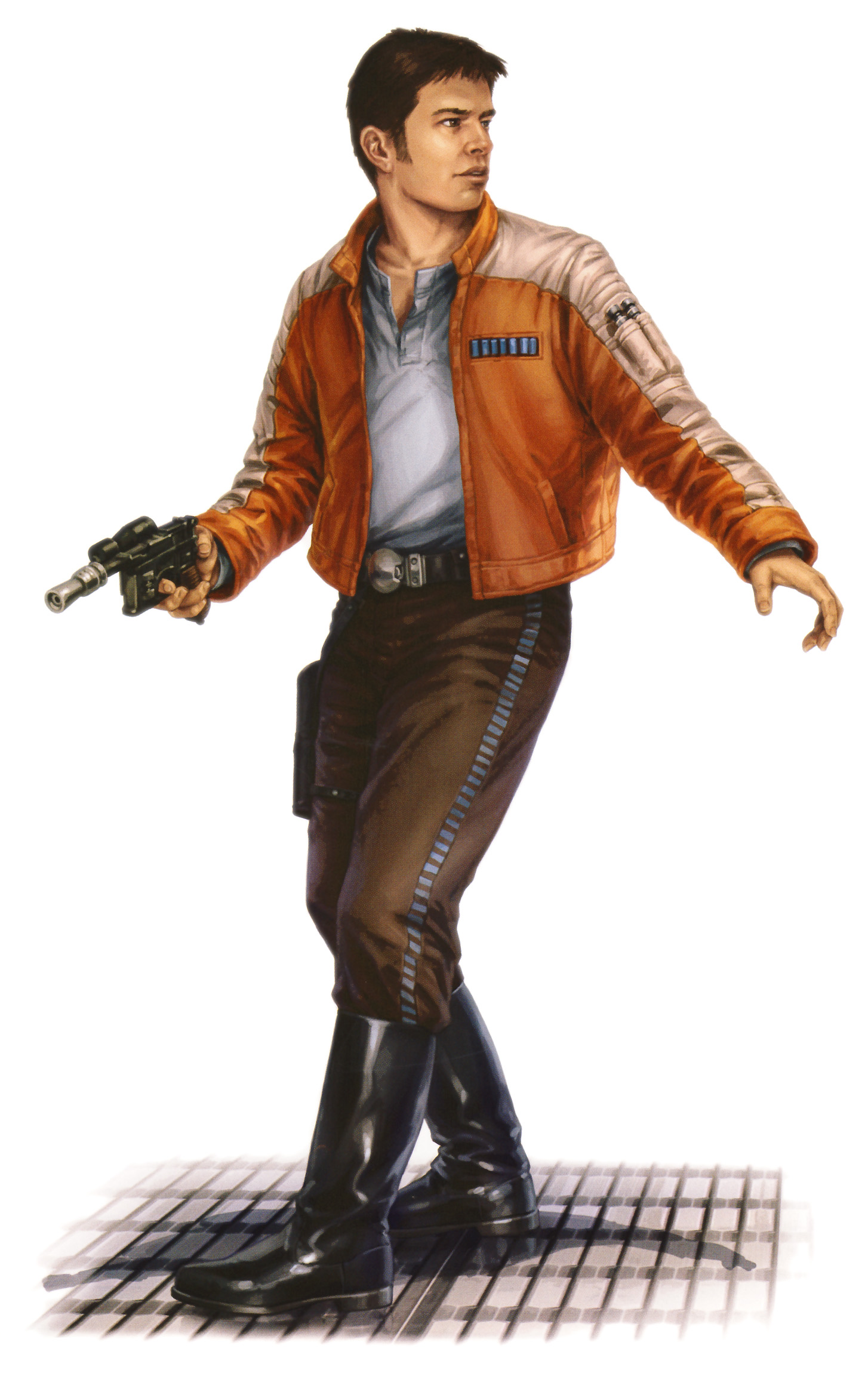 Humans dominate the Core Worlds and can be found in virtually every corner of the galaxy. They are the ancestors of early spacefaring pioneers, conquerors, traders, travelers, and refugees. Humans have always been people on the move. As a result, they can be found on almost every inhabited planet. As a species, Humans are physically, culturally, and politically diverse. Hardy or fine, light-skinned or dark, Humans remain one of the most dominant species throughout all eras of play.
Humans dominate the Core Worlds and can be found in virtually every corner of the galaxy. They are the ancestors of early spacefaring pioneers, conquerors, traders, travelers, and refugees. Humans have always been people on the move. As a result, they can be found on almost every inhabited planet. As a species, Humans are physically, culturally, and politically diverse. Hardy or fine, light-skinned or dark, Humans remain one of the most dominant species throughout all eras of play.
Personality: Human personality runs the gamut of possibilities, though members of this species tend to be highly adaptable, tenacious, and willing to keep striving no matter the odds. They are flexible and ambitious, diverse in their tastes, morals, customs, and habits.
Physical Description: Humans average about 1.8 meters tall. Skin shades run from nearly black to very pale, hair from black to blond. Men are usually taller and heavier than women. Humans achieve maturity about the age of 15 and rarely live beyond 100.
Homeworld: Various, including Coruscant, Corulag, Naboo, Tatooine, and Alderaan.
Language: Humans speak and read Basic. They typically team other languages, including obscure ones.
Example Names: Anakin, Arani, Bail, Ben, Beru, Biggs, Boba, Corran, Dack, Dané, Galak, Garm, Han, Jango, Jodo, Lando, Leia, Luke, Mace, Mara, Obi-Wan, Owen, Padmé, Qui-Gon, Sia-Lan, Rann, Talon, Vor'en, Wedge, Winter.
Age In Years: Child 1-12; Young Adult 13-18; Adult 19-48; Middle Age 49-64; Old 65-79; Venerable 80+.
Adventurers: Humans aren't afraid to try anything, and Human adventurers are the most audacious, daring, and ambitious members of an audacious, daring, and ambitious species. A Human can earn glory by amassing power, wealth, and fame. More than any other species, Humans champion causes rather than territories or groups.
Human Species Traits
- Ability Modifiers: None
- Size: As Medium creatures, they have no special modifiers due to their size.
- Speed: base speed of 10 meters
- Varied: Humans are quick to master specialized tasks and are varied in their talents. Human gain 1 extra feat at 1st level.
- Versatile: Humans are versatile and capable. Human gain 4 extra skill points at 1st level and 1 extra skill point at each additional level (The 4 extra skill points at 1st level are added on as a bonus, not multiplied in.)
- Free Language Skills: Read/Write and Speak Basic.
Hutt
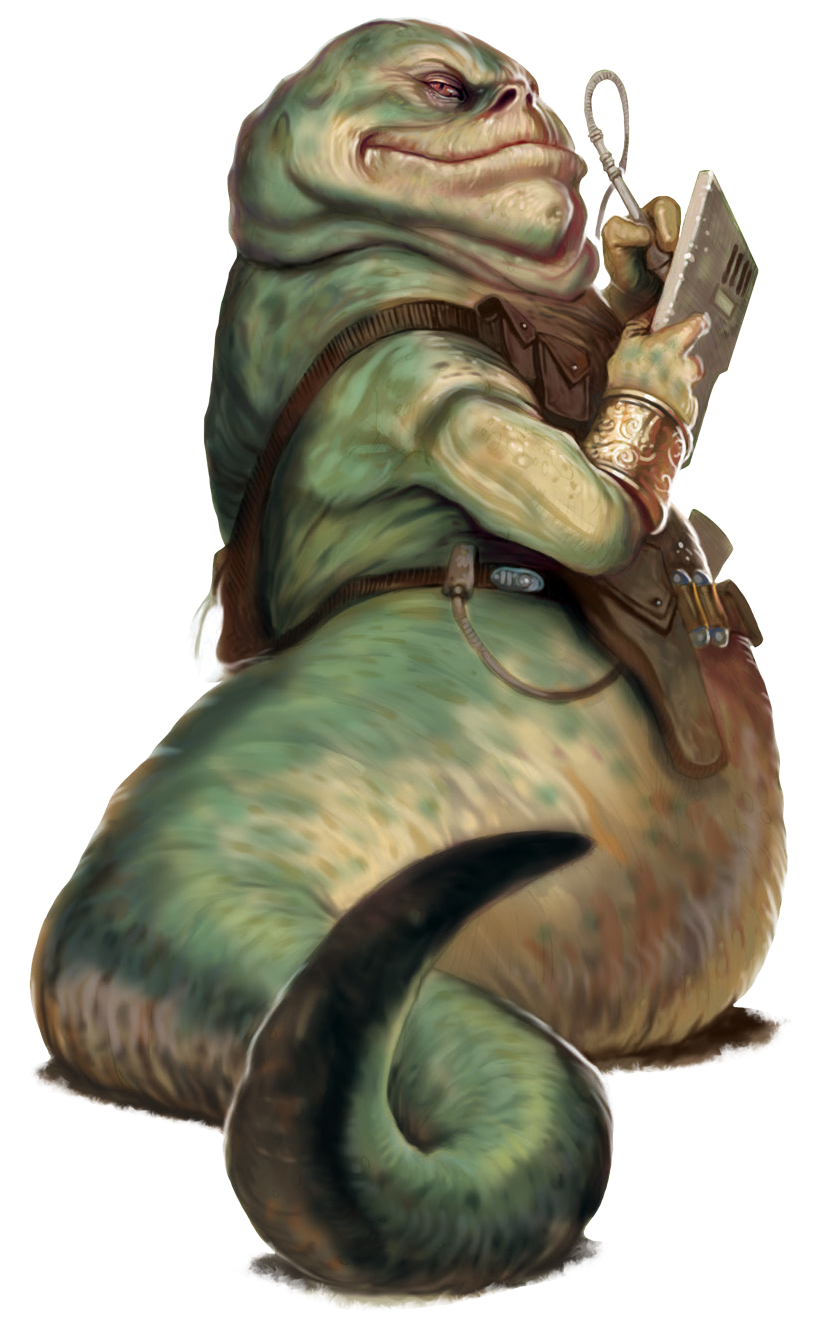 Hutts are long-lived gastropods who occupy a region known as Hutt Space. They are powerful, ruthless beings who continually seek to expand the boundaries of their dominion and the holdings of their individual clans, or kajidies. Their appetite for power is as insatiable as their appetite for food.
Hutts are long-lived gastropods who occupy a region known as Hutt Space. They are powerful, ruthless beings who continually seek to expand the boundaries of their dominion and the holdings of their individual clans, or kajidies. Their appetite for power is as insatiable as their appetite for food.
Hutts are often found at the centre of business and criminal enterprises. Legality (or lack thereof) does not affect whether a Hutt will pursue a venture. All that matters is how much of a benefit—and a profit—one can get from it.
Like worms, Hutts are hermaphroditic, with both male and female reproductive organs. Hutts bear their young one at a time and nourish them for a time in a brood pouch. Their large lungs enable them to stay underwater for hours at a time. Xenobiologists often classify Hutts as gastropods because of their sluglike appearance and movements.
A council of elders oversees Hutt Space. Comprised of Hutts representing the oldest and most influential kajidies, they decide the fate of everyone who lives in Hutt Space, and all other Huns are answerable to them.
Personality: Most Hutts are vicious megalomaniacs who consider their kind to be beyond morality as perceived by lesser beings. They have a talent for manipulating other beings and enjoy accumulating and exerting power over others. A Hutt's strongest loyalty is always to his kajidic, without which a Hutt is nothing but a lowly commoner.
Physical Description: A Hutt is an immense, sluglike creature with a thick body, muscular tail, and small arms protruding from its upper body. A Hutt’s bulbous head features catlike eyes, wide nostrils, and a broad lipless mouth. An adult Hutt averages 4 meters long and weighs 1,500 kilograms.
Homeworld: Hutts evolved on the temperate forest world of Varl. When a natural calamity left Varl a blasted wasteland, the Hutts fled and adopted a new homeworld: Nal Hutta, in the Y’Toub system on the border of the Mid Rim and Outer Rim. The Hutts have spent centuries polluting and ruining Nal Hutta's ecosystem, as well as that of Nar Shaddaa, a heavily industrialized moon whiting Nal Hutta.
Language: Hutts speak and read Huttese and Basic. They consider their own language superior to Basic and usually demand that lesser beings address them in their native tongue.
Example Names: Borga, Churabba, Dalla, Durga, Gardulla, Grelb, Grondo, Issulla, Jabba, Krova, Mardoc, Mika, Nullada, Popara, Shala, Yarella, Zonnos, Zordo.
Age In Years: Child 1-70; Young Adult 71-90; Adult 91-650; Middle Age 651-844; Old 845-925; Venerable 926+.
Adventurers: Very few Hutts manifest any desire to explore space or place themselves in harm's way. They prefer to travel the stars on space yachts or command their mini-empires from heavily fortified estates. Hutt crime lords are common, while exiled or disgraced Hutts sometimes become scoundrels or bounty hunters. At least one Hutt of reptile has trained as a Jedi, although Hutt Force-users are exceedingly rare.
Hutt Species Traits
- Ability Modifiers: +2 Strength, -4 Dexterity, +2 Constitution, +2 Intelligence, +2 Wisdom, +2 Charisma
- Size: As Large creatures, they suffer a -1 size penalty on Defense, a -1 size penalty on attack rolls, and a -4 penalty on hide check, and a and a +4 penalty when grapplings. They have a Face/Reach of 2m by 2m/4m. Their lifting and carrying limits are doubled of Medium-sized characters.
- Speed: base speed of 2 meters
- Force Resistance: Hutt gain a +
6 species bonus on Will saves to resist the Force skills Affect Mind, Friendship, Illusion, and any other mind-influencing Force skill that allows the target a Will save.
- Gastropod: Hutts cannot be knocked prone.
- Bonus Feat: Hutt receive the bonus feat Infamy.
- Free Language Skills: Read/Write and Speak Huttese
Iktotchi
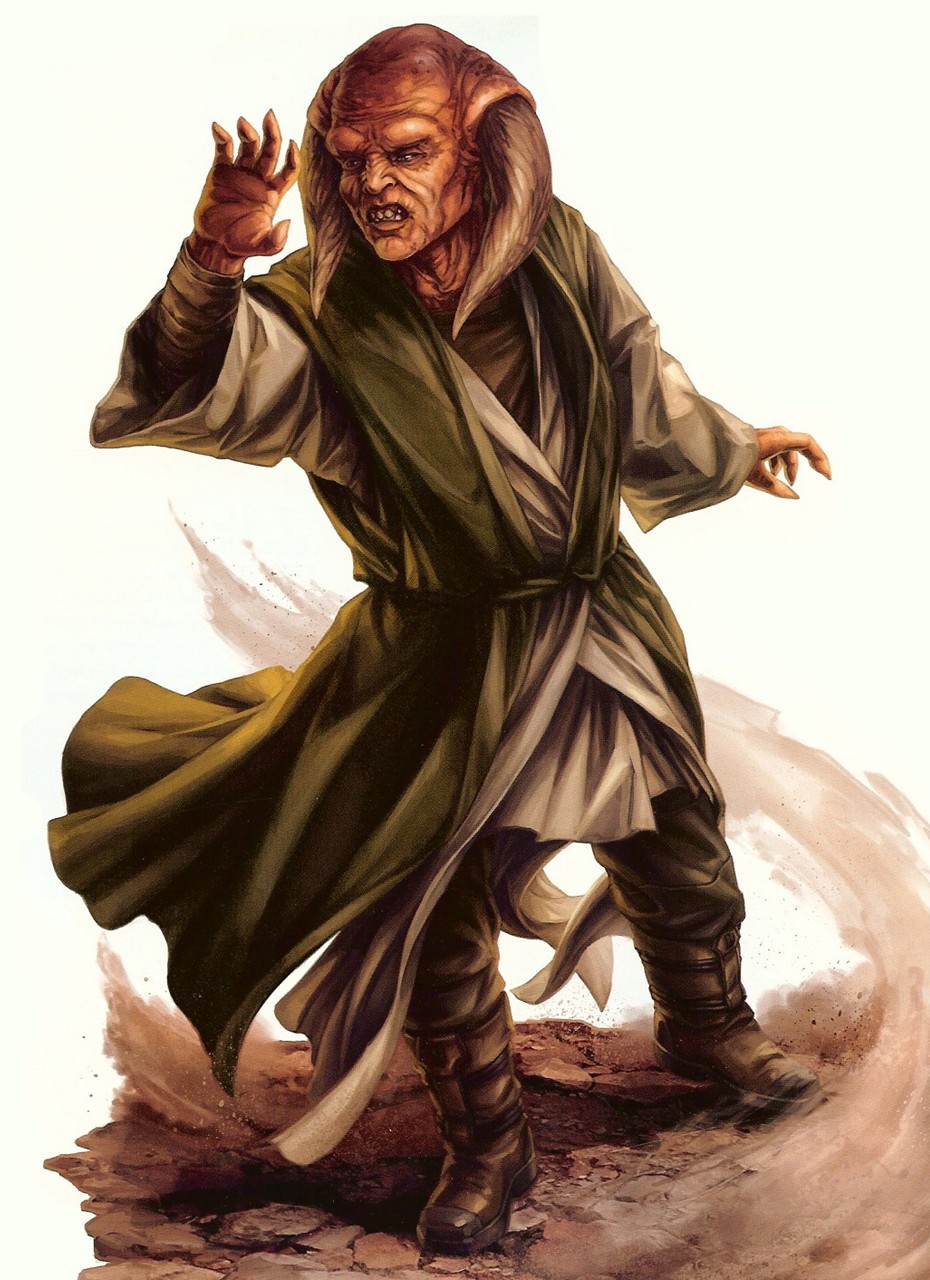 Iktotchi, a remote star system in the Expansion Region, has a single planetary body capable of supporting life—a moon orbiting a lifeless mass of rock on the system's edge. Here, the lktotchi arose as the sole intelligent life in a desolate system, yet from their earliest civilization they had legends of some day being part of a great galactic civilization that spanned the stars.
Iktotchi, a remote star system in the Expansion Region, has a single planetary body capable of supporting life—a moon orbiting a lifeless mass of rock on the system's edge. Here, the lktotchi arose as the sole intelligent life in a desolate system, yet from their earliest civilization they had legends of some day being part of a great galactic civilization that spanned the stars.
lktotchi are renowned across the galaxy as excellent pilots, with a reputation as mechanics and engineers not far behind. This was not the only thing the lktotchi are known for, however. When Republic scouts first discovered their civilization roughly 3,500 years ago, they were both surprised and unnerved that the entire population of Iktotchi had been prepared for their arrival for several weeks. In fact, when the scout ship first entered orbit around the moon, they thought they had found an unreported Republic settlement—a giant version of the Old Republic seal, visible from space to the naked eye, had been carved into a high plateau on the world's largest continent. Lktotchi leaders were assembled there, eager to make contact with the great civilization of the stars.
Old Republic xenobiologists soon learned that the lktotchi possessed limited natural precognition, manifested through dreams or visions. This inborn talent particularly fascinated the Jedi, and a Jedi Temple was one of the first permanent offworld settlements to be established on Iktotchon. They discovered that lktotchi trained as Jedi were particularly adept with Sense powers, and lktotchi precognitive abilities could actually be enhanced with Force training.
As the lktotchi became integrated into the galactic society around them, it became clear that their affinity for flight extended into space vehicles. Despite this, they didn't fit comfortably into the vast cultural tapestry they had dreamt of for so long. They found that they were distrusted by many, as lktotchi were rumoured to be everything from telepaths to dangerous doombringers that foresaw evil and then worked to bring it about. Iktotchi soon began to deny any extrasensory abilities—mostly true, since their precognitive powers are severely limited when away from Iktotchon—and they gradually gained acceptance as the bizarre circumstances surrounding the initial contact with the Iktotchi faded with the passage of time. Iktotchi skill with spacecraft became so well known that everyone from pirates to system defense forces were willing to pay top credits for even green Iktotchi pilots and engineers.
As the Emperor rose to power, Iktotchi diplomats worked feverishly to prevent the galaxy from embarking on the dark path that would lead it to the Clone Wars; they had seen the carnage in their dreams. Iktotchi Jedi posed a threat to the Emperor's plans, and they were among the first targets during the Jedi Purge.
Shortly before the Emperor's New Order seized power, most lktotchi withdrew from all but the most distant Outer Rim worlds, retreating to their home star system and constructing orbital colonies to handle the influx of people. Their precognitive abilities had warned them that dire fates awaited them if they attempted to live under the Emperor's regime. The Emperor seemed content to allow the lktotchi to withdraw and ordered a blockade of their system. He didn't even bother to appoint a planetary governor, and the lktotchi knew that isolation would be the only way their people would survive. Nonetheless, several of them did steal past the blockade to join the Rebel Alliance.
When the Empire fell, the lktotchi became eager participants in the founding of the New Republic. Curiously, the Yuuzhan Vong invasion took the lktotchi by as much surprise as the rest of the galaxy's population. Not only were these extra-galactic invaders invisible to the Jedi but also they were shielded from the visions of the lktotchi.
Personality: lktotchi are sensitive beings who hide their deep emotions behind a facade of quiet stoicism. They respect diversity and adapt quickly to other cultures, but they don't form friendships with other species easily.
Iktotchi can be somewhat impatient with species that aren't precognitive. Culturally, they are also concerned about frightening other beings—they have no desire to be reviled by galactic society or abused by those who might use their precognitive abilities for ill-so their natural gifts sometimes seem more like a curse.
Physical Description: The lktotchi have tough, hairless skin that protects them from the fierce winds of their homeworld. Adults average 1.8 meters tall and possess sturdy builds. Both males and females have downward-curving horns, although the horns of the males are somewhat larger. Their hands are broad, and their thick fingers give them a limited manual dexterity.
Homeworld: Iktotch, a moon orbiting the planet Iktotchon in the Expansion Region.
Language: lktotchi speak and read Iktotchese. They can also speak Basic with ease.
Example Names: Arctan Meeso, Daedar Xiese, Liiren Baelar, Niira Korl, Saesee Tiin, Seer Varree.
Age In Years: Child 1-13; Young Adult 14-18; Adult 19-44; Middle Age 45-70; Old 71-89; Venerable 90+.
Adventurers: Iktotchi adventurers are typically nobles, scouts, soldiers, tech specialists, and starship aces. Iktotchi Jedi consulars and Jedi guardians are most common during the Rise of the Empire era, although a few of them are believed to have survived the Jedi Purge as well.
Iktotchi Species Traits
- Ability Modifiers: -2 Dexterity, +2 Constitution, -2 Charisma
- Size: As Medium creatures, they have no special modifiers due to their size.
- Speed: base speed of 10 meters
- Natural Armor: Iktotchi have tough skin. Iktotchi receive a +1 natural armor bonus to Defense.
- Precognition: All Iktotchi possess limited precognition. For most of them, it manifests in prophetic dreams that predict events that will shape the lives of millions. Most Iktotchi are unable to control when they have precognitive visions, but instead receive them as particularly vivid dreams or daydreams. Iktotchi who possess the Force-Sensitive feat and at least one rank in the Farseeing force skill can purposefully see into the future with a successful Farseeing check (DC 20, instead of the normal DC 25).
- Bonus Feat: Iktotchi receive the bonus feat Starship Operation (any one).
- Skill Bonus: Iktotchi receive a +2 species bonus on Pilot checks.
- Free Language Skills: Read/Write and Speak Iktotchese
Iotran
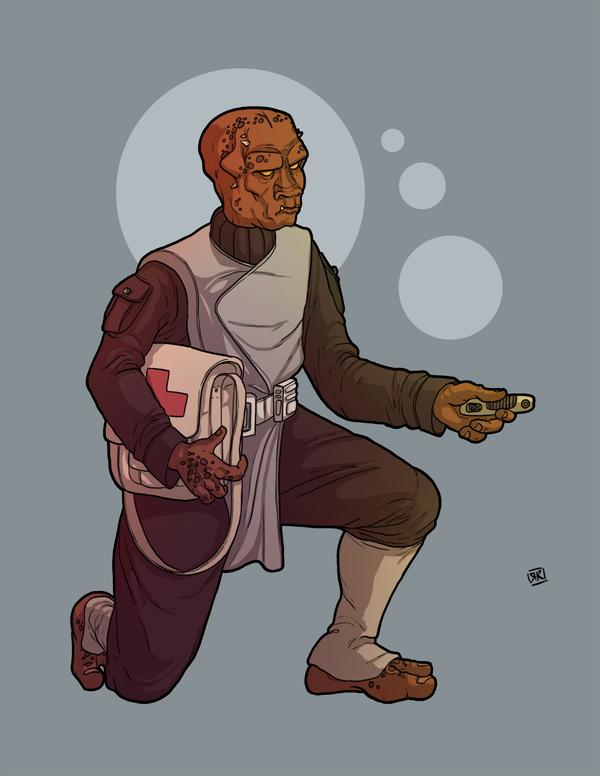 Iotrans are atheistic sentients who live and thrive within a strict military hierarchy. The Iotrans people follow clear, codified laws that set the boundaries for conduct within their society. Iotrans strive for order and civility and believe in the maxim “might makes right.” They abhor dissidence and lost considerable respect among non-Iotrans cultures by showing open contempt for the Rebel Alliance and refusing to stand with the Alliance against the Empire.
Iotrans are atheistic sentients who live and thrive within a strict military hierarchy. The Iotrans people follow clear, codified laws that set the boundaries for conduct within their society. Iotrans strive for order and civility and believe in the maxim “might makes right.” They abhor dissidence and lost considerable respect among non-Iotrans cultures by showing open contempt for the Rebel Alliance and refusing to stand with the Alliance against the Empire.
Since the early says of the Old Republic, Iotrans have maintained an immense standing army bolstered by hyperdrive-capable starships and blaster weapons. The army patrols the Iotran Expanse and has proven an effective deterrent against invasion, as Iotrans have never been involved in any military engagement larger than a border skirmish.
From youth, Iotrans are trained to prepare for conflict. By law, they must serve six standard years in the military, and of course, most of them consider it a privilege and honour to do so.
Personality: Iotrans respect military might and little else. They fervently believe that order and stability are the building blocks of a thriving society. Iotrans have little to no respect for other cultures and their laws. They also have no sense of fair play, seeking victory in every conflict by the most expedient means.
Iotrans are not technically minded, but they make good use of technology acquired from other species.
Physical Description: An Iotran has smooth, dark skin and a broad, flat nose. Distinctive spots adorn the top of an Iotran's distinctive skull, which features a pair of knobby protrusions that jut out between the eyes and ears. An Iotran has birdlike feet and hands with three ringers and a thumb. An Iotran adult stands about 1.75 meters tall and typically wears militaristic or utilitarian clothing.
Homeworld: Iotra is an industrial planet in the Outer Rim system of the same name. The Iotran Peacekeeping Force (IPF) rules Iotra through a Joint Council of eight top-ranking military leaders.
Language: Iotrans speak Tranese, a rich language that has simple, precise sentence constructions and words. Most Iotrans learn to speak Basic, although they find it inelegant and convoluted.
Example Names: Terika Etan, Mirip Pag, Dira Shal, Rodick Tag, Anvon Trig, Rova Zad.
Age In Years: Child 1-10; Young Adult 11-16; Adult 17-44; Middle Age 45-65; Old 66-84; Venerable 85+.
Adventurers: Due to the lack of respect Iotrans tend to have for alien cultures, they rarely venture far from Iotra. The two exceptions are Fugitives who flee Iotran space and the Iotran Bracemen (highly skilled bounty hunters) sent to retrieve them. Iotran Force-users are uncommon, but no more so than rumours of secret Iotran cabals trained in the ways of the Jedi. Regardless of background, all Iotran heroes born in the Iotran Expanse or in an Iotran colony must take their first level in the soldier class.
Iotran Species Traits
- Ability Modifiers: +2 Constitution, -2 Intelligence, -2 Charisma
- Size: As Medium creatures, they have no special modifiers due to their size.
- Speed: base speed of 10 meters
- Martial Prowess: Iotrans gain a +1 species bonus on melee attack rolls.
- Martial Training: Iotran commoners gain the bonus feat Weapon Proficiency (simple weapons). Iotran heroes and professionals also gain the bonus feat Weapon Proficiency (slugthrowers).
- Skill Bonus: Iotran receive a +4 species on Knowledge (tactics) checks.
- Free Language Skills: Read/Write and Speak Tranese, Speak Basic
Ishi Tib
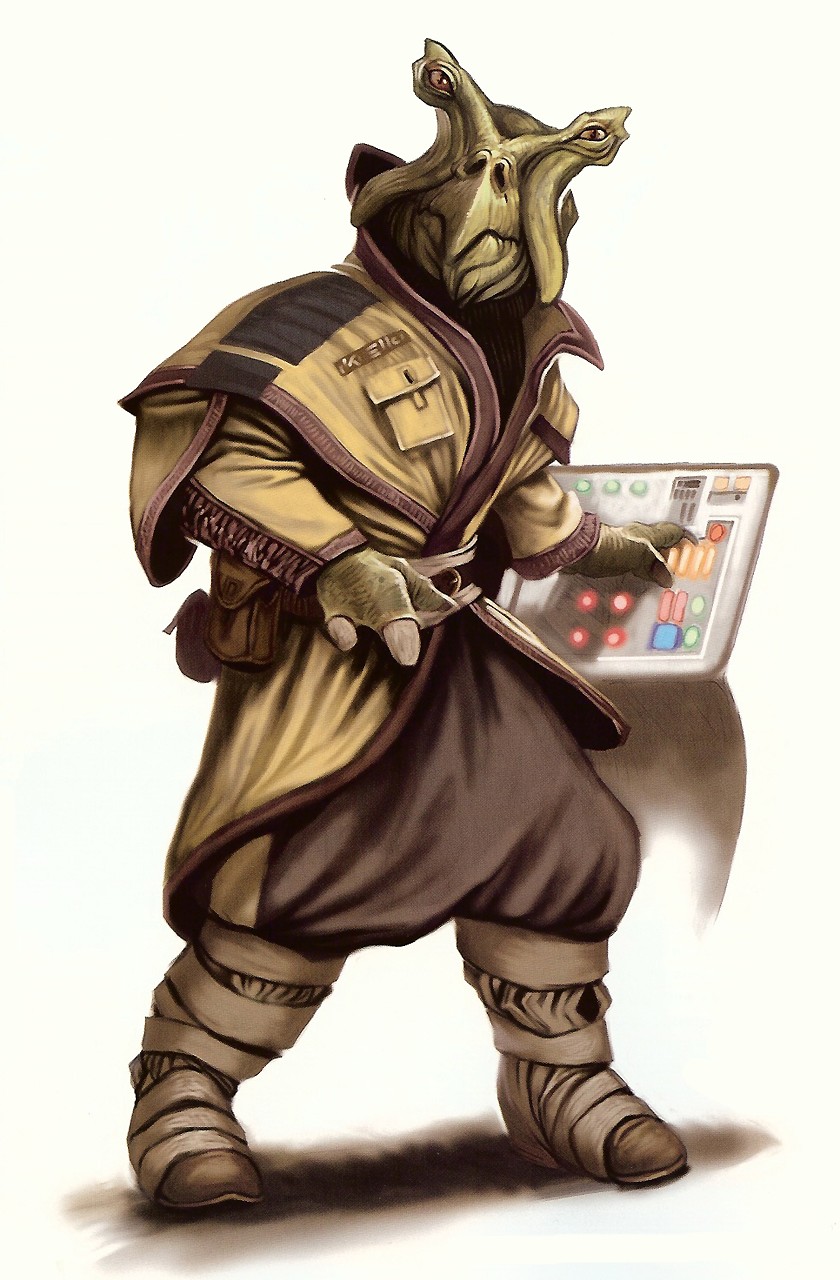 Ishi Tib are amphibian humanoids who live in large communal families called schools. Each school ranges in size from a few hundred members to more than ten thousand individuals. Ishi Tib mate only to reproduce, and the entire school assumes responsibility for the welfare of Ishi Tib hatchlings, which never learn the identities of their parents. The needs of the school always come before the needs of an individual.
Ishi Tib are amphibian humanoids who live in large communal families called schools. Each school ranges in size from a few hundred members to more than ten thousand individuals. Ishi Tib mate only to reproduce, and the entire school assumes responsibility for the welfare of Ishi Tib hatchlings, which never learn the identities of their parents. The needs of the school always come before the needs of an individual.
Ishi Tib live in ornate cities built upon carefully cultivated coral reefs. They are fervent eco-preservationists, unwilling to compromise when ecological balance is at stake. Although Ishi Tib have little desire to leave their homeworld, they are sometimes lured offworld by corporations in need of highly organized managers and environmentally sensitive urban planners. The Rebel Alliance also put their keen minds to use planning raids against the Empire, and several Ishi Tib tactical experts were present during the critical briefing before the Battle of Endor.
Ishi Tib must routinely immerse themselves in a brine solution similar to the oceans of Tibrin, or they will die of dehydration.
Personality: Ishi Tib are patient, meticulous, highly organized perfectionists. They are quick to correct the errors of other school members, and most are strident defenders of the natural environment.
Physical Description: Ishi Tib stand about 1.8 meters tail and have green skin. Their four-pointed, star-shaped face features a pair of lidless yellow eyes on short stalks and a sharp, hooked beak. Their lungs can breathe air or water.
Homeworld: Tibrin, located in the Mid Rim, is a world of shallow oceans dotted with developed coral reefs and sandbars that serve as Ishi Tib center of commerce. Technology is carefully tested before it can be implemented on Tibrin to prevent pollution. Structures are often made of coral and other organic materials, and beasts perform many tasks usually performed by machines.
Language: Tibranese is a language of squeals, honks, and beak-clacks. Written Tibranese uses hieroglyphs, a throwback to ancient times when only simple pictures could be carved into soft objects in Tibrin's watery environment.
Example Names: Jund Voon, Koth-Morr, Kenjil Mang, Sciltra Rega, Harc Seff, Thilis-Brin, Shasa Tiel, Troc Slatter.
Age In Years: Child 1-6; Young Adult 7-11; Adult 12-39; Middle Age 40-59; Old 60-79; Venerable 80+.
Adventurers: Ishi lib encountered away from Tibrin are usually biologists, ecologists, and oceanographers. In spite of their organizational skills and high intelligence, many corporate sponsors find the species difficult to work with. These Ishi Tib usually fall in love with space travel before they can make their way back to Tibrin. Ishi Tib heroes are usually fringers, nobles, and tech specialists.
Ishi Tib Species Traits
- Ability Modifiers: -2 Dexterity, +4 Intelligence
- Size: As Medium creatures, they have no special modifiers due to their size.
- Speed: base speed of 10 meters
- Breathe Underwater: As amphibious creatures, Ishi Tib can't drown in water. They gain a +4 species bonus on Swim checks.
- Hydration: Ishi Tib must immerse themselves in brine (saltwater solution) for at least 1 minute every day or dehydrate. For each standard day that passes without immersion, the Ishi Tib takes 1d4 points of temporary Constitution damage. An Ishi Tib cannot regain lost Constitution points by resting while dehydrated, and an Ishi Tib reduced to 0 Constitution dies.
- Natural Weapon (Beak): An Ishi Tib can make an unarmed melee attack with it's hooked beak, dealing 1d4 points of piercing damage (plus Strength modifier). The beak attack does not provoke attacks of opportunity.
- Rage: When an Ishi Tib takes damage from an attack, it can choose to enter a frenzied state. In this state, the Ishi Tib gains +4 Strength. +2 vitality points per level (+0 for commoners), and a +2 rage bonus on Fortitude and Will saves, but suffers a -2 penalty to Defense. While raging, the Ishi Tib cannot use skills that require patience and concentration, such as Move Silently. Combat Expertise, or Force-based abilities. The rage lasts for a number of rounds equal to 5 + the Ishi Tib's Constitution modifier. At the end of this duration, the Ishi Tib loses the bonus to Strength and the bonus vitality points. Furthermore, the Ishi Tib is fatigued (-2 penalty to Strength and Dexterity, can't run or charge) for a number of rounds equal to the rage's duration. At the start of the rage, the Ishi Tib must choose one opponent and continue attacking that opponent until the rages ends or until the opponent drops to 0 wound points (at which point the rage ends). The Ishi Tib can only use melee Weapons (inducing its beak) while raging.
- Free Language Skills: Read/Write and Speak Tibranese
Ithorian
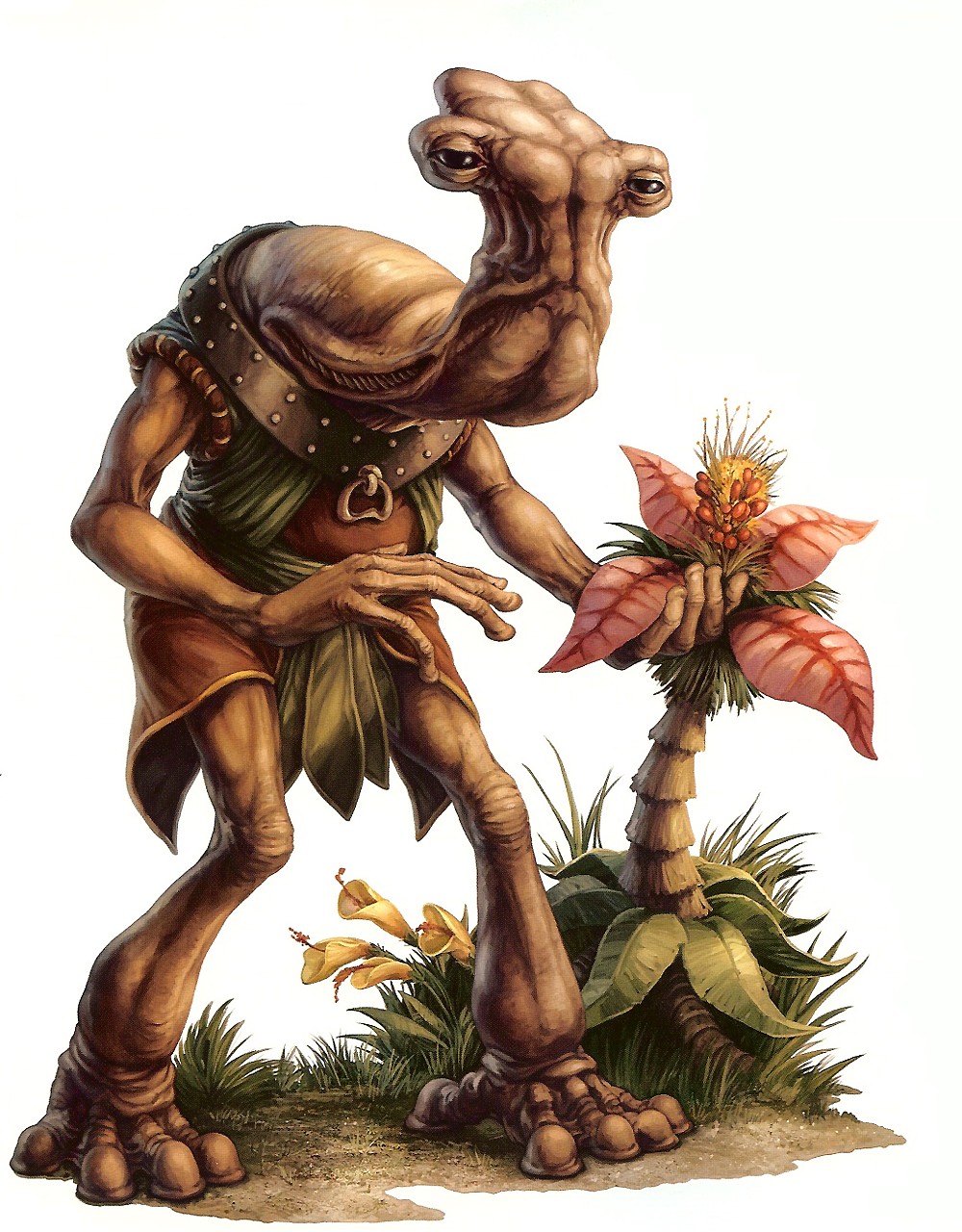
Personality:
Physical Description:
Homeworld:
Language:
Example Names:
Age In Years: Child 1-13; Young Adult 14-17; Adult 18-44; Middle Age 45-69; Old 70-84; Venerable 85+.
Adventurers:
Ithorian Species Traits
- Ability Modifiers: -2 Dexterity, +2 Wisdom, +2 Charisma
- Size: As Medium creatures, they have no special modifiers due to their size.
- Speed: base speed of 10 meters
- Strong-Willed: Ithorians receive a +1 species bonus on Will saves.
- Skill Bonus: Ithorians are attuned with nature. Ithorian receive a +4 species bonus on Knowledge (wilderness lore), and a + 2 species bonus on Survival checks.
- Free Language Skills: Read/Write and Speak Basic and Ithorses
Jawa
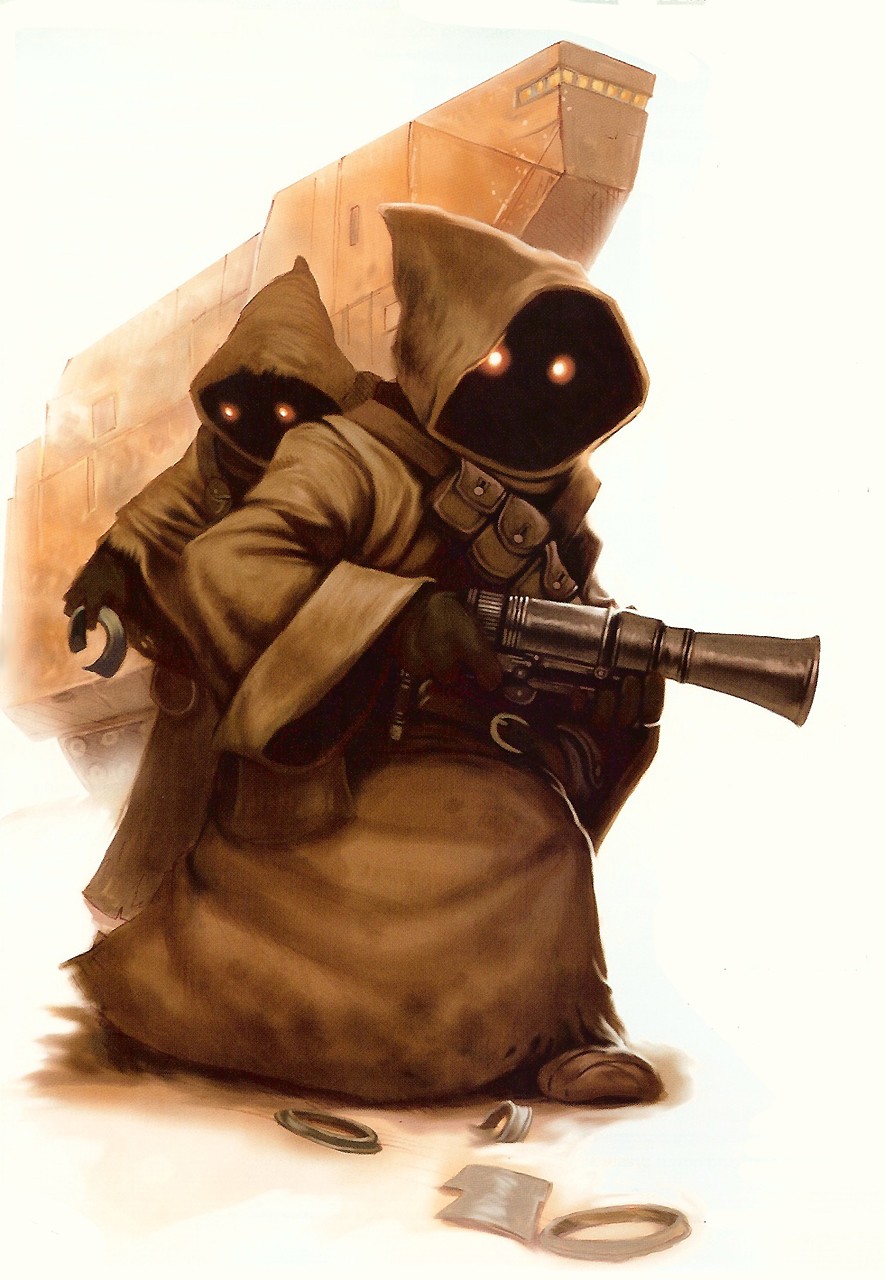
Personality:
Physical Description:
Homeworld:
Language:
Example Names:
Age In Years: Child 1-10; Young Adult 11-15; Adult 16-36; Middle Age 37-52; Old 53-64; Venerable 65+.
Adventurers:
Jawa Species Traits
- Ability Modifiers: -4 Strength, +2 Dexterity, -2 Charisma
- Size: As Small creatures, they gain a +1 size bonus to their Defense, a +1 size bonus on attack rolls, and a +4 size bonus on Hide checks, and a –4 penalty when grappling. They must use smaller weapons than Medium-size beings use, and their lifting and carrying limits are three-quarters those of Medium-size characters.
- Speed: base speed of 6 meters
- Darkvision: Jawa can see in the dark up to 20 meters. Darkvision is black and white only but otherwise functions as normal sight.
- Primitive: Jawa with heroic or professional classes receive the bonus feats Weapon Group Proficiency (primitive weapons) and Weapon Group Proficiency (simple weapons) instead of the usual Weapon Group Proficiency bonus feats.
- Skill Bonus: Jawa receive +2 species bonus on Survival checks.
- Free Language Skills: Read/Write and Speak Jawa and Speak Jawa Trade Language
Jenet
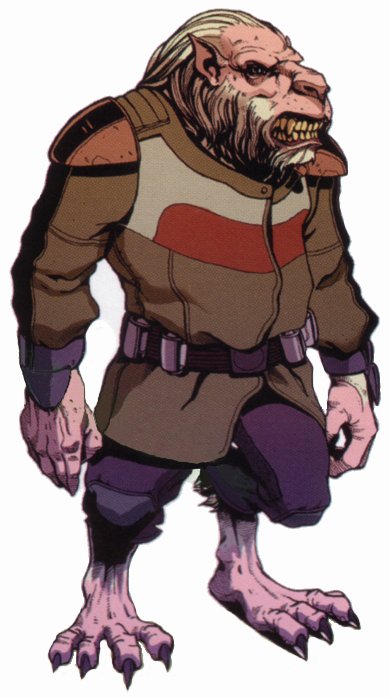
Personality:
Physical Description:
Homeworld:
Language:
Example Names:
Age In Years: Child 1-4; Young Adult 5-8; Adult 9-29; Middle Age 30-54; Old 55-69; Venerable 70+.
Adventurers:
Jenet Species Traits
- Ability Modifiers: -2 Strength, +2 Dexterity, +2 Intelligence, -4 Charisma
- Size: As Medium creatures, they have no special modifiers due to their size.
- Speed: base speed of 12 meters
- Low-Light Vision: Jenet can see twice as far as normal in dim light, and retain the ability to distinguish color and detail under these conditions.
- Photographic Memory: Jenets remember everything they experience. The GM can allow a Jenet to make a Wisdom check to determine whether he's heard of or seen (as appropriate) someone or something before. The DC depends on how likely it is that the Jenet was paying attention and how noticeable the detail might have seemed at the time. If there's no chance of the Jenet remembering, the check Fails automatically.
- Bonus Feat: Jenet receive the bonus feat Alertness and Run.
- Skill Bonus: Nimble and swift, Jenets are capable climbers and swimmers. Jenet receive a +2 species bonus on Climb, Escape Artist, Jump, and Swim Check.
- Free Language Skills: Speak Jenet
Kaminoan
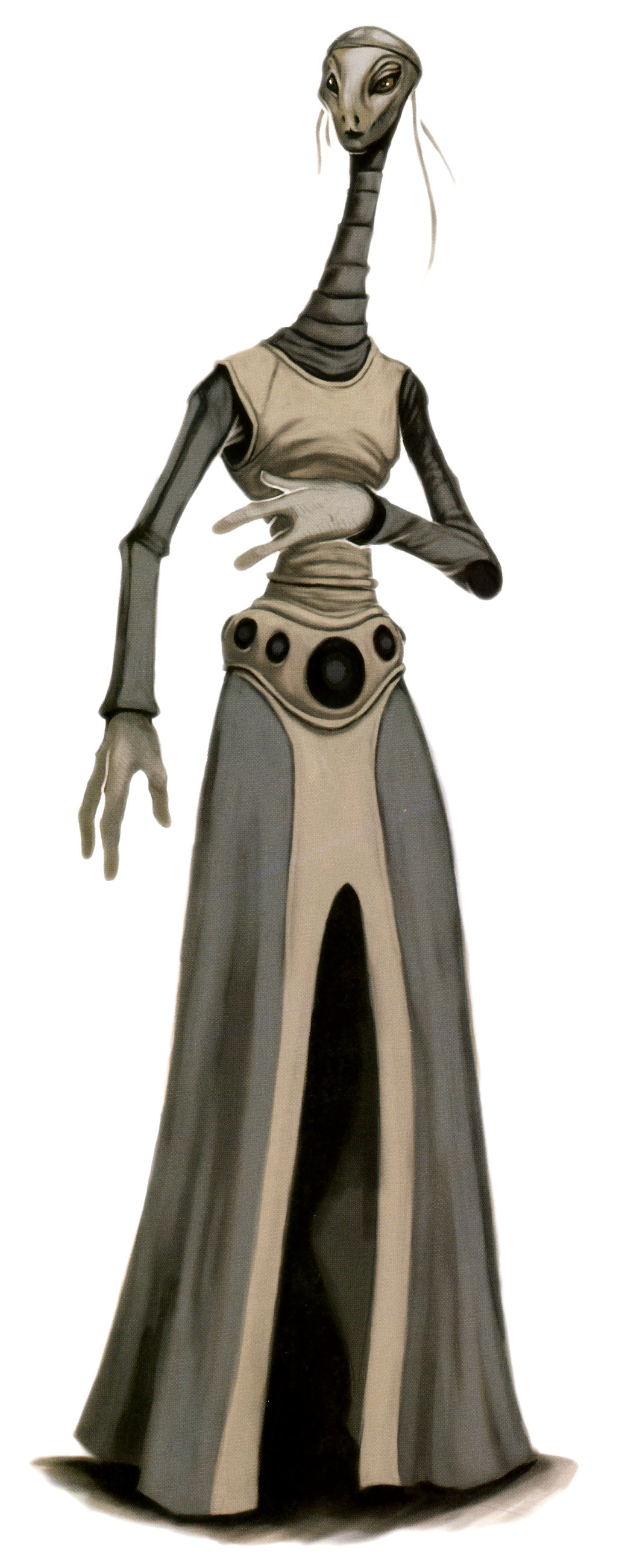
Personality:
Physical Description:
Homeworld:
Language:
Example Names:
Age In Years: Child 1-6; Young Adult 7-10; Adult 11-39; Middle Age 40-59; Old 60-79; Venerable 80+.
Adventurers:
Kaminoan Species Traits
- Ability Modifiers: +2 Constitution, -2 Wisdom
- Size: As Medium creatures, they have no special modifiers due to their size.
- Speed: base speed of 10 meters
- Adaptable: Kaminoan receive a +2 species bonus on Survival checks.
- Free Language Skills: Read/Write and Speak Basic and Kaminoan
Kel Dor
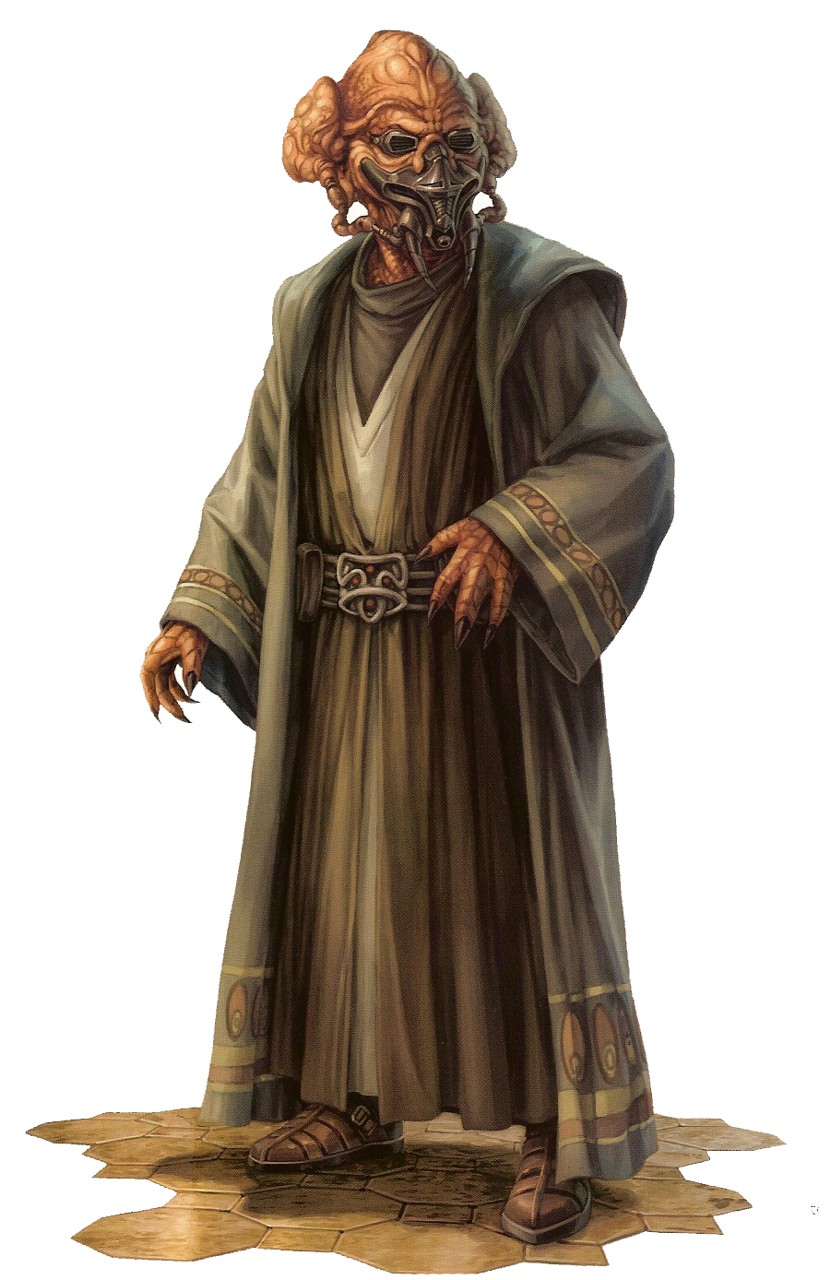
Personality:
Physical Description:
Homeworld:
Language:
Example Names:
Age In Years: Child 1-11; Young Adult 12-15; Adult 16-44; Middle Age 45-59; Old 60-69; Venerable 70+.
Adventurers:
Kel Dor Species Traits
- Ability Modifiers: +2 Dexterity, -2 Constitution, +2 Wisdom
- Size: As Medium creatures, they have no special modifiers due to their size.
- Speed: base speed of 10 meters
- Gas Breather: Kel Dor cannot survive without their native atmosphere, specifically a gas unique to their homeworld. Without protective goggles, a Kel Dor is considered blinded (see the Character Condition Summary in Chapter Twelve of the Star Wars Roleplaying Game). A Kel Dor without a suitable breath mask can hold his breath for a number of rounds equal to his Constitution score before he needs to make Constitution checks to avoid suffocation (see Suffocation and Drowning in Chapter Twelve of the Star Wars Roleplaying Game).
- Low-Light Vision: Away from their homeworld, Kel Dor gain low-light vision. Kel Dor can see twice as far as normal in dim light, and retain the ability to distinguish color and detail under these conditions.
- Free Language Skills: Read/Write and Speak Basic and Kel Dor
Kerestian
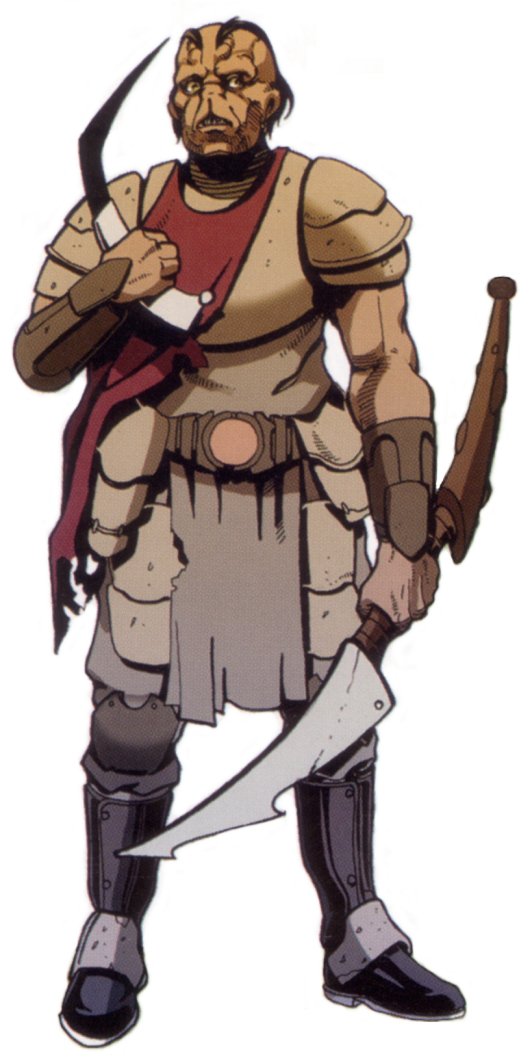
Personality:
Physical Description:
Homeworld:
Language:
Example Names:
Age In Years: Child 1-11; Young Adult 12-17; Adult 18-44; Middle Age 45-57; Old 58-79; Venerable 80+.
Adventurers:
Kerestian Species Traits
- Ability Modifiers: +2 Strength, -2 Intelligence, -2 Charisma
- Size: As Medium creatures, they have no special modifiers due to their size.
- Speed: base speed of 10 meters
- Resilient: Kerestian gain a +1 species bonus on Fortitude saves.
- Bonus Feat: Kerestian receive the bonus feat Toughness.
- Skill Bonus: Kerestian receive a +2 species bonus on Survival checks.
- Free Language Skills: Read/Write and Speak Kerestese
Khil
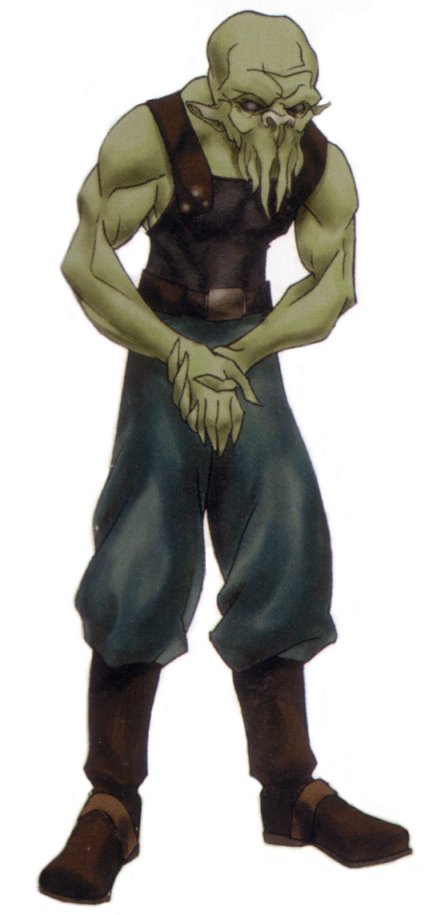
Personality:
Physical Description:
Homeworld:
Language:
Example Names:
Age In Years: Child 1-10; Young Adult 11-15; Adult 16-49; Middle Age 50-74; Old 75-89; Venerable 90+.
Adventurers:
Khil Species Traits
- Ability Modifiers: -2 Constitution, +2 Intelligence, +2 Wisdom
- Size: As Medium creatures, they have no special modifiers due to their size.
- Speed: base speed of 10 meters
- Hullepi: Khil generally do not suffer the effects of starvation. In sterile environments, such as aboard a well-maintained space station or starship, Khil suffer the effects of starvation as normal.
- Skill Bonus: Khil receive a +4 species bonus on Entertain (sing) checks.
- Free Language Skills: Read/Write and Speak Khilese
Khommite
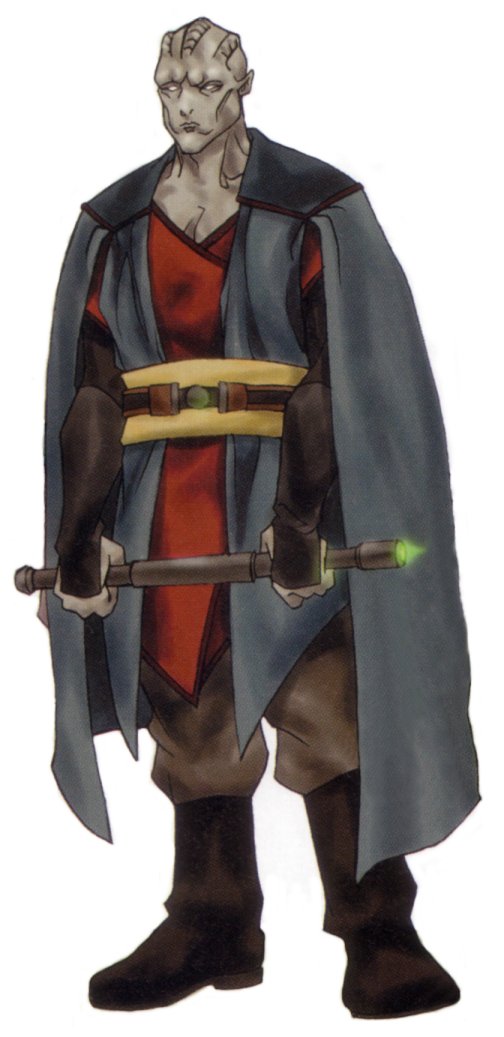
Personality:
Physical Description:
Homeworld:
Language:
Example Names:
Age In Years: Child 1-10; Young Adult 11-15; Adult 16-40; Middle Age 41-64; Old 65-79; Venerable 80+.
Adventurers:
Khommite Species Traits
- Ability Modifiers: +2 Constitution, +2 Intelligence, -2 Wisdom
- Size: As Medium creatures, they have no special modifiers due to their size.
- Speed: base speed of 10 meters
- Clone: Each Khommite represents generations of perfection in one particular field. Each one is the end of a long chain of identical Khommite clones that share the same character class. A Khommite may choose from the following list of heroic and professional classes: noble, scout, soldier, commoner, diplomat, expert, or thug. Using the multiclass rules, a Khommite can take levels of Force adept, Jedi consular, or Jedi guardian; however, Force-using Khommites are exceedingly rare (and the GM may disallow them as heroic Characters). If the Khommite takes any class other than his chosen class, he loses 10% of all experience gained from that point on.
- Free Language Skills: Read/Write and Speak Basic
Kian'thar
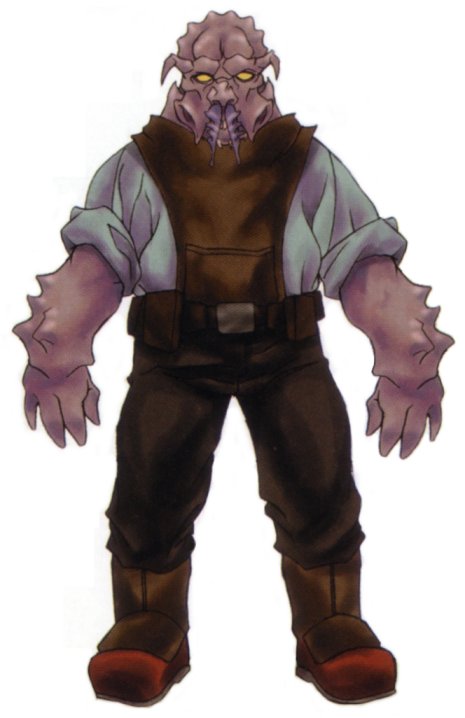
Personality:
Physical Description:
Homeworld:
Language:
Example Names:
Age In Years: Child 1-11; Young Adult 12-16; Adult 17-49; Middle Age 50-69; Old 70-84; Venerable 85+.
Adventurers:
Kian'thar Species Traits
- Ability Modifiers: -2 Dexterity, +2 Constitution, -2 Intelligence, +2 Wisdom
- Size: As Medium creatures, they have no special modifiers due to their size.
- Speed: base speed of 10 meters
- Empath: Kian'thar have the ability to sense other creatures' emotions. They gain a +4 species bonus on Bluff and Sense Motive checks targeting living beings within 10 meters, Force-using Kian'thar also gain a +4 species bonus on Friendship and Empathy checks against living beings within 10 meters.
- Natural Armor: Kian'thar have scaly hides. Kian'thar receive a +1 natural armor bonus to Defense.
- Bonus Feat: Kian'thar rely on beasts of burden to perform everyday tasks. Kian'thar receive the bonus feat Animal Affinity.
- Skill Bonus: Kian'thar receive a +4 species bonus on Swim checks.
- Free Language Skills: Read/Write and Speak Kian'thar, and Speak Basic
Kitonak
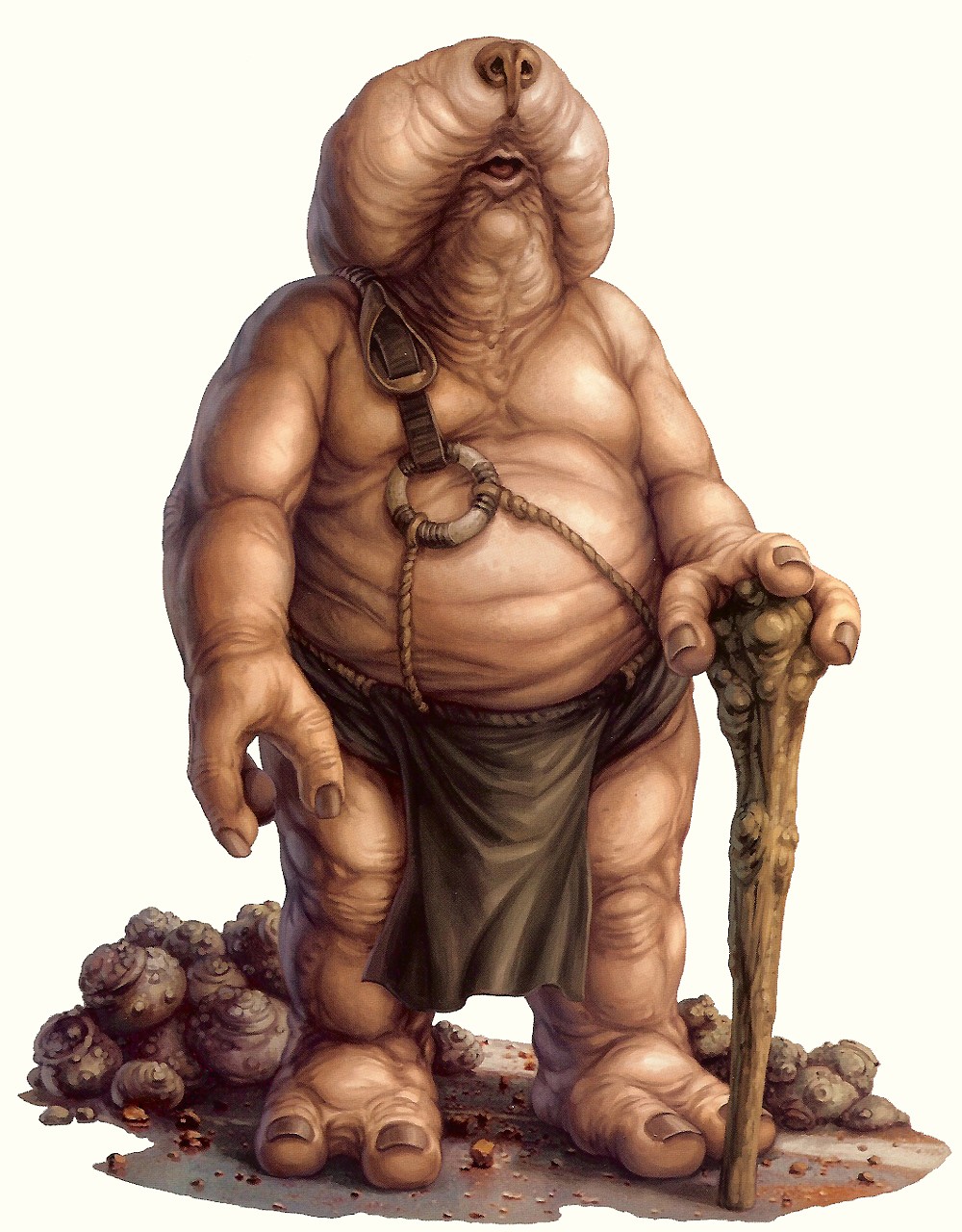
Personality:
Physical Description:
Homeworld:
Language:
Example Names:
Age In Years: Child 1-5; Young Adult 6-10; Adult 11-60; Middle Age 61-100; Old 101-120; Venerable 121+.
Adventurers:
Kitonak Species Traits
- Ability Modifiers: -2 Dexterity, +2 Constitution, +2 Wisdom, -2 Charisma
- Size: As Small creatures, they gain a +1 size bonus to their Defense, a +1 size bonus on attack rolls, and a +4 size bonus on Hide checks, and a –4 penalty when grappling. They must use smaller weapons than Medium-size beings use, and their lifting and carrying limits are three-quarters those of Medium-size characters.
- Speed: base speed of 6 meters
- Natural Armor: Kitonak have thick leathery skin. Kitonak receive a +2 natural armor bonus to Defense.
- Resistant to Persuasion: Other species take a -4 penalty on Bluff, Diplomacy, and Intimidate checks when dealing with a Kitonak.
- Slow Reaction: Kitonak react slowly, even on combat. Kitonak suffer a -2 penalty on initiative checks.
- Free Language Skills: Speak Kitonese
Klatooinian
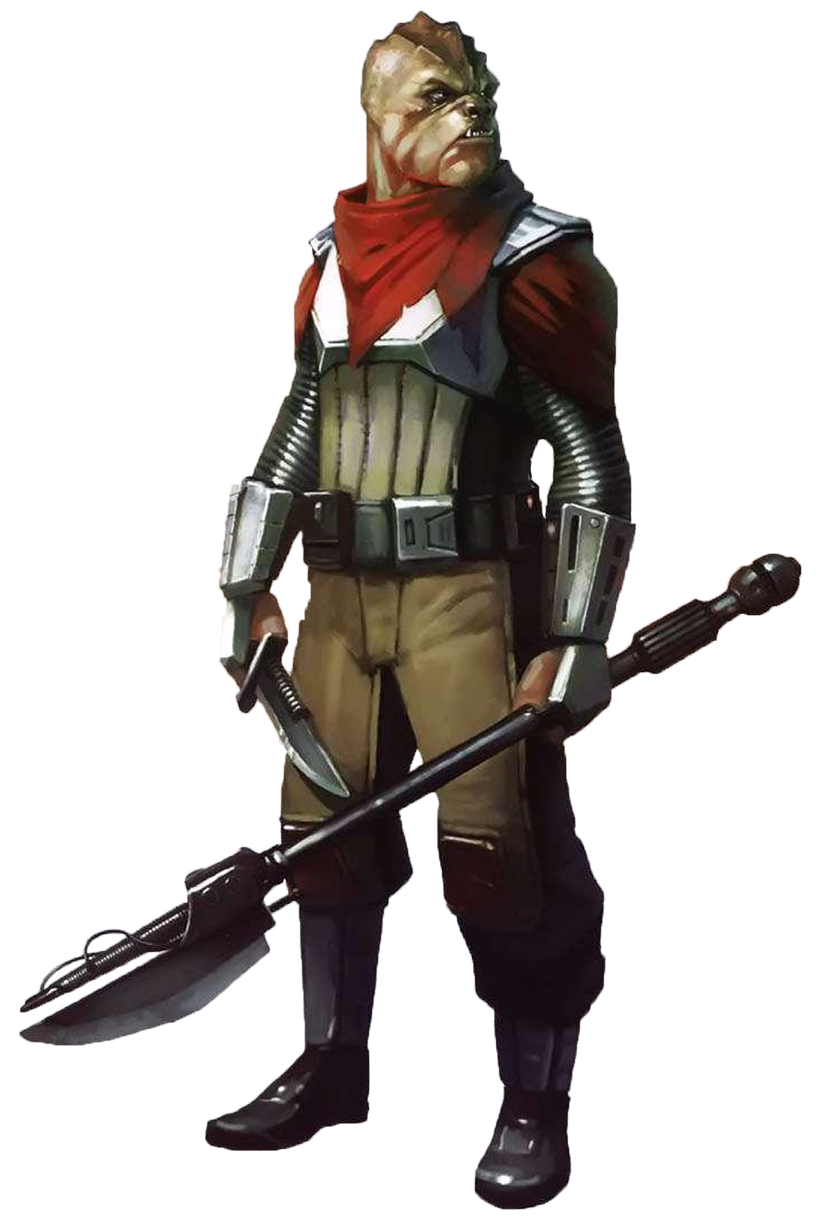
Personality:
Physical Description:
Homeworld:
Language:
Example Names:
Age In Years: Child 1-9; Young Adult 10-14; Adult 15-49; Middle Age 50-69; Old 70-89; Venerable 90+.
Adventurers:
Klatooinian Species Traits
- Ability Modifiers: +2 Constitution, -2 Intelligence
- Size: As Medium creatures, they have no special modifiers due to their size.
- Speed: base speed of 10 meters
- Strong-Willed: Klatooinians receive a +2 species bonus on Will saves.
- Free Language Skills: Speak Huttese
Koorivar
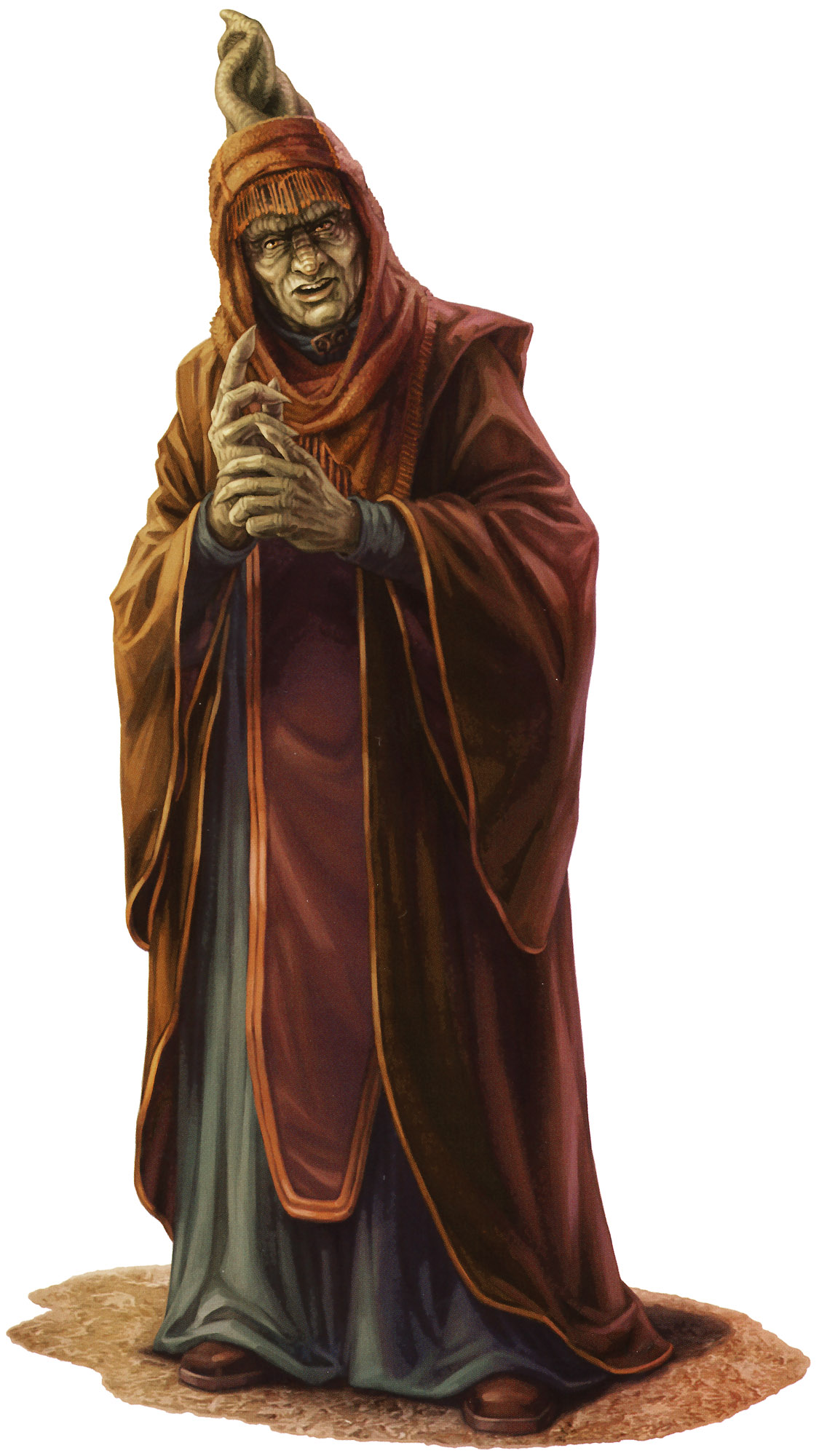
Personality:
Physical Description:
Homeworld:
Language:
Example Names:
Age In Years: Child 1-12; Young Adult 13-17; Adult 18-59; Middle Age 60-89; Old 90-124; Venerable 125+.
Adventurers:
Koorivar Species Traits
- Ability Modifiers: -2 Constitution, +2 Intelligence, +2 Charisma
- Size: As Medium creatures, they have no special modifiers due to their size.
- Speed: base speed of 10 meters
- Strong-Willed: Koorivars receive a +1 species bonus on Will saves.
- Wealthy: Koorivar roll an extra die when determining starting credits. For example, a 1st-level noble starts play with 2d4 x 1,000 credits instead of the standard 1d4 x 1,000.
- Skill Bonus: Koorivar are keen observers of behaviour and body language. Koorivar receive a +2 on species bonus on Sense Motive checks.
- Free Language Skills: Read/Write and Speak Koorivar
Krevaaki
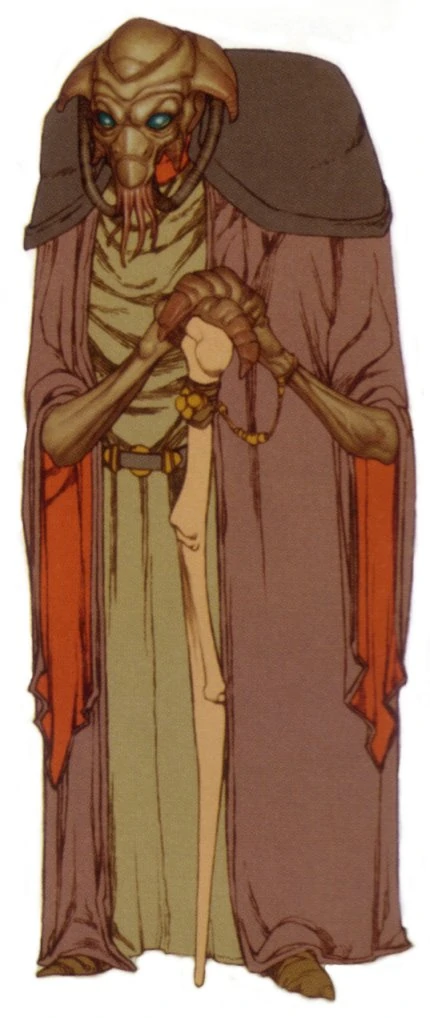
Personality:
Physical Description:
Homeworld:
Language:
Example Names:
Age In Years: Child 1-12; Young Adult 13-17; Adult 18-62; Middle Age 63-94; Old 95-129; Venerable 130+.
Adventurers:
Krevaaki Species Traits
- Ability Modifiers: +2 Wisdom, -2 Charisma
- Size: As Medium creatures, they have no special modifiers due to their size.
- Speed: base speed of 10 meters
- Natural Armor: Krevaaki have a shell that protect them. Krevaaki receive a +2 natural armor bonus to Defense.
- Resilient: Krevaaki gain a +1 species bonus on Fortitude saves.
- Stoic: A Krevaaki's face is a series of shifting, chitinous plates with a limited range of expressions. The sliding of these plates is noticeable but meaningless to non-Krevaaki. Other species take a -4 penalty on Sense Motive checks against Krevaaki during face-to-face communication.
- Tentacles: Krevaaki use their tentacles as bipeds use arms and legs. Krevaaki receive a +2 species bonus on Climb checks. In addition, Krevaaki who select the Martial Arts feat gain a +2 species bonus on grapple checks. The Krevaaki’s tentacles are fess dexterous than a humanoid hand, making some tasks difficult to perform. At the GM's discretion, Krevaaki take a -4 penalty on checks to manipulate small items such as coins or pebbles. Affected skills include Craft, Disable Device, and Repair. An appropriate set of tools for performing affected skills negates this penalty (in addition to providing its normal bonus).
- Free Language Skills: Read/Write and Speak Kreva
Krish
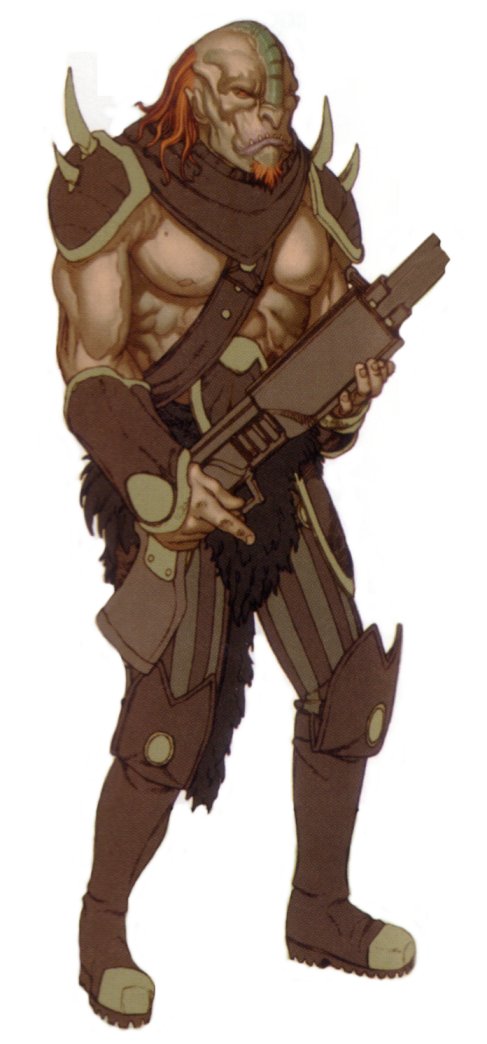
Personality:
Physical Description:
Homeworld:
Language:
Example Names:
Age In Years: Child 1-11; Young Adult 12-15; Adult 16-45; Middle Age 46-65; Old 66-84; Venerable 85+.
Adventurers:
Krish Species Traits
- Ability Modifiers: +2 Strength, -2 Intelligence, -2 Wisdom
- Size: As Medium creatures, they have no special modifiers due to their size.
- Speed: base speed of 10 meters
- Easily Distracted: Krish must succeed at a Will save (DC 10) to stay focused on the task at hand When the opportunity to solve a puzzle, play a game, or observe a contest presents itself. The GM can modify the DC depending on the urgency of the Krish's current business and the allure of the new prospect or distraction. If the Krish fails the save, they are dazed for I round (can't take actions but can defend normally). After that, the Krish can act normally but only participates in combat if threatened or attacked.
- Bonus Feat: (choose one) Krish receive the bonus feat Athletic, Gearhead, Headstrong, Stealthy, Toughness, Track, or Weapon Group Proficiency (any one).
- Skill Bonus: Krish receive a +2 species bonus on Gamble checks.
- Free Language Skills: Read/Write and Speak Krish
Kubaz
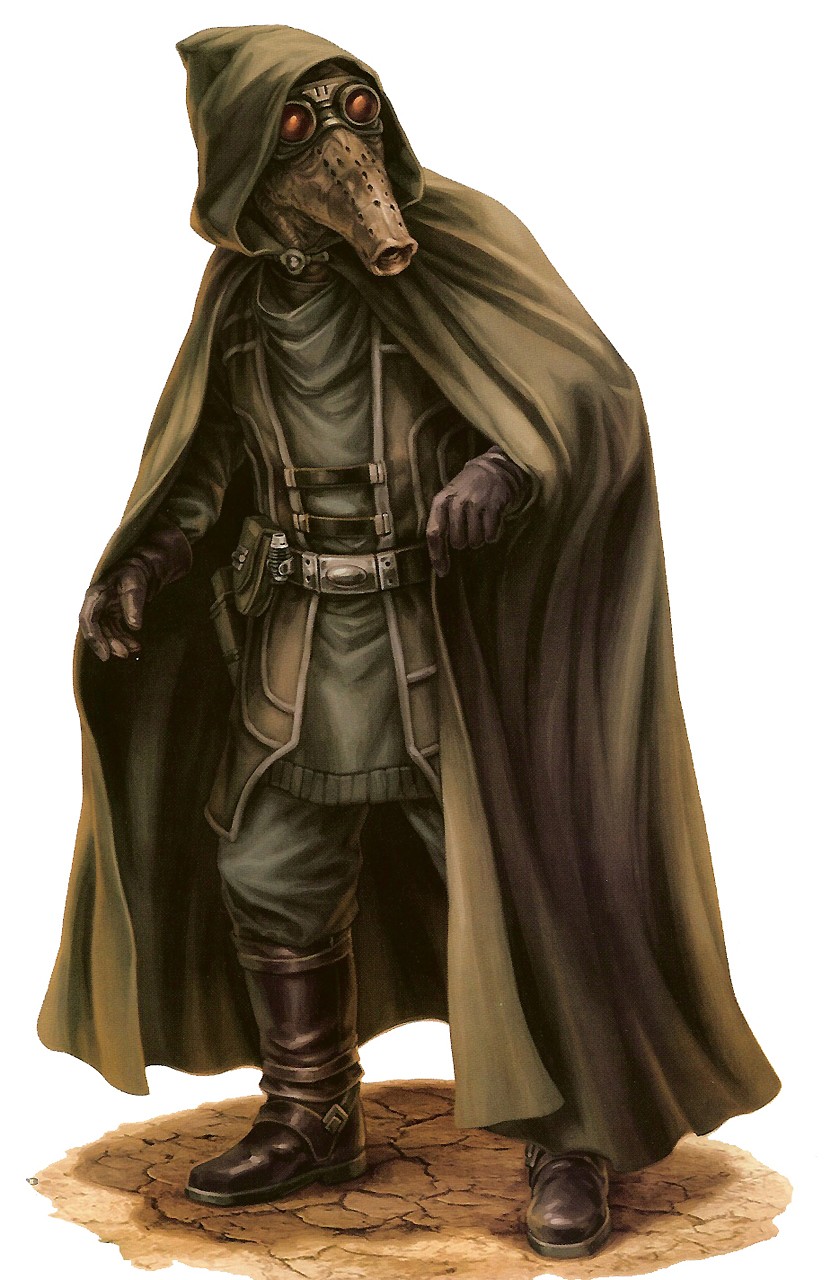
Personality:
Physical Description:
Homeworld:
Language:
Example Names:
Age In Years: Child 1-9; Young Adult 10-13; Adult 14-50; Middle Age 51-80; Old 81-99; Venerable 100+.
Adventurers:
Kubaz Species Traits
- Ability Modifiers: -2 Strength, +2 Dexterity
- Size: As Medium creatures, they have no special modifiers due to their size.
- Speed: base speed of 10 meters
- Light Sensitivity: Kubaz suffer a penalty on attack rolls, skill checks, and ability checks made when not wearing protective eye goggles. The penalty is -4 in normal light (such as daylight) and -2 in dim light (such as candlelight).
A Kubaz exposed to intense light without protective eye goggles is blinded for 2d6 hours (see the Character Condition Summary in Chapter Twelve of the Star Wars Roleplaying Game).
- Skill Bonus: Kubaz build elaborate networks of contacts to help them gather intelligence and acquire other useful information. Kubaz receive a +2 species bonus on Gather Information checks.
- Free Language Skills: Read/Write and Speak Kubaszi
Kushiban
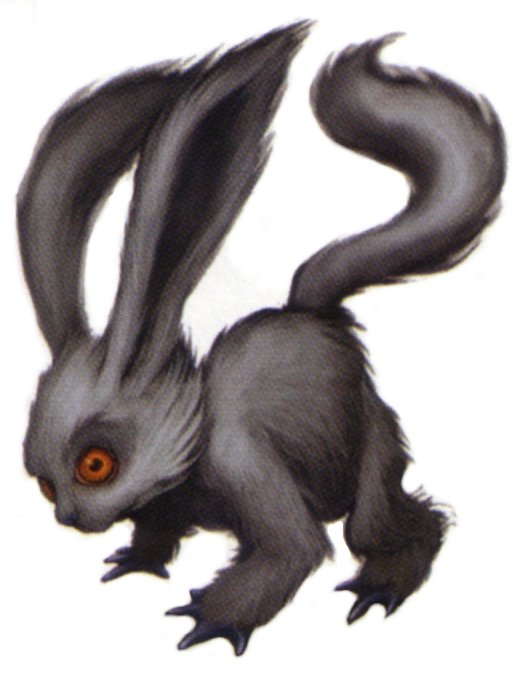 Kushibans are often mistaken for pets or vermin, when in fact they are an intelligent race with a complex, peaceful society.
Kushibans have little need for tools or technology on their homeworld, where they manage to live in almost complete harmony with their natural environment. Although preyed upon by large predators, Kushibans typically use fire to keep them at bay. As herbivores, they do not need tools for hunting or preparing food. As they eat most of their food uncooked, they have little use for cooking utensils or similar items. When Kushibans need shelter from the elements, simple leaves or tree hollows suffice. Consequently, Kushibans have little value to a spacefaring economy and little desire to leave their homeworld.
Kushibans have a unique method of expressing their feelings: Their normally white fur changes color with their emotional state. This 'mood fur can go completely black when the creature Is In deep despair.
Kushibans are often mistaken for pets or vermin, when in fact they are an intelligent race with a complex, peaceful society.
Kushibans have little need for tools or technology on their homeworld, where they manage to live in almost complete harmony with their natural environment. Although preyed upon by large predators, Kushibans typically use fire to keep them at bay. As herbivores, they do not need tools for hunting or preparing food. As they eat most of their food uncooked, they have little use for cooking utensils or similar items. When Kushibans need shelter from the elements, simple leaves or tree hollows suffice. Consequently, Kushibans have little value to a spacefaring economy and little desire to leave their homeworld.
Kushibans have a unique method of expressing their feelings: Their normally white fur changes color with their emotional state. This 'mood fur can go completely black when the creature Is In deep despair.
Personality: Kushibans are generous, gentle beings with a playful (usually wry) sense of humour. However, they can he vindictive and downright vicious when angered or betrayed. They have a low tolerance for bullies, simpletons, and misanthropes.
Physical Description: Kushibans are 0.5-meter-long lagomorphic creatures with soft white fur, floppy ears, front paws that can be used as hands, small keen noses, and large, innocent-looking eyes. They can move as either Quadrupeds or bipeds, though they must drop to all fours to charge or run.
Homeworld: Kushibah, a lush and unindustrialized planet in the Outer Rim.
Language: Kushibans speak and read Kushiban.
Example Names: Asani, Cerlyk, Etyk, Ikrit, Mabbik, Mirax, Pritsi, Sivvle, Tieko, Widdimur.
Age In Years: Child 1-5; Young Adult 6-12; Adult 13-59; Middle Age 60-84; Old 85-109; Venerable 110+.
Adventurers: Most Kushibans are content to remain on their homeworld. Only a few Kushiban scholars, explorers, and Jedi make prolonged trips across the galaxy.
Kushiban Species Traits
- Ability Modifiers: -4 Strength, +4 Dexterity
- Size: As Tiny creatures, they gain a +2 size bonus to their Defense, a +2 size bonus on attack rolls, and a +8 size bonus on Hide checks. They receive a –8 penalty when grappling, and they can't use any weapons larger than Small-sized, and their lifting and carrying limits are one-half those of Medium-size characters.
- Speed: base speed of 6 meters
- Mood Fur: A Kushiban's fur changes color to suit its mood. Any creature familiar with Kushibans gains a +2 circumstance bonus on Sense Motive checks made against a Kushiban when able to see its fur.
- Bonus Feat: Kushiban receive the bonus feat Improved Initiative.
- Skill Bonus: Kushiban receive a +4 specks bonus on Escape Artist and Jump checks.
- Free Language Skills: Read/Write and Speak Kushiban.
Lannik
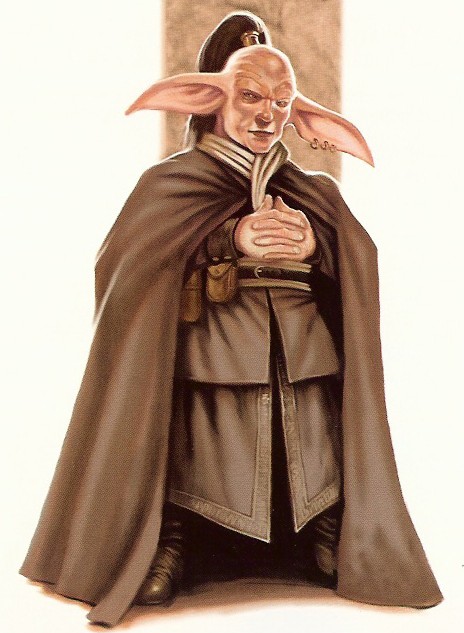
Personality:
Physical Description:
Homeworld:
Language:
Example Names:
Age In Years: Child 1-10; Young Adult 11-17; Adult 18-54; Middle Age 55-79; Old 80-99; Venerable 100+.
Adventurers:
Lannik Species Traits
- Ability Modifiers: +2 Dexterity, -2 Wisdom, -2 Charisma
- Size: As Small creatures, they gain a +1 size bonus to their Defense, a +1 size bonus on attack rolls, and a +4 size bonus on Hide checks, and a –4 penalty when grappling. They must use smaller weapons than Medium-size beings use, and their lifting and carrying limits are three-quarters those of Medium-size characters.
- Speed: base speed of 6 meters
- Fearless: Intimidate checks made against a Lannik suffer a -4 penalty. Lannik also receive a +2 species bonus on Will saves against fear-based effects (such as the Frightful Presence feat).
- Bonus Feat: Lannik receive the bonus feat Iron Will.
- Free Language Skills: Read/Write and Speak Basic and Lannik
Lepi
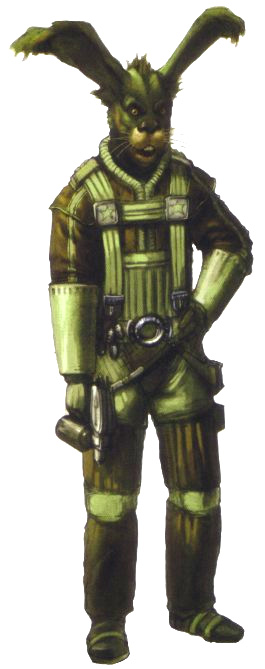
Personality:
Physical Description:
Homeworld:
Language:
Example Names:
Age In Years: Child 1-9; Young Adult 10-14; Adult 15-44; Middle Age 45-59; Old 60-74; Venerable 75+.
Adventurers:
Lepi Species Traits
- Ability Modifiers: -2 Strength, +2 Dexterity
- Size: As Medium creatures, they have no special modifiers due to their size.
- Speed: base speed of 10 meters
- Natural Weapon (Kick): A Lepi can kick as many times in a round as they have attacks. The kick deals 1d4 points of bludgeoning damage plus the Lepi's Strength modifier. The Lepi's kick attack does not provoke an attack of opportunity.
- Bonus Feat: Lepi receive the bonus feat Weapon Finesse (Kick).
- Skill Bonus: Lepi receive a +8 species bonus on Jump checks and +2 species bonus on Listen checks.
- Free Language Skills: Read/Write and Speak Lepi
Meerian
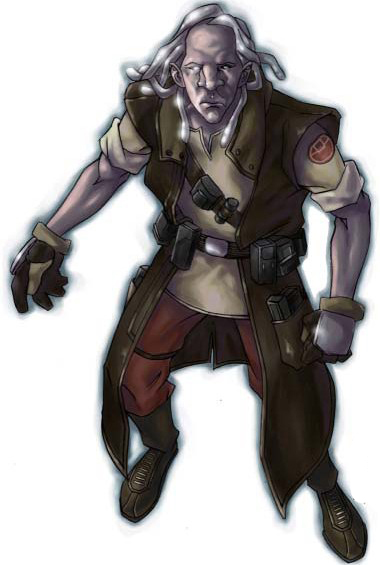 Meerians are small, wiry humanoids who move in a slow, deliberate manner. Their short stature and relative strength make them excellent miners. When Republic survey teams learned that the Meerians’ homeworld, Bandomeer, was rich with minerals, their discovery prompted hundreds of mining companies to begin pillaging the planet’s resources. The Meerians, primitive by galactic standards, had little sway with the Republic and their mining consortiums. Despite the Republic Senate’s recognition of the Meerians as the rightful owners of Bandomeer, the Meerians have earned nothing more than the right to help with the strip-mining and share the profits. Meerians continue to have little say in what happens to their world.
Meerians are small, wiry humanoids who move in a slow, deliberate manner. Their short stature and relative strength make them excellent miners. When Republic survey teams learned that the Meerians’ homeworld, Bandomeer, was rich with minerals, their discovery prompted hundreds of mining companies to begin pillaging the planet’s resources. The Meerians, primitive by galactic standards, had little sway with the Republic and their mining consortiums. Despite the Republic Senate’s recognition of the Meerians as the rightful owners of Bandomeer, the Meerians have earned nothing more than the right to help with the strip-mining and share the profits. Meerians continue to have little say in what happens to their world.
Hundreds of generations of mining on Bandomeer have forced the Meerians to adapt to the constant smog and particulate matter permeating the atmosphere. Their lungs and nose filter out the most harmful chemicals and toxins, allowing them to move around in areas where breath masks are normally required. Despite their resilience, Meerians want nothing more than to make Bandomeer a more hospitable home. They want to reduce the amount of mining and repair the damaged ecosphere, but to date their efforts have met with little success.
Meerians prefer to speak eye-to-eye and use comfortable seats with repulsorlifts when conversing with taller species. They believe that speaking eye-to-eye is one way to ensure that all participants in a conversation regard one another as equals.
Personality: Meerians are agreeable, optimistic, and sympathetic to the needs of others. They can see and appreciate opposing sides of an argument, which often makes it hard for Meerians to reach a decision or consensus without much debate or equivocation.
The apathy of the mining corporations has introduced an
“Every Meerian for himself” mentality into Meerian society—
an attitude unknown to previous generations. Several
Meerians who have embraced this philosophy have taken
their earnings and left Bandomeer, setting their sights on
the stars
The apathy of the mining corporations has introduced an “Every Meerian for himself” mentality into Meerian society—an attitude unknown to previous generations. Several Meerians who have embraced this philosophy have taken their earnings and left Bandomeer, setting their sights on the stars
Physical Description: Meerians have metallic hair, with pale silver and lustrous gold being the most prominent colours. Meerians lack pupils, and their eyes also retain a metallic hue, often matching the colour of their hair. Skin tone is pale, due to the lack of sunlight that makes it through the polluted sky of Bandomeer. Adult Meerians stand 1.1 to 1.6 meters tall.
Homeworld: Bandomeer, a mining world in the Outer Rim. One massive landmass and one enormous sea divide the planet nearly in half.
Language: Meerians speak and read Meerian. They can learn to speak Basic with no difficulty.
Example Names: GanFel, GilVog, HerZan, JegLor, LirTan, RonTha, SonTag, VeerTa, WinLos.
Age In Years: Child 1-12; Young Adult 13-15; Adult 16-44; Middle Age 45-59; Old 60-79; Venerable 80+.
Adventurers: Meerian adventurers tend to be fringers and scoundrels
Meerian Species Traits
- Ability Modifiers: -2 Dexterity, +2 Constitution
- Size: As Small creatures, they gain a +1 size bonus to their Defense, a +1 size bonus on attack rolls, and a +4 size bonus on Hide checks, and a –4 penalty when grappling. They must use smaller weapons than Medium-size beings use, and their lifting and carrying limits are three-quarters those of Medium-size characters.
- Speed: base speed of 6 meters
- Lung Filter: Meerian receive a +2 species bonus on Fortitude saves to resist ingested, contact, or injury poisons and a +4 species bonus on Fortitude saves to resist inhaled poisons and polluted air.
- Free Language Skills: Speak and Read/Write Meerian.
Menahuun
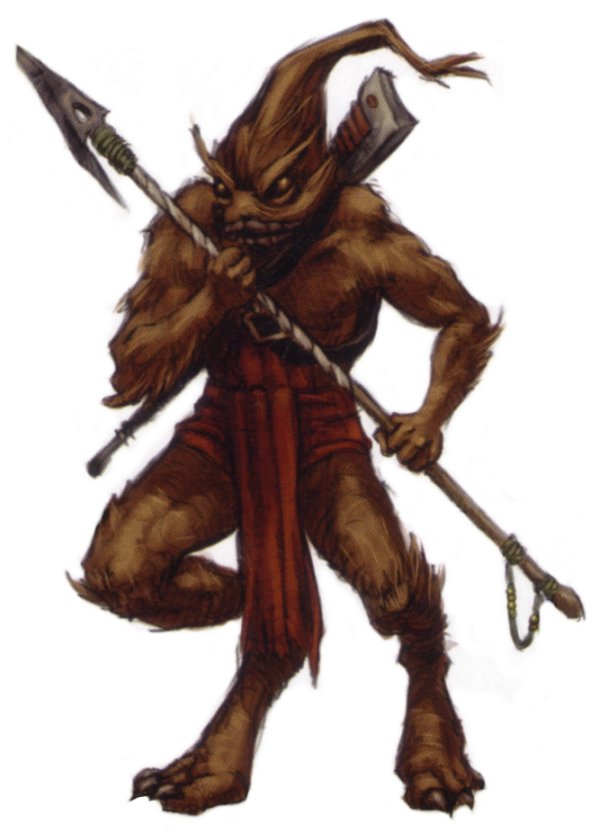
Personality:
Physical Description:
Homeworld:
Language:
Example Names:
Age In Years: Child 1-5; Young Adult 6-9; Adult 10-29; Middle Age 30-45; Old 46-54; Venerable 55+.
Adventurers:
Menahuun Species Traits
- Ability Modifiers: -2 Strength, +2 Dexterity, -2 Constitution, +2 Wisdom, -2 Charisma
- Size: As Small creatures, they gain a +1 size bonus to their Defense, a +1 size bonus on attack rolls, and a +4 size bonus on Hide checks, and a –4 penalty when grappling. They must use smaller weapons than Medium-size beings use, and their lifting and carrying limits are three-quarters those of Medium-size characters.
- Speed: base speed of 6 meters
- Primitive: Menahuun with heroic or professional classes receive the bonus feats Weapon Group Proficiency (primitive weapons) and Weapon Group Proficiency (simple weapons) instead of the usual Weapon Group Proficiency bonus feats.
- Bonus Feat: Menahuun receive the bonus feat Alertness.
- Skill Bonus: Menahuun receive a +4 species bonus on Climb checks and a +2 species bonus on Survival checks.
- Free Language Skills: Read/Write and Speak Menahu
Miraluka
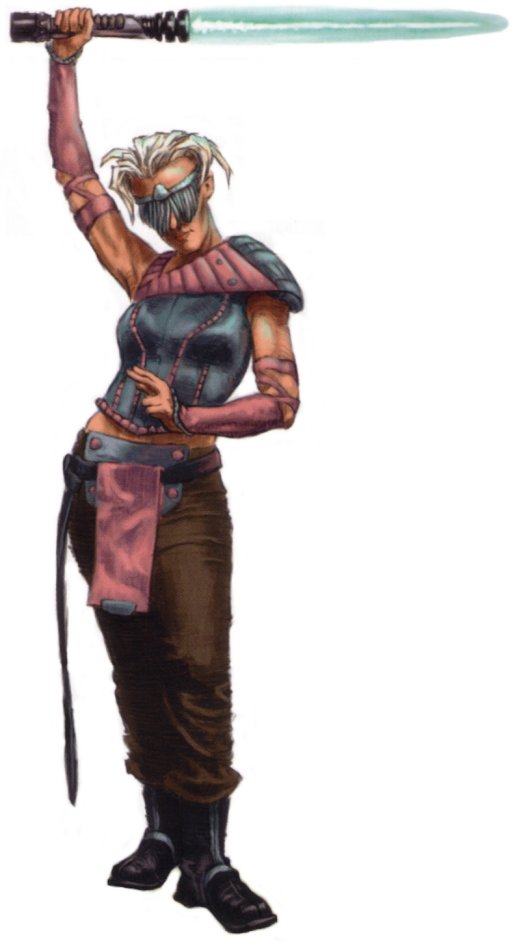
Personality:
Physical Description:
Homeworld:
Language:
Example Names:
Age In Years: Child 1-11; Young Adult 12-15; Adult 16-44; Middle Age 45-69; Old 70-84; Venerable 85+.
Adventurers:
Miraluka Species Traits
- Ability Modifiers: -2 Dexterity, +2 Intelligence
- Size: As Medium creatures, they have no special modifiers due to their size.
- Speed: base speed of 10 meters
- Force Sight: Miraluka are blind to all wavelengths of light. However, their ability to see through the Force allows them to sense their surroundings as though they could see normally, allowing them to attack and make skill checks without suffering penalties for blindness.
Using Force Sight is a free action and costs a Miraluka no vitality points. - Quick Reaction: Despite their general lack of coordination, a Miraluka's reaction speed is superior to that of most other species. Miraluka gain a +2 species bonus on initiative checks.
- Bonus Feat: Miraluka receive the bonus feat Force-Sensitive. When taking first level in a force using class also gets the bonus feat Sense.
- Free Language Skills: Read/Write and Speak Miralukese
Mon Calamari

Personality:
Physical Description:
Homeworld:
Language:
Example Names:
Age In Years: Child 1-11; Young Adult 12-16; Adult 17-40; Middle Age 41-57; Old 58-79; Venerable 80+.
Adventurers:
Mon Calamari Species Traits
- Ability Modifiers: -2 Constitution, +2 Intelligence
- Size: As Medium creatures, they have no special modifiers due to their size.
- Speed: Base speed is 10 meters on land and 6 meters in the water
- Breathe Underwater: As amphibious creatures, Mon Calamari can't drown in water. They gain a +4 species bonus on Swim checks.
- Environmental Adaptation: Mon Calamari gain a +1 species bonus on Will saving throws when in moist or watery environments,but they take a -1 penalty on Will saving throws in dry or arid environments.
- Low-Light Vision: Mon Calamari can see twice as far as normal in dim light, and retain the ability to distinguish color and detail under these conditions.
- Skill Bonus: Mon Calamari receive a +4 species bonus on Craft checks relating to one chosen subgroup (suchas droids, electronic devices, or medpacs).
- Free Language Skills: Read/Write and Speak Basic and Mon Calamarian
Morseerian
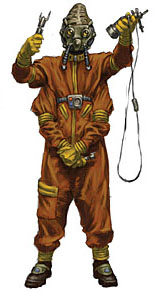
Personality:
Physical Description:
Homeworld:
Language:
Example Names:
Age In Years: Child 1-12; Young Adult 13-17; Adult 18-43; Middle Age 44-68; Old 69-79; Venerable 80+.
Adventurers:
Morseerian Species Traits
- Ability Modifiers: None
- Size: As Medium creatures, they have no special modifiers due to their size.
- Speed: base speed of 10 meters
- Extra Limbs (4): Morseerian have four arms. The extra limbs give them a +4 species bonus on Climb checks and grapple checks.
A Morseerian has one primary hand and three off hands. A Morseerian can wield up to four weapons, but the normal penalties for fighting with multiple weapons apply (see the Multiweapon Fighting feat description). - Methane-breather: A Morseerian in a non-methane-rich atmosphere without a protective environmental suit can breathe for a number of rounds equal to their Constitution score before they needs to make Constitution checks to avoid suffocation (see Suffocation and Drowning in Chapter Twelve of the Star Wars Roleplaying Game).
- Bonus Feat: Morseerian receive the bonus feat Multidexterity. They ignore the prerequisites.
- Free Language Skills: Read/Write and Speak Morseerian.
Mrlssi
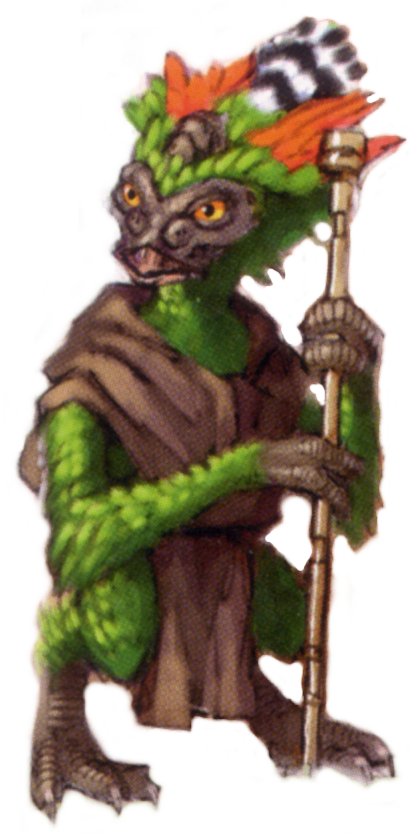
Personality:
Physical Description:
Homeworld:
Language:
Example Names:
Age In Years: Child 1-4; Young Adult 5-8; Adult 9-35; Middle Age 36-69; Old 70-89; Venerable 90+.
Adventurers:
Mrlssi Species Traits
- Ability Modifiers: -4 Strength, -2 Constitution, +4 Intelligence, +2 Wisdom, +2 Charisma
- Size: As Small creatures, they gain a +1 size bonus to their Defense, a +1 size bonus on attack rolls, and a +4 size bonus on Hide checks, and a –4 penalty when grappling. They must use smaller weapons than Medium-size beings use, and their lifting and carrying limits are three-quarters those of Medium-size characters.
- Speed: base speed of 6 meters
- Natural Weapons (Claws): Mrlssi have sharp claws that allow them to make unarmed attacks without provoking attacks of opportunity. As an attack action, a Mrlssi can make one claw attack (with no penalty) or combine its primary claw attack with off-hand claw attacks (suffering the normal penalties for multiweapon fighting). Each claw deals 1d6 points of slashing damage plus the Mrlssi's Strength modifier.
- Skill Bonus: Mrlssi have excellent eyesight. Mrlssi receive +8 species bonus on Spot checks.
- Free Language Skills: Read/Write and Speak Mrlsstese
Muun
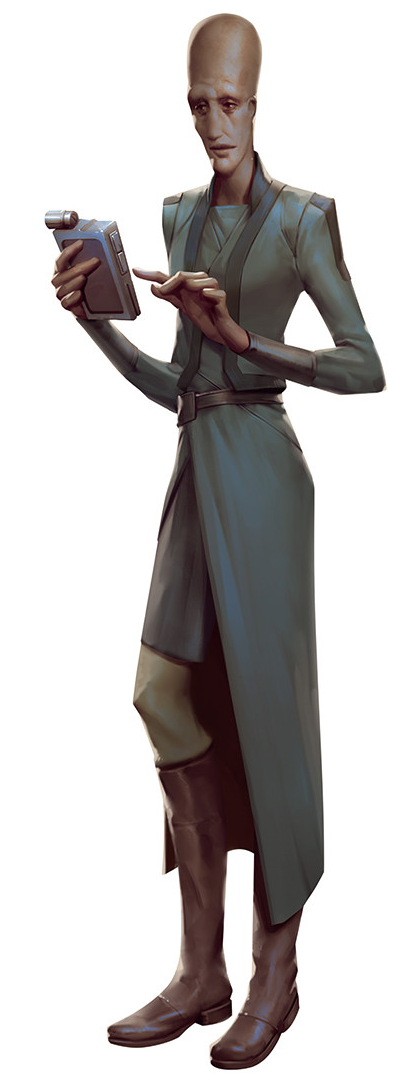
Personality:
Physical Description:
Homeworld:
Language:
Example Names:
Age In Years: Child 1-10; Young Adult 11-15; Adult 16-50; Middle Age 51-79; Old 80-94; Venerable 95+.
Adventurers:
Muun Species Traits
- Ability Modifiers: -2 Strength, +4 Intelligence
- Size: As Medium creatures, they have no special modifiers due to their size.
- Speed: base speed of 10 meters
- Skill Bonus: Muun receive +2 species bonus Appraise, Knowledge (business), and Profession (merchant) checks, but only have 1 or more ranks in the appropriate skill. When haggling over price, Muuns gain a +4 species bonus on Diplomacy checks.
- Free Language Skills: Read/Write and Speak Muun
Myneyrsh
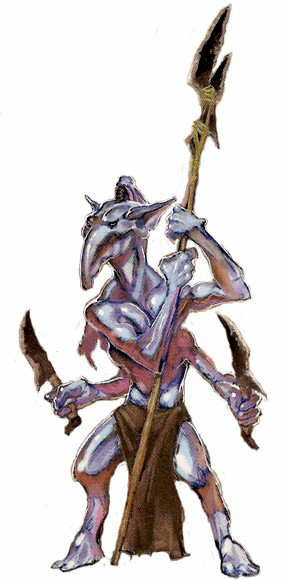
Personality:
Physical Description:
Homeworld:
Language:
Example Names:
Age In Years: Child 1-12; Young Adult 13-17; Adult 18-49; Middle Age 50-69; Old 70-84; Venerable 85+.
Adventurers:
Myneyrsh Species Traits
- Ability Modifiers: -2 Intelligence, +2 Wisdom
- Size: As Medium creatures, they have no special modifiers due to their size.
- Speed:
- Extra Limbs (4): Myneyrsh have four arms. The extra limbs give them a +4 species bonus on Climb checks and grapple checks.
A Myneyrsh has one primary hand and three off hands. A Myneyrsh can wield up to four weapons, but the normal penalties for fighting with multiple weapons apply (see the Multiweapon Fighting feat description). - Natural Armor: Myneyrsh have crystalline flesh. Myneyrsh receive a +2 natural armor bonus to Defense.
- Primitive: Myneyrsh with heroic or professional classes receive the bonus feats Weapon Group Proficiency (primitive weapons) and Weapon Group Proficiency (simple weapons) instead of the usual Weapon Group Proficiency bonus feats.
- Technophobia: Myneyrsh suffer a -4 penalty on skill checks requiring or involving technological devices such as computers, blasters, vehicles and starships.
- Bonus Feat: Myneyrsh receive the bonus feat Alertness and Stealthy.
- Free Language Skills: Speak Myneyrsh and Psadan
Nagai
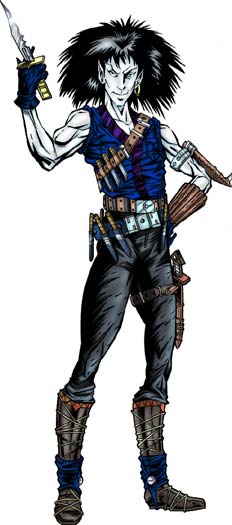
Personality:
Physical Description:
Homeworld:
Language:
Example Names:
Age In Years: Child 1-11; Young Adult 12-18; Adult 19-44; Middle Age 45-60; Old 61-74; Venerable 75+.
Adventurers:
Nagai Species Traits
- Ability Modifiers: +2 Dexterity, -2 Intelligence
- Size: As Medium creatures, they have no special modifiers due to their size.
- Speed: base speed of 10 meters
- Soothing Voice: At will a Nagai can use their voice to influence other sentient aliens. A Nagai gains a +2 species bonus on Bluff, Diplomacy, Gather Information, and Intimidate checks provided the target can hear and under-stand the Nagai’s words.
- Bonus Feat: Nagai receive the bonus feat Lightning Reflexes.
- Free Language Skills: Read/Write and Speak Nagaian
Nautolan
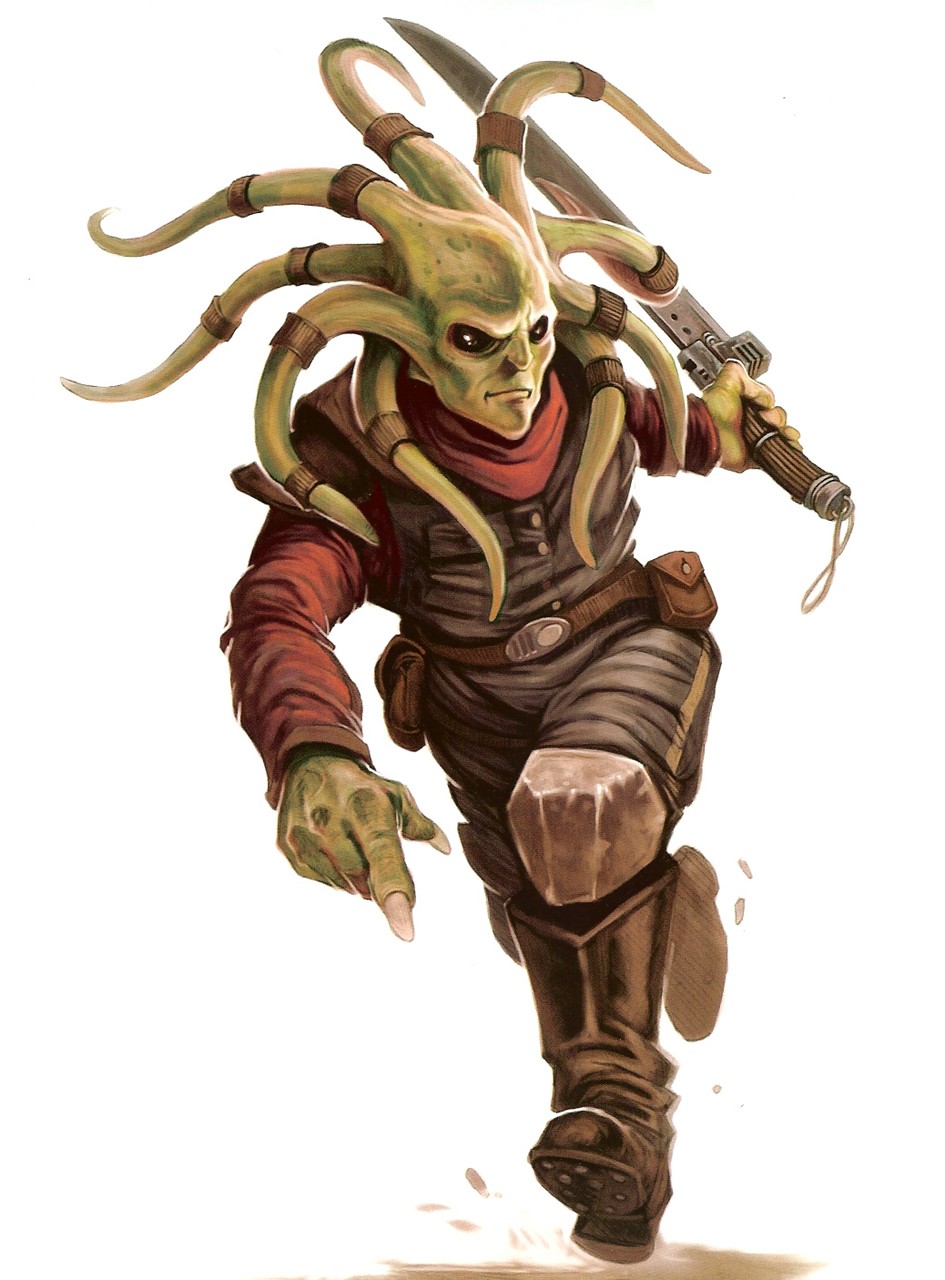
Personality:
Physical Description:
Homeworld:
Language:
Example Names:
Age In Years: Child 1-9; Young Adult 10-14; Adult 15-40; Middle Age 41-54; Old 55-69; Venerable 70+.
Adventurers:
Nautolan Species Traits
- Ability Modifiers: +2 Constitution, -2 Intelligence
- Size: As Medium creatures, they have no special modifiers due to their size.
- Speed: Base speed 10 meters on land and 6 meters in water
- Breathe Underwater: As amphibious creatures, Nautolan can't drown in water. They gain a +4 species bonus on Swim checks.
- Low-Light Vision: Nautolan can see twice as far as normal in dim light, and retain the ability to distinguish color and detail under these conditions.
- Natural Armor: Nautolan have rubbery hides. Nautolan receive a +1 natural armor bonus to Defense.
- Pheromonal Sensor: Nautolan use their tendrils to sense others' moods. They gain a +4 species bonus on Sense Motive checks while in water; the bonus drops to +1 out of water.
- Free Language Skills: Read/Write and Speak Nautila
Nazzar
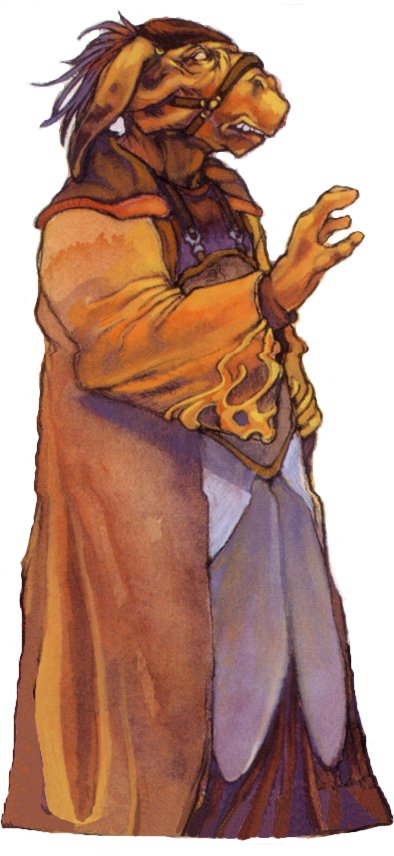
Personality:
Physical Description:
Homeworld:
Language:
Example Names:
Age In Years: Child 1-11; Young Adult 12-17; Adult 18-55; Middle Age 56-89; Old 90-124; Venerable 125+.
Adventurers:
Nazzar Species Traits
- Ability Modifiers: +2 Strength, +2 Dexterity, -2 Wisdom, -4 Charisma
- Size: As Medium creatures, they have no special modifiers due to their size.
- Speed: base speed of 10 meters
- Free Language Skills: Read/Write and Speak Nazzar
Neimoidian
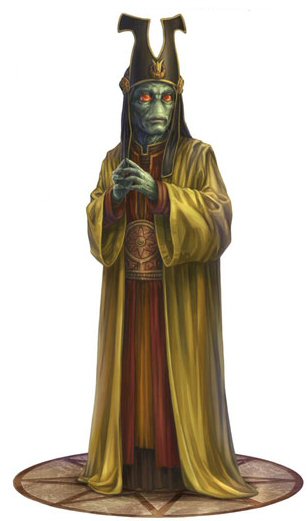
Personality:
Physical Description:
Homeworld:
Language:
Example Names:
Age In Years: Child 1-11; Young Adult 12-16; Adult 17-40; Middle Age 41-57; Old 58-79; Venerable 80+.
Adventurers:
Neimoidian Species Traits
- Ability Modifiers: -2 Strength, +2 Intelligence, +2 Wisdom, -2 Charisma
- Size: As Medium creatures, they have no special modifiers due to their size.
- Speed: base speed of 10 meters
- Skill Bonus: Neimoidian are shrewd and deceitful. Neimoidian receive +2 species bonus on Appraise and Bluff checks.
- Free Language Skills: Read/Write and Speak Neimoidian and Pak Pak (nonverbal language)
Neti
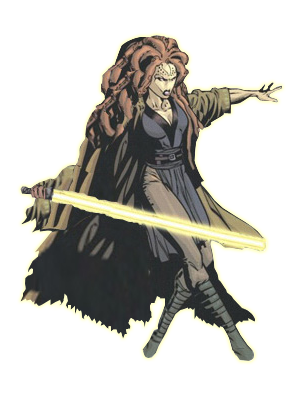
Personality:
Physical Description:
Homeworld:
Language:
Example Names:
Age In Years: Child 1-11; Young Adult 12-59; Adult 60-1999; Middle Age 2000-1499; Old 1500-3999; Venerable 4000+.
Adventurers:
Neti Species Traits
- Ability Modifiers: -4 Dexterity, +2 Constitution, +2 Intelligence, +2 Wisdom
- Size: As Medium creatures, they have no special modifiers due to their size.
- Speed: base speed of 10 meters
- Camouflage: In its treelike form, Neti gain a +8 circumstance bonus on hide checks whenconcealed among trees and similar foliage.
- Metamorph: A Neti has the innate ability to alter its shape and size at will. A Neti can vary its size anywhere from Medium-size to Huge. A Neti can also after its form to be roughly humanoid, squat and quadrupedal, or solid and treelike. Changing size and shape is a full-round action.
Even in quadrupedal or treelike form, a Neti has manipulative tendrils to operate tools and make attacks. A Neti in quadrupedal form is more difficult to trip or move with a bantha rush (receiving a +4 stability bonus on rolls to resist these effects), but it cannot run or charge. A Neti in its stationary tree form is extremely resistant to these attacks (+12 stability bonus on all rolls to oppose bantha rushes and trips), but it is immobile.
The extra wound points a Neti gains for being Huge disappear if it assumes a smaller form. A Neti that takes 12 or more points of wound damage in Huge form cannot reduce its size until healed. - Photosynthesis: As plants, Neti have no need for food. They have a greatly reduced need for water as long as they have regular access to broad-spectrum light. A Neti needs only one-tenth the water of most races, but if deprived of sunlight, it starves, much as other races do when lacking food. A Neti with the Control feat that enters a Force trance can survive almost indefinitely in an area with natural sunlight and rain.
- Variable Size: As Medium-size creatures, Neti have no special modifiers due to their size.
As large creatures, Neti suffer a -1 size penalty on Defense, a -1 size penalty on attack rolls, and a -4 penalty on Hide checks. They have a Face/Reach of 2 m by 2 m/4 m in humanoid or treelike form, 2m by 4 m/2 m in in quadrupedal form. Their lifting and carrying limits are double those of Medium-size characters.
As Huge creatures, Neti suffer a -2 size penalty on Defense, a -2 size penalty on attack rolls, and a -8 penalty on hide checks. They have a Face/Reach of 4 m by 4 m/6 m. Their lifting and carrying limits are quadruple those of Medium-size characters. - Free Language Skills: Read/Write and Speak Neti
Nimbanel
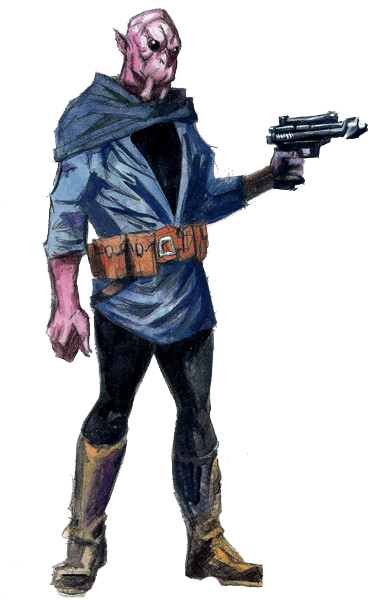
Personality:
Physical Description:
Homeworld:
Language:
Example Names:
Age In Years: Child 1-12; Young Adult 13-16; Adult 17-45; Middle Age 46-64; Old 65-79; Venerable 80+.
Adventurers:
Nimbanel Species Traits
- Ability Modifiers: +2 Intelligence, -2 Wisdom
- Size: As Medium creatures, they have no special modifiers due to their size.
- Speed: base speed of 10 meters
- Skill Bonus: Nimbanel receive +2 species bonus on Computer Use checks and a +4 species bonus on Knowledge (bureaucracy) checks.
- Free Language Skills: Read/Write and Speak Nimbanese, and Speak Huttese
Noehon
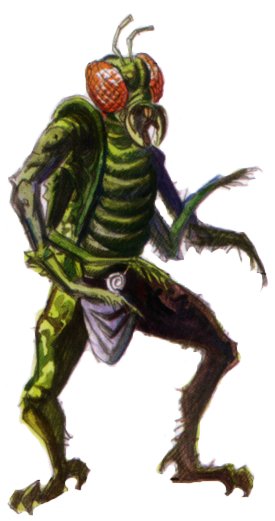
Personality:
Physical Description:
Homeworld:
Language:
Example Names:
Age In Years: Child 1-2; Young Adult 3-4; Adult 5-24; Middle Age 25-37; Old 38-44; Venerable 45+.
Adventurers:
Noehon Species Traits
- Ability Modifiers: +2 Dexterity, -2 Intelligence, -2 Charisma
- Size: As Small creatures, they gain a +1 size bonus to their Defense, a +1 size bonus on attack rolls, and a +4 size bonus on Hide checks, and a –4 penalty when grappling. They must use smaller weapons than Medium-size beings use, and their lifting and carrying limits are three-quarters those of Medium-size characters.
- Speed: Base speed of 6 meters. They also have a climb speed of 6 meters.
- Extra Limbs (4): Noehon have four arms. The extra limbs give them a +4 species bonus on Climb checks and grapple checks.
A Noehon has one primary hand and three off hands. A Noehon can wield up to four weapons, but the normal penalties for fighting with multiple weapons apply (see the Multiweapon Fighting feat description). - Limited Linguist: Noehon who wish to speak a language other than their own must spend 2 skill points (instead of the usual 1 skill point) to acquire the applicable Speak Language skill.
- Musk: Noehon musk is an overpowering scent that lingers indefinitely. Removing the scent from oneself or an item requires 3d10 days of regular washing.
- Bonus Feat: Noehon receive the bonus feat Multidexterity. They ignore the prerequisites.
- Skill Bonus: Noehon receive +8 species bonus on Climb checks and can always choose to take 10 on such checks.
- Free Language Skills: Speak Noehonese
Noghri
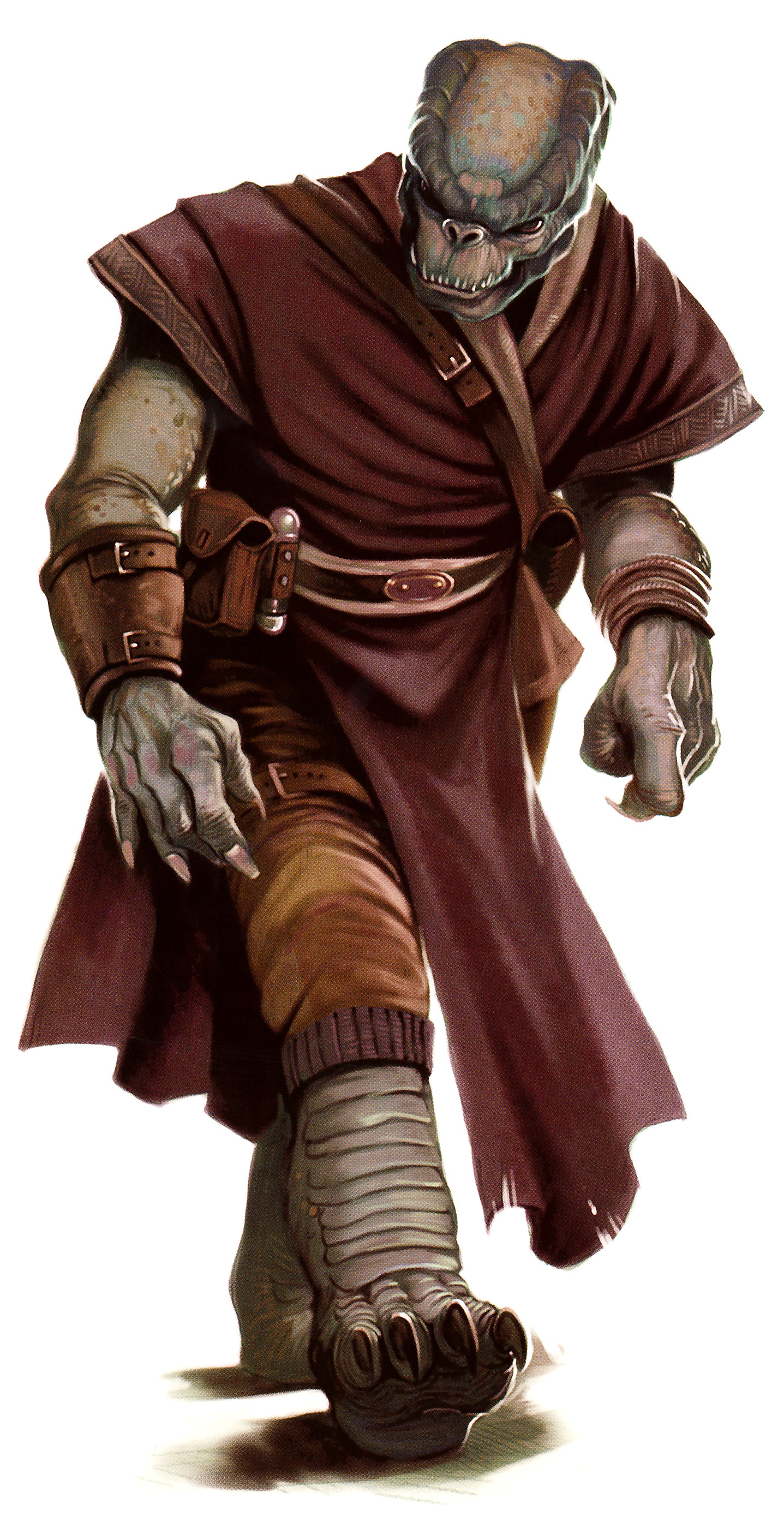
Personality:
Physical Description:
Homeworld:
Language:
Example Names:
Age In Years: Child 1-8; Young Adult 9-12; Adult 13-44; Middle Age 45-59; Old 60-74; Venerable 75+.
Adventurers:
Noghri Species Traits
- Ability Modifiers: +2 Dexterity, +2 Wisdom, -4 Charisma
- Size: As Small creatures, they gain a +1 size bonus to their Defense, a +1 size bonus on attack rolls, and a +4 size bonus on Hide checks, and a –4 penalty when grappling. They must use smaller weapons than Medium-size beings use, and their lifting and carrying limits are three-quarters those of Medium-size characters.
- Speed: base speed of 6 meters
- Keen Smell: A Noghri can identify an individual by smell at a range of 10 meters with a successful Wisdom check (DC 10). The range increases to 20 meters if the individual is upwind and drops to 6 meters if the individual is downwind. the Noghri has never encountered the individual before, a successful Wisdom check reveals only the individual's species or some scent unique to that individual (which will allow the Noghri to recognize the individual in the future).
- Primitive: Noghri with heroic or professional classes receive the bonus feats Weapon Group Proficiency (primitive weapons) and Weapon Group Proficiency (simple weapons) instead of the usual Weapon Group Proficiency bonus feats.
- Free Language Skills: Read/Write and Speak Honoghran (Noghrese)
Nosaurian
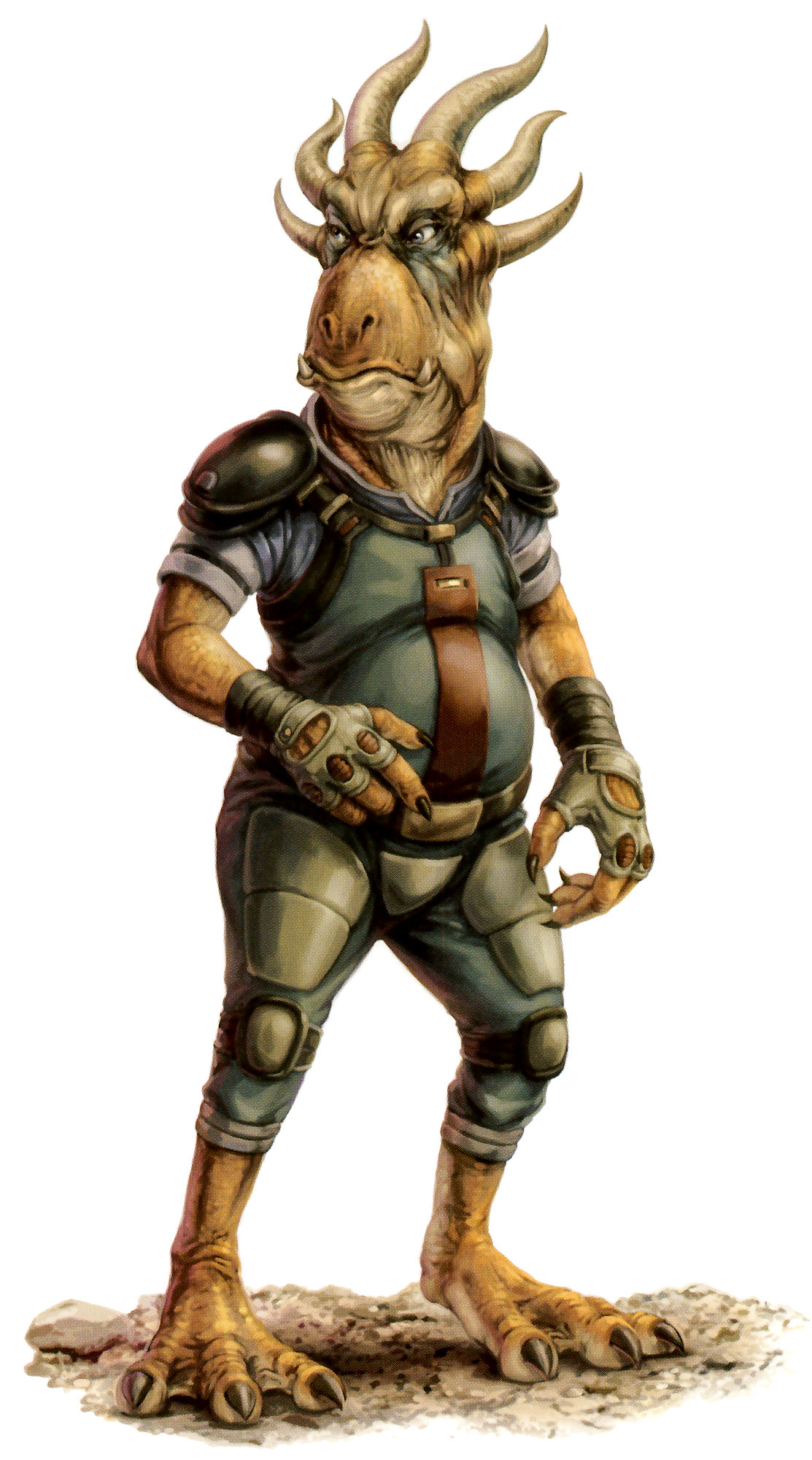
Personality:
Physical Description:
Homeworld:
Language:
Example Names:
Age In Years: Child 1-10; Young Adult 11-15; Adult 16-45; Middle Age 46-79; Old 80-99; Venerable 100+.
Adventurers:
Nosaurian Species Traits
- Ability Modifiers: +2 Dexterity, -2 Charisma
- Size: As Medium creatures, they have no special modifiers due to their size.
- Speed: base speed of 10 meters
- Natural Weapon (Horns): Nosaurian can gore with its horns instead of making an unarmed strike. The gore attack deal 1d6 points of piercing damage plus the Nosaurian’s Strength modifier. The gore attack does not provoke attacks of opportunity. A Nosaurian who charges an opponent and scores a hit deals double damage with its gore attack.
- Skill Bonus: Nosaurian receive +2 species bonus of Climb and Survival checks.
- Free Language Skills: Read/Write and Speak Nosaurian
Nuknog
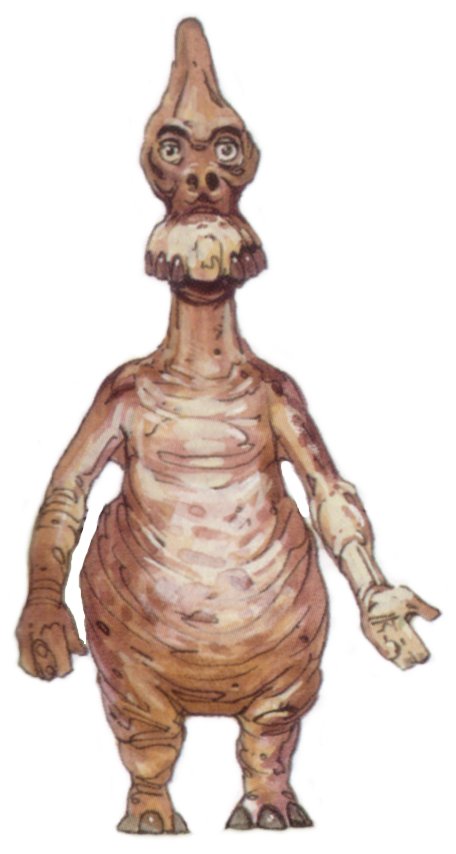
Personality:
Physical Description:
Homeworld:
Language:
Example Names:
Age In Years: Child 1-11; Young Adult 12-16; Adult 17-35; Middle Age 36-49; Old 50-64; Venerable 65+.
Adventurers:
Nuknog Species Traits
- Ability Modifiers: +2 Dexterity, -2 Intelligence, -2 Wisdom
- Size: As Small creatures, they gain a +1 size bonus to their Defense, a +1 size bonus on attack rolls, and a +4 size bonus on Hide checks, and a –4 penalty when grappling. They must use smaller weapons than Medium-size beings use, and their lifting and carrying limits are three-quarters those of Medium-size characters.
- Speed: base speed of 6 meters
- Rush: Nuknog can temporarily improve their agility, reflexes, and speed. A rushing Nuknog gains a temporary +4 Dexterity (which improves his Defense, ranged attacks, Reflex saves, and Dexterity-based skills) and moves at twice the normal speed (12 meters). While using this ability, the Nuknog cannot use skills that require patience and concentration, such as Move Silently, Combat Expertise, or any Force-based skill. A rush lasts for a number of rounds equal to 5 + the Nuknog's Constitution modifier. At the end of this duration, the Nuknog loses the benefits of the rush and is fatigued (-2 Strength and Dexterity; can't run or charge) for a number of rounds equal to the rush's duration.
A Nuknog can use the rush ability a number of times per day equal to 3 + the Nuknog's Constitution modifier. - Skill Bonus: Nuknog have acute senses. Nuknog receive +2 species bonus on Listen, Search, and Spot checks.
- Free Language Skills: Read/Write and Speak Nuknog
Omwati

Personality:
Physical Description:
Homeworld:
Language:
Example Names:
Age In Years: Child 1-12; Young Adult 13-17; Adult 18-40; Middle Age 41-65; Old 66-84; Venerable 85+.
Adventurers:
Omwati Species Traits
- Ability Modifiers: -2 Strength, +2 Intelligence, +2 Wisdom
- Size: As Medium creatures, they have no special modifiers due to their size.
- Speed: base speed of 10 meters
- Bonus Feat: Omwati receive the bonus feat Gearhead.
- Free Language Skills: Read/Write and Speak Omwatese
Ortolan
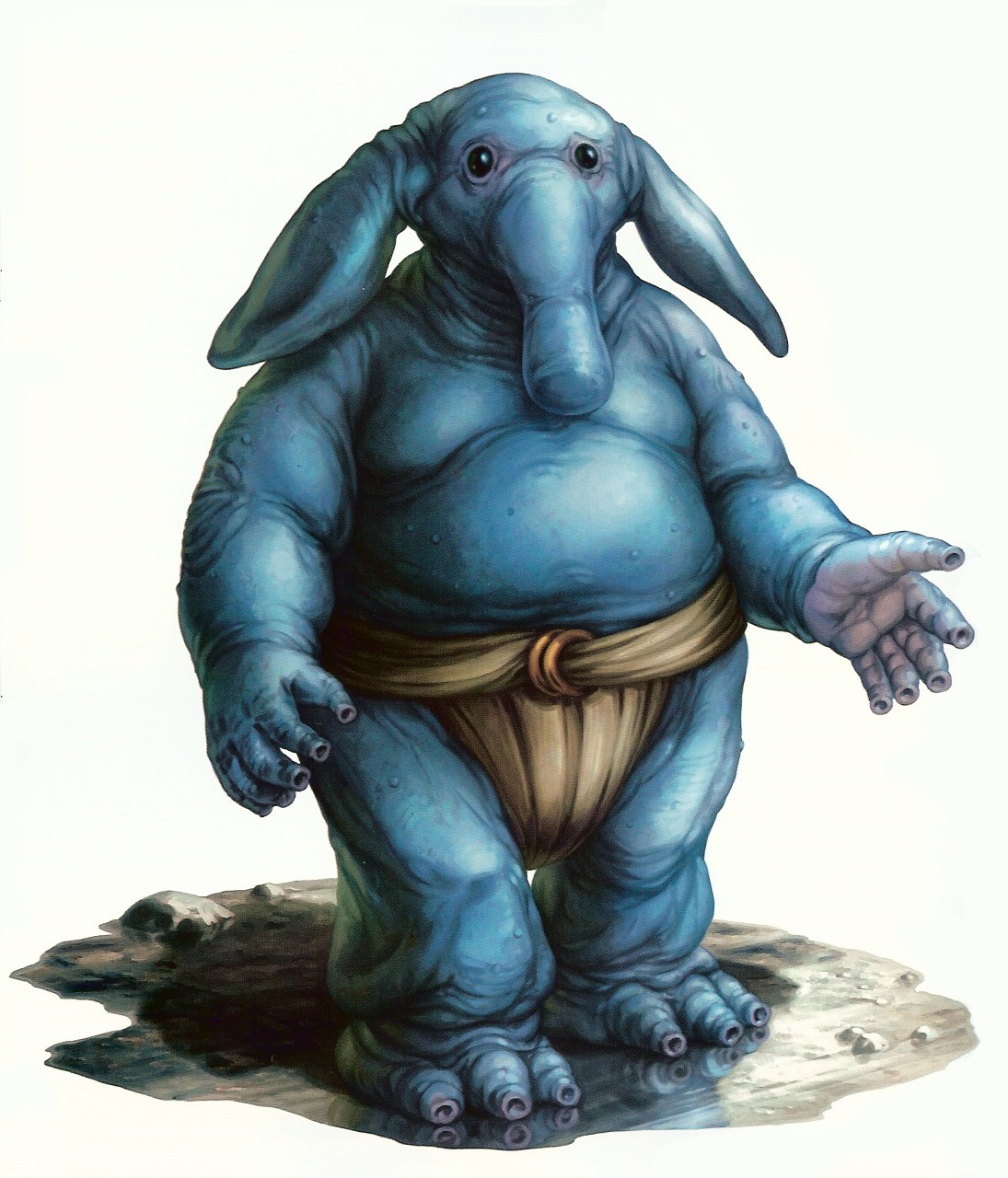
Personality:
Physical Description:
Homeworld:
Language:
Example Names:
Age In Years: Child 1-5; Young Adult 6-11; Adult 12-39; Middle Age 40-54; Old 55-70; Venerable 71+.
Adventurers:
Ortolan Species Traits
- Ability Modifiers: -2 Dexterity, +2 Constitution
- Size: As Small creatures, they gain a +1 size bonus to their Defense, a +1 size bonus on attack rolls, and a +4 size bonus on Hide checks, and a –4 penalty when grappling. They must use smaller weapons than Medium-size beings use, and their lifting and carrying limits are three-quarters those of Medium-size characters.
- Speed: base speed of 6 meters
- Scent Tracking: Ortolan have a keen sense of smell. Ortolan with the Track feat receives a +4 species bonus on Survival checks when tracking a subject within 2 kilometers of his current location.
- Intestinal Fortitude: Ortolan gain a +2 bonus on Fortitude saves against ingested poisons.
- Skill Bonus: Ortolan receive +4 species bonus on Survival checks when foraging for food.
- Free Language Skills: Read/Write and Speak Ortolan
Pa'lowick

Personality:
Physical Description:
Homeworld:
Language:
Example Names:
Age In Years: Child 1-11; Young Adult 12-16; Adult 17-44; Middle Age 45-59; Old 60-74; Venerable 75+.
Adventurers:
Pa'lowick Species Traits
- Ability Modifiers: -2 Strength, +2 Dexterity, +2 Wisdom
- Size: As Medium creatures, they have no special modifiers due to their size.
- Speed: base speed of 10 meters
- Breathe Underwater: As amphibious creatures, Pa'lowick can't drown in water. They gain a +4 species bonus on Swim checks.
- Natural Weapons (Tusks): A Pa'lowick young adult or adult has two long, sharp tusks that protrude from the lower jaw of their second mouth. When they reach middle age they fall off and their lower mouth completely grows over. Pa'lowick have powerful tusks with which they can gore prey. A Pa'lowick’s gore attack deal
1d4 points of piercing damage plus the Pa'lowick’s Strength modifier. The gore attack does not provoke attacks of opportunity. A Pa'lowick who charges an opponent and scores a hit deals double damage with its gore attack.
- Primitive: Pa'lowick with heroic or professional classes receive the bonus feats Weapon Group Proficiency (primitive weapons) and Weapon Group Proficiency (simple weapons) instead of the usual Weapon Group Proficiency bonus feats.
- Skill Bonus: Pa'lowick receive +4 species bonus on Hide and Survival checks in swamp environments.
- Free Language Skills: Read/Write and Speak Lowickese
Pacithhip
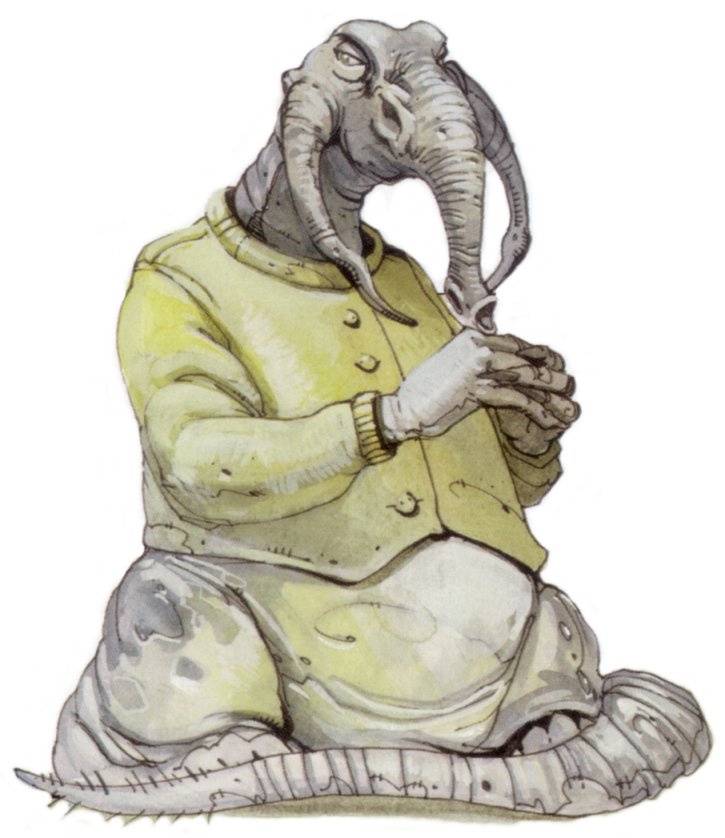
Personality:
Physical Description:
Homeworld:
Language:
Example Names:
Age In Years: Child 1-12; Young Adult 13-17; Adult 18-44; Middle Age 45-69; Old 70-84; Venerable 85+.
Adventurers:
Pacithhip Species Traits
- Ability Modifiers: +2 Strength, -2 Dexterity
- Size: As Medium creatures, they have no special modifiers due to their size.
- Speed: base speed of 8 meters
- Natural Armor: Pacithhip have thick hides. Pacithhip receive a +2 natural armor bonus to Defense.
- Natural Weapons (Tusks): Pacithhip have powerful tusks with which they can gore prey. A Pacithhip’s gore attack deal
1d6 points of piercing damage plus the Pacithhip’s Strength modifier. The gore attack does not provoke attacks of opportunity. A Pacithhip who charges an opponent and scores a hit deals double damage with its gore attack.
- Stable: Pacithhips have a low center of gravity and use their tails to provide extra stability. Pacithhip gain a +4 stability bonus on checks to resist bantha rushes and trip attacks.
- Skill Bonus: A Pacithhip can see in all directions at once. Pacithhip receive +2 species bonus on Spot checks.
- Free Language Skills: Read/Write and Speak Shimiese
Phindian
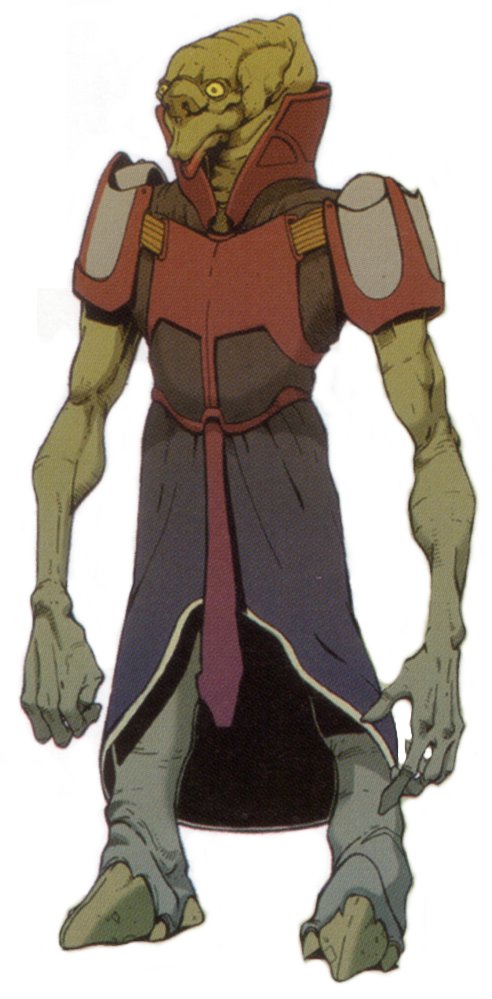
Personality:
Physical Description:
Homeworld:
Language:
Example Names:
Age In Years: Child 1-12; Young Adult 13-16; Adult 17-39; Middle Age 40-54; Old 55-74; Venerable 75+.
Adventurers:
Phindian Species Traits
- Ability Modifiers: +2 Intelligence, -2 Charisma
- Size: As Medium creatures, they have no special modifiers due to their size.
- Speed: base speed of 10 meters
- Bonus Feat: Phindian receive the bonus feat Gearhead.
- Free Language Skills: Speak/Write and Speak Phindian
Pho Ph'eahian
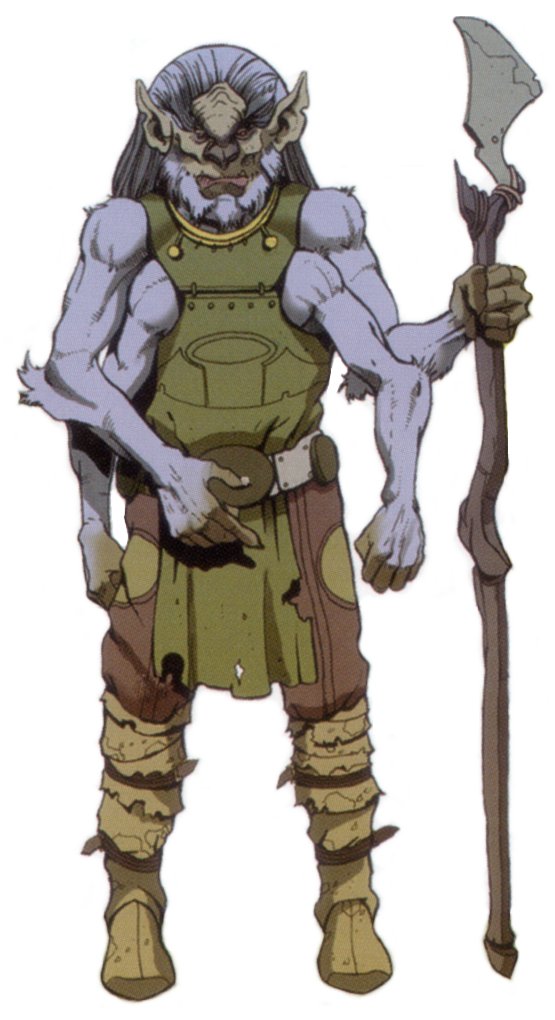
Personality:
Physical Description:
Homeworld:
Language:
Example Names:
Age In Years: Child 1-11; Young Adult 12-16; Adult 17-45; Middle Age 46-65; Old 66-84; Venerable 85+.
Adventurers:
Pho Ph'eahian Species Traits
- Ability Modifiers: +2 Intelligence, -2 Wisdom
- Size: As Medium creatures, they have no special modifiers due to their size.
- Speed: base speed of 10 meters
- Extra Limbs (4): Pho Ph'eahian have four arms. The extra limbs give them a +4 species bonus on Climb checks and grapple checks.
A Pho Ph'eahian has one primary hand and three off hands. A Pho Ph'eahian can wield up to four weapons, but the normal penalties for fighting with multiple weapons apply (see the Multiweapon Fighting feat description). - Thermal Fur: Pho Ph'eahian gain a +4 species bonus on Fortitude saves to resist the effects of extreme cold (See Heat and Cold in Chapter Twelve of the Star Wars Roleplaying Game).
- Skill Bonus: Pho Ph'eahian receive +4 bonus on Survival checks in mountainous environments.
- Free Language Skills: Read/Write and Speak Pho Ph'eahese
Psadan
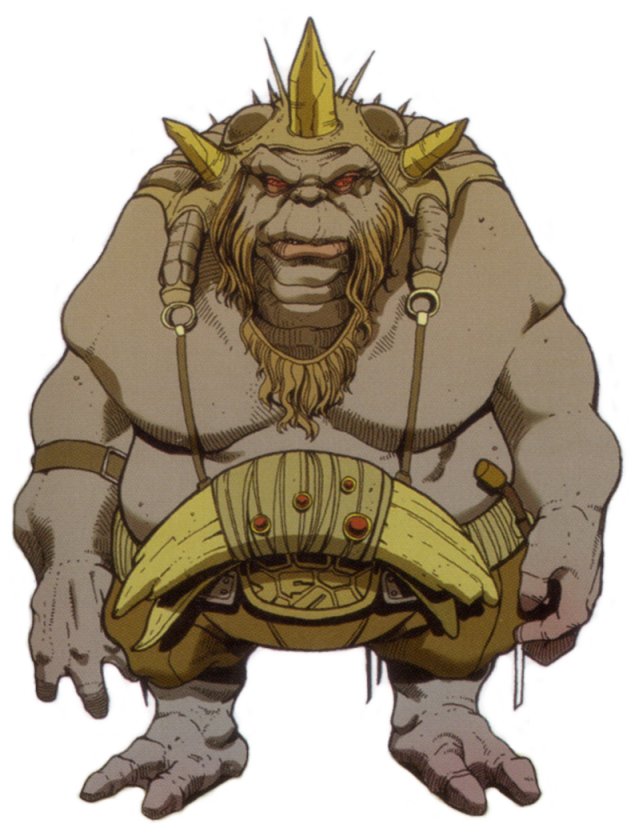
Personality:
Physical Description:
Homeworld:
Language:
Example Names:
Age In Years: Child 1-8; Young Adult 9-13; Adult 14-54; Middle Age 55-74; Old 75-89; Venerable 90+.
Adventurers:
Psadan Species Traits
- Ability Modifiers: +2 Strength, -2 Dexterity, +4 Constitution, -4 Intelligence, -4 Charisma
- Size: As Medium creatures, they have no special modifiers due to their size.
- Speed: base speed of 8 meters
- Damage Reduction: A Psadan receive DR 3. This ability stacks with DR values provided by manufactured armor.
- Natural Armor: Psadan receive a +2 natural armor bonus to Defense.
- Obstinate: Psadan receive a +1 species bonus on Will saving throws.
- Primitive: Psadan with heroic or professional classes receive the bonus feats Weapon Group Proficiency (primitive weapons) and Weapon Group Proficiency (simple weapons) instead of the usual Weapon Group Proficiency bonus feats.
- Free Language Skills: Speak Myneyrsh and Psadan
Quarren
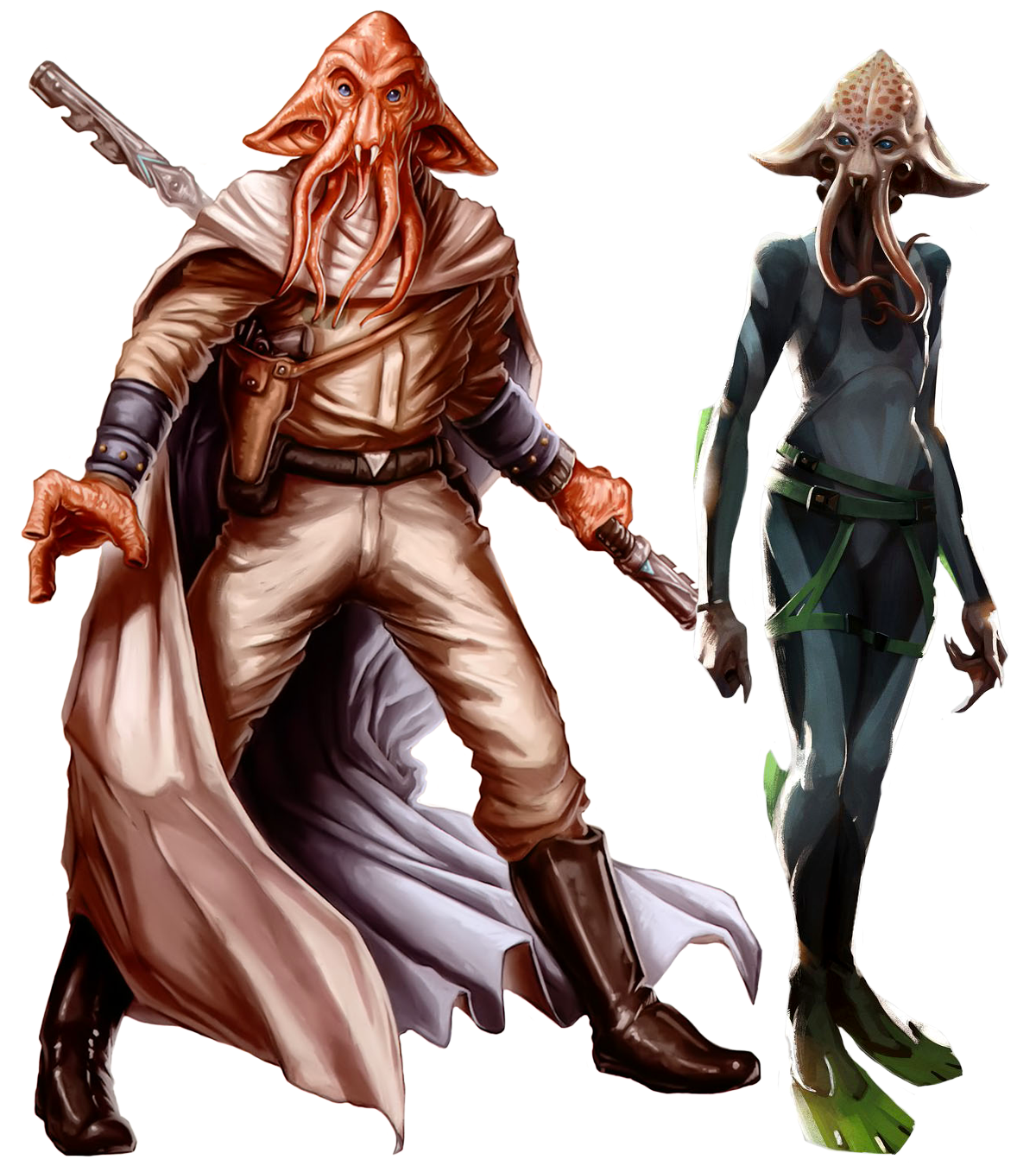
Personality:
Physical Description:
Homeworld:
Language:
Example Names:
Age In Years: Child 1-11; Young Adult 12-16; Adult 17-40; Middle Age 41-57; Old 58-79; Venerable 80+.
Adventurers:
Quarren Species Traits
- Ability Modifiers: +2 Constitution, -2 Wisdom, -2 Charisma
- Size: As Medium creatures, they have no special modifiers due to their size.
- Speed: Base speed of 10 meters. They have a swim speed of 6 meters
- Breathe Underwater: As amphibious creatures, Quarren can't drown in water. They gain a +4 species bonus on Swim checks.
- Low-Light Vision: Quarren can see twice as far as normal in dim light, and retain the ability to distinguish color and detail under these conditions.
- Free Language Skills: Read/Write and Speak Basic and Quarrense
Quermian
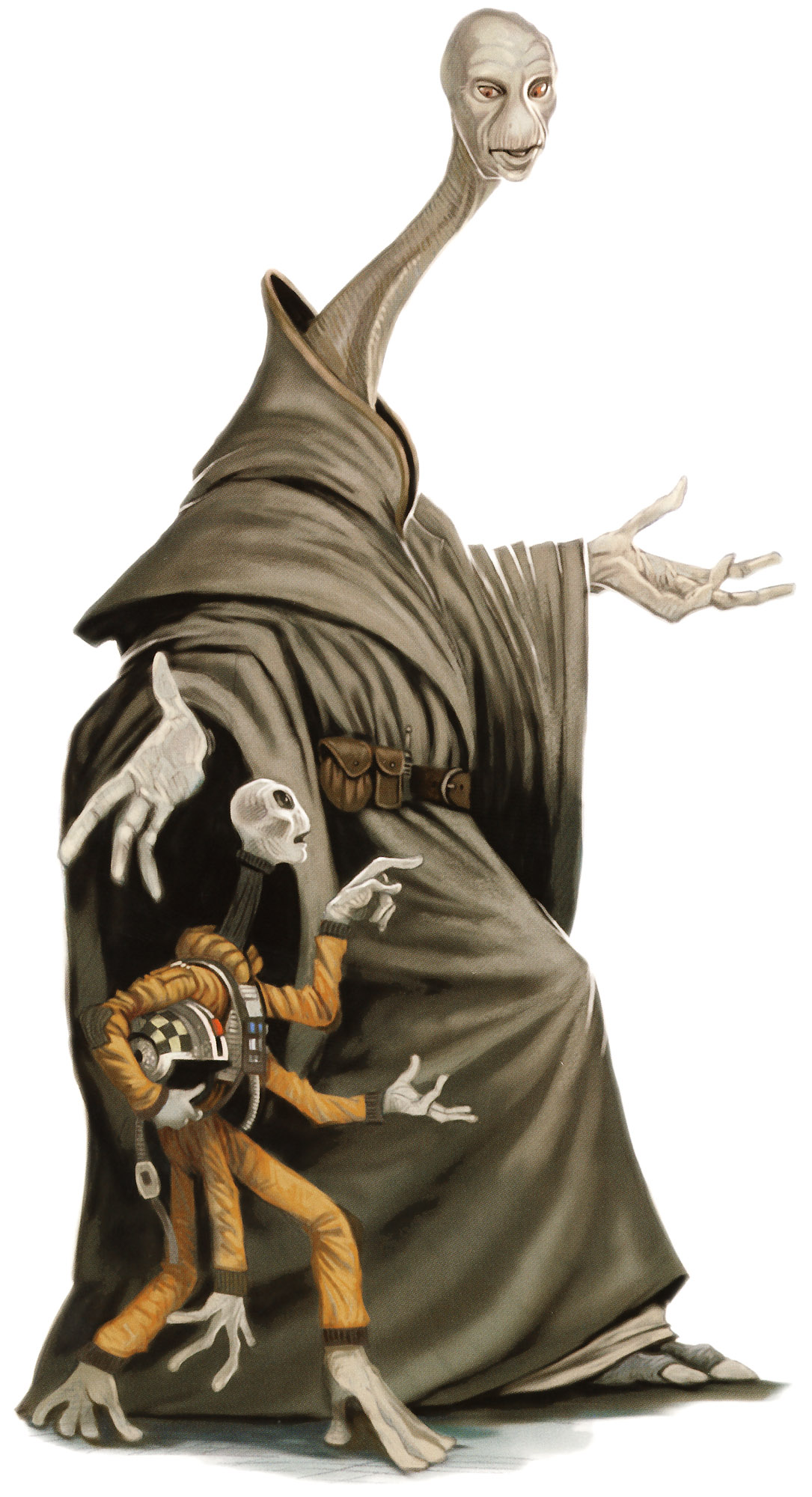
Personality:
Physical Description:
Homeworld:
Language:
Example Names:
Age In Years: Child 1-11; Young Adult 12-16; Adult 17-42; Middle Age 43-65; Old 66-85; Venerable 86+.
Adventurers:
Quermian Species Traits
- Ability Modifiers: -2 Strength, +2 Dexterity, -2 Constitution, +2 Intelligence, +2 Wisdom
- Size: As Medium creatures, they have no special modifiers due to their size.
- Speed: base speed of 10 meters
- Short-Range Telepathy: Quermian can communicate telepathically with other Quermian as well as Force-users who possess the Sense feat. Using this ability is a full-round action. The Quermian must make eye contact with the person it wishes to contact telepathically and succeed at a Wisdom check (DC 10). A failed check indicates that the attempt has failed, although the Quermian may try again.
The Quermian must physically see the target; for instance, eye contact through a HoloNet communication would not suffice. If the target wishes to resist the telepathic contact, he must succeed at a Will save (DC 20) to block the thought transmission. Quermian can only transmit simple phrases and emotional impressions, and they must renew the telepathic contact every round with a new Will save. This ability does not enable non-Quermian to send telepathic messages, only receive them.
- Free Language Skills: Read/Write and Speak Quermian
Qwohog
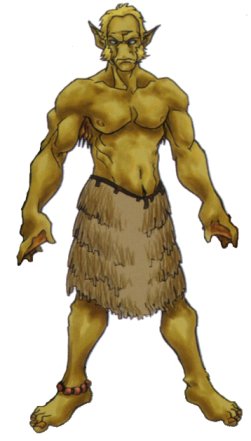
Personality:
Physical Description:
Homeworld:
Language:
Example Names:
Age In Years: Child 1-11; Young Adult 12-16; Adult 17-40; Middle Age 41-59; Old 60-74; Venerable 75+.
Adventurers:
Qwohog Species Traits
- Ability Modifiers: +2 Dexterity, -2 Wisdom
- Size: As Small creatures, they gain a +1 size bonus to their Defense, a +1 size bonus on attack rolls, and a +4 size bonus on Hide checks, and a –4 penalty when grappling. They must use smaller weapons than Medium-size beings use, and their lifting and carrying limits are three-quarters those of Medium-size characters.
- Speed: Base speed of 6 meters on land and 12 meters in water
- Breathe Underwater: As amphibious creatures, Qwohog can't drown in water. They gain a +8 species bonus on Swim checks.
- Saltwater Aversion: Qwohog immersed in salt water for more than 10 minutes begins taking damage (1 point per minute) as the salt burns their gill slits and lungs.
- Free Language Skills: Read/Write and Speak Qwohog, Speak Basic or Qwohog Sign Language
Ranat
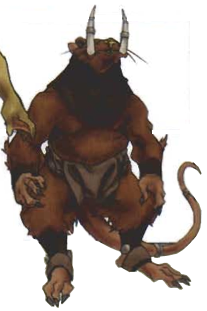
Personality:
Physical Description:
Homeworld:
Language:
Example Names:
Age In Years: Child 1-4; Young Adult 5-8; Adult 9-26; Middle Age 27-40; Old 41-54; Venerable 55+.
Adventurers:
Ranat Species Traits
- Ability Modifiers: +2 Dexterity, -2 Intelligence, -2 Charisma
- Size: As Small creatures, they gain a +1 size bonus to their Defense, a +1 size bonus on attack rolls, and a +4 size bonus on Hide checks, and a –4 penalty when grappling. They must use smaller weapons than Medium-size beings use, and their lifting and carrying limits are three-quarters those of Medium-size characters.
- Speed: Base speed of 10 meters or 2 meters when burrowing through soft earth or clay
- Darkvision: Ranat can see in the dark up to 20 meters. Darkvision is black and white only but otherwise functions as normal sight.
- Flexible Body: Ranat have flat, semi-flexible bodies. They gain a +4 species bonus on Escape Artist check and can move through openings too tight for small creatures but large enough to accommodate Tiny creatures.
- Human Enmity: Ranat take a -2 penalty on Bluff, Diplomacy, Entertain, Gather Information, and Intimidate checks when dealing with Humans.
- Natural Weapon (Bites): The Ranat can bite opponents with its powerful jaws and sharp teeth, dealing 1d4 points of piercing damage (plus Strength modifier). The bite attack does not provoke attacks of opportunity.
- Primitive: Ranat with heroic or professional classes receive the bonus feats Weapon Group Proficiency (primitive weapons) and Weapon Group Proficiency (simple weapons) instead of the usual Weapon Group Proficiency bonus feats.
- Free Language Skills: Read/Write and Speak Ranat
Ranth
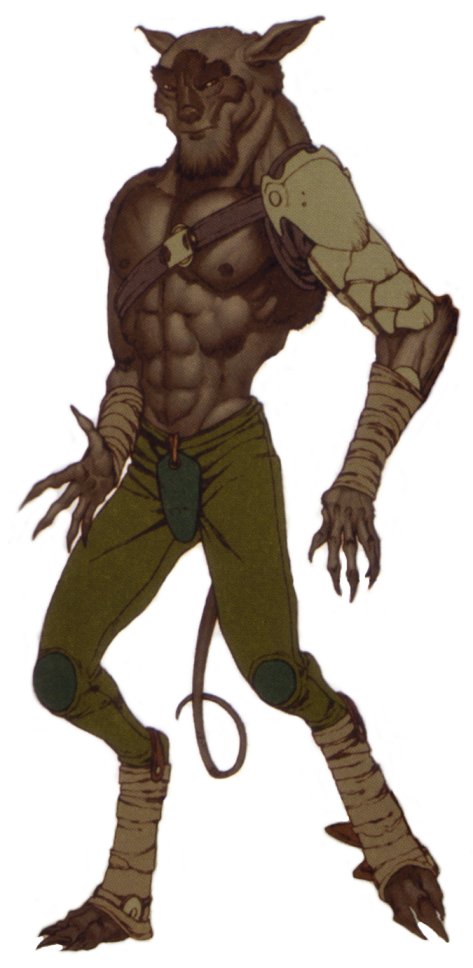
Personality:
Physical Description:
Homeworld:
Language:
Example Names:
Age In Years: Child 1-11; Young Adult 12-15; Adult 16-45; Middle Age 46-65; Old 66-84; Venerable 85+.
Adventurers:
Ranth Species Traits
- Ability Modifiers: +2 Dexterity, -2 Intelligence, -2 Wisdom
- Size: As Medium creatures, they have no special modifiers due to their size.
- Speed: base speed of 10 meters
- Natural Weapons (Claws): Ranth have sharp claws that allow them to make unarmed attacks without provoking attacks of opportunity. As an attack action, a Ranth can make one claw attack (with no penalty) or combine its primary claw attack with off-hand claw attacks (suffering the normal penalties for multiweapon fighting). Each claw deals 1d3 points of slashing damage plus the Ranth's Strength modifier.
- Thermal Fur: Ranth gain a +4 species bonus on Fortitude saves to resist the effects of extreme cold (See Heat and Cold in Chapter Twelve of the Star Wars Roleplaying Game).
- Bonus Feat: Ranth receive the bonus feat Alertness.
- Skill Bonus: Ranth receive +2 species bonus on Survival checks in artic climates. Civilized Ranth do not receive this bonus.
- Free Language Skills: Read/Write and Speak Ranth, and Speak Basic (civilized Ranth only)
Rodian
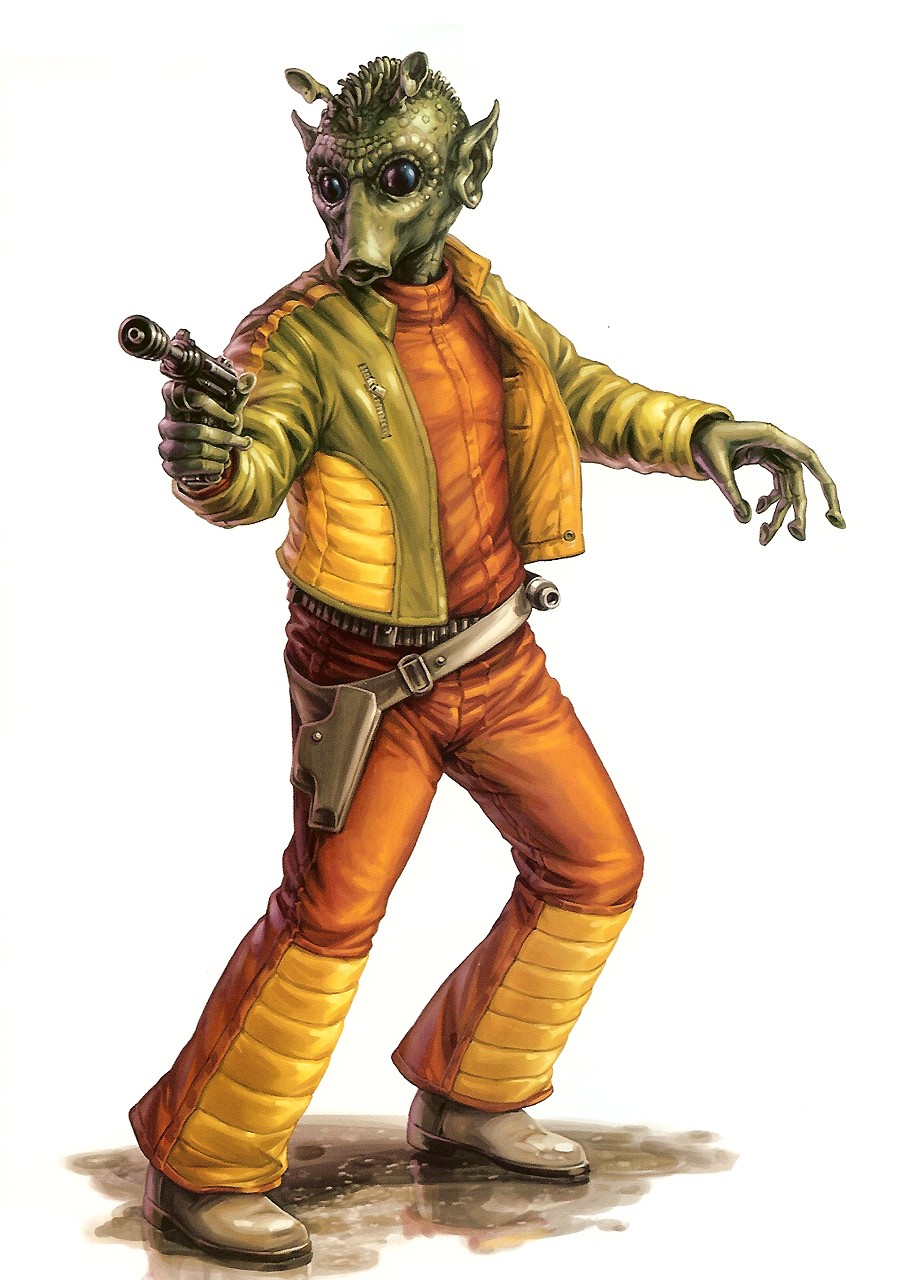
Personality:
Physical Description:
Homeworld:
Language:
Example Names:
Age In Years: Child 1-12; Young Adult 13-15; Adult 16-35; Middle Age 36-49; Old 50-59; Venerable 60+.
Adventurers:
Rodian Species Traits
- Ability Modifiers: +2 Dexterity, -2 Wisdom, -2 Charisma
- Size: As Medium creatures, they have no special modifiers due to their size.
- Speed: base speed of 10 meters
- Bonus Feat: All Rosians are taught how to track from a young age. Rodian receive the bonus feat Track.
- Skill Bonus: Despite their low Wisdom, Rodians are very perceptive. Rodian receive +2 species bonus on Listen, Search, and Spot checks.
- Free Language Skills: Read/Write and Speak Basic and Rodese
Ruurian
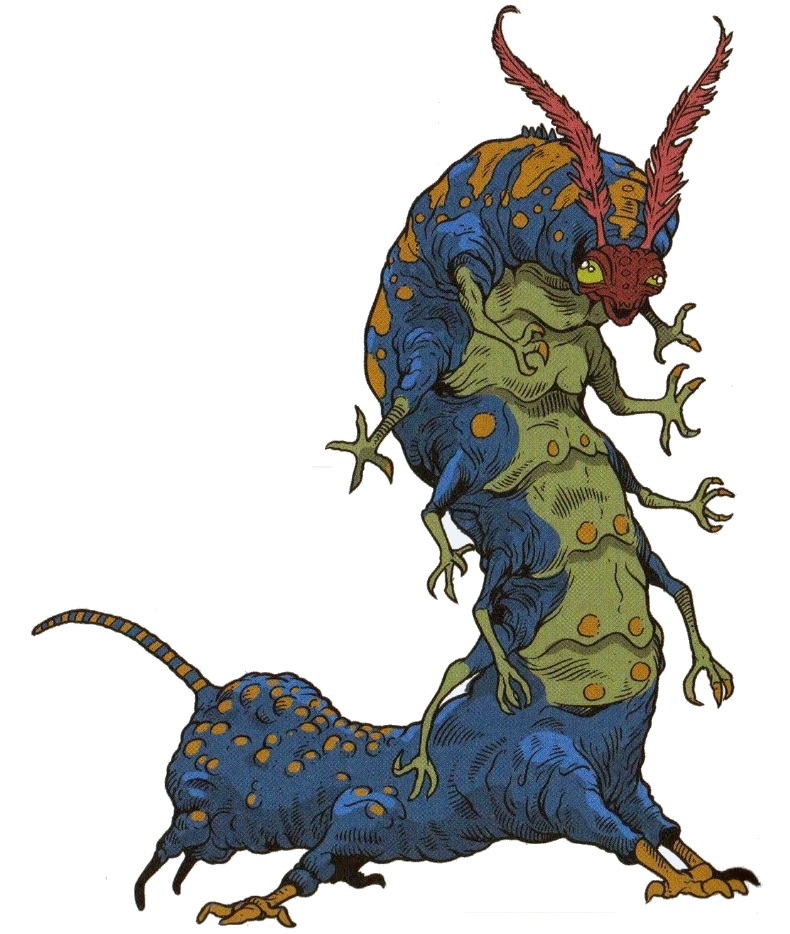
Personality:
Physical Description:
Homeworld:
Language:
Example Names:
Age In Years: Child 1-7; Young Adult 8-11; Adult 12-34; Middle Age 35-42; Old 43-49; Venerable 50+.
Adventurers:
Ruurian Species Traits
- Ability Modifiers: None
- Size: As Small creatures, they gain a +1 size bonus to their Defense, a +1 size bonus on attack rolls, and a +4 size bonus on Hide checks, and a –4 penalty when grappling. They must use smaller weapons than Medium-size beings use, and their lifting and carrying limits are three-quarters those of Medium-size characters.
- Speed: Base speed is 6 meters. Chroma-wings can also fly at a speed of 10 meters (average maneuverability)
- Expert Linguist: Only Ruurian larvae gain this, it is lost when they age to Chroma-wings. Ruurian with heroic or professional class levels gain a free Speak Language skill per character level.
- Extra Limbs (10): Ruurian have ten spindly arms. The extra limbs give them a +5 species bonus on Climb checks and grapple checks (although they take a -4 penalty on grapple checks because of their size).
A Ruurian's ten hands are each capable of grasping and manipulating a Tiny weapon or similar object, such as a hold-out blaster. A Ruurian must use two hands to grasp and manipulate a Small object and four hands to grasp and manipulate a Medium-size object. Ruurian are too small to manipulate Large objects effectively.
Despite having ten arms, Ruurian has only one primary hand and one off hand (like most two-armed species). Ruurian can wield two weapons, but the normal penalties for fighting with two weapons apply (see Table 8-3: Two-Weapon Fighting Penalties in the Star Wars Roleplaying Game). - Hexapedal: Ruurian have six stubby legs. They gain a +4 stability bonus to resist bantha rushes and trip attacks, and they can carry the same load as a Medium-sized creature (see Chapter Six of the Star Wars Roleplaying Game for carrying capacity).
- Larva Form: Do not apply the usual ability modifiers (as listed on Table 6-1: Age Effects of the Star Wars Roleplaying Game) when they age from adult (larva) to middle age (chromanwing). Instead, apply the following modifiers: -4 Intelligence, +4 Charisma.
- Bonus Feat: Ruurian receive the bonus feat Ambidexterity.
- Free Language Skills: Read/Write and Speak Ruurese
Rybet
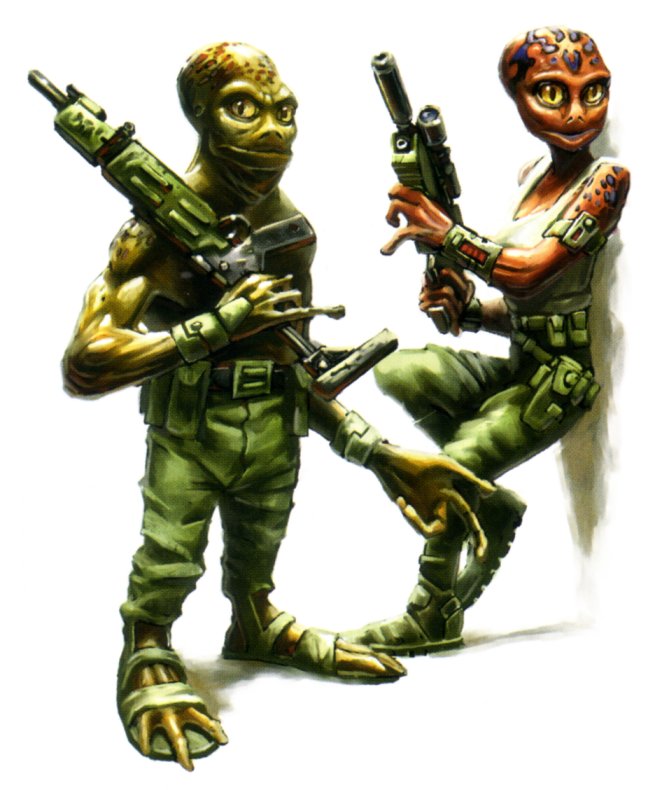
Personality:
Physical Description:
Homeworld:
Language:
Example Names:
Age In Years: Child 1-5; Young Adult 6-9; Adult 10-40; Middle Age 41-60; Old 61-70; Venerable 71+.
Adventurers:
Rybet Species Traits
- Female Ability Modifiers: +2 Strength, -2 Dexterity..
- Male Ability Modifiers: -2 Strength, +2 Dexterity..
- Size: As Small creatures, they gain a +1 size bonus to their Defense, a +1 size bonus on attack rolls, and a +4 size bonus on Hide checks, and a –4 penalty when grappling. They must use smaller weapons than Medium-size beings use, and their lifting and carrying limits are three-quarters those of Medium-size characters.
- Speed: Males have a base speed of 6 meters on land and water. Females have a base speed of 10 meters on land and water.
- Breathe Underwater: As amphibious creatures, Rybet can't drown in water. They gain a +4 species bonus on Swim checks.
- Sexual Dimorphism: Rybet exhibit different characteristics based on sex. Females are Medium sized and have no special modifiers.
- Bonus Feat: Rybet receive the bonus feat Spacer.
- Free Language Skills: Read/Write and Speak Rybese
Ryn
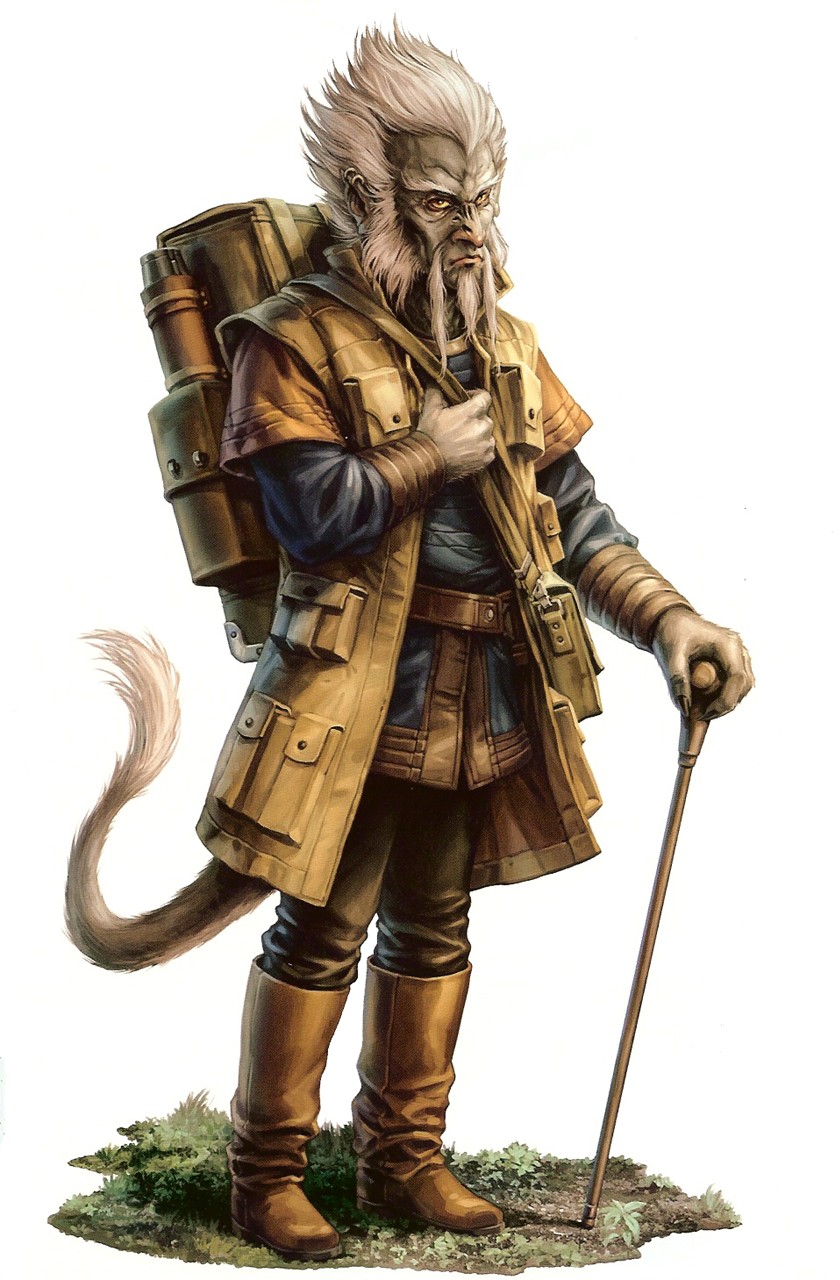
Personality:
Physical Description:
Homeworld:
Language:
Example Names:
Age In Years: Child 1-11; Young Adult 12-15; Adult 16-48; Middle Age 49-65; Old 66-79; Venerable 80+.
Adventurers:
Ryn Species Traits
- Ability Modifiers: None
- Size: As Medium creatures, they have no special modifiers due to their size.
- Speed: base speed of 10 meters
- Musical Beak: Ryn can play their perforated beak like a musical instrument. For the most part, ALIENANEM only play their beaks to amuse children, but some Ryn become so good at it that they can imitate the Binary language spoken by many droids with a successful Entertain (flute) check (DC 20). Unless the Ryn has the Speak Binary skill, they cannot communicate with a droid in this fashion.
- Prehensile Tail: Ryn can use its prehensile tail to grasp items or creatures, although the tail by itself can only carry or support a light load. The tail cannot be used to make attacks, but when used to aid a grapple or disarm attempt, the tail provides a +2 bonus on the Ryn's check.
- Bonus Feat: Ryn receive the bonus feat Infamy.
- Skill Bonus: Ryn receive +2 species bonus on Entertain checks.
- Free Language Skills: Read/Write and Speak Basic and Ryn
Sakiyan
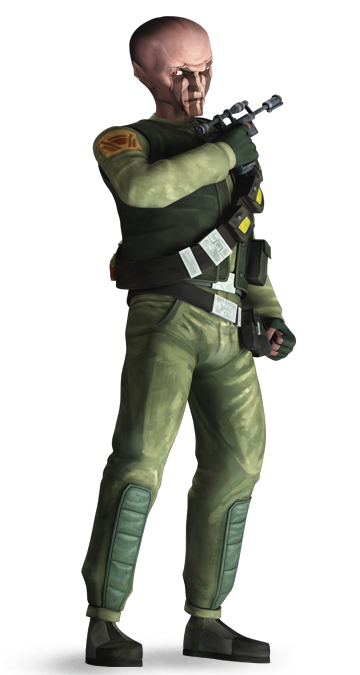
Personality:
Physical Description:
Homeworld:
Language:
Example Names:
Age In Years: Child 1-10; Young Adult 11-15; Adult 16-48; Middle Age 49-74; Old 75-84; Venerable 85+.
Adventurers:
Sakiyan Species Traits
- Ability Modifiers: None
- Size: As Medium creatures, they have no special modifiers due to their size.
- Speed: base speed of 10 meters
- Darkvision: Sakiyan can see in the dark up to 20 meters. Darkvision is black and white only but otherwise functions as normal sight.
- Bonus Feat: Sakiyan use their acute perception as a limited danger sense, improving their reflexes. Sakiyan receive the bonus feat Lightning Reflexes.
- Skill Bonus: Sakiyans have keen senses. Sakiyan receive +2 species bonus on Listen, Search and Spot. They also receive +2 species bonus on Survival checks when tracking by scent.
- Free Language Skills: Read/Write and Speak Sakiyan
Sanyassan

Personality:
Physical Description:
Homeworld:
Language:
Example Names:
Age In Years: Child 1-8; Young Adult 9-13; Adult 14-39; Middle Age 40-52; Old 53-69; Venerable 70+.
Adventurers:
Sanyassan Species Traits
- Ability Modifiers: +2 Strength, -2 Dexterity, +2 Constitution, -2 Intelligence
- Size: As Medium creatures, they have no special modifiers due to their size.
- Speed: base speed of 10 meters
- Natural Armor: Sanyassan have tough hides. Sanyassan receive a +1 natural armor bonus to Defense.
- Skill Bonus: Sanyassan receive +2 species bonus on Intimidate and Survival checks.
- Free Language Skills: Read/Write and Speak Sanyassan
Sarkan

Personality:
Physical Description:
Homeworld:
Language:
Example Names:
Age In Years: Child 1-12; Young Adult 13-18; Adult 19-50; Middle Age 51-79; Old 80-95; Venerable 96+.
Adventurers:
Sarkan Species Traits
- Ability Modifiers: +2 Strength, -4 Charisma
- Size: As Medium creatures, they have no special modifiers due to their size.
- Speed: base speed of 10 meters
- Natural Weapons (Claws): Sarkan have sharp claws that allow them to make unarmed attacks without provoking attacks of opportunity. As an attack action, a Sarkan can make one claw attack (with no penalty) or combine its primary claw attack with off-hand claw attacks (suffering the normal penalties for multiweapon fighting). Each claw deals 1d3 points of slashing damage plus the Sarkan's Strength modifier.
- Natural Weapons (Tail): Sarkan who takes the Martial Arts feat can strike an opponent with its tail instead of making a claw attack. The tail deals 1d6 points of bludgeoning damage plus 1.5 times the Sarkan's Strength modifier, threatens a critical hit on a natural 20, and does not provoke attacks of opportunity.
- Free Language Skills: Read/Write and Speak Sarkese
Sauvax
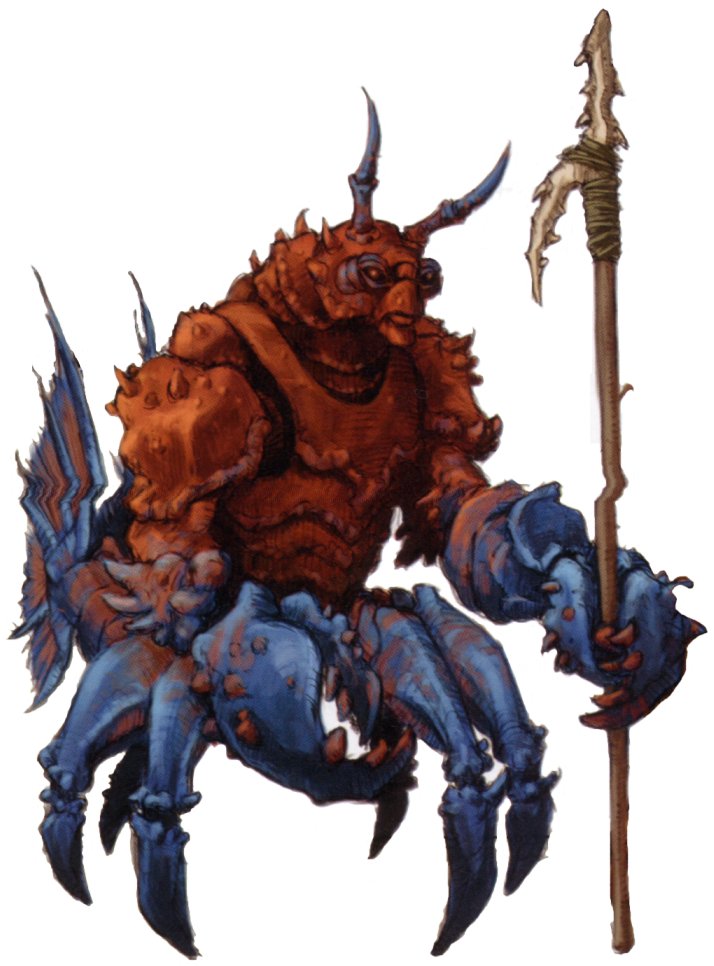
Personality:
Physical Description:
Homeworld:
Language:
Example Names:
Age In Years: Child 1-5; Young Adult 6-9; Adult 10-44; Middle Age 45-69; Old 70-89; Venerable 90+.
Adventurers:
Sauvax Species Traits
- Ability Modifiers: +2 Strength, -2 Dexterity, +2 Constitution, -2 Charisma
- Size: As Medium creatures, they have no special modifiers due to their size.
- Speed: Base speed of 10 meters on land and 6 meters in water
- Breathe Underwater: As amphibious creatures, Sauvax can't drown in water. They gain a +4 species bonus on Swim checks.
- Natural Armor: Sauvax have a thick shell. Sauvax receive a +4 natural armor bonus to Defense.
- Natural Weapons (Claws): Sauvax have sharp claws that allow them to make unarmed attacks without provoking attacks of opportunity. As an attack action, a Sauvax can make one claw attack (with no penalty) or combine its primary claw attack with off-hand claw attacks (suffering the normal penalties for multiweapon fighting). Each claw deals 1d6 points of slashing damage plus the Sauvax's Strength modifier.
- Pincers: Sauvax' pincers can grasp and manipulate primitive weapons and simple items, but not small, articulated objects such as blasters, lightsabers, datapads, medpacks, and other gear designed for species with hands.
- Bonus Feat: Sauvax receive the bonus feat Weapon Group Proficiency (primitive weapons).
- Skill Bonus: Sauvax possess acute senses. Sauvax receive +2 species bonus on Spot and Listen checks.
- Free Language Skills:
Svivreni
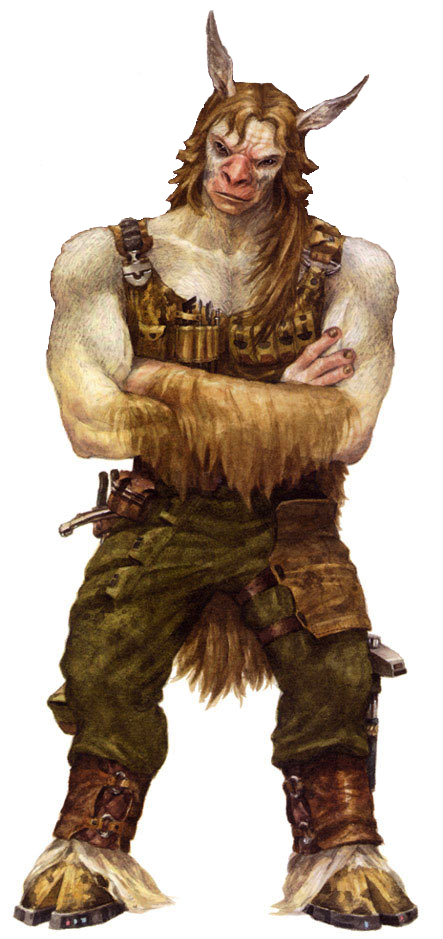 The Svivreni are a well-regarded equinoid species known for their work in the mining and metallurgic industries. Though officially nonaligned during the Empire's reign, many individual Svivreni have assisted the Rebellion, and later the New Republic and Galactic Alliance. Most work in the private sector.
The Svivreni are a well-regarded equinoid species known for their work in the mining and metallurgic industries. Though officially nonaligned during the Empire's reign, many individual Svivreni have assisted the Rebellion, and later the New Republic and Galactic Alliance. Most work in the private sector.
Personality: If asked to sum up the Svivreni in one word, a being would be hard-pressed to offer anything other than “stubborn.” Svivreni are nearly impossible to sway once they have made a decision. This trait bodes trouble for the Imperial forces under command of Grand Admiral Thrawn who—approximately five years after the Battle of Endor—attempt to move on the Svivreni homeworld and are met with stiff resistance.
Physical Description: Though short (usually less than a meter tall), Svivreni are heavily muscled and exceptionally resilient. Svivreni possess four-digited hands and cloven hooves, as well as thick heads with broad snouts, large eyes, and prick ears. Their bodies arc almost completely covered in thick hair. Svivreni custom dictates that adults do not cut their hair—long hair among their kind is believed to be an indication of intelligence and fertility (older Svivreni males often have hair below their waists). Svivreni traditionally wear sleeveless tunics and work trousers that are covered with pouches and pockets for carrying the various tools used in the course of a day's labor.
Homeworld: Svivren, a dangerous, mountain-studded Outer Rim world not far From Andalasa. Imperial Forces moved on Svivren during the Thrawn Crisis but were repelled. Svivren is known for its harsh laws: Weapons are not allowed on-world, aside from those carried by the heavily armed security troops. Violence on Svivren results in the immediate execution of the perpetrator. These Svivreni codes are criticized by groups throughout the galaxy, but crime on Svivren does remain low. Smugglers and other such scoundrels and rogues generally avoid the world.
Language: Svivreni speak and read Svivreni, the vocal range for which most other species (including Humans) cannot emulate.
Example Names: Kitalic Nirasic, Mihalik, Casin Mak.
Age In Years: Child 1-11; Young Adult 12-17; Adult 18-55; Middle Age 56-89; Old 90-124; Venerable 125+.
Adventurers: Most Svivreni encountered in the galaxy at large will either be scouts or experts (most commonly in the fields of metallurgy or geology, hired specifically to oversee mining projects). Some Svivreni Jedi consulars are known to ply the Outer Rim and Unknown Regions.
Svivreni Species Traits
- Ability Modifiers: +2 Constitution, -2 Wisdom, -2 Charisma
- Size: As Small creatures, they gain a +1 size bonus to their Defense, a +1 size bonus on attack rolls, and a +4 size bonus on Hide checks, and a –4 penalty when grappling. They must use smaller weapons than Medium-size beings use, and their lifting and carrying limits are three-quarters those of Medium-size characters.
- Speed: base speed of 8 meters
- Powerful Build: Svivreni are treated as Medium-size characters for purposes of opposed checks (such as grapple checks, bantha rush attempts, or trip checks), carrying capacity, and for determining if a weapon would be light, one-handed, two-handed, or too large to use (see page 131 of the revised Star Wars Roleplaying Game book).
- Bonus Feat: Svivreni receive the bonus feat Great Fortitude and Iron will.
- Free Language Skills: Read/Write and Speak Svivreni
Tchuukthai
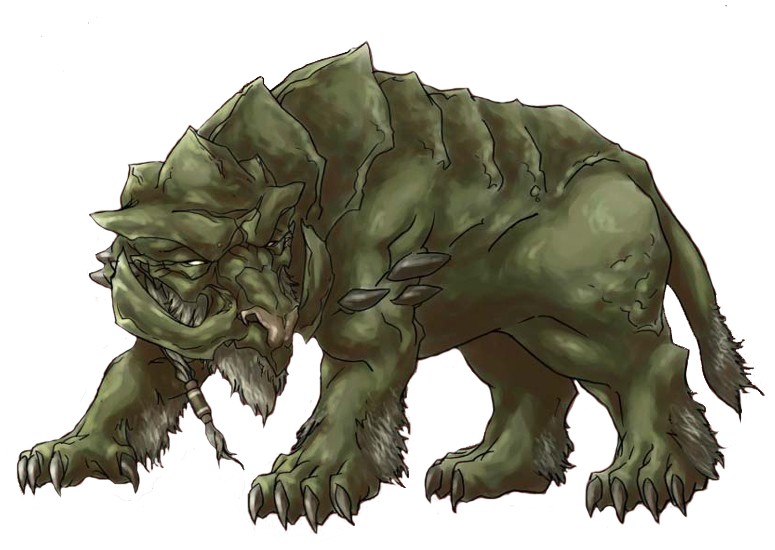 For centuries, the Tchuukthai were considered little more than beasts. Their brutish appearance and vocabulary of grunts and growls helped perpetuate that myth—a misperception the Tchuukthai were more than happy to see thrive. Over several centuries, Tchuukthai were discovered more than once. Most times, explorers avoided contact with these seemingly dangerous creatures. The few who couldn’t resist the urge to learn more about them were met with vicious snarls and displays of ferocity.
For centuries, the Tchuukthai were considered little more than beasts. Their brutish appearance and vocabulary of grunts and growls helped perpetuate that myth—a misperception the Tchuukthai were more than happy to see thrive. Over several centuries, Tchuukthai were discovered more than once. Most times, explorers avoided contact with these seemingly dangerous creatures. The few who couldn’t resist the urge to learn more about them were met with vicious snarls and displays of ferocity.
Their true intelligence remained a secret until a Jedi Master encountered them. The Jedi, whose name is lost in antiquity, explained much about the galaxy to a Tchuukthai he’d befriended. The Tchuukthai’s interest was piqued, but he was wary of leaving his home and fearful that his people would be exploited if their true nature were known. The Jedi gave his word that he would protect their secret and offered to train the Tchuukthai in the ways of the Force. This Tchuukthai later became Jedi Master Thon of Ambria. For thousands of years, Master Thon was the only Tchuukthai who had ventured into the galaxy. Only the Jedi knew his true nature. Since that time, other Tchuukthai might have ventured beyond their home system, perhaps even as pets or zoological exhibits. During the time of the New Republic, their existence is still considered a rumour across most of the galaxy.
Personality: Tchuukthai are contemplative, free thinking, secretive, and slow to anger. Some prefer to be left alone, while others seem genuinely interested in meeting new species. Depending on their general demeanour, Tchuukthai are either annoyed or amused by other species’ reactions to their appearance and size. They disdain conflict but fight fiercely when sufficiently provoked.
Physical Description: Tchuukthai are hulking, quadrupedal brutes with thick leathery skin, wide-set eyes, flaring nostrils, and sharp fangs. Bristling fur covers their shoulders and backs, and armor plating protects their head, joints, and vital organs. An adult Tchuukthai stands 2 meters tall at the shoulder or 3 meters tall when standing upright on his or her hind legs. Tchuukthai who consort with other species typically don clothing; others do not.
Homeworld: Unknown. The identity and location of the Tchuukthai homeworld is a closely guarded secret.
Language: Tchuukthai have their own guttural language (Tchuukthese).
Example Names: Bval, Drol, Gaarx, Huun, Nrak, Thon, Tkur, Zvod.
Age In Years: Child 1-12; Young Adult 13-20; Adult 21-189; Middle Age 190-249; Old 250-299; Venerable 300+.
Adventurers: Tchuukthai who travel among the stars are usually scouts interested in exploring new worlds or free-spirited Force adepts eager to learn the ways of the Force and discover new Force-using traditions.
Tchuukthai Species Traits
- Ability Modifiers: +4 Strength, -4 Dexterity
- Size: As Large creatures, they suffer a -1 size penalty on Defense, a -1 size penalty on attack rolls, and a -4 penalty on hide check, and a and a +4 penalty when grapplings. They have a Face/Reach of 2m by 2m/4m. Their lifting and carrying limits are doubled of Medium-sized characters.
- Speed: base speed of 12 meters
- Damage Reduction: Tchuukthai have armored hides. A Tchuukthai receive DR 2. This ability stacks with DR values provided by manufactured armor.
- Natural Armor: Tchuukthai have thick skin. Tchuukthai receive a +5 natural armor bonus to Defense.
- Quadrupedal: Tchuukthai gain a +4 stability bonus against bantha rushes and trip attacks.
- Bonus Feat: Tchuukthai receive the bonus feat Run and Weapon Group Proficiency (simple weapons).
- Free Language Skills: Read/Write and Speak Tchuukthese.
Trandoshan
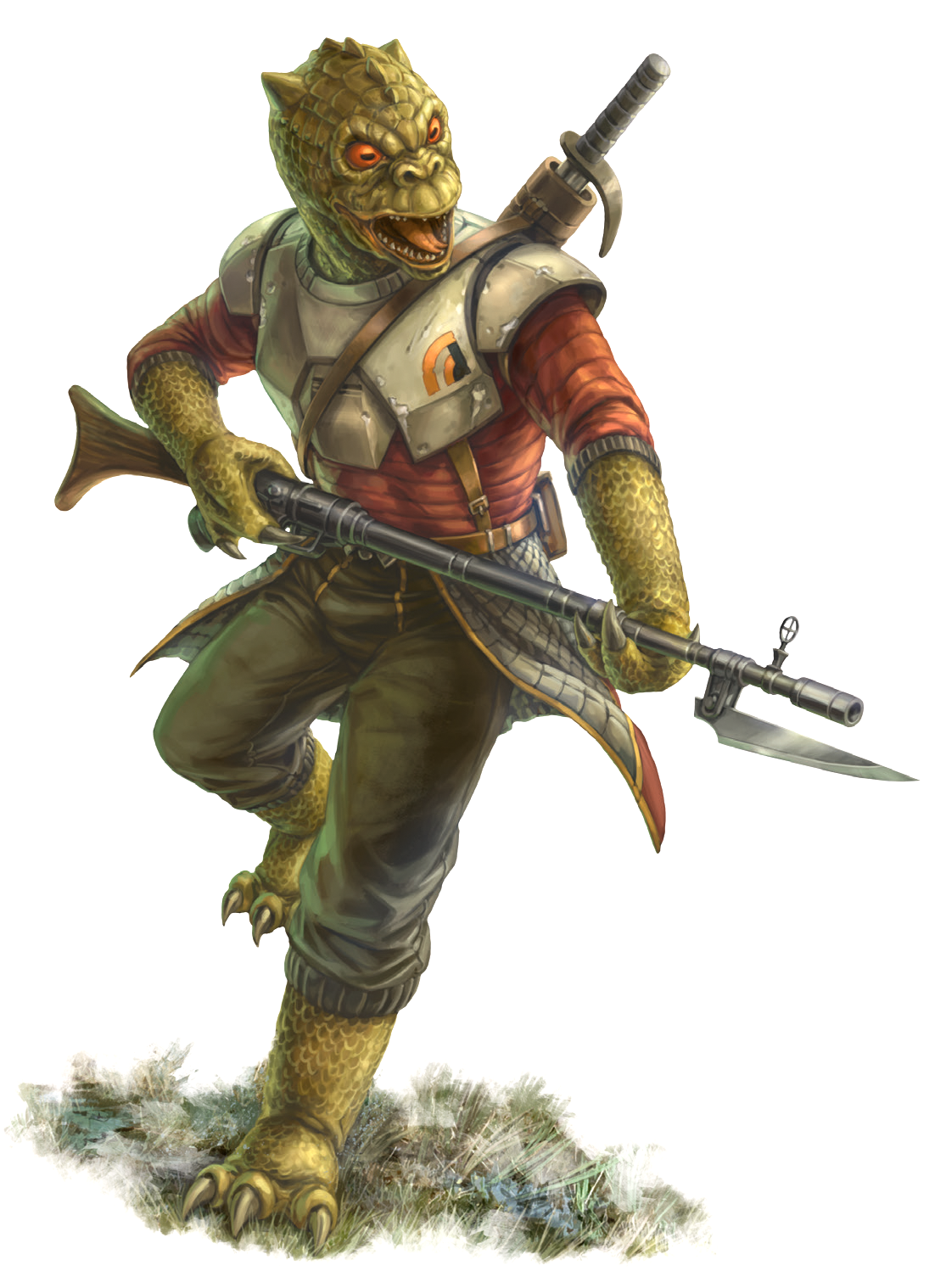 Trandoshans are strong, reptilian, warlike humanoids from an arid world that orbits the same star as the lush Wookiee homeworld. Bad blood exists between the two species for many reasons. In the centuries before the Foundation of the Galactic Empire, the Trandoshans tried to colonize regions of the Wookiee homeworld and were driven back Following numerous bloody skirmishes. The influx of tourists from other systems also worried the Wookiees, who started realizing the negative impact on their planet's delicate ecosystem. They created laws restricting the number of tourists allowed to visit their homeworld, which greatly reduced the number of tourists to the system and infuriated Trandoshans eager to profit from the tourist trade.
Trandoshans are strong, reptilian, warlike humanoids from an arid world that orbits the same star as the lush Wookiee homeworld. Bad blood exists between the two species for many reasons. In the centuries before the Foundation of the Galactic Empire, the Trandoshans tried to colonize regions of the Wookiee homeworld and were driven back Following numerous bloody skirmishes. The influx of tourists from other systems also worried the Wookiees, who started realizing the negative impact on their planet's delicate ecosystem. They created laws restricting the number of tourists allowed to visit their homeworld, which greatly reduced the number of tourists to the system and infuriated Trandoshans eager to profit from the tourist trade.
Trandoshans raided the Wookiee homeworld, attempting to plunder its natural resources. The Wookiees brought the matter to the Senate, but that did not discourage the Trandoshans. Terrible battles raged on both worlds until, finally, the Senate ruled in favour of the Wookiees and put an end to the Trandoshan raids.
When Emperor Palpatine came to power and began seeking inexpensive alternatives to more traditional workforces, the Trandoshans seized the opportunity to take their revenge on the Wookiees. They reached an agreement with the Emperor and began delivering regular shipments of Wookiee slaves in exchange for various concessions, including economic sanctions against the Wookiee homeworld.
After the fall of the Empire, the New Republic Senate demanded an immediate Trandoshan withdrawal from the Wookiee homeworld, upon threat of economic sanctions and military reprisals. The Trandoshans grudgingly complied, although their poor treatment of the Wookiees and their willingness to support the Empire casts a dark cloud over the species that persists well into The New Jedi Order era.
Trandoshans value hunting above all else and worship a female deity who rewards Trandoshans based on their success or failure in the hunt. Young Trandoshans hatch from eggs and have the ability to regenerate lost limbs. Trandoshans lose their regenerative ability once they become young adults.
Trandoshans have supersensitive eyes that can see into the infrared range. They also shed their skin several times in the span of their lives. They have a difficult time manipulating delicate objects with their relatively clumsy clawed hands.
Trandoshans refer to themselves as “T’doshok”.
Personality: Trandoshans are aggressive, selfish, and vindictive beings. Violent, brutal, and driven, they love to compete, but can show compassion and mercy when the situation warrants. They like to collect trophies from various successful hunts, and they generally value credits more than friendship, although a Trandoshan will pledge his life to protect another being who has saved him from certain death.
Trandoshans despise Wookiees above all other species and will not work alongside them except under the most extraordinary circumstances.
Physical Description: Trandoshans range from 1.5 to 2.1 meters tall. Their scaly hides offer additional defense against attacks and range in colour from sandy brown to glossy green.
Homeworld: Trandosha (also called Hsskor or Dosha), an arid planet located in the Mid Rim. The planet orbits the same sun as Kashyyyk, the Wookiee homeworld.
Language: Dosh, the Trandoshan language, consists mostly of harsh grunts and growls. The written language incorporates simple alphabetic glyphs. Most Trandoshans who travel the galaxy also learn to speak Basic.
Example Names: Bossk, Corrsk, Cradossk, Dussk, Fusset, Grulluss, Juuus, Kallukoras, Krussk, Nakaron, Portha, Reosss, Ssurrg, Traggissk, Tusserk, Yarroq, Yavassk.
Age In Years: Child 1-11; Young Adult 12-14; Adult 15-34; Middle Age 35-49; Old 50-59; Venerable 60+.
Adventurers: A Trandoshan adventurer craves the thrill of battle. Some leave Trandosha to become bodyguards or mercenaries. Others set out to find new places to hunt and explore. A Few use their warrior traditions to become soldiers, some even developing into bounty hunters. They may appear gruff and unpleasant at first, but if given the chance, they become valuable members of any mission team.
Trandoshan Species Traits
- Ability Modifiers: +2 Strength, -2 Dexterity
- Size: As Medium creatures, they have no special modifiers due to their size.
- Speed: base speed of 10 meters
- Darkvision: Trandoshan can see in the dark up to 20 meters. Darkvision is black and white only but otherwise functions as normal sight.
- Natural Armor: Trandoshans have scaly hide. Trandoshan receive a +1 natural armor bonus to Defense.
- Free Language Skills: Read/Write and Speak Basic and Dosh

 Abyssins are brutish humanoids who thrive on violence. They believe that change is impossible, a belief fostered by their ability to recover quickly from even the most grievous wounds. The Blooding, a ritual combat between two tribes over water rights, is also used to settle impassable disputes between hated enemies. A Blooding is usually a fight to the death between two Abyssins—one champion per tribe—with the winner gaining all of the loser's possessions.
Abyssins are brutish humanoids who thrive on violence. They believe that change is impossible, a belief fostered by their ability to recover quickly from even the most grievous wounds. The Blooding, a ritual combat between two tribes over water rights, is also used to settle impassable disputes between hated enemies. A Blooding is usually a fight to the death between two Abyssins—one champion per tribe—with the winner gaining all of the loser's possessions.  Adarians are best known for their mining and manufacturing operations, as well as a civilisation that's never been blemished by civil strife. Adari, their home-world, is run as though it was a corporation. Adarian society is divided into strict castes that determine what role each member will undertake, with the higher casks having absolute authority over the lower ones.
Adarians are best known for their mining and manufacturing operations, as well as a civilisation that's never been blemished by civil strife. Adari, their home-world, is run as though it was a corporation. Adarian society is divided into strict castes that determine what role each member will undertake, with the higher casks having absolute authority over the lower ones. The Advozsec come from the tectonically tortured world of Riflor. Three suns exert tremendous gravitational stress on the planet, which has baffled planetologists as to why the planet hasn't been destroyed yet. The Advozsec evolved on Rifler to become both survivors and tremendous pessimists.
The Advozsec come from the tectonically tortured world of Riflor. Three suns exert tremendous gravitational stress on the planet, which has baffled planetologists as to why the planet hasn't been destroyed yet. The Advozsec evolved on Rifler to become both survivors and tremendous pessimists.  These arboreal humanoids live in small tribes that each lay claim to a one of the many sparse forests of Maridun, their homeworld. When a tribe grows too large, the younger adults set out to claim a new forest. The arrival of the Empire on Maridun went largely unnoticed, until one Amanin lorekeeper agreed to turn over prisoners from rival tribes as slaves. Not long after the Battle of Endor, operations on Maridun were taken over by the Hutts and various criminal syndicates, which constructed spaceports to support the growth of several small cities populated by crime lords, scoundrels, consortiums, mining companies, and Amanin slaves.
These arboreal humanoids live in small tribes that each lay claim to a one of the many sparse forests of Maridun, their homeworld. When a tribe grows too large, the younger adults set out to claim a new forest. The arrival of the Empire on Maridun went largely unnoticed, until one Amanin lorekeeper agreed to turn over prisoners from rival tribes as slaves. Not long after the Battle of Endor, operations on Maridun were taken over by the Hutts and various criminal syndicates, which constructed spaceports to support the growth of several small cities populated by crime lords, scoundrels, consortiums, mining companies, and Amanin slaves.  Most Anomids drape themselves in long flowing robes and wear vocalizer masks, covering all but their eyes and bald heads. They are by no means shy, however, and are quick to strike up a conversation with a stranger, especially a member of a rarely encountered species. They enjoy sharing wild spacers' tales and news from across the galaxy. Anomid travellers are usually wealthy and considered easy marks by dairies and con artists. The concealing garb of an Anomid also serves them well when they need a quick and easy disguise.
Most Anomids drape themselves in long flowing robes and wear vocalizer masks, covering all but their eyes and bald heads. They are by no means shy, however, and are quick to strike up a conversation with a stranger, especially a member of a rarely encountered species. They enjoy sharing wild spacers' tales and news from across the galaxy. Anomid travellers are usually wealthy and considered easy marks by dairies and con artists. The concealing garb of an Anomid also serves them well when they need a quick and easy disguise.  The Anx are serene giants who assume many roles in the Republic. They are placid, sociable creatures noted for an almost-fanatical devotion to any larger group of which they consider themselves a part.
The Anx are serene giants who assume many roles in the Republic. They are placid, sociable creatures noted for an almost-fanatical devotion to any larger group of which they consider themselves a part.  Some beings regard Anzati as mythical creatures, concocted to scare younglings and superstitious fools. They are, in fact, among the deadliest predators in the galaxy. Anzati have exceptionally long lives, reaching adulthood by age 100. Particularly crafty Anzati can live to be several centuries old.
Some beings regard Anzati as mythical creatures, concocted to scare younglings and superstitious fools. They are, in fact, among the deadliest predators in the galaxy. Anzati have exceptionally long lives, reaching adulthood by age 100. Particularly crafty Anzati can live to be several centuries old.  The Aqualish are amphibious humanoids native to the Mid Rim world of Ando. Three breeds of Aqualish exist—the Aquala (widely considered the "baseline Aqualish), the Quara, and the Ualaq. The three strains are generally similar in appearance and in their traits, but the Quara and Ualaq have clawlike hands with five digits where the Aquala have fins. The Ualaq are set apart by the fact that they have four eyes instead of two.
The Aqualish are amphibious humanoids native to the Mid Rim world of Ando. Three breeds of Aqualish exist—the Aquala (widely considered the "baseline Aqualish), the Quara, and the Ualaq. The three strains are generally similar in appearance and in their traits, but the Quara and Ualaq have clawlike hands with five digits where the Aquala have fins. The Ualaq are set apart by the fact that they have four eyes instead of two.  The Arcona are cold-blooded humanoids who hail from Cona, an arid world in the Teke Ro system.
The Arcona are cold-blooded humanoids who hail from Cona, an arid world in the Teke Ro system.  At one time, Arkanian was an important part of the Sith Empire. The world was one of the main repositories of that long-lost civilization's historical records. During the three main eras of play, Arkania is known for its elaborately constructed trade cities and rich gem mines. A number of highly sought after stones can only be found on this world. The Arkanians are known for zealous exploration of the galaxy, innovations in microcircuitry, and contributions to medical technology. Arkanian scientists have long been expert practitioners of genetic manipulation, displaying a particular fascination with the genetic make-up of species other than their own. Some of the results of their research have led to great advances in medical techniques, while others are considered among the greatest atrocities the galaxy has ever known.
At one time, Arkanian was an important part of the Sith Empire. The world was one of the main repositories of that long-lost civilization's historical records. During the three main eras of play, Arkania is known for its elaborately constructed trade cities and rich gem mines. A number of highly sought after stones can only be found on this world. The Arkanians are known for zealous exploration of the galaxy, innovations in microcircuitry, and contributions to medical technology. Arkanian scientists have long been expert practitioners of genetic manipulation, displaying a particular fascination with the genetic make-up of species other than their own. Some of the results of their research have led to great advances in medical techniques, while others are considered among the greatest atrocities the galaxy has ever known.  The Ayrou are willowy humanoids from the planet Maya Koval in the Moddell Sector. They evolved from a birdlike species yet are incapable of flight.
The Ayrou are willowy humanoids from the planet Maya Koval in the Moddell Sector. They evolved from a birdlike species yet are incapable of flight.  Balosars are humanoids with a shady reputation throughout the Core Worlds. They can easily pass for human (when their antennapalps are retracted) and tend to live among the lowest echelons of society, preying on the vices of the weak-willed or impoverished.
Balosars are humanoids with a shady reputation throughout the Core Worlds. They can easily pass for human (when their antennapalps are retracted) and tend to live among the lowest echelons of society, preying on the vices of the weak-willed or impoverished.  Barabel hail from the planet Barab I. The red dwarf star around which their homeworld orbits projects very little light, so most beings on the world, including the Barabel, have eyes attuned to wavelengths well outside the usual visible spectrum. Barabel can also see perfectly well in normal light.
Barabel hail from the planet Barab I. The red dwarf star around which their homeworld orbits projects very little light, so most beings on the world, including the Barabel, have eyes attuned to wavelengths well outside the usual visible spectrum. Barabel can also see perfectly well in normal light.  The Baragwin are among the galaxy's earliest space-faring races. When Humans reached for the stars, they found Baragwin arms merchants waiting for them. Many of the early interstellar wars among Human power groups were fuelled by Baragwin-created weaponry.
The Baragwin are among the galaxy's earliest space-faring races. When Humans reached for the stars, they found Baragwin arms merchants waiting for them. Many of the early interstellar wars among Human power groups were fuelled by Baragwin-created weaponry.  Bartokk are a mysterious insectoid species known for their deadly assassin guilds. They have a collective hive mind that allows them to act in concert and share knowledge. Their body parts, when severed, continue to function through this same link.
Bartokk are a mysterious insectoid species known for their deadly assassin guilds. They have a collective hive mind that allows them to act in concert and share knowledge. Their body parts, when severed, continue to function through this same link.  Besalisk evolved from large flightless avians, though they are often mistaken for a reptilian species. They are bulky, fleshy beings able to survive for long periods without food or water. During the reign of the Galactic Empire, Besalisks narrowly avoided enslavement by calling in favours with various influential underworld connections. Many are still working off their freedom, especially those Besalisk foolish or desperate enough to seek aid from the Huns.
Besalisk evolved from large flightless avians, though they are often mistaken for a reptilian species. They are bulky, fleshy beings able to survive for long periods without food or water. During the reign of the Galactic Empire, Besalisks narrowly avoided enslavement by calling in favours with various influential underworld connections. Many are still working off their freedom, especially those Besalisk foolish or desperate enough to seek aid from the Huns.  The planet Bimmisaari is home to two distinct sapient species. They each refer to themselves as Bimms, and so do the rest of the peoples of the galaxy. Although they are not cross-fertile, the two species arc both mild-tempered and peaceful and haw coexisted for nearly all their recorded history.
The planet Bimmisaari is home to two distinct sapient species. They each refer to themselves as Bimms, and so do the rest of the peoples of the galaxy. Although they are not cross-fertile, the two species arc both mild-tempered and peaceful and haw coexisted for nearly all their recorded history.  The Bith are an intellectually advanced humanoid species. Highly evolved and complex regions of their oversized brains relate to abstract skills such as language, mathematics, music, and scientific reasoning. In contrast, brain functions governing basic instinct and biological drives have atrophied.
The Bith are an intellectually advanced humanoid species. Highly evolved and complex regions of their oversized brains relate to abstract skills such as language, mathematics, music, and scientific reasoning. In contrast, brain functions governing basic instinct and biological drives have atrophied.  Blood Carvers joined the Republic 110 years before the Battle of Yavin and live up to their odd moniker in two ways. They are renowned for their masterful sculptures carved from bright red blood wood. They are also skilled assassins, though they rarely mutilate their victims. In that sense. “Blood Carver" is more of a metaphor.
Blood Carvers joined the Republic 110 years before the Battle of Yavin and live up to their odd moniker in two ways. They are renowned for their masterful sculptures carved from bright red blood wood. They are also skilled assassins, though they rarely mutilate their victims. In that sense. “Blood Carver" is more of a metaphor.  Bothans hail from the Mid Rim planet of Bothawui. They developed the technology to travel among the stars millennia ago and are longstanding members of galactic civilization.
Bothans hail from the Mid Rim planet of Bothawui. They developed the technology to travel among the stars millennia ago and are longstanding members of galactic civilization.  Other cultures view the Caamasi as artistic, wise, and peaceful. On many worlds, the word for “friend from afar" or "misted stranger” is "caamasi." Among theft own people, the Caamasi have a legend that says that when the Jedi Order first formed millennia ago, Jedi came to Caamas to learn how to use the Force ethically. Even if this story is not true, the gentle manner and moral strength of the Caamasi make it easy to believe.
Other cultures view the Caamasi as artistic, wise, and peaceful. On many worlds, the word for “friend from afar" or "misted stranger” is "caamasi." Among theft own people, the Caamasi have a legend that says that when the Jedi Order first formed millennia ago, Jedi came to Caamas to learn how to use the Force ethically. Even if this story is not true, the gentle manner and moral strength of the Caamasi make it easy to believe.  Caarites are sly, ingratiating beings whose friendly demeanours overshadow their penchant for crooked dealings. While they suffer from a rather poor reputation, it is difficult for anyone around a Caarite for an extended time to believe it capable of anything truly malicious. They wear broad grins, bearing a double row of wide, flat, white teeth. Taking advantage of their frail, friendly appearance, they seize the upper hand in negotiations, exuding an almost childlike charm when dealing directly with large groups of individuals.
Caarites are sly, ingratiating beings whose friendly demeanours overshadow their penchant for crooked dealings. While they suffer from a rather poor reputation, it is difficult for anyone around a Caarite for an extended time to believe it capable of anything truly malicious. They wear broad grins, bearing a double row of wide, flat, white teeth. Taking advantage of their frail, friendly appearance, they seize the upper hand in negotiations, exuding an almost childlike charm when dealing directly with large groups of individuals.  The Cathar are an ancient, socially advanced species of bipedal feline humanoids from a planet of the same name. Cathar itself is a large world of numerous ecological niches, Including rough uplands with gigantic insect predators.
The Cathar are an ancient, socially advanced species of bipedal feline humanoids from a planet of the same name. Cathar itself is a large world of numerous ecological niches, Including rough uplands with gigantic insect predators.  Celegians arc an ancient species known for their great intellect and wisdom. Evolved from ocean-dwelling invertebrates, the Celegians' ancestors eventually adapted to living on land. The atmosphere of their homeworld is rich in cyanogen gas, which is poisonous to most sentient beings. Conversely, oxygen is lethal to Celegians.
Celegians arc an ancient species known for their great intellect and wisdom. Evolved from ocean-dwelling invertebrates, the Celegians' ancestors eventually adapted to living on land. The atmosphere of their homeworld is rich in cyanogen gas, which is poisonous to most sentient beings. Conversely, oxygen is lethal to Celegians.  Cereans are a sophisticated and cultured humanoid species that originated on Cerra, a world on the fringes of known space. Their elongated heads distinguish them from most other humanoid species.
Cereans are a sophisticated and cultured humanoid species that originated on Cerra, a world on the fringes of known space. Their elongated heads distinguish them from most other humanoid species.  Chadra-Fan hail from the world of Chad in a rarely visited Outer Rim system of the same name. Their culture is technologically primitive by galactic standards; a string of natural disasters on their homeworld has forced them to focus on the necessity of survival. What high technology they possess has been brought to Chad by scouts and traders and subsequently copied or modified by the Chadra-fan.
Chadra-Fan hail from the world of Chad in a rarely visited Outer Rim system of the same name. Their culture is technologically primitive by galactic standards; a string of natural disasters on their homeworld has forced them to focus on the necessity of survival. What high technology they possess has been brought to Chad by scouts and traders and subsequently copied or modified by the Chadra-fan.  Chagrians arc powerfully built amphibian humanoids that are equally comfortable on land and in water, something that is reflected both in their architecture and in their culture. Early in the evolutionary stages of life on Champala, the system's sun went through an unstable period and bombarded its orbiting bodies with massive amounts of radiation. Only species that developed an ability to withstand the radiation survived. The Chagrians were among those species, and their skin-which ranges in colour from light blue to deep indigo-continues to provide them with remarkable natural protection from radiation of all kinds.
Chagrians arc powerfully built amphibian humanoids that are equally comfortable on land and in water, something that is reflected both in their architecture and in their culture. Early in the evolutionary stages of life on Champala, the system's sun went through an unstable period and bombarded its orbiting bodies with massive amounts of radiation. Only species that developed an ability to withstand the radiation survived. The Chagrians were among those species, and their skin-which ranges in colour from light blue to deep indigo-continues to provide them with remarkable natural protection from radiation of all kinds.  Most Charon are dangerous, single-minded sentients bent on killing every other being they encounter. The species comes from a dimension known as otherspace, a region beyond the confines of the known galaxy, but the name of the Charon homeworld and its location are mysteries yet to be solved by others who have encountered them.
Most Charon are dangerous, single-minded sentients bent on killing every other being they encounter. The species comes from a dimension known as otherspace, a region beyond the confines of the known galaxy, but the name of the Charon homeworld and its location are mysteries yet to be solved by others who have encountered them.  The Chevs are a near-Human species native to the world of Vinsoth, where they live in small farming and manufacturing communities scattered across the planet's surface. With the exception of a few bands of rebels that hide in the world's mountains, all Chev are slaves of the Chevin, the pachydermoid species with whom they share the world. The Chev villages are all surrounded by mine fields and fences intended to protect the Chevs from predators and banish any thoughts of escape.
The Chevs are a near-Human species native to the world of Vinsoth, where they live in small farming and manufacturing communities scattered across the planet's surface. With the exception of a few bands of rebels that hide in the world's mountains, all Chev are slaves of the Chevin, the pachydermoid species with whom they share the world. The Chev villages are all surrounded by mine fields and fences intended to protect the Chevs from predators and banish any thoughts of escape.  The Chevin are a migratory pachydermoid species native to the planet Vinsoth. Chevin society remains primitive by galactic standards. Before Old Republic scouts and merchants made contact with them, the Chevin lived in nomadic warrior clans. The pachydermoid took what they needed to survive from settlements of Chet a sapient near-Human species of farmers who have been under Chevin domination for the entire recorded histories of both species. When visitors to Vinsoth introduced advanced technology to the world, the Chevin adapted it to their society rather than conforming to what the visitors claimed was a better way to live. The Chevin also discovered the lucrative slave trade, and they started rounding up Chev and selling them to interested offworlders.
The Chevin are a migratory pachydermoid species native to the planet Vinsoth. Chevin society remains primitive by galactic standards. Before Old Republic scouts and merchants made contact with them, the Chevin lived in nomadic warrior clans. The pachydermoid took what they needed to survive from settlements of Chet a sapient near-Human species of farmers who have been under Chevin domination for the entire recorded histories of both species. When visitors to Vinsoth introduced advanced technology to the world, the Chevin adapted it to their society rather than conforming to what the visitors claimed was a better way to live. The Chevin also discovered the lucrative slave trade, and they started rounding up Chev and selling them to interested offworlders.  The Chiss are a near-Human species hailing from the planet Csilla in the Unknown Regions. Their existence was a mystery to the galaxy at large until sonic five years after the Battle of Endor when Grand Admiral Thrawn, a Chiss, rallied the scattered Imperial forces and almost destroyed the New Republic. Even then, Thraen’s species remained virtually unknown until a decade later.
The Chiss are a near-Human species hailing from the planet Csilla in the Unknown Regions. Their existence was a mystery to the galaxy at large until sonic five years after the Battle of Endor when Grand Admiral Thrawn, a Chiss, rallied the scattered Imperial forces and almost destroyed the New Republic. Even then, Thraen’s species remained virtually unknown until a decade later.  Clawdites are genetic variants of Zolanders, a species from the Mid Rim planet of Zolan. Hundreds of generations ago, radiation bombarded the planet and exposed the Zolanders to a skin-eating contagion. Many Wanders fled the planet and received genetic reconstruction that not only healed their wounds but also gave them their shapeshifting abilities. Upon their return, however, they were shunned and feared by those who had remained behind. The shapeshifters, resentful of Zolanders for centuries of institutional persecution, adopted a new species name: Clawdites.
Clawdites are genetic variants of Zolanders, a species from the Mid Rim planet of Zolan. Hundreds of generations ago, radiation bombarded the planet and exposed the Zolanders to a skin-eating contagion. Many Wanders fled the planet and received genetic reconstruction that not only healed their wounds but also gave them their shapeshifting abilities. Upon their return, however, they were shunned and feared by those who had remained behind. The shapeshifters, resentful of Zolanders for centuries of institutional persecution, adopted a new species name: Clawdites.  Codru-Ji enjoy their isolation from the rest of the galaxy, and their enclosed society doesn't easily welcome members of other species. The Codru-Ji have been approached to join the Republic on more than one occasion and have always declined. They are not xenophobic, but they protect their way of life as fiercely as they guard their young. Their peculiar customs include ritual kidnappings, the consequences of which seldom amount to more than intense negotiations, after which the victim is returned unharmed. Outsiders among the Codru-Ji are cautioned never to travel alone.
Codru-Ji enjoy their isolation from the rest of the galaxy, and their enclosed society doesn't easily welcome members of other species. The Codru-Ji have been approached to join the Republic on more than one occasion and have always declined. They are not xenophobic, but they protect their way of life as fiercely as they guard their young. Their peculiar customs include ritual kidnappings, the consequences of which seldom amount to more than intense negotiations, after which the victim is returned unharmed. Outsiders among the Codru-Ji are cautioned never to travel alone.  Colicoid are an insectoid species native to Colla IV. In battle, Colicoids curl up into a protective ball, then unfurl suddenly, catching their prey off guard. Their alien, insectoid minds give them a natural defense against Jedi mind tricks.
Colicoid are an insectoid species native to Colla IV. In battle, Colicoids curl up into a protective ball, then unfurl suddenly, catching their prey off guard. Their alien, insectoid minds give them a natural defense against Jedi mind tricks.  A little-known species hailing from the plains of Ankus, Cragmoloids are a rare race. During the Rebellion era, most Cragmoloids seen are in Imperial work camps. A few joined the Rebellion. hoping to liberate their people. Despite their prodigious strength, few become mercenaries, as they find gratuitous violence distasteful. Massively built and extremely powerful, Cragmoloids are physically intimidating, cumbersome, and irritable, but keenly aware of their surroundings.
A little-known species hailing from the plains of Ankus, Cragmoloids are a rare race. During the Rebellion era, most Cragmoloids seen are in Imperial work camps. A few joined the Rebellion. hoping to liberate their people. Despite their prodigious strength, few become mercenaries, as they find gratuitous violence distasteful. Massively built and extremely powerful, Cragmoloids are physically intimidating, cumbersome, and irritable, but keenly aware of their surroundings.  The primitive natives of Dantooine are called Dantari, tribal humanoids that lead a nomadic life along the Ocean coasts of the planet. The Dantari fashion simple clothing from the skins of local animals and crude weapons out of sticks and stories.
The primitive natives of Dantooine are called Dantari, tribal humanoids that lead a nomadic life along the Ocean coasts of the planet. The Dantari fashion simple clothing from the skins of local animals and crude weapons out of sticks and stories.  The Dashade were renowned and feared as deadly mercenaries and assassins. The name "Shadow Killer," an honorary title given to the most accomplished Dashade killers, was spoken only in whispers and sent involuntary shivers through those who heard the words. At the height of the Sith War, however, the species was all but wiped out when the Cron Cluster Explosion destroyed their home star system.
The Dashade were renowned and feared as deadly mercenaries and assassins. The name "Shadow Killer," an honorary title given to the most accomplished Dashade killers, was spoken only in whispers and sent involuntary shivers through those who heard the words. At the height of the Sith War, however, the species was all but wiped out when the Cron Cluster Explosion destroyed their home star system.  Defel originate on Af’El, a high-gravity world. Due to the unusual chemical composition of Af’El’s upper atmosphere, only ultraviolet light passes freely to the surface of the planet, while longer wavelengths of light are completely deflected. Because of this, all life-forms on Af'El, including the Defel, are completely blind to the non-ultraviolet spectrum. To function away from their homeworld. Defel must wear special visors that allow them to "see" light wavelengths other than ultraviolet. A Defel without such a visor is effectively blind in normal light.
Defel originate on Af’El, a high-gravity world. Due to the unusual chemical composition of Af’El’s upper atmosphere, only ultraviolet light passes freely to the surface of the planet, while longer wavelengths of light are completely deflected. Because of this, all life-forms on Af'El, including the Defel, are completely blind to the non-ultraviolet spectrum. To function away from their homeworld. Defel must wear special visors that allow them to "see" light wavelengths other than ultraviolet. A Defel without such a visor is effectively blind in normal light.  Devaronians are among the first species in the galaxy to develop interstellar travel, and the males of the species have been common sights in spaceports throughout the galaxy for thousands of years. Devaronian males are driven by an urge to wander. As such, they are often found traveling the galaxy as tramp freighter captains and scouts. Female Devaronians, on the other hand, are content to remain in a single location, and, as such, raise the young and run the government of Devaron. The males send as much money as they can back to their families on Devaron, but they seldom return to the homeworld. The females are content with this arrangement, as they tend to view the restless males as disruptive to home life.
Devaronians are among the first species in the galaxy to develop interstellar travel, and the males of the species have been common sights in spaceports throughout the galaxy for thousands of years. Devaronian males are driven by an urge to wander. As such, they are often found traveling the galaxy as tramp freighter captains and scouts. Female Devaronians, on the other hand, are content to remain in a single location, and, as such, raise the young and run the government of Devaron. The males send as much money as they can back to their families on Devaron, but they seldom return to the homeworld. The females are content with this arrangement, as they tend to view the restless males as disruptive to home life.  Draethos are roughly humanoid beings who live nearly 800 years. Although they are reputed to be Fierce and unrepentant warriors, Draethos at large have failed to live up to this reputation. In fact, Draethos encountered away from their homeworld are pacifistic and highly intelligent, if socially inept and shy. In fact, Draethos who choose not to follow the warrior's path are exiled from their homeworld and forced to live on desolated planets or among aliens.
Draethos are roughly humanoid beings who live nearly 800 years. Although they are reputed to be Fierce and unrepentant warriors, Draethos at large have failed to live up to this reputation. In fact, Draethos encountered away from their homeworld are pacifistic and highly intelligent, if socially inept and shy. In fact, Draethos who choose not to follow the warrior's path are exiled from their homeworld and forced to live on desolated planets or among aliens.  The Drall are mild-mannered, short humanoids. As a species, they are methodical researchers, careful observers, and considered among the best theoretical thinkers in the galaxy. Although well-versed in virtually every widely used technology in the galaxy, and often numbered among scientists who are on the cutting edge in a number of fields. Droll are primarily interested in abstract concepts and accumulating knowledge for the sake of knowledge. Therefore, despite the advanced nature of their scholarly pursuits, the world of Drall trails behind the rest of the galaxy in technological achievement, and the Drall themselves usually implement technology developed by others. For example, despite them having been part of the galactic community for over twenty millennia. the Drall still rely exclusively on spacefaring technology built by the Corellians.
The Drall are mild-mannered, short humanoids. As a species, they are methodical researchers, careful observers, and considered among the best theoretical thinkers in the galaxy. Although well-versed in virtually every widely used technology in the galaxy, and often numbered among scientists who are on the cutting edge in a number of fields. Droll are primarily interested in abstract concepts and accumulating knowledge for the sake of knowledge. Therefore, despite the advanced nature of their scholarly pursuits, the world of Drall trails behind the rest of the galaxy in technological achievement, and the Drall themselves usually implement technology developed by others. For example, despite them having been part of the galactic community for over twenty millennia. the Drall still rely exclusively on spacefaring technology built by the Corellians.  Two hundred years before the Battle of Yavin, Dressellians were simple hunters foraging for food in the wild. Two centuries later, they'd evolved into a burgeoning industrial-level society with a loose coalition government. The Empire gave a choice: slavery or death. To the Empire's surprise, many Dressellians chose death, albeit in combat. The Bothans supplied the Dressellian resistance with weapons, and sheer defiance and tenacity allowed the "primitive alien scum" to drive back the Imperial invaders of their world.
Two hundred years before the Battle of Yavin, Dressellians were simple hunters foraging for food in the wild. Two centuries later, they'd evolved into a burgeoning industrial-level society with a loose coalition government. The Empire gave a choice: slavery or death. To the Empire's surprise, many Dressellians chose death, albeit in combat. The Bothans supplied the Dressellian resistance with weapons, and sheer defiance and tenacity allowed the "primitive alien scum" to drive back the Imperial invaders of their world.  The Dugs are a species of small arboreal creatures with a well-deserved reputation for unnecessary brutality and extreme mean-spiritedness. Evolving in the tops of trees on their high-gravity world of Malastare has made them both agile and strong. Few Dugs have any desire to leave Malastare, preferring instead to remain on their home planer, where they struggle to keep control of their native lands on the world’s continent continent.
The Dugs are a species of small arboreal creatures with a well-deserved reputation for unnecessary brutality and extreme mean-spiritedness. Evolving in the tops of trees on their high-gravity world of Malastare has made them both agile and strong. Few Dugs have any desire to leave Malastare, preferring instead to remain on their home planer, where they struggle to keep control of their native lands on the world’s continent continent.  The Duros are tall, hairless humanoids from the Duro system.
The Duros are tall, hairless humanoids from the Duro system. Ebranites are six-armed humanoids skilled at climbing. They dwell in the great canyons and cavern networks of their homeworld and use clubs, bows, and slings to hunt for food.
Ebranites are six-armed humanoids skilled at climbing. They dwell in the great canyons and cavern networks of their homeworld and use clubs, bows, and slings to hunt for food.  The Eloms dwell deep beneath the surface of a world with the same name. Despite their savage and fearsome appearance, they are an easy going, pacifistic species of strict herbivores.
The Eloms dwell deep beneath the surface of a world with the same name. Despite their savage and fearsome appearance, they are an easy going, pacifistic species of strict herbivores.  For several centuries, the galaxy believed the Elomin were the only sentient species on the desert world Elom. When the Old Republic first visited Elton a century before the rise of the Empire, the Elomin were divided into separate political nations, used internal combustion engines and slug-throwing weaponry, and were barely able to launch satellites into orbit. Blasters, repulsorlifts, and starships were beyond anything the Elomin had ever imagined. They took quickly to the advanced technology the first-contact specialists chose to share with them. By the time the Galactic Civil War erupted, the Elomin and their world were active participants in the galactic economy.
For several centuries, the galaxy believed the Elomin were the only sentient species on the desert world Elom. When the Old Republic first visited Elton a century before the rise of the Empire, the Elomin were divided into separate political nations, used internal combustion engines and slug-throwing weaponry, and were barely able to launch satellites into orbit. Blasters, repulsorlifts, and starships were beyond anything the Elomin had ever imagined. They took quickly to the advanced technology the first-contact specialists chose to share with them. By the time the Galactic Civil War erupted, the Elomin and their world were active participants in the galactic economy.  Imperial forces drove the Em’liy, the dominant species of Shalyvane, from their cities. A disgraced people with no home and no resources to rebuild cities, the Em’liy felt undeserving of a name and simply called themselves “Nomads.” Maligned and homeless for years, the Em’liy evolved into a hardy and tenacious people who have only recently begun to rebuild their capital city and explore the galaxy.
Imperial forces drove the Em’liy, the dominant species of Shalyvane, from their cities. A disgraced people with no home and no resources to rebuild cities, the Em’liy felt undeserving of a name and simply called themselves “Nomads.” Maligned and homeless for years, the Em’liy evolved into a hardy and tenacious people who have only recently begun to rebuild their capital city and explore the galaxy.  Ewoks are intelligent omnivores native to one or the moons orbiting Endor. Before the Battle of Endor, their existence was almost entirely unknown, except among a handful of Imperial scouts and xenobiologists.
Ewoks are intelligent omnivores native to one or the moons orbiting Endor. Before the Battle of Endor, their existence was almost entirely unknown, except among a handful of Imperial scouts and xenobiologists.  The Falleen are a species of reptilian humanoids from the Mid Rim system of the same name. They are widely regarded as one of the most aesthetically pleasing species of the galaxy, with an exotic appearance and powerful pheromone-creating abilities. While their pheromones are to attract suitable mates, they also have a pronounced effect on other humanoid species, leading many to describe Falleen as “irresistible”
The Falleen are a species of reptilian humanoids from the Mid Rim system of the same name. They are widely regarded as one of the most aesthetically pleasing species of the galaxy, with an exotic appearance and powerful pheromone-creating abilities. While their pheromones are to attract suitable mates, they also have a pronounced effect on other humanoid species, leading many to describe Falleen as “irresistible”  The Farghul are feline humanoids from the world of Farrfin. The Farghul are very conscious of their appearance and they are never seen in public without searing the highest quality of clothing they can afford, not to mention the latest fashions. When visiting other worlds, they always consult clothing stores so they can be appropriately attired. When on Farrfin, they usually wear elaborately decorated cloaks, skirts, or pants; tunics, shirts, and blouses are not part of traditional Farghul dress. Elaborate jewellery, however, is essential.
The Farghul are feline humanoids from the world of Farrfin. The Farghul are very conscious of their appearance and they are never seen in public without searing the highest quality of clothing they can afford, not to mention the latest fashions. When visiting other worlds, they always consult clothing stores so they can be appropriately attired. When on Farrfin, they usually wear elaborately decorated cloaks, skirts, or pants; tunics, shirts, and blouses are not part of traditional Farghul dress. Elaborate jewellery, however, is essential.  Feeorin are hulking, powerful humanoids found in small colonies on scattered Outer Rim worlds. They are strong and able to perform strenuous activities for prolonged periods without rest.
Feeorin are hulking, powerful humanoids found in small colonies on scattered Outer Rim worlds. They are strong and able to perform strenuous activities for prolonged periods without rest.  Filordi (singular: Filordus) care about two things: making their homeworld less hostile, and getting away from it. Some Filordi prefer to make what they can of their homeworld: thus, they have begun terraforming in earnest.
Filordi (singular: Filordus) care about two things: making their homeworld less hostile, and getting away from it. Some Filordi prefer to make what they can of their homeworld: thus, they have begun terraforming in earnest.  Frozians are mammalian humanoids who originated on the planet Froz. Like the Duros, the Frozians were early supporters of the Rebel Alliance. However, the Moff who governed their sector ruled with a heavy hand, ordering an attack on Froz to discourage insurrection in other systems. Star Destroyers reduced the beautiful low-gravity world of trees and oceans to a nearly lifeless globe.
Frozians are mammalian humanoids who originated on the planet Froz. Like the Duros, the Frozians were early supporters of the Rebel Alliance. However, the Moff who governed their sector ruled with a heavy hand, ordering an attack on Froz to discourage insurrection in other systems. Star Destroyers reduced the beautiful low-gravity world of trees and oceans to a nearly lifeless globe.  Gamorreans are green-skinned, porcine creatures from the Outer Rim world of Gamorr. Their tendency toward violence has made them valued bodyguards and enforcers for crime lords across the galaxy. Gamorreans are known for their great strength and martial prowess. They prefer to use large melee weapons in combat, often carrying big swords and axes. Most Gamorreans believe ranged weapons of any sort are the tools of cowards.
Gamorreans are green-skinned, porcine creatures from the Outer Rim world of Gamorr. Their tendency toward violence has made them valued bodyguards and enforcers for crime lords across the galaxy. Gamorreans are known for their great strength and martial prowess. They prefer to use large melee weapons in combat, often carrying big swords and axes. Most Gamorreans believe ranged weapons of any sort are the tools of cowards.  The Gand are stocky, three-fingered humanoids from the Outer Rim world of the same name. Many xenobiologists speculate that the Gand evolved from insects, but the Gand have repeatedly made it clear that they will not allow themselves to be studied.
The Gand are stocky, three-fingered humanoids from the Outer Rim world of the same name. Many xenobiologists speculate that the Gand evolved from insects, but the Gand have repeatedly made it clear that they will not allow themselves to be studied.  The Geonosians are a caste-dominated species from the world of Geonosis, in the system of the same name. They dwell in a spectacular architectural realm carved from the soaring, rocky spires that clot the planet's landscape. They are somewhat resistant to the radiation that occasionally showers their world, though Geonosians actually live underground to escape that phenomenon.
The Geonosians are a caste-dominated species from the world of Geonosis, in the system of the same name. They dwell in a spectacular architectural realm carved from the soaring, rocky spires that clot the planet's landscape. They are somewhat resistant to the radiation that occasionally showers their world, though Geonosians actually live underground to escape that phenomenon.  The Givin are humanoid aliens with extremely durable exoskeletons and ghastly visages. They evolved their exoskeletal structure in response to their homeworld's frequent environmental shifts, which regularly leave vast portions of the planet without atmosphere.
The Givin are humanoid aliens with extremely durable exoskeletons and ghastly visages. They evolved their exoskeletal structure in response to their homeworld's frequent environmental shifts, which regularly leave vast portions of the planet without atmosphere.  Gossam are diminutive reptilian humanoids known for their shrewd and cunning nature. Few Gossam on their homeworld own property and instead serve as indentured servants to the Commerce Guild. Most Gossam find this a dreary reality, rarely complaining out loud for fear of losing the roofs Over their heads.
Gossam are diminutive reptilian humanoids known for their shrewd and cunning nature. Few Gossam on their homeworld own property and instead serve as indentured servants to the Commerce Guild. Most Gossam find this a dreary reality, rarely complaining out loud for fear of losing the roofs Over their heads.  Gotals are mammalian humanoids noted for the “cones” on their heads that allow them to detect changes in magnetic fields, infrared emanations, neutrino waves, biokinetic emissions, radio waves, and virtually every other form of electromagnetic emission. A number of Jedi scholars believe a properly trained Gotal may even be able to detect the Force, but research by Jedi (during the days of the Old Republic) and the Empire (during the early days of the Jedi Purge) has proved inconclusive. The Gotals themselves are likewise split on this question, and so far there are no records of a Gotal being able to consistently detect the Force. However, Gotals can use their abilities to determine the mood, health, and general well being of others by sensing their electromagnetic auras. Gotals make excellent interrogators.
Gotals are mammalian humanoids noted for the “cones” on their heads that allow them to detect changes in magnetic fields, infrared emanations, neutrino waves, biokinetic emissions, radio waves, and virtually every other form of electromagnetic emission. A number of Jedi scholars believe a properly trained Gotal may even be able to detect the Force, but research by Jedi (during the days of the Old Republic) and the Empire (during the early days of the Jedi Purge) has proved inconclusive. The Gotals themselves are likewise split on this question, and so far there are no records of a Gotal being able to consistently detect the Force. However, Gotals can use their abilities to determine the mood, health, and general well being of others by sensing their electromagnetic auras. Gotals make excellent interrogators.  The Gran originated on the world of Kinyen. located in the star system of the same name. They have been part of galactic society for ages and have established colonies on countless worlds. Shortly after forming a colony on Malastare, the otherwise peaceful Gran became embroiled in a long and bloody conflict with that world's native population of Dugs, who resented the Gran intrusion.
The Gran originated on the world of Kinyen. located in the star system of the same name. They have been part of galactic society for ages and have established colonies on countless worlds. Shortly after forming a colony on Malastare, the otherwise peaceful Gran became embroiled in a long and bloody conflict with that world's native population of Dugs, who resented the Gran intrusion.  The Gungans are omnivorous humanoids native to the swamps of the Outer Rim world of Naboo. Centuries ago, they all but abandoned life on the surface of the world. They now live at the bottom of deep lakes and in the ocean. Gungans are technologically advanced, relying mostly on forms of biotech that allow them to not so much build their homes and production facilities as grow them. They take great cultural pride in coexisting with nature, manufacturing as much as possible from the natural resources of their underwater habitat while taking great strides to create items that blend with it.
The Gungans are omnivorous humanoids native to the swamps of the Outer Rim world of Naboo. Centuries ago, they all but abandoned life on the surface of the world. They now live at the bottom of deep lakes and in the ocean. Gungans are technologically advanced, relying mostly on forms of biotech that allow them to not so much build their homes and production facilities as grow them. They take great cultural pride in coexisting with nature, manufacturing as much as possible from the natural resources of their underwater habitat while taking great strides to create items that blend with it.  H'nemthe are a deeply passionate and spiritual people. Male H’nemthe comprise 95% of the species' population; whether this is due to a species-wide genetic defect is unknown. After a H'nemthe couple conceive, the female eviscerates the male with her razor-sharp tongue.
H'nemthe are a deeply passionate and spiritual people. Male H’nemthe comprise 95% of the species' population; whether this is due to a species-wide genetic defect is unknown. After a H'nemthe couple conceive, the female eviscerates the male with her razor-sharp tongue. Herglics are massive humanoids believed to have evolved from water-dwelling mammals. Most evidence of an aquatic origin has long since been eliminated by evolution—fins, for example, have been replaced by arms.
Herglics are massive humanoids believed to have evolved from water-dwelling mammals. Most evidence of an aquatic origin has long since been eliminated by evolution—fins, for example, have been replaced by arms.  Ho’Din means “walking flower” in the native language of this gentle species. Although Ho'Din religion claims that the species descended from plant life, the Ho'Din actually evolved from reptiles. Nevertheless, Ho'Din are taught to believe that those who strive to preserve nature in life will be reborn as plants after death.
Ho’Din means “walking flower” in the native language of this gentle species. Although Ho'Din religion claims that the species descended from plant life, the Ho'Din actually evolved from reptiles. Nevertheless, Ho'Din are taught to believe that those who strive to preserve nature in life will be reborn as plants after death.  Houk have well-earned reputations as bullies, cheaters, and backstabbers. They are often compared to Wookiees because of their great strength and violent disposition, although Wookiees are usually more agreeable and trustworthy.
Houk have well-earned reputations as bullies, cheaters, and backstabbers. They are often compared to Wookiees because of their great strength and violent disposition, although Wookiees are usually more agreeable and trustworthy.  Humans dominate the Core Worlds and can be found in virtually every corner of the galaxy. They are the ancestors of early spacefaring pioneers, conquerors, traders, travelers, and refugees. Humans have always been people on the move. As a result, they can be found on almost every inhabited planet. As a species, Humans are physically, culturally, and politically diverse. Hardy or fine, light-skinned or dark, Humans remain one of the most dominant species throughout all eras of play.
Humans dominate the Core Worlds and can be found in virtually every corner of the galaxy. They are the ancestors of early spacefaring pioneers, conquerors, traders, travelers, and refugees. Humans have always been people on the move. As a result, they can be found on almost every inhabited planet. As a species, Humans are physically, culturally, and politically diverse. Hardy or fine, light-skinned or dark, Humans remain one of the most dominant species throughout all eras of play.  Hutts are long-lived gastropods who occupy a region known as Hutt Space. They are powerful, ruthless beings who continually seek to expand the boundaries of their dominion and the holdings of their individual clans, or kajidies. Their appetite for power is as insatiable as their appetite for food.
Hutts are long-lived gastropods who occupy a region known as Hutt Space. They are powerful, ruthless beings who continually seek to expand the boundaries of their dominion and the holdings of their individual clans, or kajidies. Their appetite for power is as insatiable as their appetite for food.  Iktotchi, a remote star system in the Expansion Region, has a single planetary body capable of supporting life—a moon orbiting a lifeless mass of rock on the system's edge. Here, the lktotchi arose as the sole intelligent life in a desolate system, yet from their earliest civilization they had legends of some day being part of a great galactic civilization that spanned the stars.
Iktotchi, a remote star system in the Expansion Region, has a single planetary body capable of supporting life—a moon orbiting a lifeless mass of rock on the system's edge. Here, the lktotchi arose as the sole intelligent life in a desolate system, yet from their earliest civilization they had legends of some day being part of a great galactic civilization that spanned the stars.  Iotrans are atheistic sentients who live and thrive within a strict military hierarchy. The Iotrans people follow clear, codified laws that set the boundaries for conduct within their society. Iotrans strive for order and civility and believe in the maxim “might makes right.” They abhor dissidence and lost considerable respect among non-Iotrans cultures by showing open contempt for the Rebel Alliance and refusing to stand with the Alliance against the Empire.
Iotrans are atheistic sentients who live and thrive within a strict military hierarchy. The Iotrans people follow clear, codified laws that set the boundaries for conduct within their society. Iotrans strive for order and civility and believe in the maxim “might makes right.” They abhor dissidence and lost considerable respect among non-Iotrans cultures by showing open contempt for the Rebel Alliance and refusing to stand with the Alliance against the Empire.  Ishi Tib are amphibian humanoids who live in large communal families called schools. Each school ranges in size from a few hundred members to more than ten thousand individuals. Ishi Tib mate only to reproduce, and the entire school assumes responsibility for the welfare of Ishi Tib hatchlings, which never learn the identities of their parents. The needs of the school always come before the needs of an individual.
Ishi Tib are amphibian humanoids who live in large communal families called schools. Each school ranges in size from a few hundred members to more than ten thousand individuals. Ishi Tib mate only to reproduce, and the entire school assumes responsibility for the welfare of Ishi Tib hatchlings, which never learn the identities of their parents. The needs of the school always come before the needs of an individual. 














 Kushibans are often mistaken for pets or vermin, when in fact they are an intelligent race with a complex, peaceful society.
Kushibans have little need for tools or technology on their homeworld, where they manage to live in almost complete harmony with their natural environment. Although preyed upon by large predators, Kushibans typically use fire to keep them at bay. As herbivores, they do not need tools for hunting or preparing food. As they eat most of their food uncooked, they have little use for cooking utensils or similar items. When Kushibans need shelter from the elements, simple leaves or tree hollows suffice. Consequently, Kushibans have little value to a spacefaring economy and little desire to leave their homeworld.
Kushibans have a unique method of expressing their feelings: Their normally white fur changes color with their emotional state. This 'mood fur can go completely black when the creature Is In deep despair.
Kushibans are often mistaken for pets or vermin, when in fact they are an intelligent race with a complex, peaceful society.
Kushibans have little need for tools or technology on their homeworld, where they manage to live in almost complete harmony with their natural environment. Although preyed upon by large predators, Kushibans typically use fire to keep them at bay. As herbivores, they do not need tools for hunting or preparing food. As they eat most of their food uncooked, they have little use for cooking utensils or similar items. When Kushibans need shelter from the elements, simple leaves or tree hollows suffice. Consequently, Kushibans have little value to a spacefaring economy and little desire to leave their homeworld.
Kushibans have a unique method of expressing their feelings: Their normally white fur changes color with their emotional state. This 'mood fur can go completely black when the creature Is In deep despair.

 Meerians are small, wiry humanoids who move in a slow, deliberate manner. Their short stature and relative strength make them excellent miners. When Republic survey teams learned that the Meerians’ homeworld, Bandomeer, was rich with minerals, their discovery prompted hundreds of mining companies to begin pillaging the planet’s resources. The Meerians, primitive by galactic standards, had little sway with the Republic and their mining consortiums. Despite the Republic Senate’s recognition of the Meerians as the rightful owners of Bandomeer, the Meerians have earned nothing more than the right to help with the strip-mining and share the profits. Meerians continue to have little say in what happens to their world.
Meerians are small, wiry humanoids who move in a slow, deliberate manner. Their short stature and relative strength make them excellent miners. When Republic survey teams learned that the Meerians’ homeworld, Bandomeer, was rich with minerals, their discovery prompted hundreds of mining companies to begin pillaging the planet’s resources. The Meerians, primitive by galactic standards, had little sway with the Republic and their mining consortiums. Despite the Republic Senate’s recognition of the Meerians as the rightful owners of Bandomeer, the Meerians have earned nothing more than the right to help with the strip-mining and share the profits. Meerians continue to have little say in what happens to their world. 




































 The Svivreni are a well-regarded equinoid species known for their work in the mining and metallurgic industries. Though officially nonaligned during the Empire's reign, many individual Svivreni have assisted the Rebellion, and later the New Republic and Galactic Alliance. Most work in the private sector.
The Svivreni are a well-regarded equinoid species known for their work in the mining and metallurgic industries. Though officially nonaligned during the Empire's reign, many individual Svivreni have assisted the Rebellion, and later the New Republic and Galactic Alliance. Most work in the private sector.  For centuries, the Tchuukthai were considered little more than beasts. Their brutish appearance and vocabulary of grunts and growls helped perpetuate that myth—a misperception the Tchuukthai were more than happy to see thrive. Over several centuries, Tchuukthai were discovered more than once. Most times, explorers avoided contact with these seemingly dangerous creatures. The few who couldn’t resist the urge to learn more about them were met with vicious snarls and displays of ferocity.
For centuries, the Tchuukthai were considered little more than beasts. Their brutish appearance and vocabulary of grunts and growls helped perpetuate that myth—a misperception the Tchuukthai were more than happy to see thrive. Over several centuries, Tchuukthai were discovered more than once. Most times, explorers avoided contact with these seemingly dangerous creatures. The few who couldn’t resist the urge to learn more about them were met with vicious snarls and displays of ferocity.  Trandoshans are strong, reptilian, warlike humanoids from an arid world that orbits the same star as the lush Wookiee homeworld. Bad blood exists between the two species for many reasons. In the centuries before the Foundation of the Galactic Empire, the Trandoshans tried to colonize regions of the Wookiee homeworld and were driven back Following numerous bloody skirmishes. The influx of tourists from other systems also worried the Wookiees, who started realizing the negative impact on their planet's delicate ecosystem. They created laws restricting the number of tourists allowed to visit their homeworld, which greatly reduced the number of tourists to the system and infuriated Trandoshans eager to profit from the tourist trade.
Trandoshans are strong, reptilian, warlike humanoids from an arid world that orbits the same star as the lush Wookiee homeworld. Bad blood exists between the two species for many reasons. In the centuries before the Foundation of the Galactic Empire, the Trandoshans tried to colonize regions of the Wookiee homeworld and were driven back Following numerous bloody skirmishes. The influx of tourists from other systems also worried the Wookiees, who started realizing the negative impact on their planet's delicate ecosystem. They created laws restricting the number of tourists allowed to visit their homeworld, which greatly reduced the number of tourists to the system and infuriated Trandoshans eager to profit from the tourist trade.